COUNTY EXECUTIVE’S 2011 BUDGET PRESENTATION
TO THE ONONDAGA COUNTY LEGISLATURE
September 15, 2010
IN ATTENDANCE: Mr. Rhinehart, Mr. Kilmartin, Mr. Corbett, Mr. Holmquist, Mr. Buckel, Mr. Dougherty, Mr. Stanczyk, Mr. Warner, Mr. Kinne, Mrs. Tassone, Mrs. Rapp, Mr. DeMore, Mr. Laguzza, Mr. Masterpole, Ms. Williams, Mrs. Ervin
ALSO ATTENDING: see attached list
Chairman Rhinehart called the meeting to order at 11:05 a.m. and introduced County Executive Joanne Mahoney.
County Executive Mahoney gave the following presentation:
Onondaga County’s last few budgets have been tremendously difficult and we face another challenging budget for 2011. We started the budget process looking at a nearly $55 million dollar shortfall that has grown since then, but I am pleased to tell you that the budget I present to you today not only eliminates that shortfall but lowers the property tax levy by $3.1 million dollars.
Sound fiscal decision making on all of our parts is helping us weather this crisis. We are focused on spending each dollar we get from taxpayers efficiently and effectively. In the 2011 recommended budget the property tax rate will drop to $6.85 per thousand. To put this in perspective, the last time the rate was under $7 per thousand was 1964, and those are real dollars, not adjusted for inflation.
Your recognition of the magnitude of our fiscal situation this summer during the sales tax conversation was invaluable. Your unanimous agreement on a major overhaul of the sharing formula will make our entire county stronger. You showed leadership and courage and I commend you for your hard work.
Meanwhile, the state continues to make things more and more difficult and every year there is less and less to trim while more and more mandated costs are passed down to us. While many will point to the problems being created by what Albany is doing, I am focused on the problems caused by what Albany is NOT doing. They have not reformed Medicaid, they have not fixed the problems with the pension system, they have not created a business friendly environment, they have not reined in high spending, and it does not appear they have considered the impact of their inaction on local municipalities.
This summer, you showed forethought when you modernized the way sales tax is shared in Onondaga County. By retaining more of the sales tax monies, you and I both expected that we would be able to put additional money against the tax levy thereby lowering taxes for all of our residents. Unfortunately, the state has other plans for that money…
The largest single cost in our budget is Medicaid, a mandated entitlement program that will cost us $100 million local dollars in 2011. That's an increase of $3 million dollars from the 2010 Adopted budget, a multi- million dollar increase in spite of the "Medicaid Cap". Additionally, the Federal government provided $13.7 million in stimulus money to help us pay for Medicaid in 2010 but we have been told to expect only $6.4 million in enhanced FMAP in 2011, a reduction of $7.3 million.
Increased Medicaid costs and reduced FMAP created an initial budget gap of $10.3 million.
And it doesn’t stop there…
As County CFO Jim Rowley explained to your Fiscal Ways & Means Committee, New York State recently sent Onondaga County an unexpected bill for $3.8 million for juveniles that were sent to state-run detention facilities. The State has given us until March to come up with the money, so we'll be spending an additional $1.9 million in the current year and another $1.9 million in 2011. In the end, our budget for this State mandate will increase $2.2 million dollars in 2011.
And there are other increased state mandates as well. Safety Net, Medicaid IGT, Family Assistance, DSS Administration, Assigned Counsel and others will add an additional $6.5 million to the 2011 Budget. Altogether, we have budgeted $160.8 million local dollars to pay the costs of State mandated programs. That's an increase of nearly $17 million from the current year’s budget.
The next largest contributor to the budget gap we faced in preparing the 2011 budget is our personnel costs. Onondaga County has been told by the State Comptroller that our contribution to the State Retirement System will increase by $5.7 million in 2011. Additionally, we face increases in salary and wages, health insurance and workers compensation adding $7.6 million in personnel costs to our budget gap.
Other expenses, including increased debt service for our interoperable radio system and $1.4 million for the Village Infrastructure funding program that was created by the legislature, have added $5.5 million dollars to the 2011 budget.
The 2010 budget, as adopted by the County Legislature, appropriated $7.9 million of fund balance and additional funds from one-shot revenue sources such as insurance fund reserves, reserve for bonded debt, and capital project balances. My 2011 budget reduces the use of these revenue sources to fiscally responsible levels. Along with other decreases, we are facing a total revenue decrease of $24.5 million.
We have been able to cut $5 million in local dollars out of the 2011 Budget due to the cost savings from the Early Retirement Incentive program. This permanent reduction in headcount will continue to deliver savings in future budgets as well.
As I said, there is a one-time cost to our participation in the ERI program. After using every Federal, State, and grant dollar available, we must come up with $6.6 million to pay New York State our cost of participating in this program. I am recommending that we allocate $6.6 million in the 2011 Budget for this payment, which if made by the end of 2011 will entitle us to an early payment discount.
As I noted earlier, this legislature wisely modernized the sales tax sharing formula with the intent of lowering the property tax levy. But the projected increase of $64M in local revenue included in this budget is almost completely absorbed by the increases in mandates and the correction of the use of one-shots.
By using some of our increased revenues to close the budget gap and by making substantial cuts in employee headcount to reduce expenses, my 2011 Budget will reduce the property tax levy by more than $3 million. I am proposing to set the property tax levy at $180.9 million, a reduction from the $184 million in this year's budget.
One of the few certainties we have in New York State is that on January 1st 2011 a new governor will take office. My hope for our new governor is that he will create real change that will stop New York from trying to be all things to all people and stop shifting unsustainable burdens to counties, and county taxpayers. I want the governor to fully understand that the crisis is worsening and even the best run counties, like Onondaga County, can’t keep our heads above water forever.
I have heard clearly from Town Supervisors and Village Mayors who face similar problems with their budgets and I will continue to carry the message to the state that it’s time for a new governor and the members of the Assembly and Senate to show leadership and courage at the state level. More inaction is not an option; We need responsible action.
In Onondaga County we are taking responsible action.
We’ve reduced the size of county government. On my first day as County Executive we had 4,322 full time equivalent positions. The budget before you today has 3,862 FTE positions---that’s 460 fewer positions. As every county legislator knows salary and benefit expenses are a big part of the portion of the budget we control directly. Reducing these costs will greatly impact the bottom line.
This year, the majority of the head count reduction is coming from our decision to participate in an early retirement program. More than 300 county employees elected to take the early retirement incentive. While there will be a one time cost to participate, the overall effect will be an annual reduction in salaries of $8.2 million dollars. The early retirement program also greatly reduced the need for layoffs in this year’s budget.
We have looked carefully at everything we do to identify changes we can make to reduce our bottom line. We switched pharmacy providers and initially projected a savings of $2.1 million dollars. The actual savings now appear to be closer to $2.6 million and by switching to a different dental plan we expect to save nearly $400,000 dollars. Our successful implementation of a task-based call center in the Food Stamp and Temporary Assistance area continues to provide incredible efficiencies. We are handling 52% more cases with no additional staff. We created the Onondaga Civic Development Corporation and activated the Trust for Cultural Resources which has lowered the local dollar cost of economic development by nearly 65%. We are switching our record storage to a new vendor which will save $65,000 dollars. We are changing food service in the civic center and will go from providing a $120,000 subsidy to a projected $30,000 payment from the new vendor—that’s a $150,000 swing. We contracted for therapy services at Van Duyn which will not only lower payroll cost, but will increase the reimbursement we receive for therapy.
And, there is more on the way. We are anticipating many competitive sourcing initiatives this year. Government should not be competing with the private sector and our competitive sourcing initiatives will focus on areas where we currently do. Two of these areas are correctional health and food services at the Justice Center and Jamesville Correctional Facility.
In my budget message one year ago, I announced OnGov Enterprise, an integrated approach to transforming how we deliver our services to county residents. We have already made dramatic changes to our technology strategy on an enterprise-wide basis as we continue to redesign our business processes. My 2011 budget proposes a significant reorganization in our Information Technology department, which will be better positioned to deliver value to our citizens as a result. By the end of 2011, we will be ready to move from an outdated set of financial, budgeting, and procurement applications to modern replacements that will allow County departments to operate more efficiently and with fewer people. As an added benefit, we have licensed this software not only for every County employee to use, but also for anyone employed by any Town or Village government in our County. This will allow them to use our OnGov Enterprise technology within their own enterprises, at no cost to the towns or villages.
And we are looking at additional ways to share services with other municipalities.
For years there have been discussions about working with City Hall to find ways to share services. The two that are discussed most often are Economic Development and Purchasing. And the good news is---we are doing both.
The city and county are already in the process of co-locating our economic development offices—a change that will make it much easier for people looking to do business in our region.
And today, I am announcing an initiative aimed at bringing the buying power of as many municipalities as possible into a single Purchasing operation, with the goal of leveraging this buying power to reduce purchasing costs. Our Purchasing department buys a large volume of goods and services in support of County operations from vendors who offer discounts based on volume. Local governments and school districts are making their own purchases and using their own employees to negotiate discounts with vendors.
I have invited the mayors of our villages, the supervisors of our towns and the mayor of the City of Syracuse to enter into agreements with the County that would allow buyers working for the County's Purchasing department to purchase goods and services on their behalf. This will allow the County to realize significant savings on our own purchases, while also using combined buying power to save money for all municipalities who participate. The City of Syracuse, whose purchasing department also buys goods and services for the Syracuse City School District, has already accepted my invitation. By January 1st, buyers in the County’s Purchasing department will be able to negotiate discounts based on the volume not only of our own purchases but those of the City and the City School District as well. I hope many towns and villages will participate as well, allowing them to leverage the enhanced buying power of the County's expanded Purchasing operation. By eliminating the need for their own staff to make these purchases, municipalities may also be able to reduce their own personnel costs.
We are also combining the city and county Police Academies and sharing an arborist with the city which brings savings to both of us.
I would like to thank Mayor Stephanie Miner for working with me on these initiatives and I look forward to pursuing many more.
And I would like to thank you, the County Legislature for your recent vote that will result in a public referendum allowing county voters to decide whether to reduce your own ranks from 19 legislators to 17 legislators.
There is still much more we can do. The challenges we face require the county, the city and all 19 towns and 15 villages to thoroughly evaluate everything we do and determine whether we can do things more effectively or efficiently. You have heard me say many times that we must view our budgets as a shared balance sheet and recognize that we are all spending the hard earned money of the same people who call Onondaga County home. I take very seriously our obligation to our county taxpayers to spend THEIR money wisely.
My focus is less on who performs a function and more on how to perform most efficiently.
During the winter season, our Department of Transportation plows approximately 500 miles of County roads. The County pays towns to plow the other 300 miles of County roads. In many cases, our DOT snow plow operators lift their plows when traveling over town roads, while town drivers lift their plows when traveling over County roads. The result of this duplication is that taxpayers pay more for snow plowing than they would if either the County or the Towns got out of the snow plowing business.
We can reduce the overall cost if the County ends this duplication of snow plowing services by hiring
towns to plow all 800 miles of County roads. Today, I am proposing a $360,000 increase in the amount budgeted in 2011 to hire town highway departments to plow more County roads.
I have also asked Transportation Commissioner Brian Donnelly to negotiate with any town that is ready to take on more responsibility for plowing County roads in their town. Our goal is to have the County out of the snow plowing business by May 2012.
One of the major goals in the restructuring of the sales tax distribution is to reduce the overall cost of operating local governments in our county. For decades we’ve heard talk of consolidation but with the new policy you put in place, we are finally seeing action. Before the new formula has even taken effect, we’ve already had a commission recommend that Cicero voters consider whether to consolidate their police with the Onondaga County Sheriff’s Office, the Geddes Town Board asked it’s Supervisor to enter into conversations about a possible merger of its police force, the Town of Skaneateles already transferred its 9-1-1 operations to the county and closed its center—saving taxpayers $340K/year, the City of Syracuse is consolidating its Purchasing operations with the county and the list goes on. You have given every town and village and the City of Syracuse the incentives needed to make decisions to control their spending and reduce taxes. We are all in this together and the county is prepared to help.
There’s an old saying associated with government spending: “A billion here, A billion there, and pretty soon you’re talking real money”. For those of us in county government every dollar is real money. But unfortunately, Albany still doesn’t get it.
State mandates are adversely affecting every county in New York State. We are doing all we can to reduce the costs we control and then the state offsets all that work by sending us enormous bills for the programs they put in place.
More than one half of the entire sum of property taxes paid by Onondaga County taxpayers is for Medicaid alone.
The per capita cost of Medicaid in New York State is greater than that of California and Texas combined. In Texas, their state pays $11,534, for each Medicaid recipient. In California its $12,904 and in New York State, the cost for every single person on Medicaid averages $24,672. In fact, the total cost of Medicaid for Onondaga County in 2008 was $603 million dollars. That is higher than the cost of Medicaid in states such as North Dakota or Wyoming—both of which have higher populations than Onondaga County.
And when combined with skyrocketing pension costs, the bills from New York State are becoming more than even the most fiscally conservative counties can handle. We have a benefit system in New York where the majority of government workers stop contributing anything toward their pensions after 10 years of service. And with the rate of return on the State’s pension fund at historic lows, the state comptroller has announced that by early 2012 the county will be forced to pay more than 16% of its payroll into the pension fund—which is three times what was required of us in 2009.
And we heard the classic response from Albany. 18 months before this increase will take place, the state comptroller isn’t asking the new governor to work with the Assembly and Senate to alleviate the problem; he told us we will have to raise property taxes to cover it.
And please be aware that we must remain vigilant because we already see more of the same on the horizon. The State comptroller released an analysis of the recently enacted state budget. And it indicates that state spending continues to grow and that there is over reliance at the state level on risky and temporary resources. When you combine this news with the lack of Medicaid and pension reform in Albany, it is easy to see that the state’s serious fiscal issues will continue. And we’ve been down this road too many times to expect that the State will handle its own problems. We have to be prepared in 2011 to continue to deal with what are becoming expected cost shifts from Albany.
The most difficult time to cut taxes is during tough economic times, but it is also the most important time to cut taxes. If you’re working in the private sector, you most likely haven’t received a raise in a while and we understand that people are anxious about their jobs. That’s why we are working so hard to reduce the size and cost of government—so we can offer some relief to our taxpayers.
It’s not always easy, but our concern must be more about doing what’s right and less about finding an easy way out. Working together, we adjusted the sales tax sharing formula for the benefit of the entire county. And by continuing to work together, we can keep Onondaga County on firm financial ground.
The important thing is that we have to keep the conversations going and keep asking questions so we know we are doing the best we can. Whether you are a county legislator, a town councilor, a mayor or a taxpaying resident-you must ask the questions and push for changes that will challenge the “way we’ve always done it” and move us toward the way we SHOULD be doing it.
Thank you.
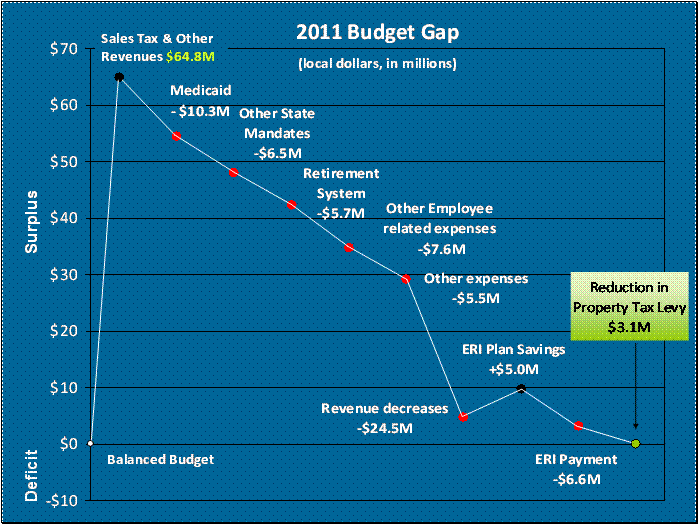
The meeting was adjourned at 11:27 a.m.
Respectfully submitted,
DEBORAH L. MATURO, Clerk
Onondaga County Legislature
* * *
WAYS AND MEANS COMMITTEE 2011 TENTATIVE BUDGET REVIEW OF
HEALTH COMMITTEE DEPARTMENTS, September 16, 2010
CASEY E. JORDAN, CHAIRMAN
MEMBERS PRESENT: Mr. Corbett, *Mr. Stanczyk, Mr. Holmquist, Mr. Warner, **Mr. Kinne
MEMBERS ABSENT: Mr. Lesniak, Mr. Buckel, Mr. Kilmartin
ALSO PRESENT: Mr. Rhinehart, Ms. Ervin
Chairman Jordan called the meeting to order at 9:03 a.m.
MENTAL HEALTH: Mr. Robert Long, Commissioner; Ms. Sandra Miller-Martens, Fiscal Officer; Mr. Barry Beck, Mr. Jason Dean, Budget Analyst
Mr. Long gave the following presentation:
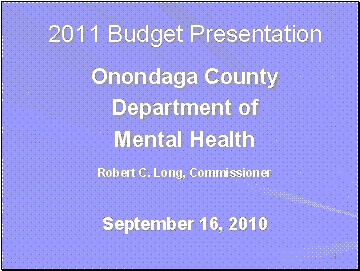 
 
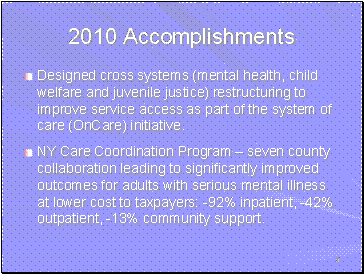 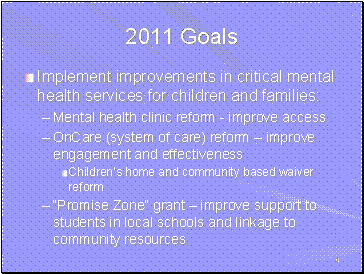
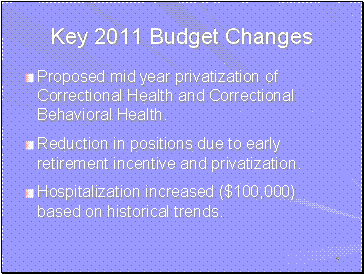 
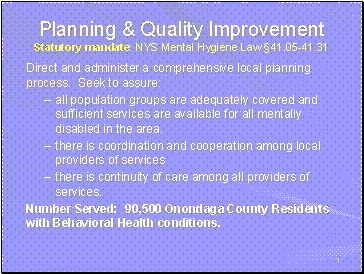 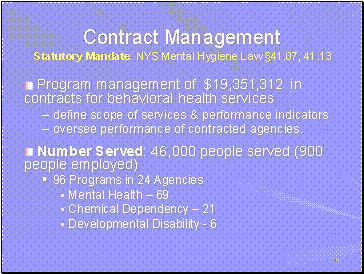
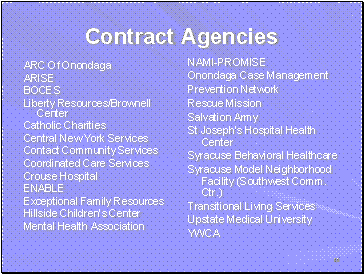 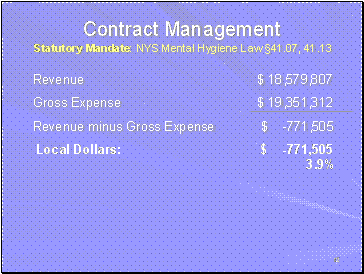
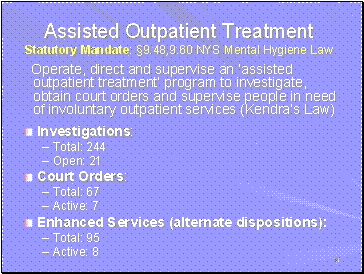 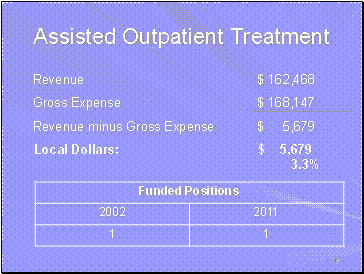
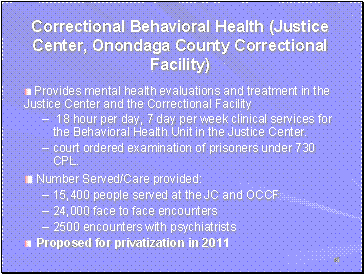 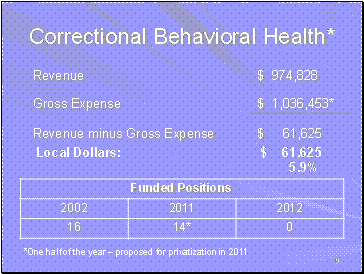
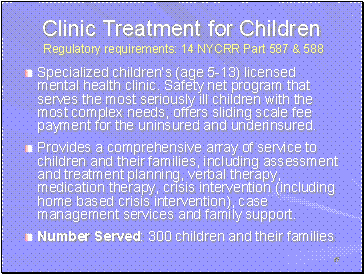 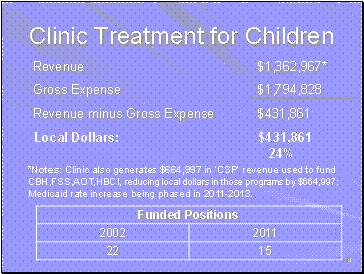
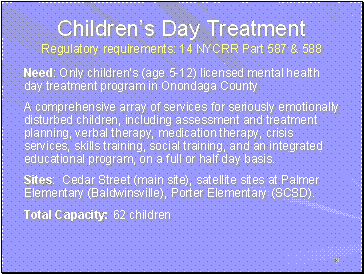 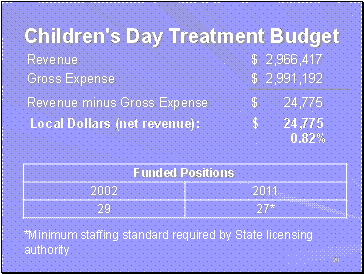
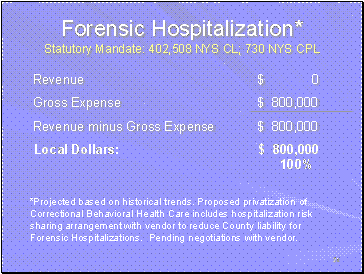 
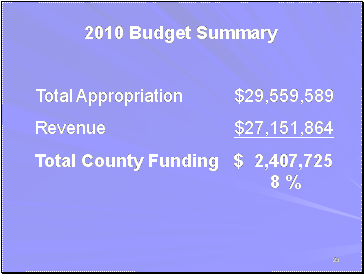 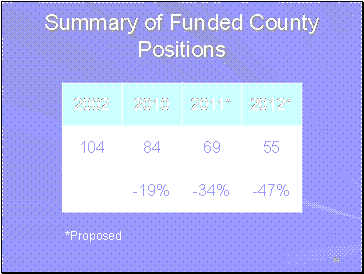
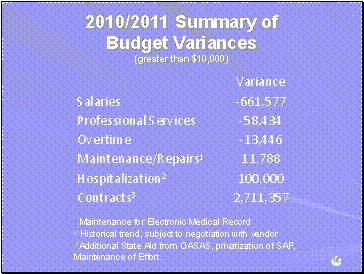
Mr. Jordan asked how many people in the department have elected to take the Early Retirement Incentive (ERI). Mr. Long noted the following:
- 8 employees are taking ERI, most of those positions are being eliminated; none will be coming back part time.
- 2 of those will be refilled (Cedar St. Children’s Services).
- 3 other positions would have to be refilled if Correctional Health is not privatized.
Mr. Jordan asked what programs are not mandated by the federal or state governments. Mr. Long noted the following:
- Clinic Program - a safety net program serving children and families. With the $400,000 deficit in that program, doesn’t believe they could successfully privatize it unless they also transfer $400,000 in County dollars to make it worthwhile for a vendor.
- Day Treatment Program - serves a safety net population – kids who are too ill to attend school, too ill to be successful in clinic level treatment. Costs them $25,000 a year to operate a $3 million program.
Mr. Jordan asked about concerns voiced to him that there is not appropriate oversight of medications, service and treatment that is occurring in Correctional Health resulting in additional cost to the County. Mr. Long said:
- He would question the qualifications of the person who is making that judgment.
- Have qualified physicians, contracted by the County, who make decisions.
- Pharmacy is monitored, look for the best purchasing arrangements, must justify if prescribing off formulary.
- People on medication are seen regularly, would be a medical liability for the physician if not.
Mr. Jordan asked if Correctional Health is privatized, wouldn’t there be an inherent incentive to go with the most cost effective treatment, prescribe the most cost effective medication, how would they protect the taxpayers form that. Mr. Long referred to the following regarding the proposal:
- If the vendor doesn’t maintain the minimum staffing required, they will pay a financial penalty.
- they are looking for the vendor to cost share the cost of hospitalization.
- There is a position in the Health Department budget for a contract monitor who would be a medical professional to oversee the quality of care and that the contractor is achieving milestones that will be established in the contract
- Dr. Morrow, Chief Carbery, Mr. Cowin and he will continue to be involved in oversight
- Five proposals have been received in response to the RFP, all five vendors have indicated in writing and verbally that they would hire the majority of the county employees, have agreed to interview 100% of the current employees.
- Have asked them to put in their proposals what their staffing patterns will be to make sure there will be adequate staff
- One vendor operates 7 correctional health facilities in New York State, if there were a shortage of staffing in Onondaga County, they could temporarily move people in.
- Anticipate significant cost savings in pharmacy, the vendors have more leverage in buying in volume.
Mr. Jordan asked if there are any grant funds that they have received that are not being spent at this time. Mr. Long said they have about $150,000 that hasn’t been spent; that funding is earmarked for a particular program and funding code, couldn’t take it and move it around; if not spent, it lapses and returns to the State, cannot be rolled over to the next year.
Mr. Corbett referred to Line 534 for hospitalization and the dramatic drop from Actual in 2009 of $1,197,500; to the Requested $850,000 and Recommended $400,000 for 2011. Mr. Long said their hospitalization is highly variable from year to year, that is why they use a 4-year average to project the budget. It was running substantially less than the $700,000 Modified for 2010, but there has been an uptick in the third quarter, believes it will be substantially more than what is in the budget; they move money around internally to cover the cost; if not able to do that, they return to the Legislature at year end for additional appropriation. In answer to Mr. Corbett, Mr. Long said their Children’s Clinic and Day Treatment Clinic operate out of the Hutchings building, reduces their cost because the State pays rent and utilities, they work closely with Hutchings, have a good cooperative relationship.
**Mr. Kinne left the meeting.
Mr. Stanczyk – inaudible. In answer to Mr. Stanczyk’s questions, Mr. Long said:
- Of the $29 million in their budget, about $17 million is not direct services. The majority of their employees would be in direct services.
- Hospital costs were $1.2 million in 2009, will get a projection for 2010.
- Mental Health pays 50% of hospitalization for judicial decisions to house a person in a state psychiatric center – end up there because they deteriorate psychiatrically in the jail to the point they can’t be managed – they are involuntarily committed by two physicians who both certify the individual needs involuntary hospitalization. Currently they have 15 people in the hospital under that status. Mr. Long will supply the numbers for the whole year.
- If an attorney representing an individual or the court itself does not think the person has the mental ability to participate in their defense, court orders the person examined by two psychiatrists, they report back on specific criteria in the Criminal Procedure Law as to whether or not the person meets the legal criteria to be competent to stand trial. If not competent and the person is charge with a misdemeanor or a violation, the charges are dismissed and the person is committed to a civil hospital – County doesn’t pay for that; if charged with a felony, the person is committed to a secure state psychiatric facility until such time the person is restored to competency.
Regarding privatizing Correctional Health, Mr. Long said these companies are experts in providing these services, believes they will do a more effective and efficient job and they have greater buying power; also to be considered are the long term costs of employee benefits, etc. Mr. Dean said the local cost born by the Sheriff and OCCF would be closer to $1.3 million; for the entire Correctional Health services, the expenditure comes from Mental Health and then Sheriff’s and OCCF are charged back that amount.
Mr. Warner asked what the projected savings is by privatization and has it been built into the budget. Mr. Dean said they have assumed no savings for privatization of Correctional Health because they don’t know the outcome of the negotiations that will take place between the County and vendor. Mr. Long said they will be going to the RFP committee on Monday, September 27, when the final selection of a vendor will be made; then there will be a period of negotiation with the vendor, then will decide if this is financially viable. Also, they are obligated under law to negotiate with the unions representing the employees. They budgeted for half a year as still County operated. It will take to mid year to implement a contract. They may be able to implement some parts earlier, for example, pharmacy and physician services. Mr. Dean noted that the contract will eventually sit in the Sheriff’s budget – their 570 account has a large increase due to the contract.
Mr. Jordan asked what the anticipated cost savings is by privatizing Correctional Health. Mr. Long said there have been a range of prices and range of different proposals, thinks it would be roughly the same cost that it is now, but it would save money in the long run without the continued escalation of employee benefits costs, retirement benefit costs, etc. Mr. Rowley said once they go through the RFP process and make a selection, they will be coming back to the Legislature, all the questions will be detailed and they will have numbers.
Mr. Warner asked if there are any other operations in their budget that could be privatized. Mr. Long said they could do it with the Children’s Clinic and Day Treatment, he has not recommended that, does not believe those services would be available if they tried to privatize them.
* Mr. Stanczyk left the meeting.
LONG TERM CARE – VAN DUYN, COMMUNITY SERVICES: Ms. Roberta Sprague, Commissioner
Ms. Sprague gave the following presentation:
Department of Long Term Care Presentation of the 2011 Budget
Good morning Chairman Rhinehart and members of the Legislature. I am here to present the proposed 2011 budget for the Department of Long Term Care.
Joining me today are Kathy Kenny, Van Duyn Director of Fiscal Management; Maureen Cerniglia, the Van Duyn Nursing Home Administrator; Patrice Gile, Budget Analyst from the office of Management and Budget; Jackie Ross, Assistant Administrator; Maureen Murphy, Personnel Administrator and Michelle Brown, Program Analyst. Collectively we will be glad to take questions at the end of the presentation.
The nursing home industry in New York State continues to operate in an extremely volatile climate. Throughout 2010, the State continued to work on refining the reimbursement methodology proposed in 2009, but we currently remain without approved final rates. As recent as last week we received information that included draft rates for 2009 yet to be approved by both the Centers for Medicare & Medicaid Services (CMS) and the NYS Division of Budget. Despite what we have accomplished and provided for our community, without a substantial change in the nursing home reimbursement methodology, the financial future of Van Duyn remains uncertain.
Public Health law states, “A license to operate a nursing home carries with it a special obligation to the residents who depend upon the facility to meet every basic human need.” Each subsequent budget season, we have done our due diligence by proposing ways of continuing to meet this obligation while streamlining operations within the traditional service delivery context at Van Duyn. We are now at a crossroads where traditional modifications will not leverage the cost savings that this fiscal climate demands, while allowing us to continue providing high quality resident care. To continue to fulfill the responsibility of serving our residents and our community, we must now explore alternative ways of providing care to help secure a sustainable future. Such alternative ways of providing service could enhance our fiscal viability due to increased efficiency, use of less overtime, and decreased fringe benefits. In some circumstances, exploring alternative means of providing services may also result in increased quality of care, and increased revenue.
Specifically, this budget contemplates outsourcing will happen throughout the year as we work with our union representatives as we did when we outsourced Physical, Occupational and Speech Therapy services in 2010. In the more distant past Van Duyn outsourced physician services, pharmacy, and radiology services. We will now pursue outsourcing laundry, housekeeping and food service operations.
Additionally, we have recommended the continued implementation of our capital improvement plan. Due to current inefficiencies inherent in the lay-out of the building, we are very limited in our ability to implement flexible, more efficient staffing plans. Such staffing plans would be made possible through an investment in modifying the facility to accommodate more efficient use of staff resources.
We have reviewed all of our expenditures and looked at the opportunities presented to us through acceptance of the early retirement incentive, including the retirement of 44 employees. We plan on diversifying the treatments we provide and revising operations in our business, admissions, nursing and social service departments to improve efficiency and customer service, and to increase our revenue potential.
With consideration of all of these initiatives, our proposed 2011 budget calls for using approximately $3 million of our fund balance, and receiving $2.5 million in IGT funds.
It merits emphasis that despite these initiatives, despite traditional cost savings mechanisms and the implementation of alternative service delivery systems such as contract services, the absence of a sustainable and reliable reimbursement structure continues to put Van Duyn into a precarious position.
Bonadio Report
Due to Van Duyn’s continued financial uncertainty, an independent company, the Bonadio Group, was retained to review our financial modeling into the future. In February 2010 they reported the following:
Environmental pressures place significant restraints on budget planning and flexibility, such as:
- The negative and uncertain impact of the NYS Medicaid rate setting methodology
- Federal and New York State budget pressures, and
- The common pressures facing publicly sponsored facilities including fringe benefits and union contract requirements. To this specific point, Bonadio concluded that Van Duyn’s average operational cost per patient day was approximately 23% less than our peer group average, not inclusive of salaries and benefits. When salaries and fringe benefits were included, Van Duyn’s average operational cost per patient per day increased to about 2.5% higher than our peers with these expenses added in.
Our estimated losses are driven by three significant factors:
- A high Medicaid utilization (average 80%)
- Significant benefit costs, and the
- Loss of rebasing funds in 2010
In conclusion the Bonadio Group recommended that the facility:
- Continue making capital improvements as they are reimbursed through the capital component of the Medicaid rate, and increase our opportunity for efficiency
- Perform an evaluation of current contracted services as well as looking at potential areas that could be performed more efficiently by an outside service provider
- Review strategies for offering specialty services that meet community needs
- Look at possible uses of the land surrounding the nursing home
- Evaluate sponsorship alternatives when the regulatory environment is more stable
- Explore program and operational synergies with Community General Hospital and
- Continue to review operating costs
Consistent with these recommendations:
- Van Duyn is nearing completion on most capital projects we began in 2008 with HEAL 4 grant money and the money that was bonded for by the County. We anticipate beginning other projects presented in our Capital Improvement Plan that are consistent with the work done with SFCS, and the ever emerging concepts of Culture Change.
- We have reviewed many of our contract services and found them to be consistent with our needs; we have identified other services that we believe could be contracted out; and the contractor for physical, occupational and speech therapy began providing services this month. We anticipate the change in Therapy services alone will increase our annual revenues by $1.5 million dollars. Our 2011 budget contemplates that more outsourcing will happen throughout the year as we work with our union counterparts.
- At minimum we anticipate offering specialty services such as intravenous therapy and advanced wound care services. Some of the newly hired staff has experience with these advanced nursing duties and we have built in the corresponding financing to provide the required equipment. Providing these two services will answer a need identified in our community by the Hospital Executive Council and through the local market analysis completed in 2010 by Knowledge Systems & Research.
- We have explored additional uses of the property. Van Duyn Home and Hospital sits on 65 acres of land that is contiguous with Community General Hospital’s 43 acre site. With this acreage, there is room to build alternative one story housing in line with the more operationally efficient and cost effective Green House design. In addition, by building these facilities and relocating some current Van Duyn residents to this location, it would open up space to accommodate Assisted Living in the current Van Duyn building. Offering Assisted Living to those in need of an affordable lower level of care would in turn allow Van Duyn to repurpose the remaining smaller neighborhoods of care.
- During the spring of 2010 talks between our partner, Community General Hospital, and Upstate University Hospital began about possible collaborations between those two entities. Due to Van Duyn’s unique relationship with Community General and our critical role in the provision of community safety net services, Upstate also approached the County Executive to discuss potential synergies. In July, the three institutions decided to work collaboratively to discuss community needs through the vehicle of the Community Health Information and Planning Services Board (CHIPS). Joint planning followed under the auspices of the CHIPS Collaborative. This collaborative work led us to apply for a HEAL 20 Grant, which, if awarded, would continue the initiatives started through HEAL 4 funding and expand our ability to meet the needs of this community.
A HEAL 20 Grant would support:
- The transformation and upgrading of the current campus infrastructure
- The transformation of current campus operations and services provided and
- Enhancements in the areas of education and training for geriatric care on the Van Duyn campus
Dept. of Long Term Care
2011 Budget Highlights
Recommended = $5.2 million over 2010 Adopted ($2.1 m direct appropriations & $3.1 interdepartmentals (attributable to fringes and retirement). 36% of the budget which is the interdepartmental portion went up 24.6%. Operating expenses went up slightly, as our 408 line includes the money for the Select Rehab contract. We have little control over escalating cost or state mandated service provisions, but we must meet Department of Health standards 24 hours a day, 365 days a year.
Personnel
- 573 Funded positions – down 5 positions from 2010 Budget
- Budget creates: 2 Accountant 1
1 Account Clerk 1
4 Caseworkers
1 Admissions Coordinator
1 Patient Evaluation Assistant
1 Storekeeper (to replace a Clerk 3 title that was more costly)
- Budget eliminates: (OT/PT positions due to outsourcing):
1 Physical Therapist 1 (hired by Select Rehab)
1 Physical Therapist 2 (hired by Select Rehab)
3 Occupational Therapists 1 (1 hired by Select Rehab and 2 were already vacant)
- Upgrades of 7 Assistant Director of Nursing Positions from Grade 33 to 34 and Director of Nursing Services from Grade 35 to 36. Also upgrade of Director of Fiscal Management Grade 33 to 35.
Early Retirement:
- 44 staff retired. Of the 44 vacant positions, 34 will be replaced.
- It is anticipated that new hires that will fill these positions will come in at entry level salaries for each respective title.
- Some positions provide services that are anticipated to be contracted out in the near future, realizing long term savings from fringe and retirement costs.
- Some additional salary savings will be realized in the time elapsed between retirement and the hiring process.
- 2 positions will not be filled at Van Duyn, as the service will be provided through the Facilities dept
Estimated Salary Savings = $2,957,323
($500,000 shifted to professional services for contract nursing).
Future Contracting Initiatives
- Personal Laundry – January 2011
- Additional Food Service – September 2011
- Housekeeping – January 2012
Vehicles
Includes $50,000 for a plow and maintenance truck to replace a 1997 vehicle.
Equipment
Includes $252,788 for capital related items on a 10-year replacement plan (wheelchairs, hospital beds and mattresses, lifts, etc.)
Supplies
Dietary budget at $2.74M vs. $2.4 M in 2009 (14% increase) Reflects new management contracts for additional food service outsourcing
2010 Adopted = $2.54 (7.6% increase)
Professional Services
- Occupational Therapy/Physical Therapy/Speech Therapy Contract - $1,858,692
- Pharmacy - $558,000 (5.6% increase over 2009 Actual expenses)
- Contract Nursing - $900,762 per department request. Reflect transfer of funds from personnel account to professional services.
- Account also includes contracts for medical staff and other required specialties.
All Other Expenses
- Increase in Cash Receipts Assessment as a result of significantly higher Medicaid rates. When our revenues increase this increases.
- Laundry and Linen Service - $1,058,730 (13.3% increase over 2009 Actual). Includes contracting for personal laundry services beginning in January 2011.
Maintenance, Utilities, and Rents
- Includes savings for lower utility estimates, per the County’s new locked-in rates
- Electronic Medical Records recurring costs = $60,974. Account is reduced from 2009 as that included one time equipment purchases for EMR at $267,000.
Provision for Capital Projects
Includes $50,000 for unforeseen necessary capital improvements.
Revenues (Based on a bed count of 495)
- Medicaid Rate Estimate = $197 compared with the 2010 Adopted rate of $165.55. Total = $29.3 million which includes $2.5 million for IGT. At the time of the 2010 Adopted budget we thought that regional pricing would begin during 2010 and that rates would be much lower. Regional pricing has been delayed until March 2011. We have also received some information from NYAHSA that indicates the rates will be higher than what we’d anticipated. 83.5% of care days are budgeted for Medicaid.
- Private Pay - 5% increase effective Jan 1, 2011. Rates: 2010 = $291
- 2011 = $306. 6.5% of care days are budgeted in 2011. Total = $4.3 million
- Medicare Rate Estimate = $341.23. Total = $5 million. Included are $3.4 million in gross additional revenues as a result of the OT/PT new contract. 6% of care days are budgeted for Medicare.
Bottom Line
2009 Van Duyn’s Fund Balance = $9,846,420
2010 Projected Use of Fund Balance = $4,763,924
2011 Recommended Use of Fund Balance = $3,068,356
Projected 2011 Fund Balance = $2,014,140
Update on Van Duyn Capital Projects
- Boiler Replacement: Installed three new flexible tube steam boilers along with a direct digital control system that allows for automated operation.
- Oil tanks: Above ground tanks were installed
- Kitchen Modernizations: Several large pieces of equipment for the kitchen were replaced including ovens and coolers. Ice machines were replaced on resident floors.
- Electronic Medical Record: Completed implementation of the SigmaCare Electronic Medical Record system, streamlining point-of-care documentation and increasing the accuracy and efficiency of the flow of resident information. Additionally we are working on an interface with Community General Hospital which should be completed in the next few months.
- Sidewalk replacement: 13,200 square feet of decayed sidewalks were replaced with a combination of Flexi Pave and concrete. Flexi Pave is a newer product that takes recycled tires and forms a porous, weather resistant material that is placed over the old concrete.
- Elevator Renovations: Elevators 1, 6 and 7 are complete. Work on the remaining 5 elevators will continue through mid 2011.
- Nurse Call System Renovations: A new nurse call system has been implemented which should reduce the noise level on the resident floors and increase staff accountability for resident care.
- Fire Smoke Detection and Alarm System Replacement: The fire alarm system was replaced, increasing the life safety of all residents, visitors and staff by increasing the coverage of Van Duyn’s fire alarm infrastructure, and by improving upon the quality of fire safety communications throughout the facility.
- Phone System: Van Duyn completed implementation of a new phone system in August, including use of wireless phones for supervisors who are transient throughout the building. A key feature of this system is our ability to activate phone service for residents more expediently upon admission.
- Security Cameras: Our security camera system will be evaluated and repaired as extensively as our budget permits. This work will begin over the next few months.
- Tree Plantings: An additional 6 trees were planted on the Van Duyn campus as a gift from the Central New York Nursery and Landscape Association.
- Family Room Furnishings, 5 Large Screen Televisions and Credenzas: Televisions and furnishings were donated by the Onondaga Guild to make Van Duyn a more accommodating setting for our residents and guests.
Resident Centered 2010 Accomplishments
In addition to all of the projects we’ve been working on, the staff continued to provide quality care to the residents who call Van Duyn home. This list is certainly not inclusive but includes some of the highlights of 2010 at Van Duyn.
- Approximately 427 new residents and 339 re-admissions were welcomed and processed by our staff for a total of 766 admissions in 2010.
- The Volunteer Services Department took over the management and staffing of the Van Duyn Gift Shop, expanding open days from two days a week to three with plans to add a weekend afternoon. This is a service provided by volunteers for those residents who are unable to take advantage of the activity trips off site.
- All Van Duyn residents now have new mattresses in line with our capital replacement projects. 29 low beds and 60 perimeter guard mattresses were also purchased to improve resident safety.
- Clinical Data Services has been able to improve upon the methodology for quality assurance reviews by using the electronic medical record. The system allows querying of resident information and reporting to the appropriate department manager. Department managers are also able to run reports as needed based on established criteria, increasing efficiency by no longer requiring intervention by staff in Clinical Data Services.
- The Van Duyn Fiscal Office worked with Medical Records to bring Medicare Part B and Physician and Nurse Practitioner Billings up to date, and developed a procedure to maintain current billing status.
- The Van Duyn Systems Administrator (Information Technology Dept.) outlined and refined the current network infrastructure for the Voice Over IP phone system implementation project. In addition, the Systems Administrator also learned a variety of applications necessary to support the system and customize phone settings to meet Van Duyn staff needs.
- A new nurse call system was implemented, which has improved the level of clinical communication on resident floors by coding calls by call type. In addition, quality of care has been improved through a nurse call reporting system, which increases staff accountability for timely resident care.
- The VOIP phone system implementation project was completed allowing Van Duyn staff to manage resident lines, rather than having residents wait for their phone service from an outside provider. Once the work order is processed internally, Van Duyn residents will have their phone service set up within a few business days. Any changes or moves that will take place within the facility will be processed in the same manner, removing delays and charges that result from working with an outside provider.
2010 Interdepartmental Change
By Local Law the Onondaga County Administrative Code was amended to transfer the Division of Community Services from the Department of Long Term Care to the Department of Social Services.
2011 GOALS- The Look Ahead
The next year will be very busy at Van Duyn as we undertake the following initiatives:
- Select Rehab, our new therapy contractor;
- 6N, our new Billing Software Company;
- Completing work on the HEAL 4 projects and other projects;
- Training for and using the new mandated MDS 3.0;
- Training new staff hired to fill vacant positions;
- Participating with DOH for our annual survey;
- Restructuring our admissions, social work, nursing and finance offices;
- Serving residents that need intravenous therapy and advanced wound care treatments; it is the intent to cohort individuals together with similar needs;
- Outsourcing services including laundry, housekeeping, and additional food service operations;
- Working with CHIPS and the CHIPS Collaborative to meet unmet needs in the community; and
- Meeting the personnel goals of increasing our volunteer base, and decreasing dependency on overtime and agency usage
Summation
Amidst challenges and uncertainty, Van Duyn has accomplished a significant amount in a few short years. We have achieved compliance with the Berger Mandates and we have positioned ourselves to continue to provide quality care to the residents of Van Duyn through the numerous ongoing projects. We will continue our work with CHIPS and the newly formed CHIPS Collaborative to determine what other synergies we might achieve, beginning a new journey that can only enhance the quality of care offered in our community
Mr. Jordan noted that 44 employees in the department have elected to take advantage of the Early Retirement Incentive (ERI) and that they plan to replace 34, asked what the plan is for the remaining positions and how they anticipate meeting the 50% salary savings requirement for the ERI.. The following information was given:
- Therapists positions have been contracted out, one cook position and one Clerk 2 position were eliminated and anticipate that, over time with new phone system, there will be an opportunity to eliminate 6 to 8 hours for the switchboard position (now 24 hrs/7days per week); some of these positions have been unfunded, some will be eliminated.
- Anticipate salary savings because they have abolished 5 positions due to the PT/OT outsourcing.
- Budget anticipates different savings starting January 2011 and going through 2012 – have two years to make up the difference.
- They are looking at outsourcing other services; by getting rid of the fringe benefits and other costs associated with that they anticipate that there would be enough leeway to accomplish required salary savings
- Two case workers will be coming back to job share one position, others are coming back part time until the positions are filled.
Mr. Jordan observed that the budget shows approximately $20 million for salaries/wages and $14 million for employee benefits, seems like there is an enormous disparity between departments. Mr. Seitz said there is a significant number of retirees getting retiree health care at Van Duyn, departments – with a high level of filled positions, their retiree base is growing larger than the smaller departments. Ms. Rooney noted that the per capita salary at Van Duyn is much lower than across the County average because of the job titles, but the fringe benefits, etc. are the same cost per employee.
Mr. Jordan said they are projecting a fund balance of roughly $4.8 million at the end of 2010 and asking to use $3 million of that balance, and then restoring $2 million. Ms. Sprague said if there is IGT money to be pulled down, they would have that coming in; if not, looking at a depletion. In addition, it could be more or less than $2 million, it will depend on the rates that finally get established, they are still working with 2009 rates.
Mr. Jordan asked if their capital projects came in on or below budget. Ms. Sprague said they are under budget for the capital projects under the HEAL 4 grant money and what they bonded for; will be closing out those projects by the end of December. Mr. Jordan requested information regarding how much they bonded for, what was the actual cost, what is being done with the additional revenues if under the bonded cost. Ms. Sprague said the HEAL 4 grant was about $3.4 million - divided into two different types of money – the actual capital and the restructuring type money. They bonded for the monies because they had to say they would be able to complete all of the projects that they started with the HEAL 4 money; they hope to use the majority of that grant money and not have to give money back.
In answer to Mr. Corbett, Ms. Sprague said the County would never own and operate the Assisted Living program because of the financial structure regarding the SSI payments. In the HEAL 20 proposal, they were looking to use the current 7th floor space for the Assisted Living Program and then on the same campus build out the efficient green house model – the one story type buildings where they could move some of the current residents. Another person would have to come in and operate the Assisted Living Program, should know about that grant in the end of September.
Mr. Warner noted that there seems to be a growing concern that maybe Onondaga County should not be in the nursing home business. The Bonadio Report indicates that there is a 2.5% higher cost because of the fact that there are County employees in the facility. Mr. Warner noted that he has asked the Comptroller to do a complete study concerning exactly what the cost is to the taxpayers of Onondaga County to operate Van Duyn.
Mr. Holmquist asked if there is an ongoing effort to see what can be privatized. Ms. Sprague said there are certain things that cannot be privatized because they are a nursing home, unless they were to change sponsorship completely. They are considering some that haven’t gone out to RFP; they will not realized income like they did with the select rehab. They will also be taking a look at current contracts to se if they could do better with other contractors.
Mr. Rhinehart asked what they would do when there is no fund balance left in 2011 or 2012. Ms. Sprague said they would have to look towards the IGT money. Ms. Brown said their state association is telling them to assume at this point in time that the IGT funding will be level with the 2008/2009 award which allowed them up to $9 million; there is no definitive information as to exactly how much. Mrs. Sprague said Mr. Rhinehart was on the right track when he asked if there wouldn’t be enough money to get them through the year without the IGT money.
Answers to Mr. Rhinehart’s questions:
- Salary for an employee who does personal laundry is $26,000 - $28,000 under the title of Custodial Worker 1.
- There are 3 full time and 4 part time employees who do personal laundry. Part time employees have additional housekeeping chores within the building.
- If they outsource the laundry, they would still need 3 full time employees to gather the laundry, get it ready to go out to a vendor and get it back to the individual resident rooms.
- There are two Laborer 2’s and one Laborer 1 who do outside work, such as mowing and snow removal; In addition to that they do facility maintenance jobs inside the facility. Total is $82,000 for the full time employees; to contract it out would be about $88,700.
- Individuals perform other duties that would not be included in mowing and snow removal contracts, such as mulching, taking care of the landscaping, work inside as needed.
Mr. Rhinehart asked about the maintenance of trucks and mowers. Ms. Brown said the trucks go to WEP for maintenance, mowers are repaired at Van Duyn. Ms. Sprague noted that they are looking to replace a 1997 truck this year, last year they replaced a 1999 truck. A vehicle is depreciable; with their Medicaid utilization rate, will get the money back at roughly 80% within the next five years.
In answer to Mr. Rhinehart, Ms. Gile said their salary savings is a combination of ERI, Part time salaries, significant leave without pay, lag time of about 13 weeks from when a VRR goes out to time of rehire, a transfer for about $500,000 for nursing through contract, personal laundry positions, some of the food outsourcing anticipated starting in September.
Mr. Rhinehart asked why they were not abolishing the ten positions that are left unfunded after the ERI. Ms. Gile said they left them unfunded for tracking purposes, they still qualify for the salary savings with the State requirements.
Mr. Warner requested documentation of what their fund balance was going back to 2000.
DEPARTMENT OF AGING AND YOUTH: Lisa Alford, Commissioner; Chris Flynn, Youth Bureau Administrator; Lisa Farewell, Accountant 2; Edie Williams, Budget Analyst; Ann Reed, Public Information Specialist
 
Our Mission is to support a comprehensive system of services for children and youth, senior citizens, and their families.
We support our community through advocacy, planning, coordination, direct services and program funding.

Our goals include:
- Increasing access to services for older people to enable them to remain in a safe and appropriate living environment.
- Developing and supporting wellness activities to promote healthy youth and older adults.
- Increasing the number of youth programs that utilize best practices to help ensure that young people are involved in quality programs that help them gain knowledge, skills and competence.
- Strengthening our leadership and advocacy role in the community as the primary source for information on programs and services, major trends, best practices, and funding related to older adults and youth.
Today’s presentation will highlight some of the ways our department is meeting these goals.

The rising aging population is on everyone’s radar and is expected to have far-reaching effects on everything from social services to health care.
Our County is facing several unique challenges with regards to its aging population.
According to the 2000 Census figures, the County’s senior population consisted of approximately 10% of individuals aged 85 and older. In 2009 and 2010 to date, they account for over 20% of our Department’s clients.
Onondaga County’s citizens show a determination to remain at home, a goal our department successfully helps them attain. 28% of the County residents over age 60 lived alone in 2000. In 2009, 40% of our clients did. So far in 2010, that number has jumped to 51%.
Census figures also tell us that in 2000, 16% of Onondaga County residents over age 60, reported incomes qualifying them as low income or at poverty level. In 2009, 38% of our clients met that distinction – and to date this year our Department is serving 56% - which is significantly higher than the county percentage.
As you can see, these aging trends are changing the face of our county, our clients and our programs.

Our Total combined budget is a little over $7.6 million dollars, over $417,000 dollars less than last year’s budget.
Our local dollar amount of $751,000 is equal to 9.8% of our total budget, and is $45,000 less than last year.

Our most significant 2011 combined budget variances include the following:
Net personnel decreased due to a one time supplement award in 2010 for our senior employment program, and less than full time funding for one Youth Bureau position.
Supplies decreased due to purchasing fewer emergency meal packs.

The changes in Fees for Services and Maintenance & Utilities are due to reclassifying the SAMS software.
Decreases in federal, state and local dollars caused us to reduce our contracted services.
The impact of this reduction includes:
- A reduction in the number of service days at 3 senior dining sites, equaling approximately 10,000 fewer meals served
- The elimination of one subcontracted EISEP Case Manager position and fewer program service hours
- Funding for two senior programs was eliminated and we reduced the number of Totally Fit for the Next Fifty sites.

In addition to the revenues you see in our budget, the Department of Aging and Youth leverages support from various community sources to provide services. This helps reduce the local dollars needed, allowing us to access all allocated state and federal funds

Now I’d like to highlight some our department’s programs and share with you the impact we have on the people we serve.
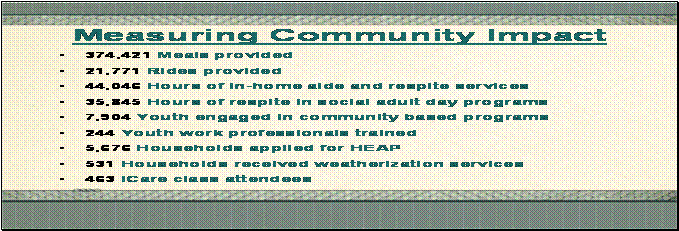
The Department of Aging and Youth has far-reaching influence on our community. Here are some of the services we provided:
Over 374,000 Meals thrugh Meals On Wheels and at senior dining sites
Nearly 22,000 Rides by funded agencies
80,000 Hours of in-home aide, respite and social day services
7,900 Youth engaged in community based programs
244 Youth Work Professionals were trained

Turning to our Youth Bureau budget:
Funding totaling over $850,000 dollars is provided to support 27 programs, ranging from those that help children develop socially and emotionally to programs that work with at risk youth, including those who are runaway and homeless.
The Partnership for Youth grant works to improve the employability of older youth who are hard to serve because they are homeless, aging out of foster care, or involved in the justice system. In the first three and a half years of the project, 85% of participants served met positive program outcomes.
$185,000 (that is not reflected in our budget) goes directly to municipal programs based on population. The youth bureau is responsible for monitoring, conducting audits and providing technical assistance to these programs.

The Youth Bureau staff provide direct services to improve outcomes for children and youth.
They provide training and technical assistance to youth workers and agencies, which help improve the quality of the programs where youth spend their time. In 2010 we anticipate providing over 150 hours of training to 900 youth workers. This training commitment will be expanded in 2011.
The Youth Bureau has lent its expertise to other non-funded public agencies. In 2010, we provided staff development resources to Hillbrook Detention Facility and Say Yes to Education. Staff of county departments such as Probation and the Public Library regularly attended youth bureau training sessions.
In addition, 50 parents are expected to gain new skills through our assets-based parenting training. These classes give parents the tools to better communicate with, and support the positive development of their children, especially teens.

Youth research shows:
- High quality relationships between youth and staff in programs improves youth outcomes. Training for youth workers to help them improve relationships with youth is a core component of our quality assessment, technical assistance and training functions.
In addition, good relationships between parents and adolescents lessen the likelihood of problem behaviors, which is a benefit of the parent training we provide.

Our Senior Community Based Services supports our non-profit partners with funding totaling over 1.1 million dollars to provide the essential services to promote healthy aging in place. Some include:
Transportation, Health Promotion, Elder Abuse Prevention, and
Housing and Legal Assistance.
Thanks to a federal grant we recently received, we will be expanding transportation services for seniors and adults with disabilities, in places throughout the county where there is little or no public transit.
We have expanded our collaboration with the Department of Social Services to provide services for Adult Protective and Preventive cases. This collaboration allows both departments to maximize fiscal and human resources and capitalize on efficiencies while providing services to our most at-risk seniors. To date, we have been able to work together to help nearly 100 county residents most in need of our expert assistance.
United We Ride Grant – $120,000 in 2011

Many seniors are anxious to get help with high energy costs. We received 519 HEAP “early mailer” applications on the first two days of outreach, our highest opening 2-day total ever. Thanks to many of you, our outreach efforts continue to increase the amount of federally funded dollars benefiting our community. We anticipate the 2011 program year will exceed last year’s benefit of $2.6 million to seniors and persons with disabilities.
The Weatherization Referral and Packaging program, or WRAP, provides an in-home assessment of all weatherization needs and makes connections to available community programs and services.
So far this year, WRAP has served 375 frail seniors, with no local dollars involved.

Over 145,000 meals are served at 45 locations by 5 community agencies through our congregate dining sites.
227,000 well-balanced, hot meals are brought directly to the homes of at risk elders by 1,500 Meals On Wheels volunteers. These numbers reflect the trend of increased need for home delivered meals.
Voluntary contributions made by program participants to Meals on Wheels and at our Dining Sites, are used to offset our costs. Last year’s contributions totaled $316,000 help us serve additional meals beyond the funding we receive.
Because our meals meet Federal standards, we were able to bring in $250,000 in additional monies which go back into the program.

We screened over 4,800 participants for nutrition risk factors for chronic diseases. Nutrition support services such as screenings, assessment and counseling are essential for the health and well-being of our clients. In 2009, we provided in-home nutrition assessment for 439 at-risk seniors, up 17% from the previous year.
Our Registered Dietitians also evaluate food and medication interactions, food allergies, eating habits and make recommendations toward healthy dietary changes.

Our Expanded In-Home Services for the Elderly Program offers seniors non-medical assistance to help them remain in their homes as long as it is safe and feasible to do so. More than half of all EISEP participants are 85 and older, a 14% jump in this age group over the previous year. 56% of those in this group report a severe disability.
EISEP case managers, partner with the client’s family members and informal caregivers to create safe and cost effective care plans for their clients. On average, EISEP clients receive 4 hours of program provided in-home care per week, the annual cost of which is less than $4,000. Compare this with the average annual cost of a nursing home, which is $80,000.
Our Nursing Home Diversion program, now know as the Community Living Program, allowed 87% of participants to remain at home because of the assistance they received. 85% used a budget of less than $7,500 to do so, a considerable savings over the average $32,000 Medicaid would spend for one year in assisted living. As a result of the success of the program, it will be sustained through EISEP, and the VA is purchasing the services and offering it to veterans of any age.

The Caregiver Support Program works with contracted agencies to provide respite, either in a community setting (such as a social adult day program), or in the home for those with limited mobility. Last year, 686 hours of in-home respite visits and over 19,000 hours of respite at social adult day centers were provided.
Caregiver Services offered telephone assistance to 922 callers last year, giving information about and referrals to programs and services in our community. We also provided guidance to the many long distance caregivers assisting their elders residing in our county.
Our nationally recognized Institute for Caregivers offers free classes on a variety of helpful topics. Last year 463 county residents attended close to 50 classes taught by local experts, who serve on the faculty pro bono.

In closing, I would like to leave you with this quote from George Washington Carver, which I feels sums up our Department’s mission and vision:
“How far you go in life depends on your being tender with the young, compassionate with the aged, sympathetic with the striving and tolerant of the weak and the strong. Because someday in life you will have been all of these."
My staff and I feel privileged to be able to do the work that we do every day for the aging and youth in our community, and we appreciate your assistance in helping us to achieve our mission.
My directors and I will be happy to answer any questions at this time.
Mr. Jordan asked how many employees have elected to take advantage of the Early Retirement Incentive (ERI). Mr. Alford said “none”. Mr. Jordan asked what positions, programs are mandated by grants they receive, does the program have to be provided by a County employee or could it be contracted out to an agency such as Catholic Charities, Salvation Army, etc., are the programs mandated by the federal and state governments and to what extent are they mandated to be provided by County employees. Ms. Alford noted the following:
- A large amount of the work is sub-contracted out to non-profits in the community – have contracts with 27 agencies on the Youth side and many on the Aging side as well.
- If they accept funding to provide services, then those services do become mandated.
- Many counties actually cook the meals, Onondaga County contracts that out, other counties have EISEP Managers, nutrition case assessors, etc. that is contracted out by our county.
- When the County accepts the responsibility for a grant that is contracted out, they are still responsible for doing the monitoring, training, technical assistance, County has a vested interest in making sure things are done.
Mr. Jordan noted the department is entitled Aging and Youth, but the budgets are divided out; by doing that they may be duplicating services to some extent. Mr. Jordan asked if there some degree to which those functions can be merged even further and perhaps eliminate some of the required staffing. Ms. Alford said they have one position that is shared by Aging and Youth (Program Monitor); they also do sharing of audits. Last year when going through the budget process they looked at positions that could be eliminated, combined or shared.
Mr. Jordan asked what the local share of the average cost of nursing home care would be and EISEP. Ms. Alford said nursing home care is paid by Medicaid, does not know what that would be. EISEP is state funded, it is a cost share program – some clients pay a portion of the cost based on their income.
In answer to Mr. Warner, Ms. Alford said her staff does the auditing for rides provided; a large number of those are to go to doctor appointments, social adult day programs, shopping, etc., just received a federal grant for about $120,000. In answer to Mr. Warner, Ms. Farewell said some of their programs do require a local match, but with all of their expenses it is one combined budget, does not break out state, federal, local expenses. They do have a transportation grant that has no local dollars and another federal transportation program with 10% matching. She has the total grant and the total local dollars, but does not break out every expense that she pays.
Chairman Jordan recessed at 11:30 a.m.
Chairman Jordan reconvened at 12:35 p.m.
MEMBERS PRESENT: Mr. Corbett, Mr. Buckel, Mr. Stanczyk, Mr. Holmquist, Mr. Warner
MEMBERS ABSENT: Mr. Lesniak, Mr. Kilmartin, Mr. Kinne
ALSO PRESENT: Mr. Rhinehart, Mr. Laguzza, Mrs. Ervin
HEALTH DEPARTMENT – Dr. Morrow, Commissioner, Ms. Linda Karmen, Deputy Commissioner, Ms. Ellen Wilson, Fiscal Officer, Mr. Jason Dean, Budget Analyst
Dr. Morrow gave the following presentation:
 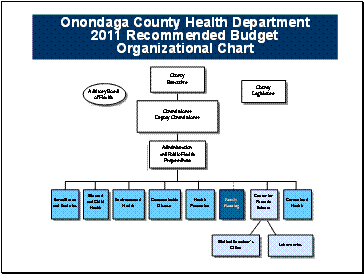
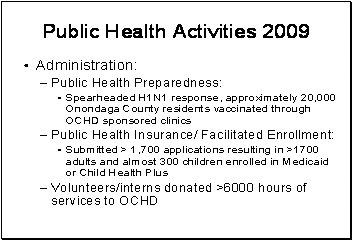 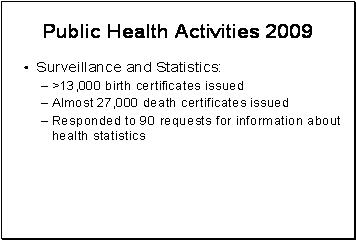
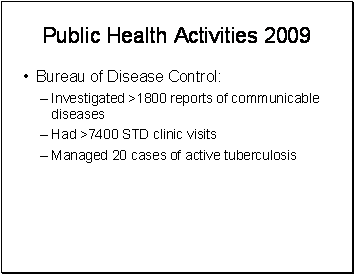 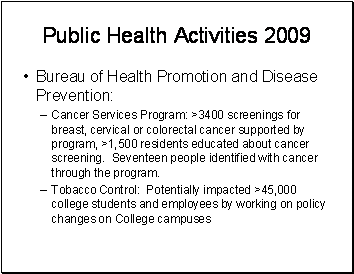
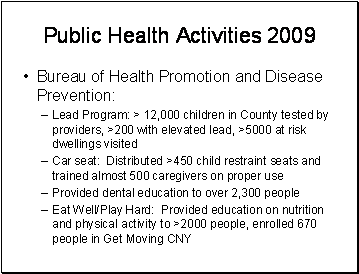 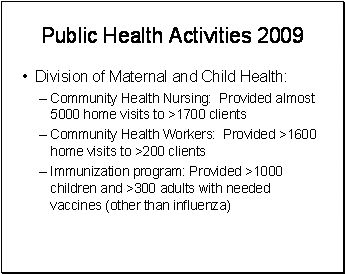
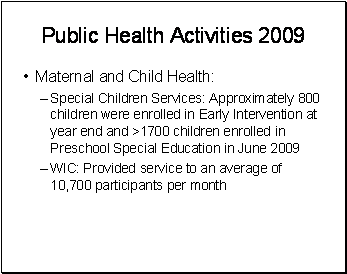 
Awarded a grant earlier this year from the State based on the high
rate of infant mortality. Did a 90-day workout with intensive assessment
with community partners. In one month of implementation, they exceeded
the number of referrals they got in the entire year before from Child
Protective Services and the Parinatal Center (which are their highest risk groups)
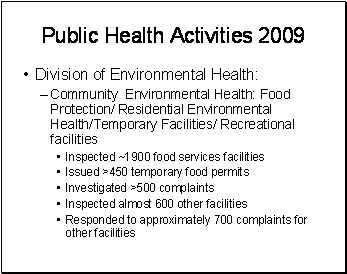 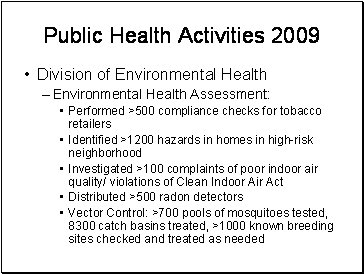
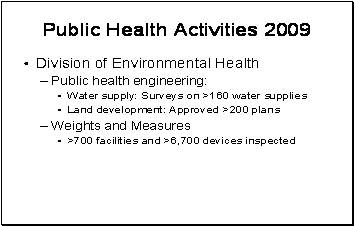 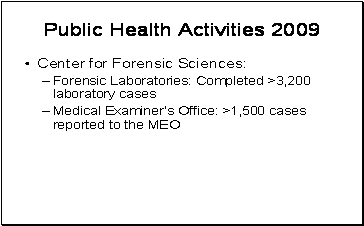
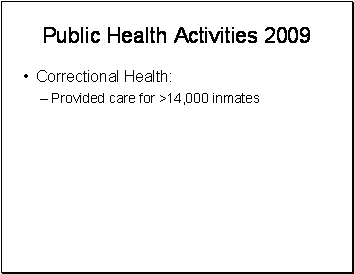 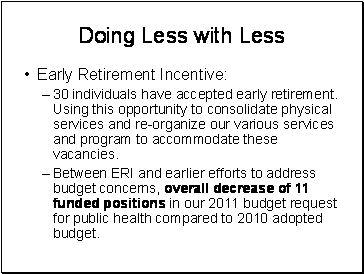
Have used this opportunity to identify efficiencies and to try to consolidate different programs. where they think there is somebody in the community who is better able to provide a service they have looked to community partners to take over.. Last year they did it with the Bicycle Helmet Safety Program; this year they have a commitment from Golisano’s Children’s Hospital to take over their Safe Kids Program
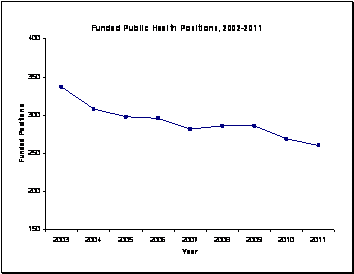 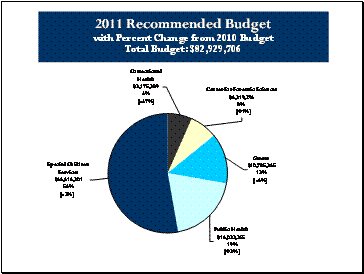
Budget is down $3.55 million from 2010 BAM. If Correctional Health is not privatized, budget would need to go back up.
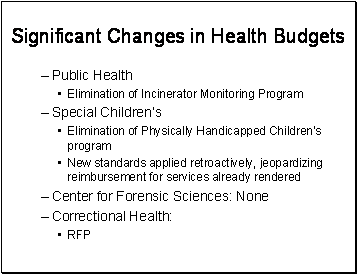 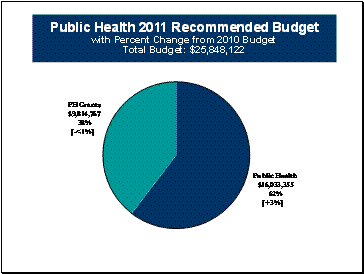
Re: Incinerator Monitoring – there is State oversight by the DEC, Seeing an increase of $474,000 from their 2010 BAM and an increase of County is no longer eligible for state aid for this program. $694 ,000 local – includes the reduction of 11 staff that is wiped out by the $839,000 increase in employee benefits (do not get State aid on fringe).
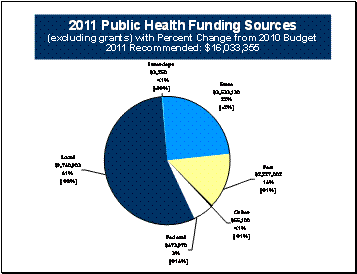 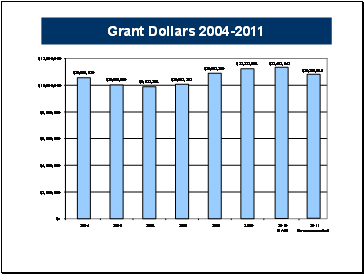
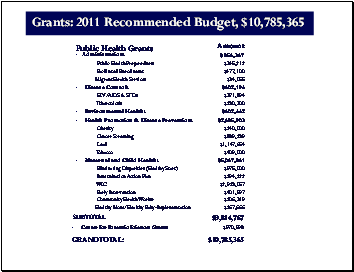 
Answers to questions about the Incinerator Monitoring Program asked by Mr. Warner and Mr. Corbett:
- Cost: $30,000 local.
- Health Department annual report (July 15, 2010 says “In monitoring conducted today no relationship has been established between the operations of the incinerator and any significant increased levels of constituents in the environment” – summary of report is on the website. Science speaks for itself, have not seen any significant trends.
- DEC is tasked to monitor, they are responsible for the incinerator. Dr. Morrow said the numbers look like they go up in 2009, but the Health Department eliminated the areas that were the lowest values because they had no risk and showed no impact, that increased the average.
- Decision to monitor was made in 1994 to show there are no trends.
- County testing is different than DEC, but they are similar operations.
Mr. Holmquist asked if there are any other programs that they are doing that duplicate state efforts. Dr. Morrow said she doesn’t believe there are; there are a couple of programs in Environmental Health – Vector Control is an optional program (36% reimbursement), if they spray because of eminent threat to public health they get 50% reimbursement. It is not duplicative, not something they are required to do, have decreased over the last two years, but she does not think they can make any more changes to that program given the recent past. They also do individual sewage that is not required to do, but feels strongly because of our environment, our community, because of two surface water sources, really want to control what is happening around Skaneateles and Otisco Lakes because that is the water we drink.
Areas where they could privatize:
- Correctional Health
- Special Children’s Services – proposing that some of the positions that are now vacant due to the early retirement incentive (ERI) go to organizations within our community that provide service coordination, wouldn’t want to let go completely, because they are responsible for the bill.
- Traffic Safety Car Seat Program
- Safe Kids
Mr. Jordan asked what positions are being vacated by retiring individuals and what positions will be refilled. Dr. Morrow said in Public Health there are 21 positions, they would like to outsource the three in Special Children’s Services (would save 4 full time positions) – 2 part time and 12 full time positions would be refilled.
Mr. Jordan asked about the home visits provided by the Div. of Maternal and Child Health. Dr. Morrow said the division has several programs underneath it. They have home visitors who are nurses, outreach workers and community health workers. There is a calculated return on investment for home visits – around $5,000. The savings are: decreasing incarceration, increased high school graduation rates, decreased child abuse rates and increased maternal employment. The evidence is overwhelming that the home visits model works better in terms of improving perinatal outcome of low birth weight, infant mortality, etc. for the population with transportation and employment barriers. Dr. Morrow said she would provide documentation regarding home visits.
Mr. Jordan asked about the Health Connected and the Cycle the City Event. Dr. Morrow said they are grant funded in the health promotion, disease prevention area; grants cover costs and employee benefits and allow them to provide a service to the community that has the indirect potential of decreasing our Medicaid costs.
Dr. Morrow said a lot of their grant funded programs are not mandated, they are required to do STD and Lead, programs that are grant funded. Dr. Morrow advised that if they do not do everything that is required in their municipal health service plan, all the 36% state aid is in jeopardy. In the last two years the State has become more directive in what is required, developed Article 6 guidance documents. Article 6 requires certain programs but not the level of service required; if the State feels they are not reaching that non-specified level of service, they can deny reimbursement. Mr. Jordan said these are all enormously beneficial programs and services the question is can we afford to continue to provide these services at the level we do. Dr. Morrow said it is not black and white; it is gray, guidance documents are becoming much more prescriptive of their expectations. Dr. Morrow said they have looked over their programs, have cut 11 positions this year (18 last year) and are at bare bones minimum, doesn’t believe they can make any cuts to public health services without significant harm to the population and without potential harm to Article 6 reimbursement. Mr. Jordan asked if they could consolidate clinics. Dr. Morrow said their STD clinics are operating at an all-time high, they operate them daily, have done an analysis concerning capping the number of patients per day due to less staff, her concern is that one person they don’t provide services to could go out and spread an STD to another person. STD, TB and HIV are operated together; they have also consolidated Div. of Maternal and Child Health services.
Mr. Stanczyk said he doesn’t think $30,000 is a huge amount for monitoring. Dr. Morrow said DEC routinely monitors the incinerator but in a different way – air stack monitoring, she was asked to come up with areas in her budget that are being done by another agency. Mr. Buckle said the County made a moral commitment to the community that they were going to watch this.
Mr. Buckel said comment was made today that Medicaid is their biggest expense. The categories of public safety, transportation and sanitation are higher. Since 2005, our direct reimbursements expenses for Medicaid have gone down. Proposed increase from last year to this year is 1.7%, doesn’t want to demean the importance of that program in a public health setting. Would rather see her define the challenges and how best they are going to allocate the limited pool of money to accomplish the urgent public health needs we have and provide metrics. Dr. Morrow said people who are eligible for Medicaid are disproportionally affected in every aspect of health, roll of entire Health Department is improving the health of every member of our community, but we target our most vulnerable members because they have the greatest disparity in health outcomes.
Mr. Stanczyk asked if they have things to measure the progress or lack of for the different programs such as Infant Mortality, WIC and STD clinic. Dr. Morrow said all the numbers of STD and TB cases are in their annual report; have metrics that they publish every year. Their entire goal is to prevent, it is hard to measure what you prevent. They can look at trends – infant mortality is creeping down, low birth weights are down. Dr. Morrow said there is a pressure to not do more than they are required to do and to do the right thing. For example, they are using a WIC client as a peer mentor, member of their staff just went through lactation training, they are responding to something they see as a significant threat to children’s health – inadequate rates of breast feeding. Dr. Morrow said one of the most important things she does is attend the monthly meetings of the NYS Association of County Health Officials (all county health Commissioner or Directors belong). This year, at every monthly meeting a different county will present what they think is their best practice, will help all. Mr. Jordan requested information regarding impact upon infant mortality rates – percentages of improvement since the Healthy Start program began.
Mr. Warner noted that all these best practices lead to more programs, higher taxes; right now, the state has 35 more Medicaid programs on its Medicaid list than most other states. NYS Medicaid cost is higher than Texas and California combined. Dr. Morrow said she views grants as an opportunity to meet the needs of everybody, allows them to do things without a cost to the Onondaga County taxpayer.
In answer to Mr. Rhinehart, Dr. Morrow said they plan to unfund 11 positions. Mr. Rhinehart asked if the two positions given up a couple of months ago when talking about the new director position for Environmental Health are included. Dr. Morrow said “no”. Mr. Rhinehart said at that time, her position was that they were at a bare bones staff and couldn’t give up any more positions. Dr. Morrow reviewed that at that time she said she could eliminate positions if she could do it selectively. The Early Retirement Incentive (ERI) has given them flexibility to absorb some efficiencies and they have identified some programs that they could move to the community. Three of the positions are outsourcing because of retirement, 1 position is in Vector Control, have talked about reorganizing Environmental Health. Dr. Morrow said they are doing the best they can; she is concerned about certain areas but also has the obligation to find efficiencies where she can. Mr. Rhinehart noted that the additional almost $700,000 in local appropriations in the budget would be funded by doubling town tax rates in 9 towns and huge increases in the other towns; that will not be acceptable to the majority of the members of the Legislature. Mr. Rowley said almost all of that is fringe related. Dr. Morrow said there is an $838,000 increase in Employee Benefits (without the 11 positions) and that is 100% local money; they have gone down over $.5 million in salaries, still down $205,000 in the personnel line.
Mr. Jordan noted the 2010 budget has been amended to accept almost $3 million this past year, seems the grants budget remains relatively stable form year to year. Dr. Morrow said the H1N1 money was one-shot federal money to respond to the pandemic of 2009. Dr. Morrow said any time they receive grant monies they go to committee and provide the proposed budget including positions to be created; if the grant goes away, the position is abolished. The 2011 budget includes their best projection right now of the grants they will have, can’t put it in the budget unless we know we are getting it. Mr. Jordan asked if there are any grants that they are fairly confident they will receive that are not reflected in their budget proposal. Dr. Morrow replied “no”
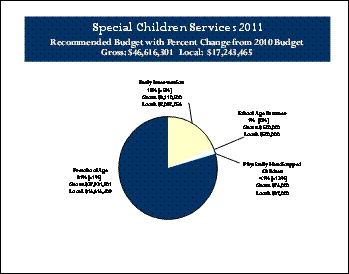 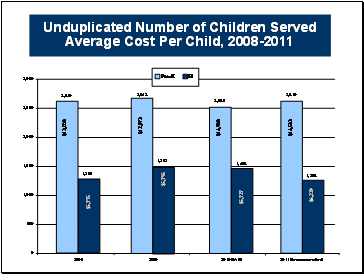
Appropriations are down by $795,000, but project that they will only realize One reason why they have been able to decrease requested appropriations
About $150,000 savings because there is a retrospective application of is that rates have held steady at the State level – costs per case for PreK
new standards. Services that were already rendered are now having have stabilized; amount per child has gone up a little for EI, but service rates
standards applied to them and it is highly likely that they will not be eligible have stabilized, caseload will go down a little because eligibility criteria has
for reimbursement by Medicaid.. Have proposed a memorializing resolution changed.
to the State to put a cap on this and not hold counties at harm for expenses
before new standards were applied.
 
Over time this has been a program for orthodontics and not necessarily
for children with developmental delays or handicapping . Feel this is an
optional program; in addition, Child Health Plus is going to start covering
orthodontics, did not in past. Will continue the services for the children
who are currently enrolled, would be a phase-out over 3 years..
Mr. Jordan asked if there are people exercising the ERI option in this area. Dr. Morrow clarified that this budget is only the program implementation; the staff are in the Public Health budget. The three staff members who have retired under Part A are the three that they would outsource. Dr. Morrow said the programs in Special Children Services are federally mandated; eligibility criteria for children to get services are defined by the State, a child’s needs are made on a case based on the child’s developmental delays. Feels they should maintain some service coordination in house to have a measuring stick of their own, County has to pay the bill. State covers 49% of the service. There is no income requirement, based on the child’s level of need, have to have a 33% delay in one of the five areas of development or 25% in at least two areas in order to be eligible.
Answers to Mr. Stanczyk’s questions:
- Projecting 1,300 children in EI (children up to age 3) – run through the State Health Department. Community based organizations pay the bill. State determines the rate by county.
- Projecting 2,600 for Pre-K (children age 3 – 5) run through State Education, but the County pays the bill.
- County gets reimbursed for transportation ($940,000 for EI, $6.6 million for Pre-K – about 700 children).
- Most Pre-K is center based - approximately 15 programs within Onondaga County to serve Pre-K, determination of which program the child is assigned is made by the school district. School district has the responsibility to determine what services the child is eligible for and where they are going to receive those services (required by State Education Law). County doesn’t make the decisions, but has to pay the bill.
- Reimbursement for EI is 49%, Pre-K – 39% and Medicaid – 100%.
- Have the ability to bill 3rd party insurance, the companies have not been forthcoming – have denials of service, requests for additional paperwork, back-up information, revenue is not nearly what it could be, this is a statewide issue, countless taskforces have looked at it. Dr. Morrow will share correspondence at the State level about this issue and what the loopholes are.
Mr. Stanczyk requested a breakdown regarding the transportation cost, number of people and what we are being charged.
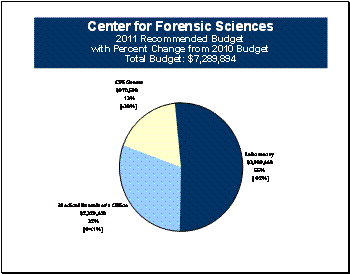 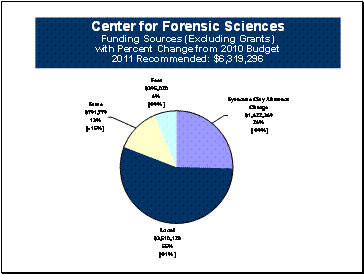
No significant changes in this budget. They are down grants because of what has happened at the state level with Criminal Justice. In the past they have used these grants to offset aging equipment, etc.

The budget being proposed is for a half a year, because they are currently in the process of looking at privatization of all Correctional Health services. Dr. Morrow noted the following:
- She believes Correction health should be done by clinicians not folks in public health practice.
- In April, was informed that the family medicine group at Upstate would no longer be able to continue a contract with them because of capacity issues; (they provided medical directorship and clinicians for Correction Health services).
- Their administrator with 15 years of experience resigned for personal reasons.
- Events listed above led to looking at doing things differently.
- Most important thing is to provide strong health care at the Correctional facilities.
- Privatizing would be a potential win for the taxpayers, win for the inmates (could get a provider who does nothing but Correctional Health) and win for Health Department (wouldn’t be providing a service that is a little outside her area of expertise).
- After reading the RFP’s, became more convinced that this is the right thing to do, these companies that do nothing but correctional health have the knowledge and experience.
- It may be cost neutral, but there will be long term savings – won’t be contributing to the pension system.
- Vendors have policies and procedures that they have tested for years. Implementation of an electronic medical records system is critically important, allows them to find areas of improvement that the current paper system does not.
- Will come back to the Legislature once the RFP committee has made their selection so that an informed decision can be made about transferring funds in 2010 – to transfer the contracted procedures such as Medical Director, physicians, dental, eye, and pharmacy services.
- Have asked to create an unfunded Compliance Officer in Health budget, would come back with the funding for it when they come with a request for transfer of funds from Health and Mental Health to Sheriff. The National Commission on Correctional Health Care noted that the counties or organizations that do better have someone monitoring – protecting the interest of the County and the inmates.
- Have money in the budget for half the year, if they do not privatize would need to have monies put back into their budget to support all the current operations.
Mr. Jordan asked about the fees for services. Dr. Morrow said it is pharmacy, pharmacy consultant, laboratory, dental, radiology and physicians.
Mr. Buckel questioned giving policy and procedure authority to someone else with privatization, the County is ultimately accountable and responsible. Mr. Buckle said when it comes back to the Legislature he will be looking at where the physicians are coming from, if they are qualified or not. Dr. Morrow said she wouldn’t be recommending an RFP if she thought it would compromise the County’s responsibility or the care of the inmates. The different levels of reference checks were the most important thing to her – by talking to comparable communities and making sure they were comfortable with the level of care that was being provided. Mr. Buckel asked what distinguishes the medical care other than that they are incarcerated. Dr. Morrow noted that there are very few situations as challenging as the complex medical and mental health behavioral issues that they face in Correctional Health.
In answer to Mr. Corbett, Mr. Troiano said the money is in the budget privatized or not; the process needed to go through involves meeting labor relation requirements under the Taylor law to negotiate this with unions that are involved. If this privatization does not happen, the Legislature would need to restore the money to the Health budget; it is now in the Sheriff’s budget for the second half of 2011.
Mr. Laguzza asked if the opportunity to combine pharmacy contracts of Correctional Health and Van Duyn has been investigated. Ms. Wilson said that Purchasing looked into combining all pharmacy contracts last year and it was more costly. Mr. Rowley noted that the vendors were allowed to bid all or one aspect of the RFP if they felt they could be more competitive by doing that.
DEPARTMENT OF SOCIAL SERVICES: Mr. David Sutkowy, Commissioner, Mr. Steve Morgan, Executive Deputy Commissioner, Ms. Colleen Gunnip, Ms. Patrice Gile, Budget Analyst
Mr. Sutkowy made the following comments and gave the following presentation:
DEPARTMENT OF SOCIAL SERVICES
2011 BUDGET PRESENTATION
SEPTEMBER 16, 2010
Good afternoon Mr. Jordan and members of the Legislature.
I’m pleased to present the 2011 recommended budget for the Department of Social Services.
What I would like to do today is threefold. I’d like to give you a quick snapshot of the overall DSS budget and where we stand, give you a general overview of what DSS budgeting is about – the factors that drive our budget, and then talk about what I think are the specific issues with respect to our 2011 request.
2011 Budget Overview
In terms of the overall financial profile, our 2011 recommended local budget – and I’ll focus on the local here – is $139,770,952. This is $16.7 million – or 13.6% more than the 2010 BAM. While this level of increase is significant when compared to recent years, the vast majority (over 2/3rds) is attributable to Medicaid, which I’ll explain in more detail later in my presentation.
There are three major parts to our budget – the Program Accounts, Purchase of Services, and Administration. Compared with our current local budget,
Our local Program costs are up 15%,
Our local Administration costs are up 5%, and
Our local Purchase of Service costs are down 3%.
General Overview of DSS Budgeting
When looking at the DSS operation, I fear it’s easy to get intimidated by the size and scope of what we do and how much we cost. While our budget is often seen as terrifically complicated – given the variety of services we provide, the mandates we have to follow, and the assortment of ever changing reimbursement streams, in some ways it’s also pretty easy to understand.
 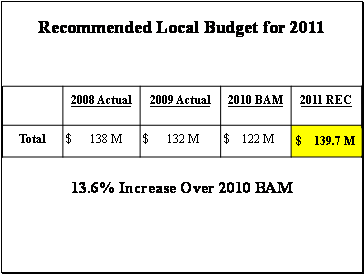
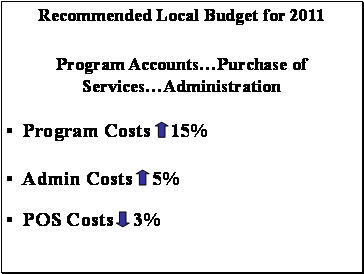 
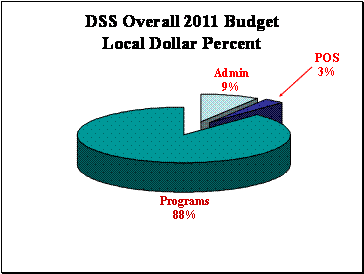 
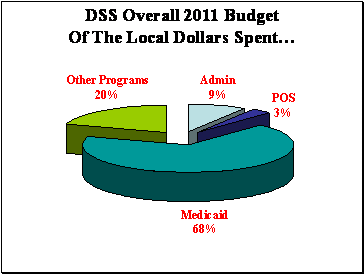 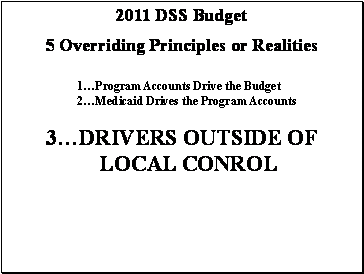
 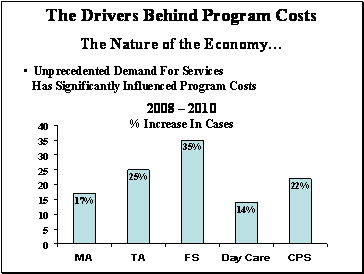
Poverty rate in the country is the highest it has been in 51 years – 14.3% in 2009. Private sector covering 7 million fewer Americans than it was last
Year.
 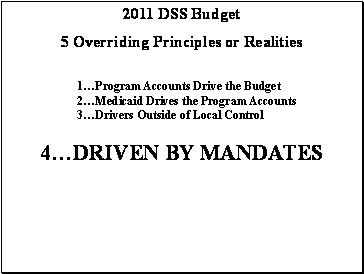
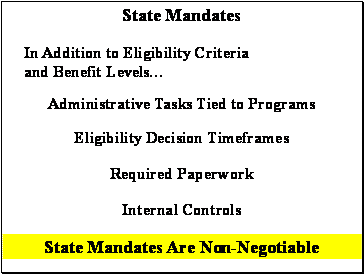 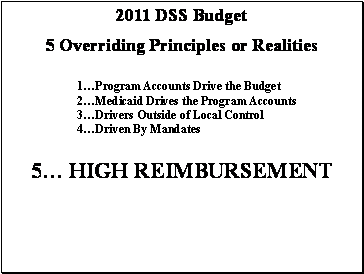
 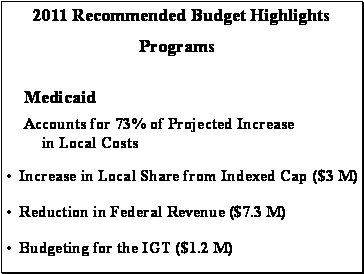
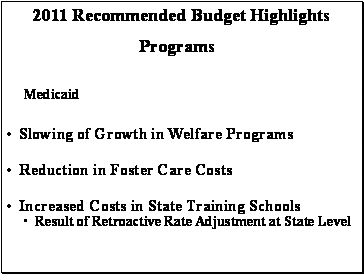 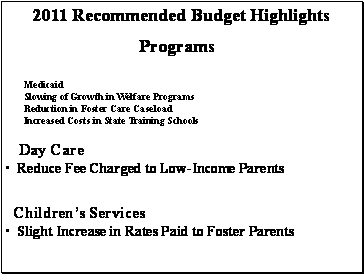
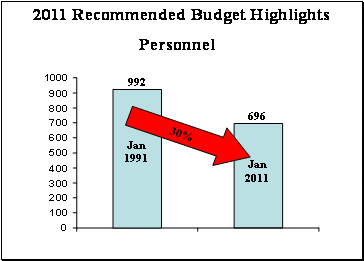 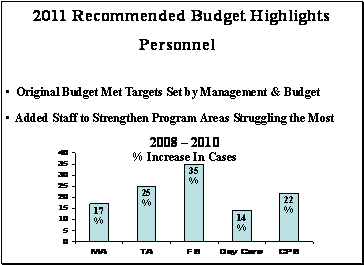
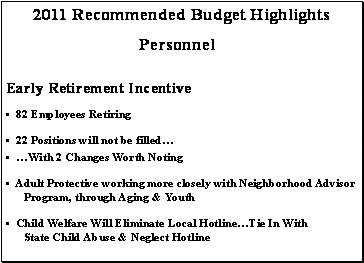 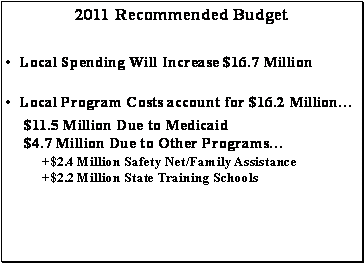
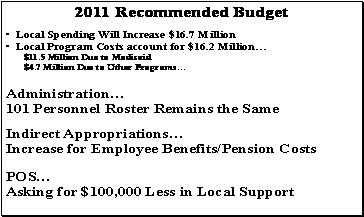
Mr. Jordan requested a list of positions that are being vacated due to the Early Retirement Incentive (ERI) and positions that will be refilled. Mr. Jordan asked if they would have difficulty meeting the 50% salary savings requirement. Mr. Rowley said they knew going in that some departments would not make the 50% target, is confident that they will meet the goal considering all the departments.
Mr. Warner asked the number of services provided by Medicaid in New York State that are above and beyond what the federal government requires. Mr. Sutkowy said the federal government requires certain base services and there is a menu of optional services from which the State can choose; it is his understanding that New York State has decided to provide all those services. Mr. Warner request a list of those services and the cost associated with them. Mr. Warner requested information regarding who pays for health/hospital costs for illegal immigrants. Mr. Warner asked about Medicaid fraud. Mr. Sutkowy said it is their job to identify those individuals and take appropriate action; they respond primarily to reports, inquiries from the public and third party data. Mr. Sutkowy will provide information regarding the percentage of cases that are found out to be fraud and then compared to other counties across the state and also dollars associated with that. In answer to Mr. Warner, Mr. Sutkowy said part of the state legislation this year asks the State Health Department to develop a plan for the eventual takeover of the Medicaid administration, not the cost. State Health has to report back this November to the State Legislature with their initial findings. Mr. Sutkowy said the process of the state taking over the administration of Medicaid is loaded with pitfalls, can’t image that it will occur with any degree of haste. Mr. Morgan said there is no local cost for Medicaid staff, fringe benefits and related costs in their budget because the local share of their administration is paid for in the cap payment. The recommended for 2011 for Medicaid is about $10.4 million in gross appropriations (includes salary, fringe overhead and all related costs).
In answer to Mr. Stanczyk, Mr. Sutkowy said:
- There is no local cost to signing people up for food stamps
- Food stamps is their fastest growing population, 52% increase since 2008 – about 42,000 individuals
- Eligibility is based on the federal poverty level – 130% for most individuals, 160% or 165% for elderly or disabled; our county is in the top 3 or 4 in the state due to great relationship with the Food Bank, food pantries and publicizing what people might be eligible for on the website - Mybenefits.ny.us
Mr. Stanczyk said he wants to make sure they are focusing on the elderly population.
Mr. Buckel said based on figures that Mr. Rowley has provided on the total cap line, Medicaid anticipated expense is going up about 1.7% from last year; difference is that we are not going to get reimbursed with the one shot deal from the federal government. Thinks Medicaid is being unfairly used as a scapegoat to avoid responsibility for things we can control. Mr. Morgan said the 1.7% figure is inaccurate; the cap grows by 3% every year. Mr. Buckel agrees with Mr. Warner that the real issue is to call upon the state to assume the costs, can change some of the eligibility criteria because we are more generous than other states. Mr. Buckel asked if going more to managed care has had an impact on the overall cost structure. Mr. Morgan said managed care saves money in terms of services to Medicaid recipients, the only way it is going to help the bottom line is if the cap gets changed. Over the last two years, the cap has saved the county $10 million. They try to keep the costs down whether it is through managed care, fraud detection or any other initiative; does not change the bottom line that they have to pay every year to the state for the cap.
Mr. Warner asked what percentage of our property tax is Medicaid. Mr. Rowley said 53%. Mr. Stanczyk noted that the cap goes up $3 million a year, let’s talk about the $65 million that came in that is not talked about, to say the problems we are having is because Medicaid is up is not on line.
Mr. Jordan noted that they show local dollars for the Medicaid budget for 2010 Adopted at $83,315,040; in 2011 it is going to be $94,841,959 – an $11 million increase. Mr. Morgan said $3 million is related to the index cap, $7.3 million is a reduction in stimulus money, and another $1.2 million IGT which benefits Van Duyn. Mr. Jordan said the bottom line is that it is costing the taxpayers another $11 million to provide Medicaid to the citizens of Onondaga County.
Mr. Rhinehart asked how many county employees are at stations taking on-line applications for food stamps. Mr. Sutkowy said the food stamp and Temporary Assistance staff are connected – 45 workers. Mr. Sutkowy said they have to act on every application they receive, determine their eligibility, and then issue the appropriate decision. On-line has enormously increased the volume of work, some of the increase is associated with the economy, some is because it is easier now to apply for benefits, doing this now with 62 fewer people department wide than last year. A worker has to review the application, determine what documents are required for approval, send out the document check list and then pending the case until the documents are received. Mr. Rhinehart asked about the County’s involvement in the Say Yes to Education Program. Mr. Morgan said this is in their grants budget; in essence, they are a pass-through for this money (no county employees). They contract with Say Yes, money flows through them from the State to Say Yes, the foundation puts up the local share through private donations; there are no local dollars in their budget for this. Mr. Rhinehart asked if the new computer software (Peoplesoft) would help their department. Mr. Morgan said it will help them with the main county systems; they have their own set of systems that the state prescribes to get payments out the door. Mr. Rhinehart asked if Jobs Plus would be giving money to Jazz Fest again this year. Mr. Morgan said “no”.
The meeting was adjourned at 4:00 p.m.
Respectfully submitted,
Johanna H. Robb, Deputy Clerk
* * *
WAYS AND MEANS COMMITTEE REVIEW OF 2011 BUDGET
WAYS AND MEANS COMMITTEE DEPARTMENTS
September 17, 2010
CHAIRMAN CASEY JORDAN
MEMBERS PRESENT: Mr. Corbett, Mr. Holmquist, Mr. Buckel, Mr. Warner, *Mr. Stanczyk, **Mr. Lesniak
MEMBERS ABSENT: Mr. Kilmartin, Mr. Kinne
ALSO ATTENDING: Mr. DeMore, Mrs. Ervine, Chairman Rhinehart, see attached list
Chairman Jordan called the meeting to order at 9:05 a.m.
PERSONNEL: pg. 3-190 - Jennifer Wells, Dir., Civil Service; Carl Hummel, Dir., Employee Relations; Lorraine Bissi Greenlese, Executive Assistant; Peter Troiano, Commissioner, Erin Esgro, Budget Analyst
Commissioner Troiano provided the following:
I would like to highlight some of our major functions before reviewing the specifics of the 2011 budget. The Onondaga County Personnel Department has two major focus areas:
- To function as centralized personnel management and employee and labor relations office for 4,000 county employees and managers; and
- The administrator of the NYS Civil Service Law for over 15,000 classified positions in the County, City of Syracuse, 19 towns, 15 villages, 17 school districts, 3 library districts, 4 fire districts and 4 special districts.
The activities such as labor relations, training, salary and wage administration and benefits administration that you generally see as legislators are associated with our overall HR role for County government. However, an equally significant and somewhat larger portion of staff, time, effort costs and expenditures are attributable to our role as municipal civil service administrator where we provide services to the public at large and ensure compliance with Civil Service Law by all 66 municipalities and districts within Onondaga County in their role as public employers.
DIVISION OF CIVIL SERVICE ADMINISTRATION
The Onondaga County Department Personnel has long functioned as a consolidated sourcing entity for Civil Service Law administration for all-public employers within Onondaga County.
Personnel staff review and approve over 14,000 personnel transactions per year. These include appointments, promotions, salary changes and terminations. We are also required by state law to certify the payrolls of all 66 municipal entities at least once each year. A major function of the Civil Service division involves administration of the state-prepared civil service examinations for all the municipalities within Onondaga County. Typically about 200 different examinations are scheduled each year with about 5,000-6,000 applications received and reviewed. However, when the economy is slow and unemployment is high, public employment tends to become more attractive. We continue to experience a greater number of examination applications this year and expect that trend to continue in 2011 resulting in over 7,000 exam applications. For 2011 going forward, we will become heavily involved in bringing up the HR component of the PeopleSoft platform. That will enhance our ability to support personnel functions of each county department and agency with respect to position and pay history, personnel transactions and record-keeping, and data management. These services will also be available for sourcing to towns, villages, school districts and other public employers with PeopleSoft capabilities.
Our website continues to be our most popular source of information about civil service employment and the examination process accounting for almost one quarter of our applicants. The automatic e-mail notification of exam announcements has proved to be a great customer service improvement. Instead of periodically checking our website or visiting the office, candidates can sign up on our website to get an automatic e-mail alert whenever an exam announcement that interests them is published. They can sign up to be notified of all announcements or just for certain titles or job families. We have over 6,000 people registered for that service. The Personnel Department has all but eliminated paper medium for information available to walk-up customers. Job descriptions, eligible list results and other information is now available by electronic means. Paper versions of forms and documents that applicants need to take with them are available in paper and electronic formats.
Personnel Department staff has been fully engaged in department staffing reorganizations and redesigns including most recently IT Department and Division of Purchase. We have provided guidance and expertise in position classification and design and help navigate through the legalities of Civil Service Law with respect to staff appointments in order to move these initiatives forward.
DIVISION OF PERSONNEL ADMINISTRATION AND EMPLOYEE RELATIONS
Activities for the Division of Personnel Administration and Employee Relations division involve assisting departments with processing grievances, pursuing disciplinary proceedings, investigating harassment and discrimination complaints, and advising departments regarding a variety of federal and state labor, employment and Equal Employment Opportunity laws.
Collective bargaining continued during 2010 with the remaining bargaining unit not presently under contract. The fact-finding process was conducted throughout the spring and summer and is nearing conclusion. Recommendations to resolve the dispute are expected to be issued by the Fact Finder shortly. Looking forward to it 2011, preparations will begin for bargaining with two units of deputy sheriffs, which will take place later next year.
The Personnel Administration and Employee Relations staff has been actively engaged in competitive sourcing initiatives during 2010. These initiatives included DSS Homefinding Program, LTCS OT/PT programs and the Student Assistance Program in Mental Health. Under way are competitive sourcing initiatives for Correctional Health Services and food services operations at OCDC. These proposed initiatives are contingent on fulfilling the labor relations obligations under the Taylor Law as well as considering and assessing alternatives which may be brought forward by employees or their employee organization representatives.
A major initiative involving Personnel Department staff in 2010 was the management of the Retirement Incentive Program. Part A has been completed with over 300 employees opting to participate. Savings plans required by the program allow for between 70 and 80 retirees returning to employment with most limited to part-time employment for short-term periods of time. Part B begins October 1, 2010 and extends through December 29, 2010. Both the number of employees eligible to participate as well as a number expected to participate will be far smaller when compared to Part A levels. Personnel staff managed the record keeping, notifications and submissions to NYSERS, employee counseling, daily communication and contact with NYSERS representatives and arrangement of the well-received information presentation for eligible employees.
2010 line item highlights:
101 – This appropriation funds 20 positions. Two positions are part-time positions relative to the ERI program. The roster also contains 12 Administrative Intern positions which are assigned and charged back to the participating departments. Currently six (6) Administrative Intern positions are filled.
300 – This account funds normal office supplies as well as the materials needed to provide employee and vendor ID cards, both new and replacements. The supply of cards purchased under a grant and which lasted through June 2010 have been used up. New cards stock is needed.
401 – This account funds a variety of training programs including in-house, OCC, and contract trainers for courses such as supervision, performance management and enhancement training, computer skills, diversity training and facilitation skills. Funding for training held at 2010 amount.
408 – This account funds the medical examinations and physical agility tests required for police candidates in the Sheriff’s Office, the Syracuse Police Department, and the town and village police departments. These are mandated NYS civil service requirements but the number held each year varies by the amount of hiring done by each of the police agencies in any given year. A small portion of this account also pays for monitors at the civil service examinations sites.
410 – This is primarily the portion of collected exam fees required to be paid to the NYS Civil Service Department for examination services and is directly related to the actual number of exams held and candidates tested in a given year. The increased population of applicants means that additional fees are owed to the State. In 2010, the fee calculation was changed by NYSCSD from the number of candidates tested to the number of exam booklets provide resulting in more paid to NYSCSD and less retail by the County to offset expenses.
413 – This account includes rentals of exam sites when we cannot use OCC or other free space, rental of our copier, some maintenance and repair.
810 Revenues - Exam fee revenues vary each year depending upon which exams are scheduled by NYS and how many candidates apply. We anticipate 6,000 – 7,000 applicants in 2011 including approximately 2,000 applicants for public safety exams.
The following answers were provided to Chairman Jordan’s questions:
- 410 increase due to number of individuals taking civil service exam
- Half of the exam fees received are sent to the State; other half goes to general fund to offset expense. A portion of the 410 account is a mirror image of the 810 account
- Other expenses in 410 include: membership in associations, credit card fees, occasional bounced check fees, notary fees
Mr. Corbett asked about the number of interns. Mr. Troiano said that there are 12 positions in the county; 6 are filled. They are housed on Personnel’s payroll, but work out of other departments and those department pay for them.
Mr. Holmquist asked about any new personnel changes in the department, and implementing new initiatives. Mr. Troiano noted:
- PeopleSoft platform implementation will improve current system
- Staff changes – 2 people left; in process of replacing one person; expect to fill the other position after the budget process
- While people are assigned to two divisions, trying to make sure that they are able to keep one foot inside each function, so that if someone is out they are able to assist and the information flows back and forth. Difficult to do – Civil Service portion is extremely technical and labor relations side is an extreme type of niche – trying to use existing staff optimally
Mr. Buckel asked if there are things the County can do that are innovative, different, that address the benefit situation to allow us to provide the full fare appropriate benefits, but at the same time work to drive that line in the future. Mr. Troiano noted:
- 2 components of benefits are pension and health benefits
- Innovations can be looked at on the health benefit side, i.e. heath benefits accounts
- Success in keeping growth line stable by virtue of the Health Benefit Coalition over the last 12 years
- Pension – tricky because of longevity of some staff and various tiers, which tend to be more expensive than if there were replacement employees at Tier 5, less expensive going forward
- The key is: can State fund far better than it has; Albany can be asked to consider more pension reform
- Because self insured for health benefits – have much better control as opposed to paying premiums to an insurance company
- Continue to look at vendors, i.e. prescription, dental
Mr. Corbett asked what the family plan hourly contribution would be for an average county employee. Mr. Troiano will do the calculation and report back to Mr. Corbett.
Chairman Jordan referred to CanRX, which was discussed last year; he asked if there had been any further consideration of it. Mr. Troiano stated that it will not be useful for the County. There is a question as to whether or not it is in compliance with federal regulations to participate in it. If not, and the risk is taken to participate, what is the liability. At one point he was told that CanRX was going to provide a $1 million indemnification for each claim filed. He asked them to produce it in writing, and has not received it. County has done well with current PBM, ProAct in keeping all prescription costs stable. It is driven by pricing of the plan and driving as many users to the generic side as possible. He has learned that for those employees who have gotten involved it in; it has helped them if they were willing to take the risk of the regulatory issue and if they had co-pay arrangements with their employees and employee organizations, which were much more severe for them. If there were very low co-pays that employees had for either generic or name brand drugs, it made sense for them to incent them into CanRX by agreeing with their employer organizations to raise those to less than competitive levels and keep the CanRX ones lower. Because of the work through the Coalition and employee organizations, prescriptions co-pays have not stayed static; some based on a percentage basis so they move along with the price of the drug. There has not been much growth of CanRX; has plateaued. Some have done very well with; it is because of their co-pay arrangements.
Chairman Jordan said that he was told that the numbers were crunched by DMB and difference in cost wasn’t as significant as originally thought to be. Mr. Troiano said that compared to what the cost of the prescription drug program is and what we are expecting to achieve in terms of cost stabilization through ProAct it didn’t make sense and still doesn’t. Mr. Rowley added that CanRx is a program where there is savings in brand name drugs. Part of the analysis that was looked it was that if a CanRx plan was adopted, it would eat into the ongoing efforts to shift people to generic drugs, where a substantial savings is realized in the ProAct plan now.
Mr. Warner said that for the past 10 years he has looked into the CanRx issue. When it started out, it was a very beneficial program; Lewis County started with it 10 years ago; school districts and other counties have going into the program. He has observed that in Onondaga Co. the suppliers have drastically reduced their process under the threat that we were looking at CanRX. Once the program was looked into, prescription drug prices started dropping way down. If we accomplished nothing else, their feet were put to the fire and have taken those huge, excessive profits out of their companies.
Chairman Jordan announced to the Ways and Means Committee that in addition to the budget presentation, copies of resolutions will be distributed, which will be voted on at the time that the Ways & Means Budget report is voted on. He suggested members look at the resolutions ahead of time.
CNY WORKS: Page 3-204; Lenore Sealy, Executive Director of CNY Works, Edie Williams, Budget Analyst
Ms. Sealy noted that they are not for profit, which evolved from two former municipal organizations – City of Syracuse and Onondaga County. There are two people who maintain county lines in their budget – her position, execute director, and one front-line person. Are evolving away from municipal payrolls. There are still 4 people at CNY Works who maintain a city line. All of the revenue to support salaries and benefits are federally funded. They are billed from Co. Comptroller and reimburse the County for cost associated for individuals on the county line.
Ms. Sealy provided the following:
Background
- Non-profit 501(c)(3), and one of 33 Local Workforce Investment Boards across New York State
- Operating budget
- Federal Workforce Investment Act (WIA) formula grants
- Temporary Assistance to Needy Families (TANF)
- State and federal discretionary grants, including WIA
- American Recovery and Reinvestment Act (ARRA)
Strategic functions
- To develop, attract and retain a workforce that will support economic prosperity for the community and region
- To develop workforce development strategy for Onondaga County (State reference - Local Workforce Investment Area/LWIA)
- Partnership between Chief Elected Officials – Onondaga County Executive, Mayor of Syracuse and Board
- Defined via local workforce plan (and modifications)
- To define workforce policies that support Onondaga County’s workforce development strategy
- To garner support to drive local (moving toward regional) workforce strategy
- Financial
  Workforce Investment Act (WIA) Formula grants - US Department of Labor NYS Department of Labor Onondaga County Workforce Investment Act (WIA) Formula grants - US Department of Labor NYS Department of Labor Onondaga County - State competitive grants – NYS Department of Labor, NYS Office of Child and Family Services, NYS Office of Temporary and Disability Assistance
- Federal competitive grants – US Department of Labor (Employment and Training Administration)
- Partnerships/Collaborations
- Business
- Education
- Economic development
- Community services
- Government
- To measure success as defined by Board (Chief Elected Officials, business, community, education), funders, public
- Common measures (Follows WIA funding)
- Performance indicators (follows NYS DOL – Wagner-Peyser requirements)
- Board
- Customer service
- Partners, public expectations
- Major challenges
- To address the alignment of skills (educational, career) of available workforce with needs of employers to be competitive and thrive
- To support the strategic community and regional workforce development efforts within the confines of funding requirements
- To address (often competing) missions and goals of administrative and funding entities, authorities and accomplish the real and necessary workforce issues
Operational functions
- To implement workforce services and strategies for job seekers, unemployed, underemployed, emerging workers (youth), employed workers and businesses in Central New York
- To provide services through (One Stop) Career Center model
- Hours – 8 to 5 (M, W, Th, F); 8 to 8 (Tuesdays)
- Weekly additional evening hours to accommodate customer services – Trade Act, orientations
- To provide summer workforce program for income-eligible youth
- To provide decentralized career services to improve access for dislocated workers, youth, low income and individuals under-represented in the workforce
Customers by program year (July 1 – June 30) since 2007
|
2007
7/1/07 - 6/30/08 |
2008
7/1/08 - 6/30/09 |
2009
7/1/09 - 6/30/10 |
2010 Projected
7/1/10 - 6/30/11 |
Customers |
15,330
|
19,458 |
22,350 |
15,856 |
Services |
27,203
|
40,687 |
44,949 |
41,827 |
Trade Act Customers
- Subset of Dislocated Worker cohort
- Current petitions include
- Angiotech (BG Sulzle)
- Bank of New York
- BorgWarner
- Crucible Specialty Metals
- CWR Manufacturing
- Honeywell
- New Process Gear/Magna Powertrain
- Syracuse China
- Syracuse Gauge
- TRW Automotive
- Deeper customer training and Unemployment Insurance benefits
- Requires more staff intensive services
- Additional orientation to Trade Act benefits
- Special waiver (in person interview) every 30 days while receiving benefits
- Training plan development/guidance
Major funding by program year (currently required to spend minimum 75% of WIA grants during award year and 100% of TANF during summer award period)
|
PY 2009 Allocation |
PY 2010 Allocation |
Net Change |
% Change
2009 - 2010 |
Adult |
877,068 |
837,043 |
(40,025) |
(4.6) |
|
Youth |
1,014,757 |
947,605 |
(67,152) |
(6.6) |
|
Dislocated Worker |
860,167 |
952,305 |
92,138 |
10.7 |
|
TANF (Summer Youth Employment) |
707,167 |
325,733 |
(381,434) |
(53.9) |
|
TOTAL |
3,459,159 |
$3,062,686 |
(396,473) |
(11.5) |
|
Accountability
- US Department of Labor – statutory, regulatory
- NYS Department of Labor – policy, performance measures
- Onondaga County – grant recipient (legal obligation)
- Board – 50 %members appointed by County Executive, fiduciary responsibility; fiscal agent (on behalf of County)
- Other elected officials – Congress, Assembly
- Public – officials, citizens
Reporting requirements
- Financial
- Monthly expenditure to NYSDOLWeekly cash to NYSDOLMonthly to other funding sourcesMonthly to Board’s Executive CommitteeBi-monthly to BoardProgramMonthly to NYSDOLQuarterly reconciliation with NYSDOLDepending on other funding requirementsMonthly To Board’s Executive CommitteeBi-monthly to Board Ad HocRegularly, at least twice per month
- Financial and program
Chairman Jordan asked about rudimentary deficiencies and attitudinal barriers, and asked how these barriers are addressed; how are unproductive attitudes towards work ethic corrected. Ms. Sealy said it is challenging. There isn’t a one size fits all answer. The more engagement that a dislocated worker or disengaged youth has with people in her office, the more likely they are to overcome challenges. The hard piece is with the number of people seeking services; there are a lot of people going through fairly small per capita staff ratio. Specifically they have training grants for businesses, customer support training, communication skills, etc. If evidence is seen that there is a challenge, then they reach out. It might be something so severe that the person may need additional training before they can be referred to another job.
In answer to Chairman Jordan, Ms. Sealy explained how they measure their success. The Workforce Investment Act dollars have very specific metrics. They are judged by it every year; a report card is received quarterly. There are standards that they have meet, very clear deliverables. Chairman Jordan asked to be provided with the metrics.
Chair Jordan asked about line 102 – overtime increased to $8,000 for 2010, 2011 from $5,333. Ms. Sealy noted:
- It will likely go down next year – now only 2 people (she is one of them and doesn’t get overtime, the other co. employee is not one who would be sent out to train)
- Tied to rapid response letters or calls when a company is downsizing and they are obligated to turn around quickly and go out and do sessions with company reps
- Have to deploy people very quickly, not a lead time, have to deploy people who have likely worked a full cycle, then goes into overtime
- Federal funds support all overtime
In answer to Chairman Jordan, Ms. Sealy said that a youth counselor position and an employment training program planning specialist will be unfunded. Youth Counselor will be supported through non-profits, the employment training program planning specialist is working reduced schedule through the non-profits.
Mr. Corbett asked about the total appropriation going from $418,201 in 2010 to $231,391 recommended in 2011, but the local dollars are increasing from $56,021 to $81,871. Ms. Sealy explained that it is tied to county retirees’ health insurance.
Mr. Warner asked about 22,850 distinct customers last year, receiving a total of 44,949 unique services. Ms. Sealy said that one customer could be receiving a number of services. Projection for next year is 15,856 distinct customers; receiving 41,827 services. The ratio of services that each customer is receiving is increasing. Mr. Warner asked how that can be done with two less people. Ms. Sealy noted that it will be difficult; they are launching an event, Career Connections, a partnership with News Channel 9 at Oncenter on Sept. 30th. It is free; there will be business there with job openings, 50 hrs of free workshops/info sessions.
* Mr. Stanczyk arrived at the meeting.
Chairman Rhinehart referred to $30k increase for retirement. Ms. Sealy said that when county employees retire, they are eligible for retirees’ health insurance benefits. There is a total of 11 retirees; Mr. Seitz said that the county cannot get federal aid for the health benefit expenses. The grants allow for benefit reimbursements while they are employed, but not once they retire. In answer to Chairman Rhinehart, the 2 positions unfunded are not employees of non profits, employees of CNY Inc.; they will get NYS pension, but the county is not contributed costs to their retirement anymore. They are part of the $30k increase for the health benefits. Mr. Seitz noted that there are 9 retirees getting health insurance now; there is not federal reimbursement for them. As they retire, it becomes a total local charge; when they were active, it was $0 local. Mr. Fisher noted that migrating workers off the county payroll was a decision made years ago and saved the county substantial money. There is a legacy cost of the people that were county employees, that whenever they were to come off the payroll and retire, county retirement costs would go up. It is happening now because they have taken advantage of ERI.
PURCHASING, Pg. 3-210 – Sean Carroll, Acting Purchasing Director
Mr. Carroll provided the following:
The Division of Purchase is a service department, with other departments and other municipalities as internal customers. Each day, the Division of Purchase creates opportunities for savings, helps manage departmental relationships with vendors, manages the County’s procurement obligations under the law, and empowers departments to get the goods and services they need to perform their primary functions. The Division is currently responsible for procuring approximately $100 million dollars of goods and services through purchase orders, contracts or Requests for Proposals, using less than 1% of the County’s personnel and budget.
Our most valuable resource is our staff, a team that has over 225 years of experience. Three of our valued staff members were eligible for and took advantage of the Early Retirement Incentive (ERI) offered in July and August. Our most recent Director, Patricia Mosley, one of our Assistant Directors, Cheryl Muldoon, and one of our senior buyers, Debbie Donovan Miller, have all retired. Cheryl Muldoon has been retained part-time in order to preserve as much institutional knowledge and departmental continuity as possible during the transition and she is reflected part-time in the 2011 budget as well.
In accordance with the requirements to show savings, and the ERI requirements, the Division of Purchase initially proposed a very austere budget. The Department of Management and Budget estimates our savings to be over $161,000 in 2011 alone, well over the amount required. However, a new opportunity to modernize government has driven us to revise our request and recommend the budget as presented by the County Executive.
Much discussion has gone on in this chamber regarding the duplication of service across the levels of government in Onondaga County. The procurement function has long been a topic of discussion as an opportunity to leverage the buying power of the many municipalities and to reduce administrative duplication by centralizing the function for multiple municipalities. It provides fertile ground for reducing waste and duplicative services while increasing government efficiency through shared services.
In this budget we begin to seize that opportunity. Included with our budget is a resolution which, when authorized, will allow Onondaga County to provide procurement administration for the City of Syracuse and any other municipality that chooses to enter into an inter-municipal agreement with the County for these services.
This arrangement will allow us to achieve a number of goals. By combining the buying power of the County with that of as many municipalities as possible, we expect to be able to reduce the costs of purchasing goods and services for taxpayers throughout the county. We will optimize the procurement process by reducing the need for duplicative procurement contracts, establishing best practices and creating product standards, further reducing costs and increasing savings.
In addition, this arrangement allows us to leverage the combined City and County Purchasing expertise. At many levels of municipal government, the procurement function is performed by financial officers or other administrators for whom purchasing is not the primary function. This means that the same questions of law, the same issues with vendors, the same research regarding state contracts and many other regular tasks are repeated over and over at each level of government and the primary function at each level suffers. Together, the County and City Purchasing Departments become more than the sum of their parts. The combined expertise will create an environment in which any service or commodity needed by a town, village, or other municipality can be purchased through a consolidated contract managed by the County Division of Purchase. This will create many chances for towns and villages to operate more effectively, while spending less tax dollars in the process.
Finally as more of this work is managed in a cooperative manner, additional opportunities to leverage technology, to gain efficiencies, modernize local governments and reduce the burden on taxpayers will become apparent.
As with all initiatives to modernize, there are costs as reflected in our recommended budget. This effort is expected to at least double the volume of purchases made through the Division to more than $200 million. This added volume and the additional support needed for these services drive the incremental increased costs required in this year’s budget. This budget represents the minimum staffing levels required to accommodate the modernized department. We expect these increases to be offset by direct savings achieved through volume discounts and indirect savings through achieved efficiencies.
This concludes my presentation. If you have any questions about our budget request, or how these changes will affect our service in 2011, I will be happy to answer them.
** Mr. Lesniak arrived at the meeting.
Chairman Jordan noted that there is increased personnel funding by $54,475 as a result of intermunicipal agreement, and noted that there would also be a cost for fringe benefits. The additional cost should be increased by 62% to allow for fringe benefits. Mr. Carroll agreed and noted that they would need to recover 3/10th of 1% through volume discounts to cover the cost of this program. Chairman Jordan questioned why the budget includes funding for $10,000 of additional equipment. Mr. Carroll stated that the office space needs to be made to accommodate the additional staffing, which requires some reconfiguration of space, allowing computers, etc.
Mr. Lesniak questioned how the $54,000 was determined – looking at the salaries of the three positions. Mr. Carroll noted that 3 members of the staff took advantage of the ERI; there was significant savings in 101 line already, which offset the upfront costs in personnel. Mr. Lesniak said that they will escalate dramatically for the 2012 budget. Mr. Carroll noted that the 101 line in the budget is net. There would not be significant increases, other than salary increases, from the number represented in 2011 recommended budget.
Chairman Rhinehart referred to $60k for capital outlay for furniture. Mr. Carroll said that is no longer necessary, and the line has been reduced accordingly. Chairman Rhinehart asked about the new position of Clerk II and questioned why it isn’t a Clerk I. Mr. Carroll said that there are subtle differences in the job descriptions, would like to use the person to the fullest capacity as possible and assign them to as many tasks as possible. Chairman Rhinehart asked if Purchasing will be the first to utilize PeopleSoft. Mr. Fisher said that the first applications will be the financials. Fiscal officers will use the financial piece, Management and Budget will use the budget piece, and all procurement applications will be used by Purchasing. Departments will use PeopleSoft for part of their purchasing; when it is turned over to buyers, they will use it for another function in purchasing process.
Chairman Rhinehart referred to the purchasing consolidation and agrees with the goal to consolidate – asked if any of the other government entities will contribute to it. Mr. Carroll said that the municipalities are invited to participate; cost being borne is the total amount seen in the budget. Mr. Fisher said that they have heard form one village mayor and one town supervisor. They were told that it will not cost them anything; taxes will pay for the buyers and the towns and villages won’t have to pay for anything. In answer to Chairman Rhinehart, Mr. Carroll noted that the increase in local appropriations have to be reflected somewhere, but are expected to be offset between all of the lines carried by the other departments in savings that will be recognized.
Mr. Buckel asked if any computations of projected savings have been made. Mr. Carroll said that they are in the process of looking at how that will happen. Contracts are on a cycle, so the first thing to look at are the contracts coming up for bid next year and how the increased volume with affect them. There are some successful cases of this sort of thing working. Hudson Valley is recognizing substantial savings because of their volume. The success will depend on how many participants there are. Mr. Buckel asked which categories will show the most benefit. Mr. Carroll said that he wants to be careful, as sometime unexpected things happen – will start with the things that everyone buys, i.e. pencils. The increased volume will show an immediate result in the low hanging fruit. Treated salt is bought as a combined effort, it saved $51k compared to the state contract price. Mr. Carroll said that they believe they have proposed the minimum staffing needed to be successful on this. A successful agreement without the ability to provide the service would be inconsistent with attempt to provide shared services.
In answer to Chairman Jordan, Mr. Carroll said that they had 3 people that participated in the ERI, one is returning part-time. Ms. Venditti answered that the salary savings for 2011 will be approximately $130,000. Chairman Jordan questioned why additional staffing is needed.
Chairman Jordan questioned the need for additional staffing, if there will just be larger quantities of the items being purchased. Mr. Carroll stated that there will be commodities that will come over that are unique to the City, i.e. Fire department commodities, school commodities – which are different than what the county does now. IT will be a one time modernization of the department.
Mr. DeMore questioned the ability to beat state contract prices. Mr. Carroll said that the state contract prices often reflect transportation and labor rates to NYC, and not all of those things apply to Onondaga County. Vehicle purchases on state contract are the lowest price that they can get, as it is the build out price from the manufacturer. On a lot of other commodities, where there is an opportunity to lower the cost below state contract price, then it is their intention to do that. In answer to Mr. DeMore, Mr. Carroll explained that salt is on state contract. When the salt was bid as a combined contract, the price secured was lower than the state contract. The state has currently renegotiated the price and Purchasing is evaluating their price compared to the County’s.
BOARD OF ELECTIONS, pg. 3- 125 -Helen Kiggins, Edward Ryan Commissioners
Commissioners Kiggins and Ryan provided the following:
2010 will see the full transition of Onondaga County to a new optical scan voting system called the ImageCast. In the past 95% of our voters voted on the lever machines. Now 100% of the voters will be voting on paper. The paper ballots provide for a transparent, fully accountable election.
Most voters with a physical challenge are now able to vote independently and in private.
We have reassessed all our polling sites. Many were no longer large enough to accommodate us. We looked for larger sites that provide better parking and larger rooms that accommodate an adequate number of privacy booths to prevent long waiting time for voters. We have reduced the total number of sites from 203 to 176. We have developed a floor plan for each polling site to streamline the flow of traffic in each site.
Larger poll sites also allow us to reduce the number of inspectors we need and to use them more efficiently. We discovered last year that not all inspectors were comfortable with the new voting system. We came up with three categories of Inspectors. Polling Site Managers for large multi-district sites, Voting System Specialists and regular inspectors. Polling site managers and voting system specialists receive additional hands on training on the new voting system. During our spring training we asked them what job they would like to do. Approximately 30% were interested in the additional training.
We continue to partner with OCC. The political science professors make being an election inspector part of their curriculum. This allows the students to be part of the democratic process. It also provides us with a young, energetic group of poll workers.
With the transition to an optical scan voting system our costs for printing ballooned. Vendors were charging .57 cents a ballot. We approached the county’s print shop and discussed our needs. They were able to produce the same ballot for around .15 cents.
Additionally, because they are located in Syracuse, we are able to print fewer ballots up front. If a site needs additional ballots we are able to print on demand and deliver the extra ballots where needed.
The print shop prepared the ballots for Tuesday’s primary. We had 616 different kinds of ballots. On primary day only one ballot out of the 616 types could not be read by the scanner. At one poll site, an inspector dumped a cup of coffee on the Republican and Conservative ballots. During the day we received calls that some places needed additional ballots. We contacted the print shop to produce more ballots and they ran into some technical difficulties which resulted in a delay. We ended up sending affidavit/absentee ballots to some sites.
We met with the print shop staff yesterday and will order more ballots up front. This should result in fewer shortages. The staff of the print shop could not have been better. We kept giving them additional things to do. They were true professionals. We are confident we can avoid the problems that occurred in the primary. As we have said in the past, printing the ballots in house will save the county tens of thousands of dollars each year.
Another concern we had at the primary was the slow return of elections results. We met with the county executive’s office yesterday to come up with a better system. We are looking at having approximately 35 runners who will gather the memory cards after the polls close and return them to our service center. This of course will require additional expenses.
As we move to consolidate our operation under one roof, we will reap even greater efficiencies in elections. After a 20% reduction in our full time staff in 2010 we found it necessary to hire two temporary employees from January through June. We brought two more temporary employees in at the beginning of August and will be adding more after we certify the primary. The gubernatorial election year is the least taxing of the four year election cycle. It is apparent to us that to be most effective we need two additional full time employees.
Our new location will also be more accessible to the public. Voters will now be able to drive up to the front door rather than finding parking and taking an elevator 15 floors. We will be able to have a permanent training facility for our inspectors. We hope that the new building will be both aesthetically pleasing and functional. Inside the walls of the Board of Elections there are no Democrats or Republicans. We work and act as a team for the process. We are there to help each and every citizen and candidate regardless of party.
Mr. Ryan said that this was the easiest year for them and they were short staffed.
In answer to Chairman Jordan regarding the 401 account, Ms. Kiggens explained that it includes voting machine text, emergency inspectors, election commissioners’ memberships, legal publications, inspectors, voting machine transportation, Time-Warner security system for warehouse.
Mr. Holmquist stated that on primary night an election district in Manlius had significant problems counting and weren’t prepared until 11:00 p.m. to report. Mr. Ryan said that with the ballots coming back last year there were problems with people listing on the phone, i.e. not hearing the right number, not reporting the right number, etc. It was decided that it would be better to wait a few minutes this year so that the numbers given out were correct. They know of the polling sites where there were issues; the voting specialists will come in for additional training. Compared to other areas around the State, Onondaga County had fewer issues. To close a poll and provide a memory card should take about 5 minutes. He does not know why it took them to 11:00 p.m., but they will address it. Ms. Kiggins said instead of having the inspectors all come to the Civic Center, a vendor was there with a truck to collect the suitcases from the inspectors; they waited for the entire town. Manlius was delayed. There was a delay in Cicero also. Going forward, a system has been developed where a runner is available on the site just to grab the memory card and return it.
Mr. Stanczyk referred to overtime and temporary wages, and asked if those numbers would be appropriately adjusted downward if the department was authorized two positions. Mr. Ryan said that there are people in the department that would like the overtime; they can give them comp time. They are controlled by BOE, not CSEA. Having 2 more people would make it easier in 2012. The transition of getting things done quicker with knowledge of how it will get done is very important. The can survive, as they did this year, but should have hired 2 or 3 more people for primary day. Mr. Stanczyk referred to being asked what party he was when he went to vote. Ms. Kiggins said that there were 3 different poll books: Republican, Democrat, and Conservative; they needed to know where to look for your name. Ballots are color coded to match poll books and the party was indicated on the ballot. Mr. Stanczyk asked about filling in the bubble, and what would be accepted or rejected. Mr. Ryan said that they found that people with impaired vision or that are not able to read well, were able to get a second ballot. NAACP wants to find out how many over votes were cast--how many spoiled ballots there were. They did not take into account that some of the polling sites were not in good light; they didn’t not take into account the amount of spoiled ballots (people make mistakes on) – it was a number greater than expected. They are looking to make the oval darker; make name bigger, make line darker between races. The concern is the circle is made too dark, it may read as a vote or an over vote. They are talking to the software company to see what can be done. In answer to Mr. Stanczyk, if the machine detects any kind of mark at all, it notes it as an ambiguous mark and sends the ballot back. Regarding pens, Mr. Ryan noted that around 2:00 or 3:00 on primary day the pens started drying up and they sent all custodians out to drugs stores and stationery stores to buy dozens of pens so that they didn’t run out.
Mr. Lesniak asked about the following:
- Overtime usage - Ms. Kiggins said that the first overtime used this year was on primary day.
- Mileage – Mr. Ryan said that no one gets mileage
- Absentee ballot counting – Ms. Kiggins said that they purchased a central count absentee system in 1998 and it is still being used; it is an optical scan machine
- Increase in absentee ballots since implantation of new machines – Ms. Kiggins said that they need to get through a few elections to determine it; primaries are hard to predict; have not done a general election yet
- Absentee ballots – must have a valid reason
Mr. Buckel asked about polls being open at 6:00 a.m. on primary days, as it is downstate and Erie County. Mr. Ryan answered:
- It could be done; it’s all how much you want to spend.
- Onon. Co. has a budget of $3 million and has 290,000 active voters; Erie Co. has a budget of $9 million with 570,000 active voters
- Phones started ringing at 11:30 – had 6 or 7 lines going until about 3:30 – answering questions Ms. Kiggins stated that the voting hours are set by NYS Law
- Polling sites that are schools are a problem because school is open, kids are there, parking is being utilized - have been lobbying to get schools closed on election day statewide to free up polling sites
Chairman Rhinehart noted that two additional employees will not be added in this budget. This legislature has been responsive and understanding and agreeing to the request for a new building for BOE. It is understood that the new building will make the operation much more efficient; with more efficiency should come less employees. He has no problem with the part time people. Mr. Ryan said when they get closer to the election, they are there sometimes there until 7:00 – 9:00 p.m. They need the positions. If two more people are cut, BOE is in serious trouble. Temporary people don’t have the institutional knowledge to keep pace. Making sure things are done right is important and cutting his staff will hurt him to a point that he can’t do it. Chairman Rhinehart pointed out that the legislature is faced with very high property tax increases in a number of towns.
Mr. Buckel said that the single most important function of county government is to provide and pay for people’s right to vote. If people are needed to effectively function and give people the right to vote then it is the legislature obligation to support that. If the legislature imperils BOE’s ability to do this job, we will face more long term expense in fighting voting rights acts or some other types of problems. Not just in the short term, but to save money in the long term. Mr. Ryan said that if they don’t get two people, they will hire temporary people. After a year or two under the new building, they will see how it works out.
The meeting was adjourned at 11:20 p.m.
Respectfully submitted,
DEBORAH L. MATURO, Clerk
Onondaga County Legislature
* * *
WAYS AND MEANS COMMITTEE REVIEW OF THE 2011 TENTATIVE BUDGET
COUNTY FACILITIES COMMITTEE DEPARTMENTS AND AGENCIES
September 20, 2010
CASEY E. JORDAN, CHAIRMAN
MEMBERS PRESENT: Mr. Corbett, Mr. Lesniak, Mr. Buckel, Mr. Stanczyk, Mr. Holmquist
MEMBERS ABSENT: Mr. Kilmartin, Mr. Warner, Mr. Kinne
ALSO PRESENT: Mr. Dougherty, Mrs. Tassone, Mrs. Rapp, Mr. Rhinehart, Mr. DeMore, Mr. Masterpole, Mrs. Ervin
Chairman Jordan called the meeting to order at 9:10 a.m.
PARKS & RECREATION DEPARTMENT – Mr. William Lansley, Commissioner
Mr. Lansley said the 2010 Parks presentation has a lot of very good news in it. As the economy has slowed in recent years, they have seen stellar response to the parks in attendance. Mr. Lansley gave the following presentation:
 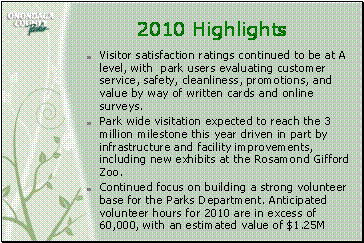
 
 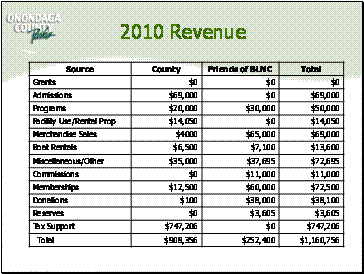
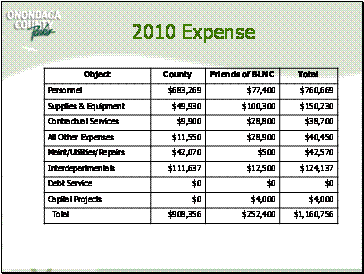 
 
 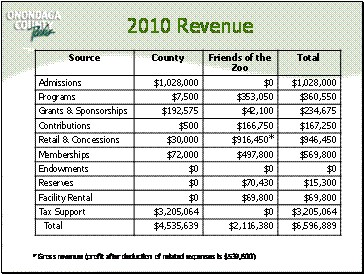
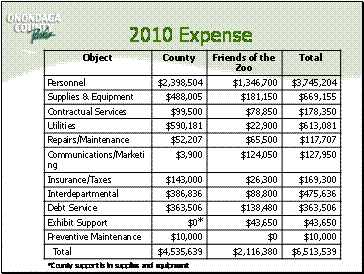 
 
 
 
 
 
 
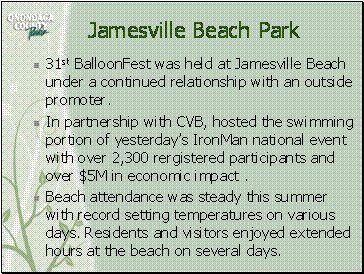 
 
 
 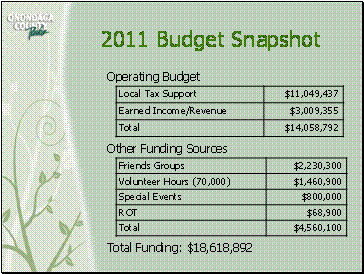
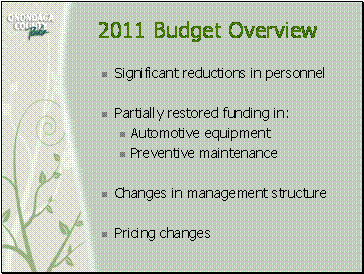 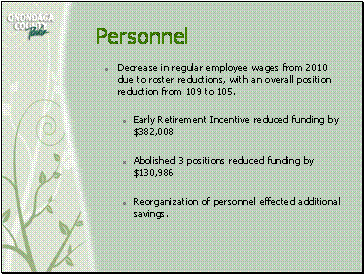
 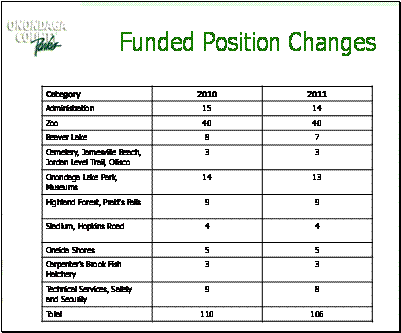
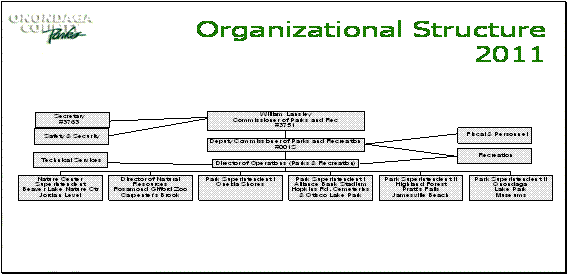

 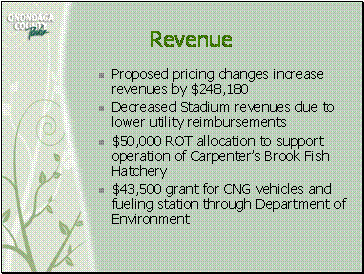
Estimated repayment of utilities at Stadium includes:
$150,000 – 2009 utilities
$88,967 – prior year utilities per MOU
 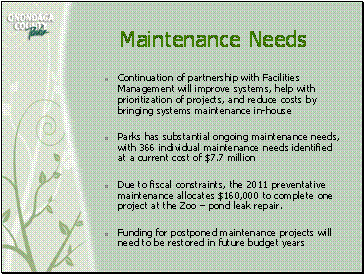
Estimated repayment of utilities at Stadium includes:
$150,000 – 2009 utilities
$88,967 – prior year utilities per MOU
 
 

Mr. Jordan asked why they are creating a Deputy Commissioner of Parks and Recreation and a Director of Operations when they indicated they will be reducing their staff by four positions and moving people around with the idea of decreasing their costs. Mr. Lansley explained that they have not filled the positions of Dir. of Planning and Development and Director of Recreation & Public Programs after retirements, but there is still a tremendous need for these things to be done; they are also abolishing a position in their maintenance department and an Administrator Director position; they are combining those four to make two positions; there will actually be three positions where there used to be six. Ms. Hann said they will be decreasing salaries – with creation of the Director of Operations, there will be the elimination of a Park Superintendent 2 title (a Grade 34 for a Grade 35 - increase in minimal), with the creation of the Deputy Commissioner there is the elimination of Admin. Dir. of Parks and Recreation (Grade 33) and the elimination of Dir of Recreation (Grade 35); they will be saving around $40,000 in the first year with the restructuring of the main office.
Mr. Stanczyk left the meeting.
In answer to Mr. Jordan, Ms. Hann said the grants budget includes the Special Events Account; they have authorization to increase appropriations as they earn revenues with Special Events; that all gets reported in their grants budget. Mr. Jordan asked about the Actual cost in the 2009 Grants Budget for Regular Employees Salaries. Mrs. Hann said it is in the Special Events Account, a Senior Recreation Leader at Onondaga Lake Park who spends most of her time on Lights on the Lake, position is grant funded through Lights on the Lake.
Mr. Jordan mentioned the three vehicles that they want to purchase, asked the cost difference between the two compressed natural gas and the regular. Mr. Lansley said there is an increased cost for the compressed natural gas but that increase would be in the grant. Mr. Corbett noted that three departments have in their budgets the expense of putting in a natural gas disbursement station, suggested coordinating with the City. Mr. Lansley said the Parks system just uses the trucks during the day; if they went to a filling station, they would have to pay for the quick fill; with a slow fill system, they would plug them in at night. Mr. Corbett said there is still an expense to having it built even though a portion will be picked up. Mr. Lansley said the County would pay and then submit it for 50% reimbursement.
Mr. Jordan asked about Carpenter’s Brook positions. Ms. Hann said they will not be filling the Parks Superintendent 2 position who oversees the Hatchery (person retired); it will be under the supervision of the Zoo. They are allocating a Park Laborer full time to the hatchery, replacing a manager with a laborer.
Mr. Jordan asked if an analysis has ever been done regarding making the Parks Department self sufficient by charging admission to the parks. Mr. Lansley said he did not think so; they are replacing a lot of activity with volunteers. For example, there are 250 volunteers running the Golden Harvest program at Beaver Lake (used to pay 103’s); it is a revenue generating operation for the Friends of Beaver Lake; that is the mold they want to move towards. They have seen great growth in all of the Friends organizations and volunteers, ESF being one of those at the hatchery. Ms. Hann said they generate about $1 million in revenue at the Zoo on any given year from admission; The County is supporting the Zoo with $3 million local dollars; if they wanted to make the zoo self sufficient, they would have to quadruple the price of admission - from $8 to $32; that would probably reduce visitation requiring even more of an increase in admission. Mr. Jordan said the Parks is an overall department, not just the zoo, could charge an arbitrary price such as $5.00 per car admission to all of the parks, those monies could be used to offset costs. Mr. Lansley said they could take a look at that. Mr. Lansley referred to the concerts at the stadium that have proven dollars can be generated in a venue that is not built for that specific purpose, revenues could offset the cost of the stadium.
- Mr. Jordan asked why they are projecting a lower attendance at Alliance Bank Stadium in 2011 than 2010. Ms. Hann said the attendance was stellar because the Chiefs had Strasburg playing there; they are projecting 2011 to be more in line with their regular attendance. Mr. Lansley said the Nationals have great farm teams, thinks we will have some winning teams in the near future and the attendance numbers will spike.
- Mr. Jordan noted that Otisco Lake Park attendance of 5,000 in 2010 and they are showing zero attendance in 2011, asked why. Ms. Hann said they are projecting that it will be the same, for some reason it didn’t print.
- Mr. Jordan asked about the cut in the fundraising goal for the Development Officer from $100,000 to $50,000. Ms. Hann explained that the person came on board two months ago; they had projected the person to come in almost a year earlier. When she applies for grants, that money won’t start coming in until 2011.
- In answer to Mr. Jordan, Ms. Hann said their overtime is mostly from full time staff, holiday pay is also reflected in the overtime account (zoo and parks are open on holidays).
- Mr. Jordan said it looks like they unfunded a full time Park Laborer at Oneida Shores in 2010 and are looking to fund that position in 2011. Ms. Hann said that was taken out in the Recommended budget.
- Mr. Jordan asked why they indicate an increase in their automotive expense of $9,050. Ms. Hann said their vehicle fleet is aging significantly, they have over 200 pieces of equipment including mowers and vehicles in the Parks Department, maintenance needs are increasing; they have two compressed natural gas vehicles and one tractor in the 2011 budget (replaced only one pickup truck in 2010).
In answer to Mr. Jordan, Mr. Lansley said the Park Rangers are a free standing police agency. Ms. Hann said their supervisor is a 101 employee; their workforce is in the 103 – seasonal, they work on an hourly basis with no benefits. Mr. Jordan asked about the purchase of 12 bullet proof vests for the rangers at $700 each. Ms. Hann said the County purchases their uniforms and their equipment; it is owned by the County, but they use it. Ms. Hann said they have never purchased bullet proof vests; they are the only law enforcement agency in Onondaga County that does not have them. Mr. Lansley said there is a grant for up to 50% of the purchase price. Mr. Jordan asked if these purchases could be merged with other departments. Mr. Lansley they have inquired about that, he has never seen a reduction in price for volume; they do work with the Dept of Corrections and Sheriff’s Office regarding available grants.
Regarding the travel and training line to attend two conferences for $2,000, Mr. Lansley said that is for him to go to the National Parks and Recreation Conference, historically the commissioner has gone to these; it is an opportunity to see what is taking place across the country.
Mr. Jordan asked about the $750,000 proposed for improvements at Carpenter’s Brook Fish Hatchery. Mr. Lansley said that would be a federal grant through Senator Schumer’s office, was written by ESF, it is not part of their current budget.
Mr. Corbett requested to have the three slides – roster changes, funded position changes and organizational structure 2011 blown up to make it easier to read. Mr. Corbett asked how many were eligible and how many took advantage of the Early Retirement Incentive (ERI). Ms. Hann said 45% - 50% were eligible, eleven retired. Regarding the organizational structure, Mr. Corbett asked if there would ever be one Supervisor/Superintendent where they would only have one employee to supervise. Ms. Hann replied “no” and they no longer have different levels of superintendents.
Mr. Lesniak asked the difference in cost between an elephant breeding program versus just an elephant exhibit. Ms. Hann said they currently have a breeding program, Mr. Doyle believes their current staff with some rigorous training and a tighter schedule will be able to handle the elephants they have now and the three coming back from Canada. The number for vet bills and diet will increase with the elephants coming back. Mr. Lansley said there was and additional cost of $10,000 for insemination of one of the elephants this year, cost was covered by the Friends. Ms. Hann said it is hard to decipher the cost because the breeding program is so intertwined with the exhibit itself; if they did not have the breeding program, most of the elephants would be reallocated by AZA standards. They would keep Seri (non breeding elephant) and would probably get a couple of other older elephants. Mr. Lesniak asked the cost of housing the elephants in Canada. Ms. Hann said zero, they are on loan as part of their exhibit, and the Canadian zoo pays the cost. There will be a cost to transport them back. Mr. Lesniak mentioned the twenty zoo attendants, asked how long they have had that number. Ms. Hann said at least two years. There is a comprehensive plan based on the animal collection; it has three levels of care – minimum, medium and exceptional level of care and how many zoo attendants would be required for each level of care. Currently, they are operating at the minimum. There are some requirements for the job – background in animal caretaking or education in Life Sciences; it is not a tested position. They could move them into the 103 but would pay the same hourly rates to get the minimum qualifications. It is a year-round need and temporary positions can only work 50% of a full time slot, would have to have a lot more of those to fill the needs. Mr. Holmquist said they have a world class, medium sized zoo that is world renowned because of the elephant breeding program; we don’t own many of the animals, they are all managed through AZA; if the zoo didn’t have the elephant breeding program, they also wouldn’t have two-thirds of the animals that are a major draw. Mr. Lansley noted that the Penguin program is also an AZA breeding program; they supply zoos all across America with penguins that are produced through that program.
Mr. Holmquist said he believes county government should be more than just social services and jails; quality of life is critical. Friends programs that we have here in our county, especially the zoo is quite stunning if you look at the revenues and expenses – this not a common thing that occurs nationally. The contribution of $2 million from the Friends of the Zoo is something we should all appreciate and focus on.
Mr. Lesniak noted that they are over $1 million for Supplies and Materials. Ms. Hann said it includes office supplies, construction supplies, fuel, automotive parts, hardware, food for the animals at the zoo and hatchery and vet supplies and drugs for the animals.
Mr. Lesniak asked why Provisions for Capital Projects was going from $60,000 to $160,000. Ms. Hann said it is to repair a large leak in the main pond at the zoo ($160,000 estimate). Everything else is on hold, when something becomes critical, will have to address it throughout the year.
Mr. Lesniak asked about the Maintenance, Utilities and Rent Account. Ms. Hann said they rent lifts, light towers for events, port-a-johns, tents, etc. Repairs and Maintenance is $138,000, Utilities are almost $1.2 million and Rentals are about $46,000.
Mr. Holmquist noted that it is a very difficult budget this year, he knows that there is no way the citizens of the Town of Manlius are going to incur a $53% tax increase, which means every single department is going to have some skin in the game. Mr. Holmquist asked about any privatization efforts in the services utilized by Parks or within the Parks department itself. Mr. Lansley said they think constantly about what they can do along those lines, Friends groups and volunteer efforts move them towards that every day; they continually cultivate that mentality going forward of getting Friends groups up to the level where they could be self sufficient and run a property. St. Marie is a small project like that – they have done all the programming, have cultivated their volunteers, and operate that program without any County expense, other than utilities. Ms. Hann said they looked at some privatization initiatives such as the cemeteries; it was not a cost effective alternative for them, would have ended up costing more. They approached the Friends of the Zoo about taking over smaller portions of zoo operations; at this time with fiscal constraints being so bad, they are not interested. They have been in the planning stage to have the Friends of Beaver Lake take on more things. Mr. Holmquist asked about the recreation programs and what could be done differently. Mr. Lansley will continue to look at it; noted that kickball is not a huge drain on their system, Hopkins Road Park is kept at a very high level and it is a revenue generating program for the county.
Mr. Jordan noted that almost $16,000 for membership fees such as the American Zoo and Aquarium (AZA) ($7,400) and International Species Information System ($6,300) seems high. Ms. Hann said they can’t do away with those two fees – AZA is oversight of the zoo and Species Information System manages the collection for the entire United States. In order to be a part of an AZA accredited institution, they need to be a part of the Species Information System. They receive great value from some of the other membership fees and help them preserve their grant funding. Ms. Hann said the memberships are important and they would like to preserve them, but they are not mandated.
Mr. Jordan asked why they are eliminated the Visitor Attendant position at Beaver Lake but not at other parks. Mr. Lansley said the Beaver Lake position is being served by volunteers; they are working on doing the same thing in other parks.
Answers to questions by Mrs. Rapp:
- Mr. Lansley said they have looked at purchasing the light district at the Stadium (lights, parking lot lights, field lights) but the number they were given from National Grid was no good because of the age of the light poles. Mrs. Rapp suggested that they look into Carrier’s advice that Alliance Bank Stadium could be heated by a generator powered by wood chips, would take them off the grid and would be paid for with Homeland Security Funds.
- Would always need professional people at Carpenter’s Brook Fish Hatchery to oversee the health of the fish (have 2 currently with over 35 yrs. of experience combined). Could move towards volunteers transporting the fish out to areas. Have seen an uptick in volunteerism, Sportsmen’s Day will be 100% volunteer operated this year.
- There are four or five opportunities within the baseball season for concerts. With the ROT money, they will have the ability to make offers to potential concert performers. Will repay ROT with revenue from concerts. Mrs. Rapp requested a copy of the Enterprise Fund and where they are this year.
- Regarding the Barrett Sports Group, Mr. Lansley said they have done phase 1 for $7,500 which was an analysis of our park, the value of the structure. Information was provided on similar parks, similar community sizes, how their leases were structured, who pays for what. The next phase ($25,000) will be making sure the County is paying what it should be paying and the baseball club is pay for what they should. Expect to get into the negotiation process within the next two months. Ms. Hann noted that the lease ends at the end of the 2011 season.
Answers to Mr. DeMore’s questions:
- Regarding the jump this year in line 005, Ms. Hann said there is a $500,000 allocation to serve as seed money to help bring national acts to Alliance Bank Stadium.
- The 408 line represents the Development person who works on contract who came on board this year and the pass-through grant for the Snowmobile Association.
- Starting to make payments of Parks for Tomorrow II, bonding and projects started a little over a year ago.
- Park Superintendent II is the only full time position at Jamesville Beach; is also the snow program person at Highland Forest in the winter.
- Pratts Falls is closed during the winter, those workers also go to Highland Forest to maintain trails except on person who stays in the maintenance shop and builds picnic tables, makes sure everything is OK in the park.
- Mr. Lansley said he would entertain any offers to sell Pratts Falls to the Town of Pompey, but it seems to be more than your typical town park. Ms. Hann said Camp Brockway is used quite a bit in the summer, and they get a lot of Scout camps, park gets a fair number of visitors in the summer.
- Beginning in September, most of the maintenance staff at Onondaga Lake Park is occupied with the setup of Lights on the Lake and then getting programs ready for the next season.
- The Arrowhead Lodge at Oneida Shores is open all year round for weddings and events.
- Have the leading elephant breeding program for a mid size zoo, there may be larger ones.
Answers to Mr. Rhinehart’s questions about Alliance Bank Stadium:
- Local dollar support is a little over $1 million a year.
- Mr. Fisher said the Chiefs have prepaid rent - $4 million rent 14 years ago. Credit of $266,000 a year is not in the budget, but if you were a business you would credit that. They also pay $25,000 a year for turf infrastructure, in total there is about $333,000 that a normal business would credit them for.
- County made nothing on the two concerts held at the stadium last year; those were run by the Chiefs. What they would make next year on concerts depends on the act and the ticket sales; there is insurance that can be taken regarding possible rain dates. The County Parks Department will act as the promoter. Mr. Rhinehart suggested a public/private partnership with a promoter.
Mr. Rhinehart asked about other counties in NYS who operate zoos. Ms. Hann said Seneca and New York City counties have zoos; Monroe County has a city zoo.
Mr. Rhinehart asked how many pickup trucks the department has. Ms. Hann said “31”, they are repaired at WEP. Mr. Rhinehart asked about dealing directly with the car dealers for repairs. Ms. Hann said they could address the possibility of doing that; WEP doesn’t take as long with the trucks as the mowers. Mr. Rhinehart said if we were contracting with someone to mow our property, they would be bringing their own mowers. Mr. Ellis said six or eight employees mow Monday through Friday, 40 hours a week. There are times like at Long Branch Park where they can only mow a couple of hours a day before runs, walks and picnic shelters are used. Several mowers at several parks are only used a couple of hours a day. Mr. Lansley said they have 103’s who take on mowing, trimming and hand mowing in the summer, nothing is sitting and not being utilized. Regarding plowing, the Town of Lysander does Beaver Lake, DOT plows some of Highland Forest; the rest of the plowing is done in house.
Mr. Rhinehart asked if having the local municipalities conduct the recreational programs in our parks has been discussed if the County were to stop doing that. Mr. Lansley said it is something they could look at, would question somebody coming in to run the 280-league softball operation throughout the season. Mr. Rhinehart said these are unprecedented times, they are looking at nine towns having their property taxes double or triple, the legislators’ job is to adjust the budget, there will be spending reductions in the Parks Department. Mr. Lansley said they are not running too many programs with a negative return. Mr. Rhinehart suggested a priority list of programs he would like to keep.
Regarding emptying the trash in the parks, Mr. Lansley said 103 employees do it in the summer and 101 staff in the off season. Ms. Hann said about one person at each park would do that along with other duties. Mr. Rhinehart noted that Colorado Springs has an Adopt the Trash program that works out well. Mr. Rhinehart said he thinks the job for them will be to motivate the Friends groups and will have to take a hard look at having towns take over running of parks with the County owning them.
Mr. Masterpole thanked Mr. Lansley for doing a great job. Regarding the RFP for a promoter for concerts in 2011, Mr. Masterpole asked what the dollar figure is. Ms. Hann said the contract for the promoter for concerts was executed and it went to Frank Malfitano for $2,000 a month. Mr. Masterpole asked what happens if there are no events. Mr. Lansley said promoter position is year round, their entire outlay is $2,000 per month, and promoter will get nothing more if there are more concerts or nothing less. Their entire outlay is $2,000 per month, there is nothing more if they get a lot of great concerts or nothing less if they don’t. With the contractor they have, production has historically been good in securing acts; they have a high confidence level that those can be transferred as well to the stadium.
Mr. Jordan asked about the $50,000 that was set aside in the 2010 Budget for the Development Officer position. Ms. Hann said the money is in a grants account, they have not made any payments because the person hasn’t put any invoices in yet, is not sure how much will be left at the end of the year.
Mr. Jordan asked what they are doing to address the issue of utilities at the stadium, understands that the heat has to be either on or off for the entire facility. Mr. Lansley explained that they have what is called a demand charge – when you turn everything on, that is your high peak demand. Off season the demand charge is going to be 50% of that, there is no way around that; it is a National Grid fee. On an energy base system, they have the press level, suites level – no utilities up there except for one room, the computer system for the sound system, alarm system; Chiefs occupy office space on the first floor; looking at ways to further reduce the footprint – concessions space, Chiefs players rooms, etc. That would entail taking the boilers off line and adding some sort of heat system (furnace) for those areas. Looking into the cost right now – would be an energy savings, but still have to pay the demand charge.
Mr. Jordan asked the cost of the Lights on the Lake program. Ms. Hann said it is a revenue generating program does not cost the County any money. They run it out of the Special Events Account, there is no tax support.
Mr. Corbett noted that the local law for fee increases at the parks is included in the legislators’ budget packets.
FACILITIES MANAGEMENT: Mr. Brian Lynch, Commissioner; Ms. Karen Hajski, Accountant; Mr. Lee Klosowski, Dir. of Energy Sustainability; Mr. Archie Wixson, Deputy Commissioner; Mr. Rustan Petrela, Budget Analyst
 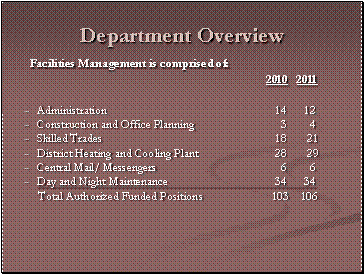
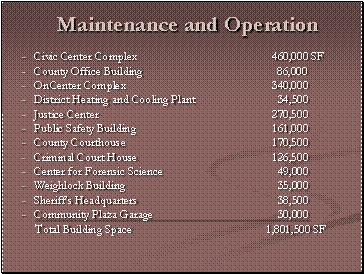 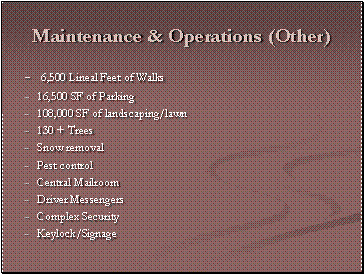
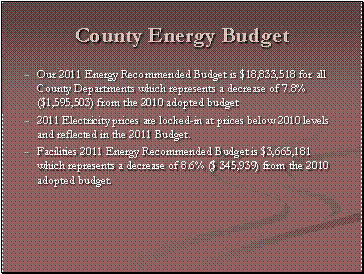 
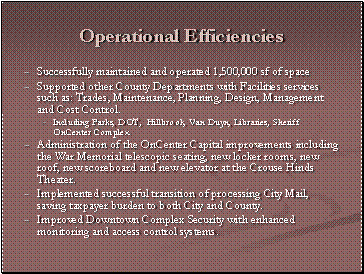 
 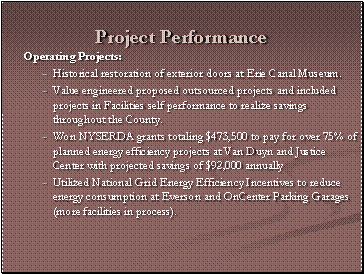
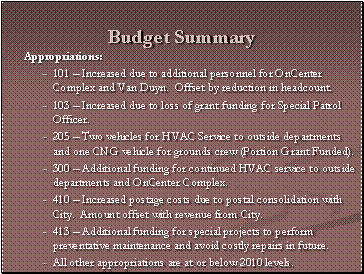 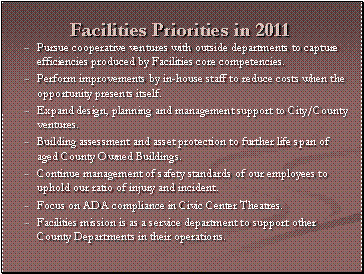
Mr. Jordan asked how many toilet seats have been replaced with stainless steel, how many yet to be replaced due to inmates damaging them in the Justice Center. Mr. Lynch said there are 660 that need to be replaced, they request 25 per year, have about 125 done and about 500 more to go, they had a design flaw when the building was built.
Mr. Jordan noted the County is buying huge quantities of fuel; prices of $2.63 a gallon for regular and $2.82 a gallon for diesel do not seem like great prices. Mr. Rowley said retail is currently $2.75 a gallon, it is a guess at this point in terms of what the County is saving, they can look at it again; from a budget perspective, he would prefer to hedge his bets and not under budget needlessly.
Mr. Jordan asked about the laundering of uniforms. Mr. Lynch said currently the Steam Plant supplies 24 hr. days/7days per week coverage; uniforms are for security measures for easy recognition within County buildings after hours, it is in their contract.
Mr. Jordan observed that the 960 Account shows $150,000 for capital projects that are 100% reimbursable, asked if that reimbursement is reflected in the 2011 Budget. Ms. Hajski said the revenue is in their State Aid Account. Mr. Petrela will provide information regarding what the capital projects came in at and how much they bonded for them.
In answer to Mr. Jordan, Mr. Lynch said they had 103 funded positions in 2010 and are proposing 106 funded positions in 2011. If they were not taking on new ventures, they would be five less. Mr. Jordan asked how many people took advantage of the Early Retirement Incentive (ERI). Mr. Lynch replied “4” – one Custodial Worker 1, one Driver/Messenger, one Mechanical Systems Maintenance Worker and one Refrigeration Machine Operator; two of those are being refilled fulltime.
Mr. Jordan asked where the revenues generated from the Oncenter parking lot are reflected in the budget; Ms. Hajski said it is in the 1120 Account.
Mr. Corbett referred to the request for the two compressed natural gas vehicles, asked if an opportunity to do an IMA with the City would be feasible because they have already established a natural gas dispensing station, questioned why we would want to do our own. Mr. Lynch said it would be feasible for Facilities.
Mr. Holmquist asked if there have been any discussions about privatization initiatives within their department. Mr. Lynch said they did a study concerning the night custodial staff positions; there was an overwhelming savings to do it in house. They have 17 full time employees for four County-owned buildings, would like to do a study regarding what it costs to contract out the Criminal Court House, Justice Center, Center for Forensic Sciences and make the business case that it should be in their house. Mr. Lynch believes that outsourcing is higher than hiring within house even with fringe included. They have looked at Driver/Messenger services and night custodial being contracted out; currently are down to 3 daytime maintenance people for the entire downtown County complex. Mr. Lynch said as part of the budget process next year he would like to incorporate Facilities in the Special Project requests, to do some of those in house.
Mr. Lesniak asked why the revenue for processing mail for the City is down. Ms. Hajski said they took one of those revenues and put it into a new code for the Abstract charge for the Criminal Courthouse (042). The revenue is up if 040 and 042 are combined. Mr. Lesniak asked about the 038 Line going from $639,454 to $12,772. Mr. Lynch explained that this was connected to legislation passed last month for steam reimbursement for the Oncenter.
Mr. Corbett asked for an explanation regarding abstract charges on Page 5-20 – General Charges to Other Governments down by $1,247,123 due to moving the Criminal Court Building charges to Abstract Charges to the City and then underneath it Abstract Charges to City up $1,432,446. Mr. Fisher said the Criminal Courthouse was previously paid directly by the City to the County as a charge that went through Facilities. They agreed this year to move that over to the Abstract, it is revenue neutral to us as a county. Ms. Hajski said the difference in the amounts is for the processing of the City’s mail.
Mr. Rapp asked about the real estate assessments mentioned in the presentation. Mr. Lynch said they have started with the structural assessment of the Beaver Lake house as well as trying to maintain a master list of all County owned buildings (over 300 buildings). Mrs. Rapp asked about the possibility of selling some of these facilities. Mr. Lynch said they couldn’t put a number in until they do a study of the structural condition, intended use and whether it could be done at another location.
Mrs. Rapp referred to the bottom line on page 5-18 – Local (Appropriations – Revenues), the Requested is $10.7 million and Recommended is only $5.8 million. Mr. Rowley said they traditionally request a number of projects in their 413 Account (all legitimate and need to be done); as part of the budget process, they reduce them down to something that is reasonable compared to last year. The last line is total appropriations minus revenue, what you need to balance the budget is what the local line is - would have needed to fund $10.7 million out of taxes to fund their Requested budget, lowered that by making cuts to the 413 Account.
In answer to Mrs. Rapp, Mr. Lynch said the Downtown Lighting project is underway, Bernthal Way is done, west end side of Everson Garage behind Lot B lights have been installed, conduit has been run along the walkway to Lot B for surface lights and conduit has been run in Columbus Circle.
In answer to Mr. Rhinehart, Mr. Lynch said they have a mailroom to sort and process all the County’s mail, prior to them buying the mail machine, the contract for just sorting was $56,000. He has reached out to OCC and the Syracuse City School District for consolidation of their efforts with Onondaga County. Three people are needed to operate the mail room; if one of those is sick there is a support staff in place (is a huge believer in cross training). Regarding the Driver/Messenger positions (cut from 4 to 3 last year), they have daily pickups at every single countywide department, and either daily, every other day or weekly pickups for DOT, Hillbrook, Van Duyn and Sheriff. Mr. Rhinehart asked about the two security people for the Civic Center. Mr. Lynch said they have to pay for the front desk employee only. Ms. .Hajski said it is a full time position but spit in shifts (cost is $45,000 per year for one full time equivalent, no fringe, 103 – retired police officers). There are 7 special patrol officers in the Civic Center and County Office Building, 5 dedicated special patrol officers for the Dept. of Social Services floors and one rover. Facilities Dept. just pays the front desk.
Mr. Rhinehart asked if they are handling HVAC for the libraries. Mr. Lynch said they will start January 1 for all County owned branch libraries (8), will save the Library about $66,000 a year at no added cost to Facilities Management. Mr. Rhinehart observed that they would have 8 more buildings and no extra staff, asked how they would do it. Mr. Lynch said by doing it right the first time, too many times in the past the County has had no quality control. They are not there to make a profit, want it done right the first time. It is a lot of additional work, but if it is strategized the right way on a schedule, it can be done.
Mr. Rhinehart referred to the projects under Maintenance, Utilities and Rent, asked if they have been bonded for; Mr. Lynch said “no”. Regarding the 7th and 8th floor renovation in the Civic Center for $250,000, Mr. Rhinehart asked who is moving in there. Mr. Lynch said DSS Children’s Division. They are upgrading the office space and the program function. Currently, it is extremely tight, finishes are dilapidated. They are only requesting $250,000 because Facilities was not involved in the other office renovations and there are cost overruns on the original funds budgeted, Mr. Lynch needs to make up that difference in order for these renovations to happen. In answer to Mr. Rhinehart, Mr. Lynch confirmed that people are currently on the floors, they are not unusable.
Mr. Rhinehart asked about the $50,000 for the Canal Museum. Mr. Lynch said it is for some internal improvements, health and safety issues in terms of carpeting, has extremely outdated windows.
Mr. Rhinehart asked about the variable speed drives ($100,000) for the south loop pumps at the DH&C plant. Mr. Widay said they have been buying variable speed drives to replace 15 year old ones that have failed for the Civic Center. A drive would cost $2,300 for a 25 horse power motor; NYSERDA would give a rebate back for $2,000, costing the County $300 for a brand new drive.
Mr. Rhinehart asked about the $240,000 for improvements at the Justice Center. Mr. Lynch said if they are not done tomorrow they will be more expensive when they do them, it all comes down to maintaining our assets, trying to move along the continuum where they get out of the reactive mode – these are three health and safety projects and two preservation of assets projects. Mr. Rhinehart said they would not be doing them all.
Mr. Rhinehart noted that they asked for 3 new trucks and have 6 new positions, asked Mr. Lynch what his preference would be if he had to pick between the trucks and 2 full time employees. Mr. Lynch said he would sacrifice trucks for two full time employees. In answer to Mr. Rhinehart, Mr. Lynch said WEP maintains their trucks, three are their currently. Mr. Rhinehart said the County needs to get away from that; when buying new trucks, should get service from the private side rather than over and over again from the public side.
Mr. Lesniak asked how much is being saved by Facilities doing maintenance at the 911 Center. Mr. Lynch said $50,000.
Mr. Dougherty asked for explanation of the positions under Planning & Construction. Mr. Wixson said:
- Their in-house architect has brought enormous wealth of knowledge and past success in the design field. So far, he has had an enormously successful and quick turnaround of designs of in-house projects throughout the downtown complex as well as outside.
- The Director of Construction & Office Planning oversees all of the County spaces in the nine-building downtown complex. In addition, the department supports other sister departments such as Van Duyn. The director assisted them in preparing an RFP that will help them capture some grant funding and bring a development to their long term care facility that is long past due. There was an enormous amount of involvement for design in the Sheriff’s building. It is all about diminishing professional services from outsourcing and keeping a good measure of control for standards and cost control within the County complex.
- Regarding the Drafting Tech 2, special surveys are enormously important to plan ahead for projects for the different departments and to help them with their programming.
In answer to Mr. Dougherty, Mr. Lynch said if they went with a private architectural firm they would be giving up the institutional knowledge of our buildings, their director has been here for twenty years and Architect 2 has been here for 25 years. Code compliance in the downtown complex is nothing like it is on the outside; there are totally different rules for a governing body. It is about $185 an hour for a principal in an architectural firm; it is a substantially reduced rate to that.
Regarding Driver/Messengers, Mr. Dougherty asked if they could partner with the Library that has a whole fleet of trucks to drive library material around the city and county. Mr. Lynch said he could look into it.
Mr. Jordan asked for explanation concerning the sale of steam revenue being down by $626,682 due to the Oncenter deal. Mr. Lynch said they used to receive $600,000 from the sale of steam from the Oncenter, now facilities is eating the cost, but it is being taken out of ROT to reimburse the sale of steam to Facilities.
Mr. Jordan asked why it is necessary to create two Construction Admin. positions and one Mechanical Systems Main. Dir. Mr. Lynch said the County spends hundreds of thousands of dollars for project management, happens with almost all capital projects. Typically a construction manager or an on-site representative can range from 5% to 10% ($100,000 for a $1 million project). For renovations at the War Memorial and Oncenter, it was $338,000 for representation. Mr. Lynch would like to bring that expertise from outside to their own in-house staff who can work on the County’s multiple projects (funded positions). Mr. Lynch said he has worked on the upgrade to Mechanical Systems Main. Dir. position for two years, the scope of this person’s job has changed enormously. The person is responsible for overseeing the entire downtown complex and is also directly responsible for the HVAC in the Parks Dept., 911 Center and tower sites and the branch libraries, holds that person solely responsible; it has gone through the Budget Dept., Personnel with unbelievable support.
In answer to Mr. Lesniak, Mr. Lynch said $709,000 is transferred from the Oncenter revenues of ROT, $200,000 partially offsets heating and cooling, $395,000 fully offsets personnel and $117,000 fully offsets maintenance service agreements. Mr. Lesniak asked if adding the three additional positions is included in the $709,000. Mr. Lynch replied yes.
Mr. Rhinehart said he wants everyone to understand that the Convention Center is not carrying itself, the ROT money is being infused to the Convention Center via County Facilities.
Mr. Lesniak asked what number of ROT went to the Oncenter last year. Mr. Fisher replied $1.9 million for operating and $250,000 for their capital reserve.
Chairman Jordan recessed at 12:48 p.m.
* * *
Chairman Jordan reconvened at 1:15 p.m.
MEMBERS PRESENT: Mr. Corbett, Mr. Lesniak, Mr. Buckel, *Mr. Stanczyk, Mr. Holmquist
MEMBERS ABSENT: Mr. Kilmartin, Mr. Warner, Mr. Kinne
ALSO PRESENT: Mr. Meyer, Mrs. Tassone, Mrs. Rapp, Mr. Rhinehart, Mr. Masterpole, Mrs. Ervin
O.C.P.L. – Ms. Elizabeth Dailey, Executive Director, Ms. Sally Carmer, Dir. of Administrative Services
Ms. Dailey gave the following presentation:
 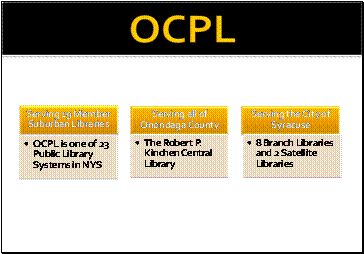
Thank you for this opportunity to present our 2011 budget and Onondaga County Public Library’s organization and funding
the library services that the budget supports. I will be talking is somewhat unique. As a result of consolidation in the 1970’s,
about our organization’s priorities and then Sally Carmer will OCPL has service mandates and funding from the State of New
have remarks on the budget numbers. York, the City of Syracuse and the County of Onondaga. A goal
Of the consolidation - and an on-going goal of OCPL - is to
leverage resources through sharing of the expense of materials,
hardware, software, networking and expertise. Our compact
geographic area and a long history of collaboration are both
contributing to the attainment of this goal.
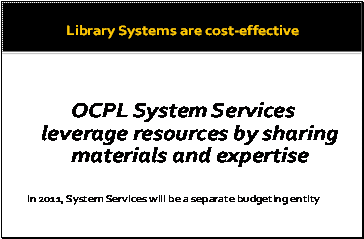 
As one of 23 public library systems in New York State, OCPL East Syracuse and Tully. Each suburban public library has an
receives New York State Library Aid for specific purposes such independent board and is funded by its locality. The OCPL
as the cataloging of library materials so that they can be shared System provides the technology and expertise that enables
across the System. the independent libraries to work together for the benefit of
every County resident.
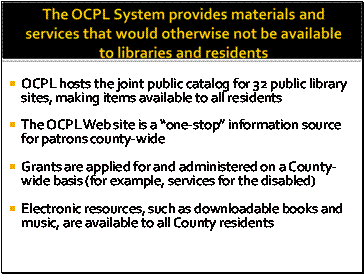 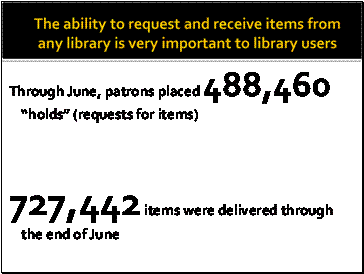
Residents and libraries throughout the County have access to The OCPL System is responsible for the delivery of materials
materials, programs and services that would not otherwise be among all the public libraries in Onondaga County. Holds may
available. A key System role is to work towards equity of access be placed from home or in a library, with delivery to
for all County residents. whichever library the patron prefers.
 
As items move between libraries they are sorted at the Central One of the OCPL vans being loaded. (We project over a
Library, basement level. million and a half items will go through the delivery system in 2010)
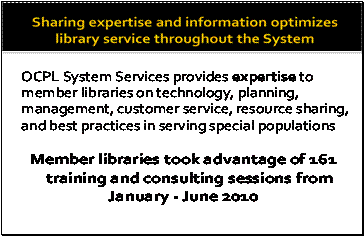 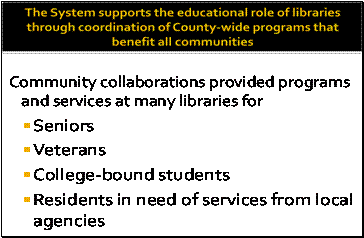
As a public library system we are required to have a director and Organizations and agencies in our community whose mission
three certified librarians who are devoted to improving library includes outreach to residents often approach the library to
services throughout the System. Also, OCPL facilitates the assist them. Libraries are in our neighborhoods, towns and
exchange of the best practices developed in the Member villages and are the perfect neutral ground for information and
Libraries through an annual System Retreat and OCPL supports education.
Member Library initiatives such as the Collection Development
Task Force.
 
To summarize, White Branch
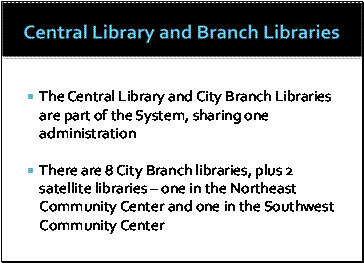 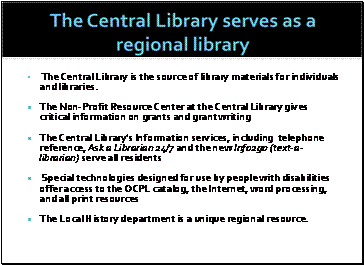
In addition to Public Library System Services, OCPL includes the
Central Library and branches
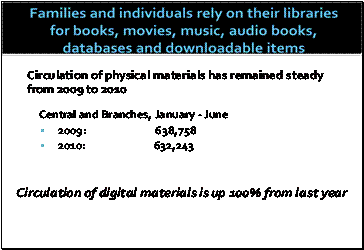 
Circulation for branches and the Central Library accounts for Literacy, from preliteracy skills for babies to lifelong learning
about 28% of the total circulation of library materials in for adults is a key contribution of OCPL to the strength of our
Onondaga County. community.
 
Many national studies show. Central and branches. Picture at Soule.
 
One of the many literacy based programs. OCPL not only serves individuals and families but also
provide materials, space, technology and expertise.
 
Libraries have a history of providing access to information, L3 Central Library
whatever the format. In a digital world, libraries provide
hardware, software, connectivity, coaching and training.
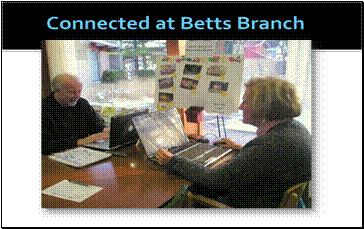 
Wireless in all branch libraries and Central This statistic came from ALA.
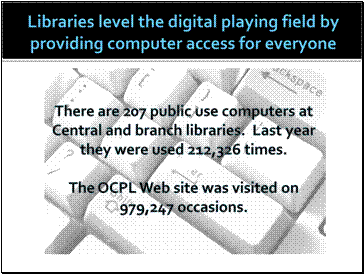 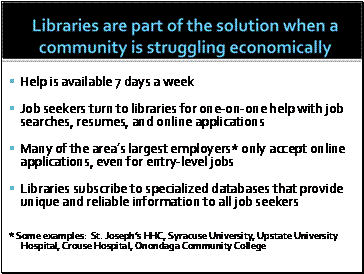
Computer use rises not only because more information is Jobs Plus, CNY Works, other organizations and the library work
available online but because so many services, particularly together for effective referrals among agencies to meet
government services, are available only by accessing a Web site. individual’s need.
 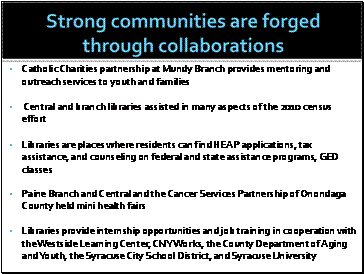
Paine Branch volunteer and patron A strong relationship with City schools is a good foundation
With that overview, I’m now going to turn over the presentation to Sally Carmer who will look at OCPL’s budget detail.
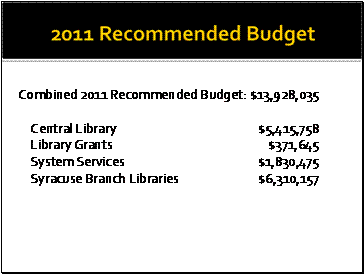
Good afternoon. I'm guessing you've heard this from every department who's already presented their budget to you so far, but I can say without reservation or hesitation that in all the years I've done this, this is by far the most difficult budget I've had to grapple with. I appreciate the difficulty of the task that lies ahead of you and sincerely hope our request facilitates your review.
2011 brings a significant change in how we're structuring our budget. System and Member Services, formerly included in the Central Library budget, will now be a separate budgeting entity. This will provide us with a clearer picture of the costs associated with these services, as well as for the operation of the Central Library. In addition, we’ve moved two positions formerly on the Branch Libraries roster to the Central Library roster, to more accurately reflect their function. Because of this restructuring, we’re presenting our budget from an organization-wide level. The first sheet of your handout is a rolled-up version of the budget that will enable you to see our request for the organization as a whole. The constituent parts of the overall request are a Central Library budget of $5.4 million; State-funded grants at $371,000; System and Member Services at $1.8 million, and Syracuse Branch Libraries at a cost of $6.3 million. Together, our 2011 Recommended budget for the Central Library, Library Grants, System & Member Services, and the Syracuse Branch Libraries is $13.9 million.
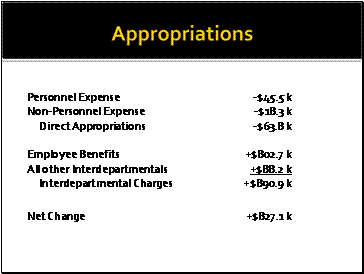
Looking at appropriations, you'll see that the impact of spiraling employee benefits costs on our budget is enormous. The organization-wide bottom line increase of $827,000 in 2011 is the direct result of an increase of over $803,000 for employee benefits alone. Coupled with an additional $88k increase in other interdepartmental charges, we are faced with over $890k in increased interdepartmental costs, over which we have absolutely no control.
Those increases are barely mitigated by the $64,000 in reductions to our direct appropriations. Let that seemingly small number not deceive you, however. It represents the loss of eight fully funded positions, two of which are filled. On the heels of losing four positions in 2010, this presents severe challenges to our ability to deliver library services. Furthermore, the savings realized through that loss are significantly offset by the cost of negotiated wage increases – absent that increase, our personnel costs would have contracted almost $272,000, rather than $45k. It should also be noted that since 2002, we’ve lost 25 positions organization-wide, or nearly 20% of our roster.
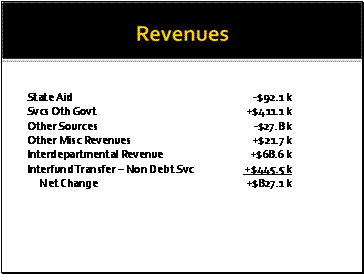
On the revenue side, the loss of State Aid and the devastating effects of interdepartmental increases combine to push our local dollar request up $445k. Albany continues to whittle away at funding at the same time demand for library services continues to propel upward.
Svcs Other Govt is the amalgam of transaction charges to member libraries and the charge to the City of Syracuse for the operation of the Branch libraries. The increase is due almost exclusively to the $363,000 increase in benefits costs to the Branches, in addition to negotiated salary increases and anticipated circulation increases. Other Sources is the library fund balance we’re requesting to appropriate, which is about $28,000 less than last year. All other direct revenue sources aggregate to a total increase of about $22,000.
Interdepartmental Revenue is the administrative charge to the Branch libraries budget for services provided to the branches by Central Library staff. Finally, Interfund Transfer is our local dollar request.
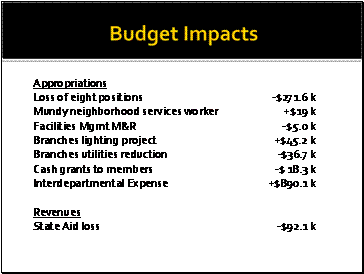
There are a number of items impacting our 2011 budget overall. The loss of eight positions, two of which are currently encumbered, come to a net reduction of $271.6. As mentioned previously, this reduction is significantly offset by negotiated salary increases.
The partnership with Catholic Charities at Mundy Branch to provide mentoring and outreach services to youth and families is a high priority for the Library Board.
OCPL is also working with Facilities Management to take advantage of the services of their skilled trades staff, rather than hiring outside contractors when our HVAC, plumbing or electrical systems need work. We anticipate a reduction of $5,000 to our M&R costs as a result. In addition, we are working with Facilities and National Grid to replace the lighting at the City branch libraries with more energy-efficient, sustainable lighting fixtures. For an initial outlay of about $45k, the branches are projected to save almost $37k annually in lighting costs. For an initial net investment of about $8,000, the branches should see significant and ongoing utilities reductions once the project is completed.
The loss of State aid on the revenue side will also impact our appropriations , as the pass-through cash grant to member libraries account (contracted client services) is reduced to reflect the revenue loss.
Finally, the nearly $891,000 increase in our interdepartmental expense, coupled with State funding losses of over $92,000, makes this a budget that requires increased local support while imposing severe hardship on our operations. Fortunately, library staff are smart, creative and dedicated to strengthening our community, and will rise to the challenge.
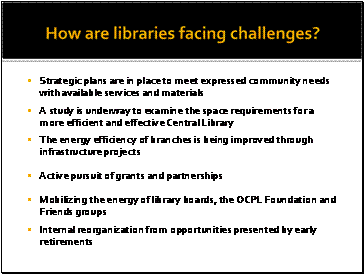
Managing with fewer staff: tailoring services, hours have been impacted, the reductions we made in 2010 cannot be reversed, more lead time to get materials onto shelves, more lead time to fill holds and sort delivery, purchase more electronic and downloadable format and fewer print materials.
Mr. Jordan asked about the mini media bank. Ms. Dailey said it is a redbox that would be operated with a library card. One advantage of it is theft control, also there is less processing that goes into that media bank, it is patron self help. Costs will be reduced due to theft control, reduced staff because they don’t have to do the initial processing, or returning of the items. Liverpool Library has been operating a medial bank for almost a year; their experience will help OCPL have a better understanding when they do a cost savings analysis. Ms. Dailey said one of the things they are constantly doing is using technology to fill a gap after it has occurred; they are already operating with fewer staff to handle the materials.
Regarding their grant budget, Mr. Jordan observed that it seems there is so little in grant funding available. Ms. Carmer explained that the $371,000 that they are requesting is the annual State funded grants through State Education that they know at this time they will get. 2010 Modified or 2009 Actual numbers are much larger, the staff is very good at getting competitive grants through organizations and ALA, they anticipate getting more grant funding this year, but there is no way of knowing at this point what it will be. Ms. Dailey said they have to be cautious because grants can carry some hidden costs, most grants require a match. As NYS has been pressed, grant funding through State Education has come down about 19% in 2.5 years.
Mr. Lesniak asked why they the Central Library and System and Member Services into two budgets. Ms. Dailey said for better communication. Mr. Lesniak noted that when he adds the two together there is an increase of $589,000. Ms. Carmer said that is driven mainly by employee benefits. Direct appropriations overall are down $63,000 from 2010. Mr. Lesniak observed that they are showing 12 less positions, asked how many of those are from the Early Retirement Incentive (ERI). Ms. Dailey replied, “Seven”. Ms. Carmer said two positions in the Branch Libraries were transferred to the Central Library. Mr. Lesniak said 12 positions are now showing up on Systems, haven’t lost any numbers, just transferred from one budget to another. Ms. Carmer explained that they lost funding for a lot of positions that are still carried on the roster; they don’t show as a decrease. Ms. Dailey said they are going into 2011 with 8 fewer full time people across all three budgets. Ms. Carmer said there are 3 fewer funded positions in the Central Library budget, 1 unfunded position in Systems Services budget and 4 newly unfunded positions in the Branch Library budget.
In answer to Mr. Corbett about the splitting of the budgets, Mr. Fisher said the Legislature often questioned the Central Library’s mission and how it is that suburban branches and folks in the suburbs who never come to the Central Library benefit from the money we are spending there. The suburban branches are not part of our system as far as our budget goes but are very much a part of our system as far as what we do with grant money that comes from the state and what we do with the substantial amount of money that comes from this legislature – inter-library loans, Polaris, and a lot of other services that are provided by the system to the branches. Formerly that was in the Central Library budget, could never tease it out to understand exactly what was being spent on those things and were we getting good value for the buck. Now that it is broken out, it should be more transparent.
Mr. Buckel noted that their Employee Benefits line is up by over $800,000, overall budget is up by about $500,000; $330,000 is made up for in cuts and other efficiencies; asked if some essential aspects of their mission, their ability to serve the public are compromised. Ms. Dailey said the thing that will make the most difference is technology, capital projects such as the upgrade to Polaris. There will be a time when they will need to set back and assess everything they are doing and look at where efficiency and effectiveness can come from; it probably will be an investment in technology. That is not in this operating budget. In answer to Mr. Buckel, Ms. Carmer said the lighting improvements is in their operating budget – about $45,000 increase to the Maintenance line, offset by about $37,000 in anticipated utilities savings.
Mr. Rhinehart asked how much the Library has in fund balance. Mr. Rowley said they will have an available fund balance of $341,000 after appropriating a little over $558,000 in the 2011 Budget. Ms. Carmer said the Branch Libraries fund balance - Comptroller’s office accounts for the Central and Branch Libraries budgets, fund balance is separate from Central Library, they have typically appropriated the Branch’s entire fund balance back to the Branch budget. Those pieces need to be looked at separately.
Mr. Rhinehart observed that they have two Driver/Messengers and Facilities Mgt. has three Driver/Messengers, asked if there is any possibility of working something out with Facilities. Ms. Carmer said they would talk with Mr. Lynch.
Mr. Rhinehart asked about Other Employees Wages of $141,000 under the Grants budget and the 101 line. Ms. Carmer said those are state funded grants that enable them to pay for their pages, people who provide services to the Outreach program – part time, minimum wage. The 101 line is for the librarian who runs their Special Technologies and Adaptive Resources program (STAR) for persons with disabilities. Mr. Rhinehart asked what they estimate they will get in grants this year other than the State Education Aid. Ms. Carmer said what is showing in the Modified is probably pretty close. Mr. Rhinehart guessed they would be close or above the 2009 number by the end of the year, asked why they would not do that next year. Ms. Dailey said the bulk of the number is the construction funds and that is something that is not in law, the state has to put that in the budget every year, it is hard for them to know today that it will be there next year.
In answer to Mr. Rhinehart, Ms. Carmer said there are 45 FTEs working the Central library, plus another 12 doing system services, the remaining staff work in the Branches in the city. Ms. Daily said the employees are still staggered, they have reduced access in the mornings, have increase the number of computers so that when people come in at 11:00 a.m. they have a better chance of getting their time. Mr. Rhinehart referred to the $380,000 under Books and Materials for Branch libraries, $435,000 for Central and then another $62,000 System and asked if they could deal with half of that. Ms. Carmer said that is the same level of funding that they have for the current year. Ms. Daily said it is our residents who would be doing without.
VETERANS SERVICES: Mr. Robert McLean; Jason Dean, Budget Analyst
Mr. McLean gave the following presentation:
To The Honorable Members of the Ways and Means Committee:
The proposed 2011 budget for the Onondaga County Veterans Service Agency is presented in support of services provided to a Veteran population in Onondaga County currently estimated at approximately 31,000. This figure does not include family members and other dependants who may be eligible for services or benefits.
The Agency operates with a small staff of 1 MC Agency Director and two Grade 9 VA Service Officers.
The most senior of the Service Officers opted to participate in the ERI program. However, he has returned to his position in a part time status. His work hours will go from 35 per week to 21. His continuation in this capacity will allow us to provide the same level of service with some adjustments in schedules and appointments.
The addition this year of an administrative assistant for 20 hours a week, through the Over 55 Senior Employment Program, has enabled the staff to work more efficiently by concentrating more of the Service Officers’ time on case related issues.
During FY09, Onondaga County Veterans received $56,017,000 in VA compensation and pension benefits. These figures do not include retirement payments made to Onondaga County Military Retirees who receive their funds through the Department of Defense. Our VSA makes a major contribution to this level of benefits.
2010 ACCOMPLISHMENTS
Provided claims representation under federal laws to veterans, dependents, survivors and other claimants in the changing arena of laws, regulations and operations.
Continued to significantly increase public outreach to position the VSA as the leading source of information, advocacy and assistance for Veterans and their families in Onondaga County.
Using the VA.gov website, we continue to work with many of the Nursing Homes and Assisted Living Facilities in our county to streamline the claims application process and make it more efficient for our staff and our Veterans
In conjunction with the Syracuse VA Medical Center, designed and conducted a series of 16 outreach events at eight branches of the County Library System
In conjunction with the County Clerk, Chairman of the County Legislature and the Legislature’s Advisory Committee for Veterans Affairs, continued to increase the number of Veterans and businesses participating in the “FAVOR” Program of business and merchant discounts for honorably discharged Veterans.
Coordinated with the Cornell Cooperative Extension of Onondaga County to complete three sessions of Veterans participating in the ‘Different Shade of Green’ job re-training program. A total of more than 50 Veterans have completed the courses.
Completed changes in benefits delivery, eligibility and claims representation under federal programs. Re-emphasized the continuing education of accredited representatives.
Continued to increase coordination with other departments of County Government to maximize services to county residents that was begun in 2008.
VSA and Director named the Veterans Advocates of the Year by the Vietnam Veterans of America, Central New York Chapter 103.
Director served as one of the founding members of the “Voices Together Project” steering committee to oversee efforts to establish a Veterans Outreach Center in our community.
CHALLENGES
We will continue to work with the New York State Division of Veterans Affairs and the Syracuse VA Medical Center on projects and issues affecting Operation Iraqi Freedom (OIF) and Operation Enduring Freedom (OEF) Veterans.
Staffing and funding will remain a significant challenge for the VSA as it will for all agencies of County Government. We will continue to look for ways to leverage other sources of funding and Veterans as volunteers.
While it is clear that the 2011 budget year will be a challenge for the administration, county employees, our Legislative leaders and county residents, the Veterans Service Agency will work within the approved level of funding to minimize the direct impact on Veterans and their families in our County and provide them with the best possible service and assistance in obtaining the benefits for which they are most certainly entitled.
Thank you for the opportunity to present this budget. I welcome any questions you may have.
Robert W. McLean
Director
Mr. Buckel asked if there are services that the veterans need, that could be provided by his office, but for funding reasons they are not able to do it. Mr. McLean said it is additional access. This past spring they partnered with the County Library system, held eight seminars at selected county libraries so that they could accommodate older veterans who find it difficult to get downtown, park, etc.; those were very successful. This fall they will go to eight additional libraries with a team from the VA Medical Center. These are not additional services, just makes their services more available to more people.
Mr. McLean said they are fortunate in this community to have the VA Medical Center with all its capability, his office works closely with the veterans who have compensation claims; there is a community center, a lot of outreach going on. One thing that needs to be worked on and they are trying to be a leader in is the coordination of these services – finding where they are and how to access them. They are working with a group of people on a veterans outreach coordination project regarding coordination of all the services either physically, electronically or some other way so that it is much easier for veterans and their families to see exactly what is available to them and how to go about getting it. Mr. McLean explained that at one point a Grade 6 position was authorized and then unfunded due to difficult budget circumstances; long term, 2012 and down the road he thinks they need to look at a succession plan that would bring some younger people to take up the mantle, that is an area he is concerned about and will plan for.
Mr. Lesniak asked if they are maintaining the three positions that they had last year but with a grade change for the Director position from Grade 33 to 35. Mr. McLean said that was correct, one grade 9 position would be part time – person took the Early Retirement Incentive and will work permanent part time. Ms. Rooney said the grade change for the Director position was a direct request from the County Executive after the salary was compared to other department heads’ across the board. In answer to Mr. Rhinehart, Ms. Rooney said the Director position would go up to $70,053. Mr. Rhinehart tasked if that position would be subject to the six increases over the next two years. Ms. Rooney replied, “Yes”.
C.E.N.T.R.O.: Mr. Frank Kobliski, Executive Director; John Rennock, Corporate Operations; Mr. Steve Share, Chief Financial Officer
County contribution in the Budget is the same as it has been for about 16 years – about $2.4 million.
- Ridership – Continues its strong multi-year trend.
- Transfer Hub – On schedule for completion in December of 2011.
- At the beginning of their next fiscal year (April 2011) they will be hitting a wall.
- 40% of their operating assistance (driver wages, fuel, tires, lights, comes from state operating assistance; revenues have severely declined.
- Mortgage recording tax revenue from the four counties in which they operate has severely diminished
- Continued flat matching amounts from the counties. Among other authorities upstate along Interstate 90 their metrics are outstanding in terms of containing their costs for mile of operation, costs for passengers carried, number of passengers gathered per mile. Severely declining revenues particularly as controlled by the State of New York.
- Continue to absorb substantial costs through the shifting of Medicaid transportation from the County contractors to their high cost, low recovery Call-a-Bus service. A ride typically saves the County $50.00; that is $50.00 that CENTRO has to spend, by law they can only recover about $2.50. Have experienced about 15% annual growth in those calls for the past 3 years, leveling off this year.
Mr. Kobliski said as for the last two years, CENTRO has had a budget gap that is in the multi million dollars. They have steadily cut their costs by:
- Reducing staff
- Using cash reserves and money that would have otherwise gone towards capital program items.
- Have also used federal ARRA funds and other federal one-time opportunities to offset vehicle maintenance costs,
- Increased fares last year and reduced services on a number of occasions over the last two or three years.
- Will have to start taking more significant and sometimes severe measures.
- Will have to have significant consolidations, changes and cuts particularly beginning in April 2011 – changes in services - times of the day, days of the week, will now be faced with some routes, particularly those that run the farthest and are the least productive being curtailed altogether. They are also reevaluating multi ride passes and other revenue collection vehicles that they have at their disposal.
Mr. Kobliski sad they have taken pride in being able to get over financial problems and hurdles, economic down trends in the past, but the impact on the State’s general fund upon which they are so heavily dependent is long, dark and deep. They have repeatedly put their state elected officials on notice both through personal pleas on his behalf and those of his colleagues as well as written notices that April 2011 is going to be a bad day for some of the riders. Not being able to fully meet their mission is a painful thing.
Mr. Buckel asked if he could quantify the crisis he sees on the horizon. Mr. Kobliski said their operating budget right now is about $58 million, the deficit could approach about $6 million of that. They can predict their fuel cost for the balance of this fiscal year; they have been very careful and aggressive in locking in prices on natural gas and diesel fuel. They are self insured for health care, those costs are unpredictable. As they have managed this organization conservatively over the years they have accumulated some operating cash; for the last three years they have had to burn through this; there is a need to maintain at least a modicum of cash reserve if only to float payments for projects until they receive state aid, or to meet the payroll, or to pay a fuel supplier.
Mr. Buckel asked who is diverting Medicaid transportation clients to their service, what their obligations are and how it is affecting their operating expenses. Mr. Kobliski said their obligation is to provide service to anyone who is by virtue of their disability (physical, mental emotional or otherwise) qualified to ride Call-a-Bus, not regular line scheduled service. Secondly, there has to be an alternative that does exist for the able bodied or otherwise capable of using it. Origin and destination have to be within three miles of a scheduled cash fare route. They can’t know or prioritize by purpose, have to provide all requested rides. Onondaga County (who is not alone) has identified the fact that all they have to do is encourage an individual to become call-a-bus eligible, then they no longer have to rely on the County. CENTRO understands that the agency who acts on behalf of the County is encouraging individuals to register for Call-a-Bus. CENTRO has to provide the trip no matter what the cost, time or reason. It is about $250,000 a year which would keep a couple of buses running. They are required to provide that service if the person and trip qualify, they have no reimbursement other than what the individual pays – $2.00 - $2.50, they get back a fraction of a very expensive individual tailor-made service. With regard to the County’s support of CENTRO, they have actually lost ground over fifteen years.
Mrs. Rapp asked for a breakdown of their total budget – how much is federal, state other counties.
- Federal government contributes very little to operating assistance.
- County share is $2.4 million; all three counties combined about $3.2 million.
- $37 million for the fixed route and about $6 million for Call-a-Bus of the total $58 million is in Onondaga County. Onondaga County taxpayers are contributing $2.4 million, that number has been constant for the last 16 years.
- $10 million of their budget is from fares, increased ridership fare last May from $1.00 to $1.25 base fare with appropriate additional increases the farther out you go.
Mr. Kobliski said the reason why Public transit is a ward of the public and has been for generations is that the economics are such that you couldn’t possibly afford to put a system together that could charge a fare to cover its costs that anybody could afford.
In answer to Jordan, Mr. Kobliski said Call-a-Bus is driven by civil rights legislation - Americans with Disabilities Act.
TRANSPORTATION DEPARTMENT: Mr. Brian Donnelly, Commissioner; Mr. Tom Gottstein, Senior Management Analyst; Chris Kulle, Budget Analyst
*Mr. Stanczyk returned to the meeting.
Mr. Donnelly gave the following opening statement and budget presentation:
2011 Onondaga County Department of Transportation Budget Presentation
Opening Remarks
Mr. Chairman and members of the Legislature, thank you for the opportunity to present the Onondaga County Department of Transportation Operating Budget for Fiscal Year 2011.
The mission of the department is to provide for the maintenance and care of approximately 800 miles of county owned roads and 210 bridge structures. Our primary objective is to ensure that this network of highways and bridges is safe, convenient and efficient for the traveling public. This goal continues to be achieved through the hard work of our highway operations staff at our four Maintenance Facilities located in Jamesville, Marcellus, Camillus and East Syracuse, as well as our administrative and engineering operations located within the Civic Center.
For budgetary purposes, the department is comprised of two main elements: County Maintenance of Roads and the Road Machinery Fund. Significant elements of the County Maintenance of Roads budget are all employee wages, snow removal material (ie. road salt), provisions for capital projects and the annual payment to various towns and villages for the plowing of County owned roads. The County Maintenance of Roads recommended budget for 2011 is $33,642,027 which is $4,038,494 more than the 2010 Budget as Modified. This is due primarily to increases in debt service, employee benefits, an increase in the equipment rental rate as established annually by NYSDOT and contractual increases related to the Town Plowing Agreement.
The Road Machinery Fund budget is comprised primarily of the funding for the acquisition of new vehicles and equipment, vehicle maintenance and fuel costs. The Road Machinery Fund recommended budget for 2011 is $7,086,708 which is $175,114 more than the 2010 Budget as Modified. This is due primarily to a projected increase in the cost per gallon for unleaded fuel, an anticipated increase in the purchase of unleaded fuel through County DOT by the Sheriff’s Department and a modest increase in cash capital for the purchase of new equipment.
In total, the 2011 recommended operating budget for the Department of Transportation is $40,728,735. We have prepared a presentation highlighting various sections of our 2011 budget. At the conclusion of the presentation my staff and I will be happy to answer any of your questions.
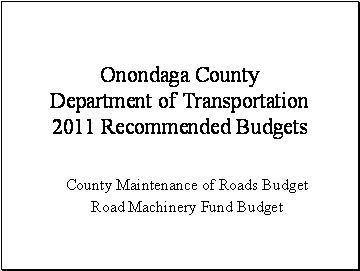 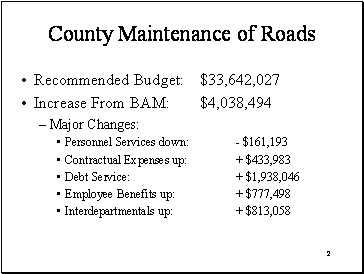
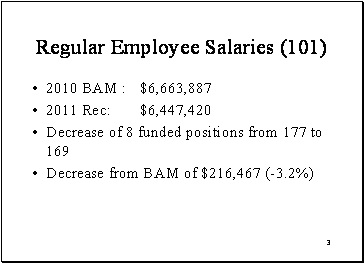 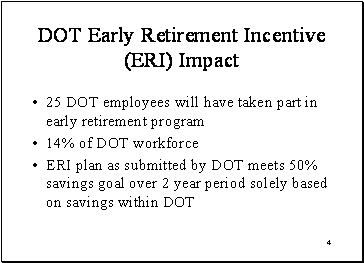
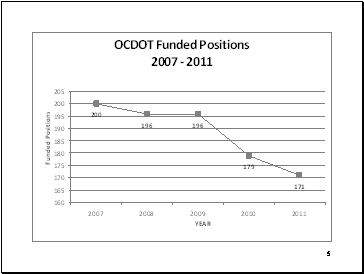 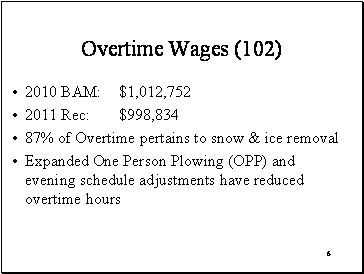
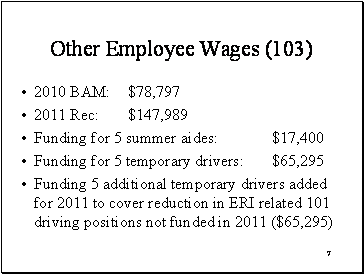 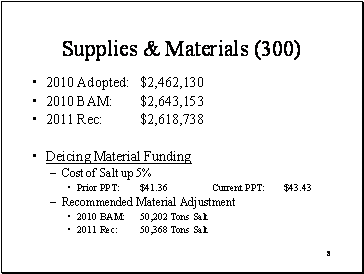
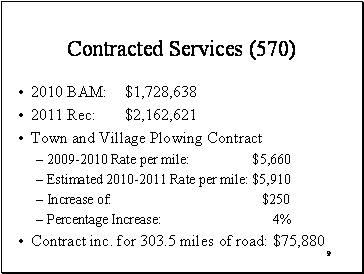 
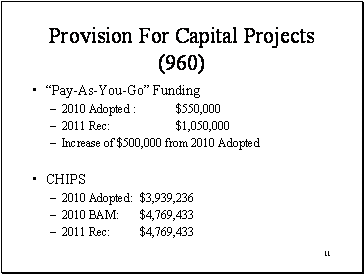 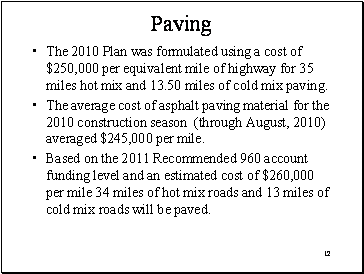
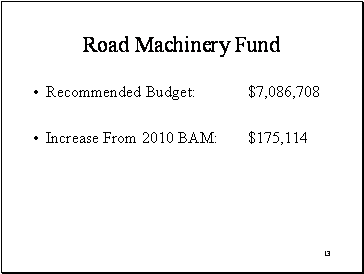 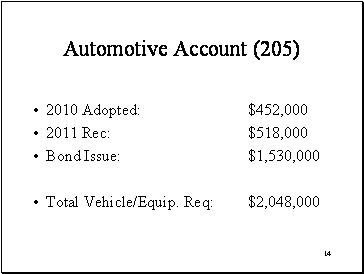
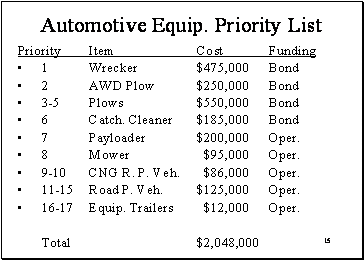 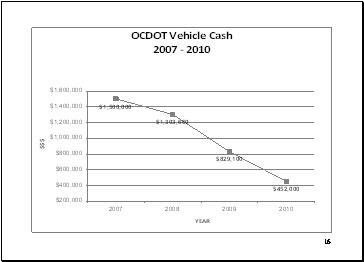
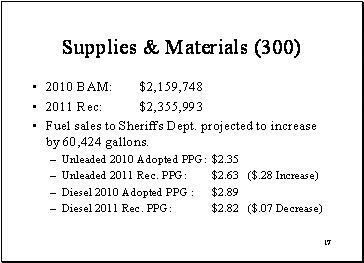 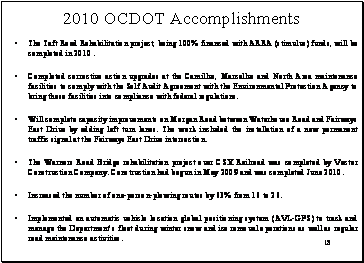
Mr. Jordan asked how many people exercised the early retirement option (ERI). Mr. Donnelly said there are 25 positions, they have 8 that are unfunded in the 2011 budget, five positions that are showing as funded, but with the early retirement salary savings, they will not be able to be filled; it is a total of 13 positions that will not be filled in 2011. Mr. Jordan asked why there is not a decrease in their authorized positions. Mr. Donnelly said they felt it was pertinent to unfund the positions because they will ultimately be filled up to the level they are authorized under the ERI. Mr. Jordan said it is his preference that they abolish the positions; then, if they feel there is a need to create or recreate a position in the future, come to the Legislature to explain why it is needed and to get approval.
Mr. Jordan asked about the plan if the towns choose to pick up the additional 61 miles of plowing County roads. Mr. Donnelly said the County should see a reduction in fuel and salt. They have had preliminary discussions with all of the towns regarding the miles that they would like them to take, the response has been mixed – some towns are very eager, some have not embraced the idea quite as warmly and some have not given them an answer. Mr. Donnelly explained that so many of their expenses in the winter are dictated by how harsh the winter is. If it is an average winter, they should see some reduction in costs by having those miles plowed by the towns.
Mr. Jordan referred to the projected increase in the supply line for greater share of fuel usage. Mr. Donnelly said departments have been fueling up more at DOT than at WEP this past year.
In answer to Mr. Jordan regarding CHIPS, Mr. Donnelly said they were trying to play it as safe and reasonable as possible when they came for the 2010 Budget; based on the State’s financial situation, they felt it was prudent to put in the budget $3.9 million which is actually the programmed amount for CHIPS for Onondaga County. Historically, the State Legislature has always bumped that up, last year they weren’t comfortable that it would happen last year; it was bumped up by the Governor, came in rather late. At this point in time, the $4.7 million number seems to be what they come back with year after year regardless of the budget situation in Albany.
Mr. Jordan noted that he sees they are eliminating the use of sand, seems sand is fairly inexpensive compared to salt or treated salt. Mr. Donnelly said they would have the opportunity to buy it if needed, was only used it in the past when they have had difficulties obtaining salt due to shortages. Sand has no deicing qualities, provides minimal traction and is a mess to clean up at the end of the season.
Mr. Jordan observed that they are asking for additional pickup trucks that are used by supervisors, asked if they have ever pursued the option of having the employees purchase their own vehicles and giving them an automobile allowance. Mr. Donnelly said he has not looked at that, couldn’t say if the County has ever taken a hard look at it in the past, knows it avoids some liability for private companies who do that.
Mr. Stanczyk observed that there is an increase dollar amount for Pay-As-You-Go funding of $.5 million from last year. Mr. Donnelly said the Capital Plan had $2.3 million in it for Pay-As-You-Go funding; that was reduced to $1.050 million.
Mr. Stanczyk asked why the budgeted Debt Service is up. Mr. Rowley said it was a $19 million bond issue that they released in 2010 to get DOT caught up. Mr. Stanczyk asked how much money the County got for the Taft Road project. Mr. Donnelly replied, “Approximately $6.9 million”, it is not reflected in the budget; it is part of their Work Plan. Mr. Donnelly noted the following:
- Project was funded over a number of years – federal aid job and stimulus money.
- Total design and construction of the project was estimated to be $10 million, there is approximately a $500,000 savings for Onondaga County in local share.
- Design for federal aid jobs is typically 80% federal, 20% local.
- Construction and inspection is 80% federal, 15% State and 5% local.
Because they had the opportunity to get that project done with federal stimulus money, Mr. Stanczyk asked if they would be doing less in 2011 and 2012 or the same amount and just substituting other projects. Mr. Donnelly explained that the money received for stimulus was put into the SMTC region for competition for additional projects across all the member agencies. The County competed for additional funds that were freed up from stimulus for a bridge painting project and the Jamesville Road repaving project. Every year there is new federal funding that comes out, they are seeing an increase in the TIP, are able to add 8 additional projects into the TIP over a five year period for resurfacing and bridges.
Regarding plowing, Mr. Stanczyk said the County has better equipment, trained staff and backup capacity; seems to be a regression to put more on the towns. Mr. Donnelly said in many cases the towns’ equipment is better; philosophically, certain services are better delivered closer to where they are needed. There are four County highway facilities across 800 miles of County road; each town has a highway facility. Every town and two villages plow a certain number of miles on the County’s behalf. Mr. Fisher said it costs the community more for the County and the towns to both plow; if one gets out of the business, might be able to cut the total spent by $1-$2 million. Mr. Donnelly noted that Monroe County operates certain highway functions – primarily traffic and some major capital projects and they also handle the traffic for the City of Rochester; their plowing operations and a certain level of road maintenance work is all done by the towns and villages. 95% of the plowing miles in Jefferson County are done by the towns and villages. Of the surrounding counties, Onondaga County is the lowest (38%) of the roads being plowed by the towns and villages with the exception of Cortland County that has the towns plowing 28%. Mr. Donnelly said the County Executive has stated that she would like the County to be out of the plowing business by May 2012.
Mr. Jordan asked if it is still the intention of the County to create a more centralized highway facility in the Town of Clay. Mr. Donnelly said it is on hold right now because of its cost ($25 million).
Mr. Lesniak referred to Line 570 – Contract Services, asked what the additional $74,000 was for. Mr. Donnelly said regarding the 2008 contract for the towns and villages to plow, there is a contractual increase in the rate every year; they paid $5,660 per centerline mile last season, this season they will pay $5,910. Mr. Lesniak asked if the contracts have any kind of performance rating or anticipation. Mr. Donnelly said there have never been any performance standards within the contract, it has been on good faith; they have never had problems with the towns or villages under performing to their expectations. There would be a discussion regarding performance goals when negotiations take place this summer for a new contract. Mr. Lesniak advised that they need to take a hard look at the outsourcing all County roads.
In answer to Mr. Lesniak regarding debt service, Mr. Donnelly said the 2010 issuance included $.9 million for the 2009 repaving program, $3.7 million for the 2009 cold mix program and also $3.6 million for the 2010 repaving program and $2.3 million for the 2010 cold mix program; the first payments will come due in 2011. Mr. Donnelly said as the cash has gone down and they have increase the bonding, but they have not increased the bonding to the point that it hits the goals of 38 miles of hot mix and 15 miles of cold mix.
Mr. Lesniak pointed to the substantial increases in the towns’ tax rates; DOT is roughly $5 million more than it was last year, asked what their priorities are. Mr. Donnelly replied that the department has tried dramatically to reduce its size and expenditures over the last few years. They are as low in personnel as he hopes they need to get. They can just cover their routes for plowing; one person plowing that started out as an efficiency tool is now a necessity. They will continue to plow only the areas that are safe and efficient to do with one person. It was challenging and difficult to come over to ask for $2 million worth of equipment, looked at the bonding as an alternative to a direct hit to the Operating Budget in 2011; the fleet is old, does not think they can limp along for another year regarding the plows.
Mr. Lesniak mentioned that the overtime line is not much of a drop when they are increasing the 103 line. Mr. Donnelly explained that overtime is a very difficult number to come up with on an annual basis because it is so weather-dependent, that is why they have been using a seven year average. The number for 2011 is actually 13% under that average. Mr. Lesniak asked how they came up with the $147,989 on the 103 line. Mr. Donnelly said that is for 5 summer temporary minimum wage positions and for 5 additional temporary drivers who would work mid November through mid April (40 hr. week). Mr. Donnelly said they will supply the number as to where they are in overtime to this point for the current year.
Mr. Buckel asked how many County employees would be affected if the towns and villages took over all the plowing. Mr. Donnelly said they have not determined that number at this point. Mr. Buckel said he is skeptical that there will be much efficiency with one doing plowing – either County or towns. Mr. Buckel said transportation costs as a whole – what the County, City and towns and villages do – is one of the five largest local dollar expenditures in the community. He can conceive of some minimal efficiency, but will then have 19 towns with 19 dispatching, computer, maintenance, purchasing, and insurance operations, Mr. Donnelly said they have to explore this direction as an avenue to move forward, doesn’t think they are in a situation where they can leave things status quo; ultimately the goal is to provide at least the same level of services if not better at a cost that is hopefully reduced, it has to be a cooperative discussion between the County, towns and villages.
Regarding equipment purchases, Mr. Buckel asked if they have done lease versus purchase scenarios. Mr. Donnelly said he has not, it bears taking a look to see if there are cost savings. Mrs. Rapp mentioned the $475,000 Wrecker on the automotive equipment priority list and asked how often they use it, could it be shared or could they lease it. Mr. Donnelly said last year they used it 80 times (used as a tow truck or to extricate equipment that has gone off the road). A tow or extrication by a private company would cost between $1,000 and $1,500; that is $120,000 cost that the department is not currently paying. In a four year period at least the initial principal cost of the equipment would be paid. Mr. Donnelly said they would see what the other municipalities might have available for some kind of cooperative arrangement. Of the 80 times the Wrecker was used, Mr. Rhinehart asked how many were for the County and how many for another municipality. Mr. Donnelly said 73-74 times for the County and 6-7 times for towns and villages. The driver is also a mechanic and works on repairing equipment when Wrecker is not being used.
Mr. Rhinehart said there would be more efficiency if the County didn’t have to plow a couple of miles of County road and then pick up the plow while driving over town roads to get to the next County road, makes sense to let the local municipality plow the roads they are in. Another savings would be the proposed $30 million highway facility in the northern part of Onondaga County, wouldn’t have to build that if all the northern county roads are being plowed by the towns and villages. In answer to Mr. Rhinehart, Mr. Donnelly said there are about 100 drivers, 4 supervisors and approximately 30 people in the downtown office – engineering and administration. DOT does all maintenance and oil changes on their trucks. Each highway facility has two mechanics with the exception of Jamesville. They try to keep their parts inventory as low as possible. Mr. Rowley did not have the total parts figure available.
In answer to Mr. Rhinehart, Mr. Donnelly said the bonding for paving remains to be seen, they will have $1 million in cash in the 2011 budget. They will start working with Management and Budget to come up with a number for the bond issue; the Workplan comes over to the Legislature in April for approval in May. There are certain items in their Workplan that are not bondable, not all of the cash can go towards paving. The $4.7 million in CHIPS is also dedicated to paving. Mr. Rhinehart asked how much of the $1 million is encumbered. Mr. Donnelly said last year there was a look to cut the entire Pay-As-You-Go funding, but they did have to keep at least $500,000 in for things that are not bondable. Mr. Seitz said the base level of funding has to be around $500,000 to $550,000, they added $500,000 on top of that for 2011.
Mr. Rhinehart asked about auctioning equipment they replace. Mr. Donnelly said everything they would bring in is replacing a piece that would go to auction; revenue is in Road Machinery Budget. Mr. Gottstein advised that some of the equipment they would be purchasing next year may not come in until the end or beginning of the following year because it takes so long to build them, they won’t be able to auction off everything that is being replaced in the 2011 budget.
Mr. Masterpole asked if they are seeing any issues regarding accidents with one person plowing. Mr. Donnelly said there have not been any accidents attributable to one person plowing. They have made sure that the routes are appropriate for one person plowing, and the union has an opportunity before they put a route into play to review it and make comments. In answer to Mr. Masterpole, Mr. Donnelly said their current 1990 Wrecker has structural fatigue, and they have done an admirable job of keeping it on the road. They may have to look to private haulers this year as opposed to solely using the Wrecker.
Mr. Masterpole asked if the proposed north facility would still be needed if they get out of the plowing business. Mr. Donnelly said the point of having multiple highway facilities is to be able to provide prompt response when plowing in the areas where it is needed. In the summer months it is not as critical to get to an area. If the majority of plowing was outsourced, it would call into question the need for a new facility in that section of the County.
Mr. Jordan asked if they have the numbers of what they actually bonded for regarding Capital projects and what the bottom line cost actually ended up being. Mr. Donnelly will supply that information.
The meeting was adjourned at 4:25 p.m.
Respectfully submitted,
Johanna H. Robb
Deputy Clerk
* * *
WAYS AND MEANS COMMITTEE REVIEW OF
PLANNING & ECONOMIC DEVELOPMENT DEPARTMENTS - SEPTEMBER 21, 2010
CASEY E. JORDAN, CHAIRMAN
MEMBERS PRESENT: Mr. Corbett, Mr. Lesniak, Mr. Holmquist, Mr. Warner, *Mr. Buckel
MEMBERS ABSENT: Mr. Kinne, Mr. Stanczyk, Mr. Kilmartin
ALSO PRESENT: Mr. Dougherty, Mrs. Tassone, Mrs. Rapp, Mr. DeMore, Ms. Williams, Mrs. Ervin and see attached list (Attachment 1)
Chairman Jordan called the meeting to order at 9:08 a.m.
COOPERATIVE EXTENSION, pg. 5-3, Line 871: Anastasia Urtz, Executive Director
Ms. Urtz gave the following presentation:
Thank you for the opportunity to address the Committee concerning the proposed 2011 appropriation for the Cornell Cooperative Extension Association of Onondaga County.
The 2010 fiscal year has been a period of significant restructuring and downsizing of the Association in response to revenue losses from previously secure revenue streams totaling close to $200,000. The Association has reorganized its staff, laying off seven employees and replacing some of these individuals with lower paid workers, student interns, and volunteers; eliminated programs that could not generate sufficient revenue to cover their costs; shared the costs of nutrition program leadership with Cayuga County; and, moved the Association to smaller physical space, thereby reducing the Association’s annual facility costs by half.
Simultaneously, the Association secured stimulus funding from the NYS Department of Labor to offer the Different Shade of Green job training program for low-income veterans and other eligible individuals, including persons with disabilities. Since February, 2010, this program has placed 32 individuals in jobs with such companies as Northeastern Electronics, Granger Construction, Just Energy, Northeast Biofuels, Upstate Medical Center, Dielectrics Laboratories, Partnership Properties, Beam Mack, Inc., Onondaga County South West Public Library, Community Bakery, and Marcellus Nursery. In addition, 11 individuals have begun academic programs at local colleges, including Onondaga Community College, following their training. Currently, we are seeking funds to continue this green job training program in 2011.
Other key initiatives of the Association have included an expansion of community emergency preparedness education in partnership with the Onondaga County Department of Emergency Management, ClearChannel Communications, and FOCUS Greater Syracuse; continuation of the ever-popular Community Tree Buy program, with financial support for low-income communities provided by the Onondaga County Department of Community Development, and with participation by towns and villages throughout the County; extensive community education and installation of green infrastructure to address combined sewer overflow issues with support from the Onondaga County Departments of Water Environment Protection and Health; expanded volunteer programs for seniors interested in community sustainability; nutrition education with income-eligible adults and children, including refugee populations, in partnership with the Onondaga County Department of Social Services, the City of Syracuse, and numerous local agencies; education of the farming community on best management practices and product marketing opportunities in partnership with the Soil and Water Conservation District and the NYS Department of Agriculture and Markets; and, continued oversight of traditional 4-H youth development clubs. Soon, we will reintroduce a program to train volunteers as “Master Gardeners,” a low-cost strategy to respond to increasing inquiries from residents seeking to reduce household food expenses through home gardening and food preservation.
The Association also has established a local Food Advisory Committee to work on expanding value for farmers and food security for local residents. This group includes representatives from grocery stores and food distributors, food pantries, Onondaga County Farm Bureau, and farmers. One area of specific emphasis is working with farmers to produce specialty crops that are in high demand with local ethnic communities. The Association, in partnership with Cornell University, several other institutions of higher education, the City of Syracuse, and numerous local businesses and agencies, is seeking federal grant funding to support expansion of food production and distribution initiatives in the region. We await the decision of the United States Department of Agriculture on these applications.
Despite significant cost-cutting and realignment of priorities, the Association continues to be affected by the fiscal constraints impacting government at all levels. Many funders are unable to support projects as in the past and others remain unsure whether and how future funding will flow. Consequently, the Association projects a substantially smaller budget in 2011, with corresponding cuts in grant-funded staffing and programs.
Onondaga County’s appropriation to the Association provides much-needed operating resources and also supports traditional programming in agriculture and 4-H youth development. This year, the Association was able to maintain limited staffing for agriculture and 4-H by assigning staff with these skills principally to other grant-funded projects. This allowed us to fund small portions of their time from appropriated County resources to provide some attention to these program areas. However, given projected reductions in grant funding, it is unlikely that we will be able to maintain these positions and programs in 2011. Consequently, we have requested reinstatement of the Association’s appropriation to pre-2010 levels--$354,948.
The County Executive’s 2011 Budget proposes to maintain support for the Association at the 2010 level of $283,958--$71,000 less than the support provided through appropriation in 2009. While we truly appreciate being spared further cuts in appropriated funding, the Association cannot absorb a permanent $71,000 loss in appropriated dollars and maintain traditional programs for rural communities, as these programs have not proven to be good prospects for grant funding.
We recognize that we must do all we can to serve as good stewards of scarce resources. At the direction of Cornell University, the New York State Cooperative Extension System is pursuing an initiative to form shared business networks and expand programming among groups of county-based Associations to address widespread funding reductions occurring across New York State. These business networks will offer the opportunity for administrative and programmatic cost-sharing with implementation slated to begin in early 2011.
We appreciate Onondaga County’s commitment since 1913 to the mission of Cooperative Extension. And, we thank you for considering our request to reinstate the Association’s County appropriation to its fiscal year 2009 level of $354,948 so that we may continue to support both our urban and rural residents during these difficult times.
The Chairman asked why revenue line item #5 is showing a substantial decrease. Mrs. Urtz replied that 2010 stimulus grant funds totaling over $300,000 are reflected in this line. This line shows the contractual losses over time. We are funded from county appropriations and contracts, city contracts, and external grants. We draw down some state and federal funds from Cornell. All of these are shrinking. In 2009 there were more grants. We have had to go for federal money. The best way for us to do this is to partner with universities as they have a larger grant making machine behind them. We are in a period of great realignment. In response to the Chairman, she confirmed that these funds are not generated income; mainly grant money.
In response to Mr. Lesniak, Ms. Urtz stated the state ($50,000) and federal ($13,000) draw down through Cornell is listed as additional sources. $229,000 listed as other municipal is derived from county departmental contracts, over and above appropriations (Community Development $20,000 for urban forestry, food stamps $160,000 and Emergency Management $49,000). The Emergency Management project provides for a series of initiatives preparing groups such as schools, agencies, churches and communities to be able to address emergency issues that arise. They are in the process of preparing an educational campaign. They will be building a Citizens Core that will work with Emergency Services to provide emergency food, shelter, relocation, and etc. The funds are derived from Homeland Security.
In response to Mr. Warner, Ms. Urtz stated $14,000 was received from WEP for the rain barrels. The funding for this project has concluded. Most of what they are doing now is for fee by the public. The model has already been developed. Volunteers are doing the training from this point on.
SOCPA, pg. 5-108: Don Jordan, Director; Megan Costa, Planning Services Program Manager, Tracy Waldron, Fiscal Officer, Erin Esgro, Budget Analyst; David Bottar, Director of CNY Regional Planning and Development Board
Mr. Jordan and Mr. Bottar gave the following presentation:

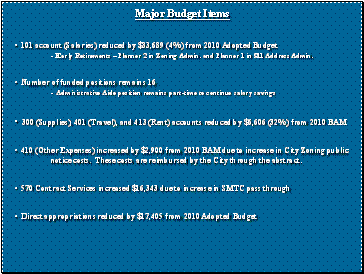 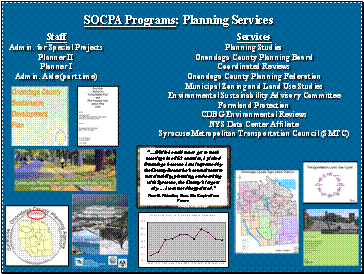
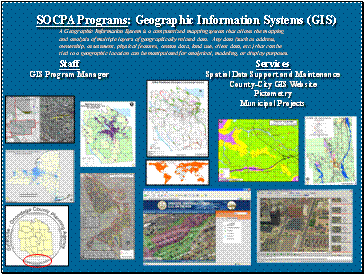 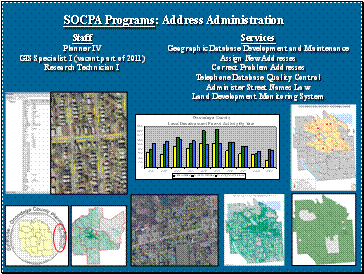
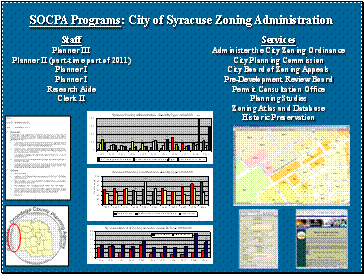 
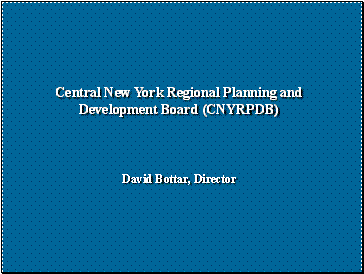 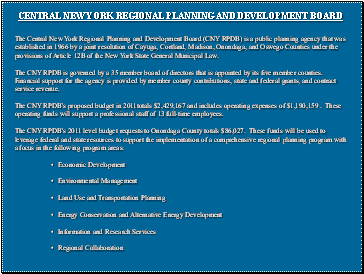
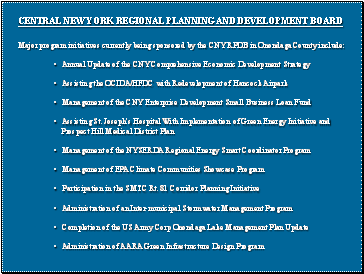 
*Mr. Buckel arrived at the meeting.
Mr. Jordan provided the following information in response to questions:
●Planner 2 positions will be brought back part time in October 2010
Anticipate refilling sometime in 2011
●Planner 1 position will be left vacant in 911
Plan to fill with a GIS position sometime in 2011
●All cost associated with Syracuse zoning are reimbursed by the city through the abstract.
●Home rule applies for all projects brought before Planning
Municipalities can overrule
●Addresses are assigned by 911 staff
●Passage of the municipal swear law would assist the Planning Agency
The earlier they are involved the better
●Ag District renewal work is now done in house
Formerly contracted with Cooperative Extension.
●570 Contracted Client Services line includes:
$1.3 million SMTC required pass through funds
$2.4 million CENTRO state mandated transportation match
Funds for CNYRPDB are not mandated ($86,000 total - $80,000 is grant funded)
Mr. Warner asked which of the authorized agencies SCOPA would most closely be aligned with if there was consolidation. Mr. Jordan stated he would have to put some thought into this. Mr. Warner asked that he do so, noting that he would get together with him later. Mrs. Rapp asked what are some of the things that they are doing
that could be done by another department, what could be put on hold for a year, and what cuts to their department could they recommend. She stated that she would rather have a real answer than something off the cuff. Mr. Jordan stated he would get back to her. She stated that there are resources that come to SMTC and the Regional Planning Board that do not come to the county. Perhaps we can find a way to share resources.
In response to Mr. Lesniak, Mr. Rowley stated that there are many different situations for people coming back from early retirement. If the work has not been performed on the 103 line in the past, you can not bring people back on that line. Civil Service rules state they must come back on the same line. Benefit cost are associated with everyone on the 101 line.
Mr. Lesniak asked how long the 3 positions have been unfunded. Mr. Jordan replied that the GIS Specialist position has been unfunded since last year. The Planner 4 has been unfunded for as long as he can remember. The Planner 1 just retired and will be unfunded next year.
In response to Mr. DeMore, Mr. Jordan stated that due to a shortage of staff they have not progressed as far along with the 2010 Plan as they had hoped. They are working with SMTC on a community planning and land use study. They have created a mail and online survey. They are getting the results back and are trying to gauge peoples thoughts on development, infrastructure, expenditures, there willingness to except smart growth ideas and transportation habits. They felt that outsourcing the plan was needed to have completion in a timely fashion. They were able to find some grant funding and are working on an RFP for the outsourcing. They would like to have a draft completed by 2011. This year a steering committee was formed to help guide the direction of the plan. Mr. Buckel asked what we could do to help strengthen the enforcement of the 2010 plan. Mr. Jordan responded, providing input and giving vocal support for the plan. Make decisions that are supportive of the plan and finally adoption of the plan. Mr. Buckel asked if we should try to get centralized planning control through local law or a municipal agreement. Mr. Jordan replied there is a benefit. The municipality’s goals may differ from those of the county. Sometimes the different levels can be a problem.
Mr. Lesniak asked if they had looked into Homeland Security grants. Mr. Jordan responded that there was a possibility of funding pictometry through Emergency Management. Grant funding was used to complete the Hazardous Mitigation Plan. This allows the county and all participating municipalities to go after additional pre disastrous mitigation funding. They will be using energy block grant money to fund outsourcing of the Comprehensive Plan. There are no Homeland Security grants in the process for 2011.
In response to the Chairman, Mr. Bottar stated that each of the five counties contribute to there budget based on a formula relative to population and land area. He provided the following breakdown by county; Cayuga $25,000, Cortland $16,000, Madison $22,000, Onondaga $86,000 and Oswego $36,000. The remainder of the budget is provided through thirty other funding sources. Historically they have been very dependant on federal and state grants. They have contracted service revenue, but must be very aggressive in obtaining grants to sustain there operation.
COMMUNITY DEVELOPMENT, pg. 3-118: Nina Andon-McLane, Acting Administrator; Edie Williams, Budget Analyst; Tony Discenza, Housing Program Coordinator
Ms. Andon-McLane gave the following presentation and provided a handout (see attachment #2):
Our budget request includes only the 3 HUD Entitlement Grants which provides us with our base budget and the bulk of our administrative costs. These 3 grants are just being approved now by HUD. These are the CDBG, Home and ESG Grants.
We just learned last Friday, 9/17, that two additional grants were approved by NYS:
- $400,000 Access to Home Grant – expanded Ramp Program for the handicapped; allows for more accessibility modifications; $15,000 cap (vs. $5,000 w/Ramp).
- $75,000 Restore Grant – emergency repairs for the elderly ($5,000 cap)
These are not included in our recommended budget because they were just approved by the funding sources.
2011 budget request of $4.4M is just about half of what our final Budget as Modified will be.
See “Funds Awarded to Community Development” handout.
- Last year (2009), we were awarded $12 M in grants
- This amount included $2.4M in stimulus funding we were fortunate enough to get:
- $663,619 CDBG
- $897,454 HPRP – Homeless Prevention & Rapid Re-Housing
- $850,000 NSP – Neighborhood Stabilization Program (through NYS)
- Over last 5 years, we have averaged $9.2 M in grants
- 2010 column: amounts in gray = applications pending
$4.2M approved (3 HUD Grants plus 2 NYS grants just mentioned)
$5.7M pending applications
Should they all be approved, this year’s budget will be nearly $10M
The total revenue from all sources since the beginning of our program is over $177M (see bottom of left column).
We will pursue other grants which are consistent with our mission of improving the quality of life for the County’s low and moderate income people, by rebuilding neighborhoods, improving the County’s housing stock, and upgrading the County’s infrastructure and upgrading community facilities.
We will return to the Legislature with budget resolutions as additional grants are approved.
We have 3 Program Areas:
1) Admin & Capital Projects
- 2009 – 31 capital projects underway; spent $2.8M on construction
- CD Steering Committee & Co Leg have approved our annual Action Plan in July, before it was submitted to HUD
- 2010 Action Plan Included 18 capital projects; a sampling of these are:
- Baldwinsville – Meigs Road Sidewalks
- E Syr – Worth St Sanitary Sewers (V working w/DEC consent order; separate sanitary and storm)
- Jordan – Pool Resurfacing (large water loss)
- Tully – Water Main Replacement (also large water loss)
The last three address environmental issues.
This program area includes Aid to the Homeless through our ESG ($92,735).
2) Housing Rehabiliation (includes Homeownership Program)
2009 – Completed 228 cases; spent $3.4M on rehab construction
2010 - Completed 174 Housing Rehab cases y-t-d
- Includes: 26 Ramp cases, 38 Shape-Up (elderly); 126 of 174 cases involved lead hazard removal.
- Goal: 240-250/yr
Homeownerships
2009 – 17 vacant houses rehabbed and sold; spent $2.1M on construction
2010 – 6 closed y-t-d; 6 more closings pending; 13 additional houses under construction
Goal: 15-20 houses
3) Commercial Rehabilitation
2009 – completed 10; spent nearly $400,000 on construction
2010 – completed 8 y-t-d
On the budget side, you can review a one-page summary of the budget allocations from our 3 entitlement grants (see last page of handout). This was also presented to this Committee in June when you authorized the HUD Consolidated Plan and our 1 year Action Plan.
In your budget book, you will see that CD is self-supporting. Our budget does not receive any local dollars with the sole exception of the Full Cost portion of the Indirect Costs, which are not eligible for reimbursement under federal regulations ($49,456 in 2011). This amount is included in the Revenue Account 070 titled “Inter Transfer – Non Debt Service.”
We spend almost all of our money on construction, providing jobs for smaller contractors, adding to sales tax revenue, increasing property values, and improving neighborhoods.
We will be glad to answer any questions you may have.
Ms. Andon-McLane provided the following information in response to questions:
●All expenses are covered via grant funds received
●All monies received must be held within Community Development
●$400,000 HTF – Access to Home & $75,000 HTF – Restore grants are listed as pending on the funds awarded to Community Development handout as formal notification has not been received
●$177,084,692 total is inclusive since 1975 formation (first page/first column of handout)
In answer to the Chairman, Ms. Andon-McLane stated that she and the administrator took part in the ERI program. The administrator position is about to be filled and she will be returning part time. Mr. Fisher stated they will be saving money by not filling her position full time (administrator funding planning coordinator). She will be working part time for the rest of 2010and 2011. There are no other funded and unfilled positions.
Mr. Lesniak asked why the 101 account had such an increase from 2009 to the 2010 BAM. Ms. Andon-McLane responded that they are a grant funded program. Not reflected in the 101 are all the previously awarded grants that were added to their budget in a prior year however, transfers within those grants are reflected in the modified. She would have to defer to the Budget department for more detail. Mr. Seitz stated that a previous year transfer within project accounts does not work well with BAM in B-Track. You are better off using the adopted budget for comparison. This shows activity that could be going back ten years. It tends to muddy the current years BAM.
Mr. Lesniak asked for detail of the 570 line. Ms. Andon-McLane responded there was a total of $1.5 million, of that $1.275 million is for 18 capital projects, $50,000 for fair housing activities of which $10,000 goes to ARISE, $40,000 to the Fair Housing Council, $5,000 for home owner counseling, $134,000 on non-profit community housing development organizations, and 92,000 for homeless assistance. They are monitored and required by HUD to further fair housing in the county. Everything within their budget is reimbursed except the full cost portion of the indirect cost.
Mr. Lesniak asked what the advantage was in the proposed local law title change. Mr. Fisher responded that the title currently reports to Economic Development. The new title would report to and be appointed by the County Executive. Mr. Troiano stated that an application must be filed with the State Civil Service Commission to change the title and one of the key pieces of this application is to have the position be an appointment of the County Executive. Once this has been completed, the application can move forward. In answer to Mr. Lesniak, Mr. Troiano stated the position is a competitive civil service position. There is no list at this time as the position has been occupied for an extended period. If the position were to be filled now, it would be filled on a provisional basis pending the change in jurisdictional classification by the State. Mr. Fisher stated that since Community Development is now its own department, the structure should correspond with the other departments.
In response to Mr. Warner, Ms. Andon-McLane explained the $867,809 Total Local as listed on the handout. Years ago there was a Minority Economic Development Counsel. It was funded from 1986 – 1991. They are no longer in business. The Other Local Admin $741,809 is the sum of the full cost portion of the indirect cost that is added to our budget. They do not have this every year. The 2009 amount appears to missing she believes it is about $9,051. This is not reimbursable by federal grants. The Total $177,084.692 dates back to the formation of the program in 1975.
The Chairman asked for clarification of the following listed under revenues, “Balances in administrative accounts from prior years’ grants of $608,775 will be used in the 2011 budget versus $422,628 in the 2010 budget. The increase is a result of the increases in both salaries and benefits”. Ms. Andon-McLane explained they are using monies from grants that have already been added to their budget, but are not included in the 2011 recommended. Mr. Corbett stated that grant money is being carried over as the department does not have enough staff. Ms. Andon-McLane agreed. They could do more if they increased their staff. Mr. Corbett stated this happens to be a department that has the money and can’t get it out fast enough. Ms. Andon-McLane stated that in the last six years they have almost doubled their funding. The current average is $9.2 million, up from $5 million.
Mrs. Rapp asked if some type of collaboration could be done with SCOPA to get the grant projects completed. Ms. Andon-McLane replied that they do collaborate with Planning. They have a link on the SCOPA website and assist with payment to SCOPA for the website. SCOPA provides the maps that must be submitted for grant applications, and did the bulk of the Consolidated Plan as Community Development did not have the staff. They will be providing Community Development with some administrative staff for 2011. Mrs. Rapp asked that they consider other projects they could pay SCOPA to complete.
In response to Mr. DeMore, Ms. Andon-McLane explained the 648 line - Commer Prop Rehab Grants. Low income business districts located throughout the county may qualify for facade improvements. All taxes must be paid and the building must be up to code. Mr. DeMore asked if the program could be bigger. Ms. Andon-McLane replied it could however, they only have one architect and they would need more money.
ECONOMIC DEVELOPMENT, pg. 3-111: Mary Beth Primo, Director; Tara Venditti, Budget Analyst
Ms. Primo gave the following presentation:
Good morning and thank you for the opportunity to present the Office of Economic Development’s 2011 budget request.
The Office of Economic Development
The purpose of the Office of Economic Development is to identify, develop, recognize and pursue opportunities for capital investment and job creation with the goal of increasing the net wealth of the county. The office has four primary functions: the attraction of new business to the county, the retention and growth of existing businesses, the promotion and marketing of the county, and the management of incentive programs. The tools used to accomplish its purpose are the Business Retention and Growth Program, the Enterprise Fund for Attraction and Marketing, the Onondaga County Industrial Development Agency, the Trust for Cultural Resources of Onondaga County, the Onondaga Civic Development Corporation and through June 30th of this year, the NYS Empire Zone Program. The office also collaborates with its economic development allies to create programs, activities and incentive packages tailored to the goals of client businesses.
Transformation and Collaboration
This year, 2010, has been a year of transformation and collaboration marked by the agreement to co-locate the city and county economic development offices, the creation of a new web presence, and the enabling of two new economic development tools: the Trust for Cultural Resources of Onondaga County (“CRT”) and the Onondaga Civic Development Corporation (“OCDC”).
Co-Location of City/County Offices of Economic Development
Due to the leadership of the County Executive and with the support of the Mayor, the county and city are co-locating their economic development offices in Washington Station, a newly constructed, “green” building located in Armory Square. The office will be a welcoming and impressive location for visitors and businesses from throughout the world; a tangible example of Central New York’s transformation from a Rust Belt community to one dominated by the new-economy business sectors. The Onondaga Civic Development Corporation has generously agreed to support the co-location by funding the 10-year lease for the office space.
Programs to Support Civic Facilities
Civic facilities - hospitals, universities and cultural organizations - dominate the county’s economic skyline. These institutions create wealth for the community by attracting to the area federal, state and private grant funding, out-of-state students and researchers, patients needing critical care, and visitors and benefactors of our cultural institutions.
For decades, these institutions financed capital investment through the Onondaga County Industrial Development Agency. The Agency offered a low-cost alternative to the services offered by the New York State Dormitory Authority and downstate financial institutions. In 2007, the authority of state IDAs to issue civic facility bonding lapsed. In response to the lack of reasonable cost civic facility financing, the County Executive together with the County Legislature enabled the Onondaga County Civic Development Corporation and the Trust for Cultural Resources. In less than one year, four organizations have requested the issuance of over $439 million in bonds for five projects.
21st Century Marketing
All of the new efforts planned and undertaken by the department will only be valuable if the results of those efforts are discovered and understood by those interested in locating or growing a business in Onondaga County. The department seeks to achieve this goal by integrating a modernized web presence and new media strategies into its marketing outreach and fulfillment efforts. The department has contracted with a professional communication & web design firm for the modernization and redesign of the SyracuseCentral website. The firm has extensive experience melding economic development marketing and new media communications with data generation and management. The result will be an accessible, more easily managed, technically sophisticated web communication tool that projects the image the county deserves.
The redesigned SyracuseCentral website will be launched in the 4th Quarter of 2010. The office will manage the ongoing maintenance of the site.
Business Retention & Growth Program
Existing businesses generate most of a region’s economic growth. A proactive business retention and growth program that serves local businesses is therefore a critical component of any economic and business development effort.
- The Office of Economic Development developed and continues to manage a dedicated one-stop business retention and growth program. The program is built upon the strength of department staff and its collaborative relationships with the other economic development providers operating in Onondaga County. The office manages an informal alliance of these allies, better known as “the Streetbeaters,” which has created an integrated, long-term approach to delivering economic development assistance to local businesses. The “Streetbeater” retention program has been featured as a best practice by the Small Business Administration. Together, the partners reach approximately 4,000 Central New York businesses a year. The department manages an active outreach program for more than 350 of these businesses.
- In 2009, the department developed the Economic Development Road Show, which was held on three occasions at different locations throughout the county. Later this year, the department will unveil the new Road Show as three workshops that will be available for presentation by teams of economic development partners at the events at which businesses naturally congregate. The workshops will address concerns with capital investment, business creation and entrepreneurship, and productivity improvements. The workshops also will be presented to attorneys, accountants and others who counsel businesses but may lack familiarity with economic development programs.
- The office will continue its reach into rural agricultural and tourism based businesses. Working with the New York Agribusiness Corporation and the Convention and Visitors Bureau, the department is developing a web-based approach to the marketing of the county’s rural and agricultural assets. The short-term goal is to create a tourism trail for the Route 20/Route 80 corridor that will complement the Cayuga County and Madison county tourism trails. Presently, we are forming focus groups to advise us on the format and delivery of the marketing campaign as well as the regional assets the campaign will feature. The long-term goal is to build an alliance with the rural and agricultural community with whom we will then work to build a coherent economic development strategy for rural Onondaga County.
Business Attraction Program
The business attraction program promotes the county as a location for industrial and commercial investment. Promotion of the county involves attending trade events, meeting site selectors and others who influence the site location decision, and placing strategic advertising in select publications. In the past, the department’s primary allies in the attraction effort were the Empire State Development Strategic Business Unit and the National Grid Economic Development Department. This year, the department’s attraction allies expanded to include Center State CEO’s new lead generation and qualification program, which supplements the department’s business attraction program. Currently the department is managing 23 attraction leads, and collaborating with CenterState CEO on five of them.
The redesigned SyracuseCentral website will greatly support our attraction effort. As is generally understood, site selectors and corporate real estate consultants narrow the field of potential investment locations based solely on information available through the Internet. Much of the information used to qualify or discard a potential location is culled from that location’s website. The improved functionality of the website will provide site selectors with a tool that offers accurate information more quickly and in formats that are more useful.
Increasing our local companies’ participation in the global economy is an important goal of this department. In 2010, the office sought economic development with international organizations through continued collaborations with the SESAME International Network of Cities and the ExportNY program. It furthered these efforts by joining the Capital Corridor Trade and Tourism Initiative and the International Business Association (IBA).
- The Capital Corridor Trade and Tourism Initiative is funded and managed by the Thousand Islands Bridge Authority and the Federal Bridge Corporation and promotes trade and tourism within the busy five-hundred mile transportation and trade network running between Ottawa, Canada and Washington, D.C. The recently created, locally managed International Business Alliance seeks to make local businesses more aware of the opportunities and hurdles of successfully selling product internationally.
- In 2011, the department will continue to participate in those programs and utilize its relationships with the professional economic development community to promote the county.
Incentive Program Management
Economic Development Incentive Programs are the linchpin for any economic development effort. The programs support the department’s primary mission of attracting capital investment into the county and supporting job creation. Office staff manages every facet of the incentive process beginning with the promotion of the programs to business audiences to the final negotiation and monitoring of incentive benefits offered to specific attraction and retention projects. Staff also fulfills the administrative and reporting requirements imposed by statute, most recently amended by the adoption of the Public Authorities Accountability Act of 2009.
The NYS Empire Zone & Excelsior Programs
This year, prior to the phase out of the Empire Zone Program, the department created a 7th Empire Zone area in Clay, assisted the certification of seven new Empire Zone qualified companies which project the creation of 515 jobs and approximately $205 million in capital investment. The office also served as the primary advocate for ten local companies threatened with decertification by the state. Of these ten companies, none has been decertified. In 2011, the staff will continue to administer Empire Zone benefits and reporting requirements for the 183 companies grandfathered into the state program.
The Excelsior Program is the new state program to encourage capital investment and job creation. The state plans to brief in full economic developers on the program rules and regulations in early October but I anticipate the department will have a more limited administrative role in this program.
The Onondaga County Industrial Development Agency, the Trust for Cultural Resources, and the Onondaga Civic Development Corporation
OCIDA provides bonding, tax management and training grants to industrial and commercial projects. The Trust for Cultural Resources of Onondaga County and the Onondaga Civic Development Corporation provide bond financing to civic facility projects.
The Industrial Development Agency supported approximately $180 million of capital investment for six projects projecting the creation of at least 170 new jobs. The Agency also provided over $40,000 in support of training grants and sponsorships of business programs, and administered two state funded, pass-through project grants.
Since its inception, the Onondaga Civic Development Corporation induced approximately $217 million in bond financing assistance for three major projects: St. Joseph’s Hospital, Lemoyne College and Abby Lane Housing Corporation, which is an affiliated corporation of SUNY ESF. To date, approximately $120 million in bond financing has been issued.
The Trust for Cultural Resources of Onondaga County issued $165 million in bonds for a Syracuse University construction project. The Board of the Trust agreed to use a portion of project fees to fund grants to local cultural, educational and recreational assets. This year, the Board awarded ten grants to nonprofit organizations. The Board, however, is presently revising its grant policy to provide a greater benefit to the county’s non-profit cultural organizations.
I would like to point out that the decision to activate the CRT and OCDC made by this Legislature and the County Executive kept approximately 2 million dollars in our local economy. This money is being used to support economic development and the county’s cultural assets.
The Impact of the 2009 Public Authorities Accountability Act
In 2009, the Public Authorities Accountability Act (“PAAA”) mandated increased state oversight of state and local public benefit corporations like the three administered by my office. The office presently is completing the first cycle of administration and reporting requirements mandated by this act, and we have found the new requirements to be burdensome and extremely time consuming, distracting staff from the real economic development work. It is my hope that once these new requirements are initially addressed, less time and fewer resources will need to be devoted to satisfying them in the future. In 2011, however, the department will continue to administer the policies and procedures imposed on the organizations by the NYS Public Authorities Accountability Act.
2011 Budget Request
The proposed 2011 budget includes a change in personnel with the creation of the Program Analyst position. This is a direct result of the increased workload driven by the operation of the Onondaga
Civic Development Corporation, the Trust for Cultural Resources of Onondaga County and the demands of the PAAA.
As proposed in the County Executive’s budget, the dedicated marketing budget for 2011 is reduced from $150,000 to $100,000 (see appendix). We were able to reduce our request for marketing dollars for 2011 in part because the website redesign, a significant undertaking that demanded almost 30% of our 2010 marketing funds, is now behind us. Our new website, while providing a more vital, accurate and compelling statement about our community, and a greater return on investment than traditional advertising, will enable us to spend less on print advertising and other marketing activities. In addition, during the past year, staff has examined past marketing activities in terms of each activity's return on investment. Those with the lowest return per invested resources have been reduced or deleted from the department's marketing plan. And finally our ability to leverage our marketing resources with our new marketing partner Center State CEO gives us an opportunity to further reduce our marketing expenses.
The 2011 Budget proposal includes a contribution from the three organizations. The contributions made by these organizations represent a proportional share of department resources and staff time dedicated to fulfilling the goals of each of these entities. Their total contribution represents a larger contribution than OCIDA, the only previously existing entity, provided in the past.
Projected 2011 appropriations are from four sources:
- $341,968 (38% of 2011 budget) from the County Industrial Development Agency, shown on line 036;
- $143,986 (16% of 2011 budget) from the Onondaga Civic Development Corporation, shown on line 036;
- $87,991 (11% of 2011 budget) from the Trust for Cultural Resources of Onondaga County, shown on line 036;
- $338,000 shown on line 057, other miscellaneous revenues. The source of which is a portion of the county share of the Destiny fees paid to the Syracuse Industrial Development Agency.
The local dollars requested for 2011 are $20,433.
Thank you for your time. I would be pleased to answer any questions.
Appendix
Marketing Budget
- $46,000 will be used for memberships, attraction marketing events, and trade shows
- $5,000 for research and related reports;
- $19,000 for print/electronic marketing materials
- $18,000 will be used for local marketing/events/meetings/trade shows
- $10,000 for global competitiveness (SESAME and hosting events for site selectors, corporate executives)
- $2,000 for website hosting
In response to the Chairman, Ms. Primo stated that know one in her department was participating in the ERI plan.
The Chairman asked if it would be more appropriate to have the new program analyst position split between the OCDC and CRT. These organizations are creating the need for the position. Ms. Primo stated that the person filling the position is working with her now. Work is preformed for both organizations in addition to other work. In response to Mr. Lesniak, Ms. Primo stated that the position is funded via CRT. CRT is providing $200,000.
Mr. Lesniak asked what the city was contributing to the co-location of Economic Development offices. Ms. Primo stated OCDC is paying for the rent. She confirmed there is no reduction of staff from either side. It would be difficult to share staff at this time. This is a first step to see if we can coordinate things. Our missions are different. The county works with large businesses and industry. The city works with retail, inner city and smaller businesses.
Mr. Lesniak stated that OCDA is working along with the city on big projects such as Upstate, St. Joseph and ESF. Ms. Primo stated that the bonding projects for ESF, St. Joe’s and LeMoyne were done solely by OCDC. The City Economic Development was not involved.
Mr. Lesniak questioned what the advantage was in co-locating with the city. We would be paying rent and not sharing any services. Ms. Primo replied that moving out of the Civic Center to a new building located in the heart of Onondaga County is a marketing statement on its’ own. She does not think that you can buy advertising that would give us a better face. They are working on over 23 attraction projects, many come to our community. It would be wonderful for them to see this new office. Mr. Lesniak asked if she was suggesting that a business decides to relocate here because of the Economic Development office. Ms. Primo replied that she thinks there are a number of reasons why business relocate here. It is nice to provide a good first impression, certainly it will not be the only thing, but it will be an advantage to us.
Mr. Warner asked about consolidation; how many other organizations within Onondaga County or Central NY are essentially doing the same thing. Ms. Primo replied she did not know. Many think the merger of the MDA and Chamber to form CenterState CEO will reap big benefits. She can not think of others. Mr. Warner asked if she was competing with this organization for business. Ms. Primo replied, “No”. They have been working so well with CenterState CEO, it is one of the reasons they we able to reduce their marketing budget. Currently they are collaborating on five attraction projects. CenterState CEO covers a twelve county region. They will not be doing everything with us and we can’t do everything with them. There are times when we can work together. When we do it has proven to be very beneficial to the community. Mr. Warner asked if there was any room for consolidation of her department with anyone else in Onondaga County. Ms. Primo replied it is very premature to think that they could consolidate with CenterState CEO, their mission is different. They are here to drive regional economic development and we are here to drive county development. She believes the most logical and economical consolidation would be with the city. Moving into a co-location is a big step toward consolidation.
Mr. Buckel stated that per the NYS Comptrollers’ website $45 million is spent in Onondaga County for economic development. There are other organizations undertaking these efforts and often in competition with each other. He believes it should be a departmental goal to advance centralization this year. He does not see any reason why they would not merge with the city and towns. He takes issue with the comment that CenterState CEO is regional and not the same as our mission. Our economy is regional we have to think broader. Ms. Primo stated she agreed, but the office can not be combined without a lot of detail. The MDA and Chamber put a lot of thought into their merger. They have not had the opportunity to do so. We know we are just one part of the wheel. CenterState CEO has a different mission than the county at this time. Mr. Buckel stated that the merger of the Chamber and MDA was accomplished in six months.
Mr. Buckel asked for metrics to define their success; cost and benefits. Ms. Primo replied that she assumes metrics would mean number of jobs and capital investment. Mr. Buckel added minus expenses. Ms. Primo responded that he just told her the expenses were $45 million. NYS Empire Zone created 515 jobs and approximately $205 million in capital investment. The IDA supported $180 million of capital investment creating 170 jobs. The OCDC induced $217 million in bond projects. Mr. Buckel stated he would talk to her separately. All she was doing is scratching the surface. They do not have a true detailed picture of what is spent and received out of this budget.
Mr. Rhinehart asked how many jobs were created with the $150,000 marketing budget last year. Ms. Primo replied she did not know. Mr. Rhinehart asked if there were any jobs created. Ms. Primo stated they currently have 23 attraction projects. Most of the marketing budget is used for attraction; drawing investment into the county. Mr. Rhinehart stated that other organizations market as well. Ms. Primo responded that is why it is very difficult to measure their success. There are a number of others are involved. New York Sate, CenterState CEO, MACNY, City Economic Development, CNYRPB and other organizations may be involved. She believes that as long as their name is out there it is going to help them. They need an opportunity to talk to be people out there. Marketing provides for opportunity, it does not always land the business. Mr. Rhinehart said he understood that, but we need to be more results oriented. He asked if it would make a difference next year if one of the many entities doing marketing refrained from doing so. Ms. Primo stated she did not know the answer to that.
Mr. Rhinehart stated that the marketing budget request for 2011 is $100,000 (see appendix above for breakdown). A number of other entities; for example the CVB are doing the same thing. Ms. Primo confirmed that was correct, but the CVB is marketing for a different purpose. They market to bring people here for a vacation or a convention. The massage is very different, making it difficult to consolidate. Mr. Rhinehart stated he understands that, but economics should result in us taking a look at these entities. It is our responsibility to fund these different organizations, maybe now is the time to decide which ones we need and which ones we don’t.
Mr. Rhinehart stated that when the OCDC was formed last year there was talk of the City of Syracuse forming their own. He asked if they had done so. Ms. Primo replied that she believes they have, but she does not know of any projects that they are working on as of this point.
In response to Mr. Rhinehart, Ms. Primo stated the IDA currently has $1.279 million, but at the end of the year it will closer to $1 million. Mr. Rhinehart stated that the proposed budget would be using $350,000, close to 40% of these funds. Ms. Primo confirmed that was correct. She added they also anticipate collecting significant fees that should be very helpful to OCDA. Mr. Rhinehart stated they need to determine what will be done once the IDA resources are gone. He stated the legislature was going to take a hard look at the 2011 budget and determine what will continue to be funded for the future.
The Chairman asked what the City of Syracuse will be paying for with the co-location. Ms. Primo replied that OCDC will be paying the rent. The city and county will each have to pay for their own phone, IT and copier expenses. Codes will be used with the copier to determine usage.
In response to Mrs. Rapp, Ms. Primo stated that if the $20,000 local dollars were removed from their budget they would have to tighten their belt.
INFORMATION TECHNOLOGY, pg. 3-82: Kenneth Beam, Chief Information Officer; Karen Alesandro, Opeations System Manager; Tara Venditti, Budget Analyst
Mr. Beam gave the following presentation:
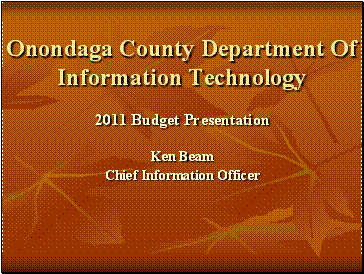 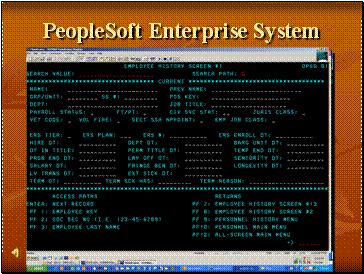
Onondaga County has embarked on a project to implement Peoplesoft application system.
This system is an integration of business processes and information systems. It is a user-friendly system that enhances the County’s ability to improve it’s business process. It eliminates redundant data entry, storage, and paper processing.
Peoplesoft enables a web-based self-service for constituents and employees. The integrated solution will retire many existing legacy systems, such as:
GENESYS – Payroll and Human Resources
FAMIS - The County’s Financial System
B-Track and Budget
Once productional, Onondaga County will be able to offer the Oracle/PeopleSoft applications to Towns & Villages at no cost.

In May 2010, Information Technology began printing all DSS rent payment checks. Once processed, the checks are folded and glued as mailers.
The Department of Social Services then distributes the checks to both clients and vendors.
The newly automated procedure eliminates the need to have a DSS staff member run a check signing and bursting machine.
Both the Comptrollers Office and DSS audit this process for accuracy and adherence to standards/best practices.
There are approximately 3200 checks printed and processed monthly.
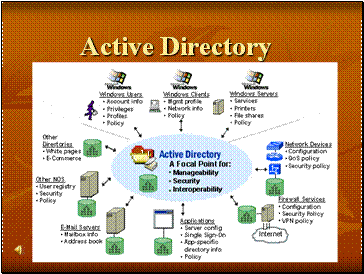
A Microsoft Active Directory infrastructure provides the County greater flexibility, more troubleshooting resources and a lower cost than Novell E-Directory.
Therefore, the decision was made to migrate to Active Directory.
With the migration complete, I.T. strategies such as centralized desktop management can now be realized.
Centralization improves workstation support efficiency by reducing on-site visits and improves response to change requests by enabling IT to push software and updates to desktops.

This browser based application (written in the JAVA language) tracks all County retirees (including OCC) and was completely written in house.
Efficiency is now increased as OCC has the ability to enter and maintain THEIR OWN retiree records rather than sending them to Employee Benefits to be processed
Questions or inquires from OCC retirees can now be handled by OCC themselves, rather than by Employee Benefits.
Further reports and processes will be put in place to reduce OCC billing and payment time to Onondaga County.
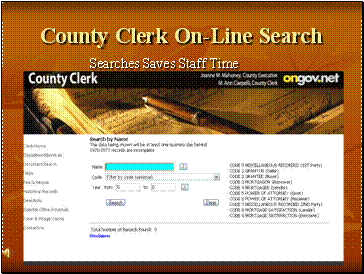
The addition of this on-line search saves the County both time and money.
Previously, individuals would call or visit the County Clerk's office to have a staff member assist them with looking up their documents.
In both instances, a staff member is taken away from their daily tasks.
In still other cases, the Public would come in to the Clerk's office only to find out they were in the wrong County for their document search.
With the online search, staff time is saved and unnecessary trips to the County Clerk’s Office can be avoided.
Currently the public can access Mortgage, Deeds, Powers of Attorney, and Miscellaneous records.
The next phase of the project will add Judgments and Civil Actions.

In February of 2010 the Syracuse Police Department requested the opportunity to be a part of the existing Sheriff’s Department Active Warrants site. Because it was written in-house, Information Technology was able to accommodate the request in 2 months and incurred no additional costs
Some statistics regarding this site are:
In June of 2010, Law Enforcement conducted Operation Safe Surrender.
As a direct result of the Active Warrants web site, approximately 100 people turned themselves in. Another 25 persons were arrested as a result of tips sent in thru this site.
In a 2 day period there were a total of 305 people arrested and 340 warrants processed.
According to the Syracuse Police Department, since June, they have received over 110 email tips from the web site resulting in numerous arrests. Email tips continue come in daily.
The net effect of this site has reduced the number of outstanding warrants by more than 500.
The site provides the community increased safety, and manpower savings.
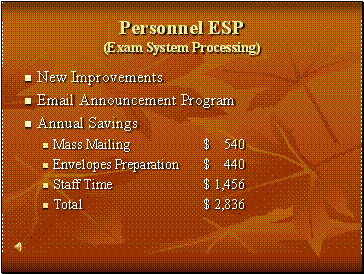
The improvements Information Technology has made to ESP this year has saved the personnel department and the County in the following areas:
The email announcement" program has decreased the amount of printed hard-copy mailings.
On average, our department produces and distributes 2 mass mailings per month.
This results in an average cost savings of ($45/mo or) $540/yr.
Additionally, 1 hour of work time is saved by reducing the number of mailing envelopes prepared.
This results in an average savings of ($36.70/mo or) $440/yr.
Another saving feature of this application is the modification to the security levels.
By securely allowing more trusted persons to make modifications, Personnel saved time, on an average of 1 hour per week (@$28/wk).
This results in an annual savings of $1456.

Onondaga County voters will be using a new voting machine this year.
The machine uses paper ballots filled in by the voter and scanned into the machine.
These ballots were printed last year from outside vendors.
A request from the County Board of Elections was sent to the print shop to evaluate this job and determine if it can be done by our internal Print Shop
It has been determined that the print shop will process these ballots resulting in a substantial savings over last years’ outside vendor costs.
By doing the printings in-house, we have the ability to have staff on duty, during the primary and general election, to process any emergency printing of these ballots if needed.

JasperServer is a web-based repository for both static and ad hoc reports. It provides functionality for scheduling and e-mail distribution.
Users can create tailor made reports containing just the data they require by simply dragging and dropping. Previously, new report requests would have to be handled by a programmer. Giving users the ability to create their own reports eliminates this turn around time and allows programmers to focus on application development.
As a dedicated report server, JasperServer reduces costs by functioning for multiple applications.
Placing reporting responsibility on JasperServer instead of directly on an application server allows for a better user response time within the application.

In response to question Mr. Beam provide the following information:
●7 participants in the ERI plan
4 programmer analyst
1 application manager
1 system program
1 programmer 2 positions
●3 programmer 1 positions will be added
●3 people returning part time
Paid out of the 101 line
●There are no upgraded positions within the budget
●$200,000 salary savings for 2011
●No positions are funded and unfilled
●E-Learning used to train personnel via the web
Transportation cost savings
Personnel remain on site
Average cost of training under the former system was $7,000 per person
$9,000 net increase in training cost this year includes all staff
●$4,000 travel reimbursement for work performed off site
Local mileage going to county departments, towns and villages
●Professional services are used to bring in a skill they do not posses for job completion
AURORA provides signing service for deaf personnel
Sunguard is a NJ company providing a yearly disaster recovery test
Network support is used to provide outside service for wireless installation, etc.
Could be performed in house if additional staff was hired
Custom software created by outside vendors - provides for maintenance
Some of this will go away with Peoplesoft
●Returning equipment charge - is the shipping cost for hardware no longer being leased
It makes since to lease larger pieces of equipment
PCs will not be leased in the five year replacement plan
●Verizon campus offset $585,000
Telephone service and connection wire back to the Civic Center for sites not located downtown
●PAETEK is part of the new voiceover IP system for Van Duyn
Verizon lines will be going away and PAETEK will replace them
Less expensive
Will be doing the same thing with the county phone lines over the next year
●The print shop will remain with 3 personnel
Mr. Beam will supply the Chairman with the total cost for training in 2010 and 2011.
The Chairman asked for clarification on the software programs IT is performing support for. Mr. Beam stated
●BEAST - countywide evidence tracking system for forensics
●Practice - used by they District Attorney’s office
Will be replaced with phase 2 of the police records management system program to be written into the system
●IT software is any boxed software currently in place
covers the maintenance cost for all packaged products
●A number of programs will be replaced with the Peoplesoft program
FAMIS, B-track, Genesys and Contracts
Mr. Lesniak asked for clarification on the personnel. The budget book shows IT increasing their authorized positions by 15 and the funding totals by 2. He asked why the positions being replaced at a lesser grade were not being abolished. Mr. Rowley answered that because of the complexity of tracking the ERI salary savings plan they choose not to abolish these positions until a tracking system has been designed and is functioning. These positions are being unfunded.
Mr. Lesniak asked which 2 positions were authorized to be filled. Mr. Beam replied that one of the positions is actually a transfer from the Sheriff’s department. A grade 15 is being deleted from the Sheriff’s Department and a grade 12 systems administrator will be coming into the IT Department and assume the same duties. The other position is, Director of Client Services. Mr. Lesniak asked what the reasoning for adding the director of infrastructure services Mr. Beam answered this was all part of the reorganization of the department. Mr. Beam will provide detail on the reorganization and a list of the positions being unfunded.
Mr. Lesniak stated that no local dollars are shown for your budget, but you have a subtotal listing $12,453,269 for interdepartmental transfers. In essence you are a $12 million dollar department that is being billed off to every department within the county. Mr. Beam agreed, but asked that we keep in mind some of the money is reimbursed from the state. Mr. Beam will provide a breakdown of actual local dollars verses what we are receiving funding for.
Mr. Lesniak asked how many PCs were being purchased to get everyone on the five year replacement plan. Mr. Beam stated they are looking at replacing close to 600 PCs per year. By purchasing in bulk they will be able to save $150 per PC. In answer to Mr. Lesniak, Mr. Beam stated this number is based only for County PCs. If we combine purchasing departments it will allow an even greater reduction. This was an informal quote from one of the PC companies, it has not been sent out for RFP.
In response to Mr. Rhinehart, Mr. Beam stated there are 3200 PCs within the county system. He confirmed that the mainframe will be replaced within three years through the Peoplesoft project. Mr. Rhinehart asked if there was any outside service from the PCs manufacturer. Mr. Beam replied PCs come with a 3 year warranty. In some cases they will ship you the part and we replace it. Some of the warranties will send in a repair person to replace the part. With the new machines we are looking for a 5 year warranty. It may be that county personnel will replace the parts, or it could be shipped back to the manufacturer for repair. Mr. Rhinehart asked if they would need to hire additional personnel if the new computers require county personnel to repair them. Mr. Beam replied that there will be a 5 year warranty on the machines and he believes it is all on site. He confirmed that all departments have PCs.
Mr. Rhinehart asked how the cost per PC is determined; is the total cost divided by the number of PCs. Mr. Beam replied they bill back the departments per each PC. In response to Mr. Rhinehart, Mr. Beam stated that the Health department was the most expensive. He stated Social Service operates a large number of computers that are handled by the state. He confirmed that they are also handling the computers for WEP. Mr. Rhinehart asked if there would be a reduction in IT cost if there was consolidation of departments. Mr. Beam responded that there would be for purchasing the equipment. Mr. Beam confirmed that Sheriffs’ office was scheduled for PC replacement next year. E911 and the County Clerk’s office should be updated within 3 years. Mr. Rhinehart confirmed that there would not be any changes for the County Clerk in the 2011 IT budget. Mr. Beam stated the County Clerk’s office would be receiving the same support in 2011 that IT currently provides. Mr. Rhinehart asked how the upgrade order was determined. Mr. Beam explained that they wanted to up date 600 PCs per year. They took the number of PCs for each department and tried to get as close to the 600 number as they could. Mr. Rhinehart requested a copy of the projected upgrade schedule by afternoon.
In response to Mr. Buckel, Mr. Beam confirmed that if there were any reduction due to consolidation it would not affect the ability to run the Peoplesoft project.
Mr. Lesniak asked why Kronos was increased from $150,000 to $275,000.
●New clocks need to be purchased
Unable to obtain parts for older clocks
10 departments coming on board in 2011
●Software upgrades
●Maintenance
In answer to Mr. Lesniak, Mr. Beam stated the Sheriff’s department was added to Kronos in 2010. Health and Library are two of the biggest departments that will be added next year. By the end of 2011 all departments should be on Kronos.
Mr. Lesniak asked if we are going to the Peoplesoft application, why are we still investing in Kronos. Mr. Beam stated that Peoplesoft doesn’t keep track of time. Mr. Fisher added that the Comptroller has asked them to consider if Kronos is the correct application choice for the long haul. IT, the Comptroller’s office and Management and Budget will be reviewing time management applications. A timing billing system is needed. Mr. Lesniak stated it does not make since to go to new technology and use an antiquated time keeping system. Mr. Fisher replied there are people using Peoplesoft with Kronos. We don’t know if it is right for us. Mr. Corbett added that long term is appropriate description for the Kronos. It seems as if we have been trying for years to get this up and running. He questioned if the old equipment they found in boxes four or five years ago was ever used. Mr. Fisher answered they were.
In response to the Chairman, Mr. Beam stated Social Services has about 800 state computers. The only other department that does not operate on the county system may be the E911 intake computers on the floor. He will have to check on this, he believes they have 20 – 25 computers. The Chairman stated the County Executives budget projects to have 3800 employees. If you subtract the computers at DSS and E911 it seems as if we have 300 extra computers. Mr. Beam responded the replacement list will show the number of PCs for each department.
ONCENTER, pg. 5-3, Line 825: Terri Toennies, President/CEO; Steve Cambareri, Chairman - Board of Trustees;
Peter Casper – Chief Financial Officer
Mr. Cambareri stated that as everyone is aware their have been a number of changes since last year at the Oncenter. The County Executive and Mr. Fisher have been working with them to evaluate our business model and our relationship to the county. Mr. Antonacci and his staff did an audit on the Oncenter which resulted in a number of recommendations. The Oncenter concurred with all the recommendations and all have been or are in the process of being accomplished. Our operations are much more streamlined. With the consolidation of positions we have cut costs. We are light years ahead of where we were two years ago in terms of financial reporting, analyzes and projects. All of those things have put us in a better position. Changes to the management agreement put the onus on the Oncenter complex to do better what it does best; attracting convention business and filling seats and beds. Onondaga County will be providing maintenance and upkeep for the facility. Our budget request reflects all of this. You will see there is a reduction in out ROT request as a result of the changes to the management agreement.
Ms. Toennies stated she was here today to recap the past year and present their proposed budget for 2011. For purposes of this discussion all references to the Oncenter will refer to the overall operations of all three venues and buildings and the events that happen throughout the year. It is important to note that the Oncenter truly consist of five revenue segments, conventions, trade shows and banquet functions; AHL Hockey – The Crunch; concerts and family events; theatrical and musical performances and parking. A sixth segment; sponsorship marketing will be reviewed in our presentation today. Since the fall of 2009 we have taken an operation that was set up in silos with little efficiencies or cross utilization and realigned the way that the Oncenter does business. By peeling away all the layers and realigning the sales, service, operations, finance, and human resources teams we will be able to show you today the positive results of these changes. We came to you last year and let you know what you all suspected. The Oncenter was hemorrhaging and was not set up for future growth. Had slowly turned into a glorified banquet hall in the convention center and was not operating at its maximum in the War Memorial and Civic Center Theaters. The café and cafeteria were costing you money and changes needed to be made. We began by making a number of hard decisions regarding long term personnel and the positions they held. We stripped away layers of management to allow our team to work effectively together towards the same common goal of economic development of our venues. Most importantly we implemented accountability measures to allow the board and management to insure the proper practices and policies are in place regarding business contracts, bookings and negations of future business. All to have the tools in place to make smart business decisions through analyze of any event being booked. We are pleased with our results those far and believe that 2011 will be a year that we will be able to begin to show you the positive effects of the changes implemented. With the 2011 United States Bowling Congress in the convention center from February through July we can identify the impact of $45 million to the economy. We see the effect that group business has with hotel rooms in our city and the importance of contracting more of the same while still booking year round activity in the War Memorial and the Civic Center. Our philosophy for 2011 is two fold, think big and deliver bigger; and get rid of the can’t do and figure out how to.
Ms. Toennies gave the following presentation and supplied handouts (copy on file with the Clerk):
ONONDAGA COUNTY LEGISLATURE
THE ONCENTER
2011 BUDGET PRESENTATION
September 21, 2010
2011 Proposed Revenue

2011 Revenue Comparison to 2010

Goal and Commitment
 

New Business with the CVB
Professional & Trade Organizations based on
$266.00 per day x 3.6 days x # of delegates
SMERF groups
(Sports, Military, Education, Religion, Fraternal)
$203.00 per day x 3.6 days x # of delegates
Increasing the use of the War Memorial Arena and revenues produced through:
Aggressive strategic plan of relationship building with AEG and Live Nation through touring opportunities, self promotes and co–promotes
Increased Collaboration with Regional and Local Concert and Event promoters
Participation in Nationally recognized Music and Entertainment programs (Pollstar, Billboard, etc)
Specified Booking and Revenue goals for Oncenter for the Director of Ticketing & Event Bookings
Working with the Syracuse Crunch on joint marketing
Programs that will increase attendance, broaden the Syracuse
AHL audience and improve revenues at hockey games
Flexibility in booking of the Civic Center Theaters through:
Ongoing community cultural arts networking
Effective use of rehearsal and storage space in areas other than the theater space during a show run
Continued participation in the IDEAS Collaborative
(Initiative to Develop and Engage Audiences in Syracuse)
Sponsorship Marketing Plan
Marketing outside of standard past practices
Continual assessment of current sponsorship marketing plan
Exclusive rights to products sold in our venues and in conjunction with the United States Bowling Congress event in 2011
Naming rights of venues including potentially the War Memorial
Arena, and the Civic Center theaters
Specific Event Sponsors in conjunction with concerts, family
events, graduations, and theater.
Marketing Update – as of 9/20/10 |
SPONSORSHIPS |
|
|
Ticket Backs/Monitors |
|
$13,000 |
Ticket Envelopes/Monitors |
|
$5,000 |
Signage/Monitors |
|
$7,400 |
Arena Doors |
|
$12,500 |
Scoreboard |
|
$8,750 |
ADVERTISING |
|
|
Ribbon Lights |
|
$19,750 |
Garage Banner |
|
$600 |
MARKETING |
|
|
Event Marketing |
|
$4,000 |
TOTAL |
|
$53,225 |
|
|
|
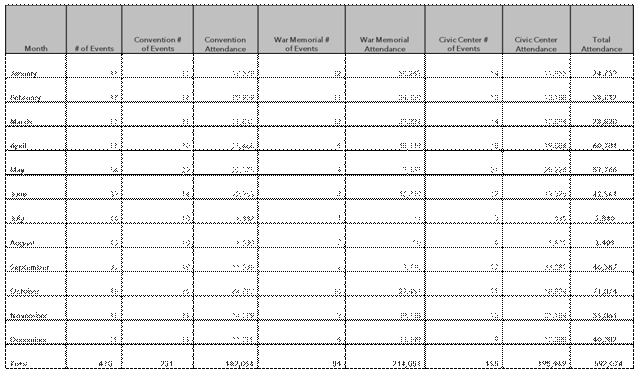
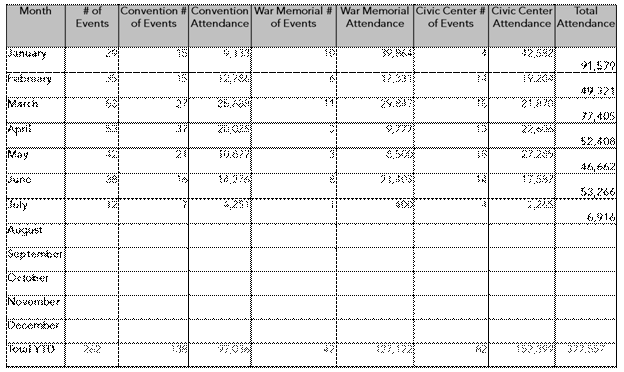
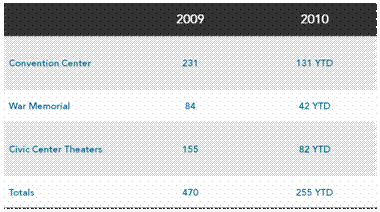
Due to contractual obligations in place the Facility Fee was partially implemented in 2010.
2011 has been budgeted with a full year of Facility Fees in place.





Summer Job Sharing Program
Further reorganization of full time employees with cross utilization throughout the property including Summer job sharing program for Operations Department reducing full time hours to 32 hours per employee (savings of approximately $30,000 over slow Summer months)
Reorganization of Sales team deployment and positions (Sales, Ticketing and Marketing)
- 2009: 13 full time and 4 part time people
- 2011: 12 full time people
(including shared position with the CVB)

- $250,000 request will be used for various capital investments relative to catering and concession services to include glassware, china, flatware, linens, and culinary equipment necessary to prevent further rental of items throughout the year.
- Several of these items are required for proper transport of food and service at War Memorial catered events during USBC 2011.
Six year plan 2011 through 2016
- Included in your packet.
- NOTE: Many of the Capital improvement projects required for 2011 are due to the relocation of catered group business into the War Memorial from the Exhibit Hall due to the United States Bowling Conference
- These items will be brought in front of the legislature later this year.
United State Bowling Conference 2011 Budget Impact:
Revenue
Annual business worth $400,000 in food, beverage, set up/service and room rental not returning due to no availability of the exhibit hall
Parking and concession revenue that is annually generated by these events
Additional missed opportunities for new bookings due to no availability in Convention Center breakout meeting rooms
Expenses
Greater of 25% of concessions sales (net of taxes) or $100,000
Storage facility at $6000 per month x 12 months $72,000
Electrical Power sufficient to operate bowling lanes and scoring equipment estimated at $28,443

On behalf of the Oncenter Management Staff and our Board of Directors we are very appreciative of the support we receive from the County and our Legislators.
We are committed to ensuring that Syracuse and TheOncenter becomes a viable option of consideration for regional and National meeting planners, promoters and consumers to ensure the future economic growth of our City.
The Chairman asked what was going to happen beyond 2011. Ms. Toennies stated that 2012 is looking very good right now. She would be happy to provide preliminary numbers. She knows that they have summer conventions booked for 2012 which is very rare. These bookings alone will provide over $1 million worth of impact to the Oncenter.
The Chairman asked if she envisioned reaching a break even point. Ms. Toennies responded saying if they get to the point of no subsidy, she is not sure that all the business they are bringing in will be convention related. As with the bowlers, we are paying almost $1 million to get them here. That type of business does not always result in profitable business inside the convention center. The key is to balance the convention center losses out with the impact in the city and then keeping business in the War Memorial and Civic Center. The Chairman stated that these large conventions book four to five years in advance. He is not sure there is much business of this size and scope. He believes that most of their business will be the typical more profitable business in terms of the Oncenter complex. Ms. Toennies agreed that it should be. If they continue their aggressiveness in booking national and regional conventions were they are coming into town for three or four days with breakfast, lunch, dinner, and rental at our facility and all we are navigating is shuttle service or commissions, it should certainly be a much more profitable business than social local and banquet discounted. The Chair stated that he understands it will go up and down each year, but does she see that in general the subsidy will be removed. Ms. Toennies replied that it will all depend on the nature of the business. At this time as they continue to consolidate she believes that that could get down to $750,000 very easily. They are always going to have an overhead expense of labor, with or without business coming in.
The Chairman asked if she was satisfied that they can operate as necessary given the budget proposal and schedule for capital improvements. Ms. Toennies stated they certainly can. The capital projects list is significantly over the $250,000. They will have to look at some type of bonding in order to get $4 million worth of major projects done. You must remember that the convention center was built in 1992 and a number of things haven’t been done in 18 years. The immediate competition for northeast business has new or updated faculties; Buffalo, Erie PA, Ottawa and Rochester. It is important that we stay competitive. In response to the Chairman, Ms. Toennies stated there are always possibilities to cut back. They will review the food beverage capital project, see what they can get funded and then see what the priority is and roll the rest into the following year. She added the facility fee does not get generated into the convention center and that is where the majority of this kitchen equipment is used. The facility could pay for concession equipment that is used in the War Memorial as the fee must be used in the building where it was generated. The Chairman asked why use fees were not generated through the Oncenter. Ms. Toennies replied the facility use fee is basically charged on public ticketed events.
Mr. Lesniak stated the budget subsidy request is $1,233,731 million however budget line 825 is listed as $1,479,742 requested. Mr. Camberari stated this includes the $250,000 operating subsidy. In response to Mr. Lesniak, Mr. Fisher stated the funds are being taken out of the 570 line. The total subsidy to for the Oncenter is $2,344,229 including the funds going to Facilities for the Oncenter Complex. The following information sheet was provided:
ONCENTER - CONSOLIDATED EXPENSES AND REVENUES - 2011 PROPOSED BUDGET |
|
|
|
|
|
|
EXPENSES |
|
|
|
ONCENTER |
|
|
|
Operating Subsidy |
1,229,742 |
|
|
Capital Reserve |
250,000 |
|
|
|
1,479,742 |
|
|
|
|
|
|
FACILITIES MANAGEMENT |
|
|
|
Debt Service - Carrier project |
155,211 |
|
|
Oncenter + War Memorial - Steam & Chilled Water |
458,026 |
|
|
Maintenance & Repairs |
251,250 |
|
|
|
864,487 |
|
|
|
|
|
|
|
|
|
|
TOTAL EXPENSES |
2,344,229 |
|
|
|
|
|
|
|
|
|
|
REVENUES |
|
|
|
Authorized Agencies - Physical Services Budget (Room Occupancy Tax) |
|
|
1,479,742 |
Facilities Management Budget (Room Occupancy Tax) |
|
|
864,487 |
|
|
|
|
|
|
|
2,344,229 |
Mr. Warner asked if the steam and chilled water cost have always been around this same amount. Ms. Toennies stated new meters were put into place after the Comptroller’s review. In the past the amount varied up to $650,000. Mr. Fisher stated previously it was a guess and he does not believe they were very close. He believes last years figure was $670,000. He added the figure is still a guess as they only have two months of data from the new meters, but they believe it to be a better guess. Mr. Warner asked what happened to the $150,000 that was an over charge from last year. Mr. Fisher stated that Carrier did an energy project which was bonded for. Mr. Seitz stated the legislature authorized a huge energy savings project back a few years. A piece of this was to upgrade lighting at the Oncenter. $155,211 is the debt related to those efficiencies that were performed.
Mr. Warner asked how decisions were made as to which venue functions will be held in and if there was room to cut some of the expenses by handled events at one of the other venues. Ms. Toennies responded that it becomes a matter of what the show is going to draw, especially when you are looking at the War Memorial or the Civic Center. If they have a concert coming in with a draw of 2-3,000 people we will try to talk them into the Civic Center where it is less labor intensive for set up. If you go into the arena verses the convention center the arena use is going to be minimal. The competition between the three venues is not as big as the competition with the Landmark or the OCC arena.
In response to Mr. Rhinehart, Ms. Toennies confirmed that year to date they are down 150 events. Mr. Rhinehart asked how many of the events booked are local. Ms. Toennies stated they have discussed this before and a majority of their events are social local or regional day time meetings. This is why they have put a new position into place to really generate the convention sales. Mr. Rhinehart stated that for most of these events we are competing with the private sector in our own community. These events could go to local hotels and businesses instead they are coming to a government subsidized facility. He knows that the original intent of the convention center was to attract business to town. Ms. Toennies responded that it is important to note that a lot of the social local business that they do is 500 or greater. They really can’t fit anywhere else unless they go to Turning Stone. Keeping it in Onondaga County is a better option than it going to the Turning Stone.
In response to Mr. Rhinehart, Ms. Toennies confirmed the $1.3 million dollar loss projected does not included what was just shifted to facilities. Mr. Rhinehart asked if there had been any discussion about closing the Oncenter. Mr. Camberari replied that there had not been.
Mr. Rhinehart asked if the Syracuse Fire Department had authorized festival seating for the War Memorial. Ms. Toennies responded that they are still working on it. They hired an outside security consultant that specializes in event management. He gave a report to the board saying that he saw no deficiencies. His main emphasis was on making sure the staff was trained on how to handle festival seating. They will be asking the board for approval to go ahead with training at tomorrows meeting. They hope to have festival seating in place by 2011.
In response to Mr. Rhinehart, Ms. Toennies stated six or seven concerts have been added since 2010. These events have been profitable. They make money on food and beverage sales and ticket rebates. In response to Mr. Rhinehart, Ms. Toennies stated she was not involved with concerts at Alliance Bank Stadium.
Mr. Rhinehart stated that the Oncenter works closely with the CVB and asked if there was any discussion of sharing office space with them. Ms. Toennies replied that she would love to consolidate the sales teams as much as they possibly can.
Mr. Rhinehart confirmed that the entire $1,479,742 subsidy to the Oncenter will be coming from the ROT money. He stated there will be some serious talk in the next couple of weeks about reconfiguring what we do with our ROT money.
Mr. Rhinehart asked if there were times in 2011 when there are no events booked at the Oncenter. Ms. Toennies replied the ball room will be maximized and the convention center exhibit hall has 48 bowling lanes in it from February 1st– July 30th. Ms. Toennies stated the bowlers are the reason they are losing money, the rest of year is solid. They have been able to move some groups that normally meet during this time frame, to the 3rd and 4th quarter of the year when the exhibit hall becomes available again. She stated that the only income to the Oncenter from the bowlers would be from concessions. Mr. Rhinehart questioned why we were hosting the bowling conference if it is the reason we are losing money. Ms. Toennies responded it is providing $45 million to the economic growth of the city.
Mr. Fisher stated that it was known we were going to loss money with the Oncenter. As the Comptroller’s report stated the reason ROT went from 3% to 5% was to provide an additional subsidy. The money that is collected from hotels and motels, that should be generating room nights for them but isn’t, is being addressed. The additional 2% is a lot of money that goes to subsidy. It is not property tax that is being used, it is tax that is collected from the hotels and motels used to subsidize the Oncenter. This was known from the day that the convention center was built. As the Comptroller pointed out, this is what we need to get back to. Ms. Toennies added the key is to put more heads in beds, support the room occupancy tax and not use the Oncenter as a banquet hall.
In response to Mr. Rhinehart, Ms. Toennies stated she could get by for another year without the updates to the Crouse Hinds Theater. In response to Mr. Rhinehart, Ms. Toennies stated they are concerned about the symphony. They just paid the $34,000 that was owed and required before the new season begins. Their contract calls for payment 5 days after each event. That has never happened. The symphony prevents them from putting long running Broadway shows into the theater. She added, it is wonderful for our city to have a symphony, but the question remains if it is a viable business to fund. The current two year contract goes through this season. A contract for 2011 and 2012 has not been signed. In response to Mr. Rhinehart, Ms. Toennies stated the reduced schedule has not effect on the Oncenter as the concerts were to be held at outside venues.
R.O.T., pg 3-5, Line 570. :
Chairman Jordan stated unless members of the committee had an objection, R.O.T. would be addressed on Friday, September 24th along with the presentation from the Finance department.
CENTERSTATE CEO; pg 3-5, Line 570: Rob Simpson, President/Chief Executive Officer; David Holder, President of the Syracuse Convention and Visitor’s Bureau
Mr. Simpson stated he was excited to be sitting here for the first time representing the new business economic development partnership organization in support of the legislative request for the CVB. CNY has been fortunate to have a lower impact from the national recession than many parts of the state and certainly better than many parts of the country. Unemployment has hovered around 7.5% - 7.6%, almost 2% lower than the national average. One of the reasons why we have been more successful than other parts of the country is our diversified economy. The tourism industry has been one of the bright spots in our economy. We have seen overall decreases over the course of the last year in travel spending on the order of 7.9%. This is certainly not as bad as many other cities across the state of NY and around the country. Employment in the hospitality sector has only decreased 1.4% over that same period of time in 2009. These are things that give us hope and optimism. I think the story that David will share with you today is one that despite difficult odds in the national economy, we have a convention and visitors bureau sales team and partners at the Oncenter that are delivering results.
He would like to comment on the example that Mr. Rhinehart just raised as a point of clarification. The county makes an investment in the Oncenter of approximately $2 million per year. The bowling congress event alone is estimated to generate $1.1 million during the course of 2011 in room occupancy tax for the county and another $800,000 in sales tax revenues. $1.9 million in revenue from one event; subsidizing 8 months of additional profit making opportunity for the Oncenter complex. This is one of the reasons why we think that the tourism industry and the Oncenter in particular are critical elements of our economic development strategy. He shares this in part because one of the things that he has been most encouraged by through the merger of the MDA and the Chamber of Commerce has been the professionalism of the CVB team. It has been an absolute pleasure and learning experience to work with the folks at the CVB. There is no other line of business within our CEO partnership that has a greater ability to demonstrate a concrete return on investment than the CVB. This is something that they make a priority on an annual basis. It is something that they report to you regularly on and candidly, it is something that all of the team members within CenterState CEO are working to learn from. We are making sure that we can demonstrate as effectively, a return on our investment in all our economic development activities.
Mr. Holder provided a handout for review with his presentation (see attachment # 3):
Mr. Holder stated that we have endured 2010 very well. As you can see, we actually compared 2010 to 2008 hotel levels because 2009 was such a terrible year across board for every destination. We endured a little better than other destination cities in upstate NY and certainly throughout the country. When we start comparing ourselves to one of our past good years, the first half of 2008 we came out pretty well. What we are concerned about it is what the future looks like. Ms. Toennies touched on this briefly with her presentation. The job of the SCVB is to deliver conventions, sporting events and leisure travelers in the future. We have seen massive changes in the way that convention and sporting planners book their business and we have adapted to that. We have changed the way we go after that business and are introducing some innovative ways to pursue this business.
To put business into place for Onondaga County we must have aggressive marketing, outreach, sales and online promotions. Those elements make tourism destination marketing happen. I am proud to say that we are doing some things to deliver this in Onondaga County. However, we have some trends based on the funding levels for 2010 that do have us concerned about where the future is headed.
We have shown considerable results with some of our online opportunities. Facebook fans increased 66%, Twitter followers have increased by 139%, but our website saw its first decrease in a few years. We did not have as much marketing, trying to generate interest and awareness of this area. We simply did not have the funding to do this. We did have some really good PR efforts driving interest in our area. You can see just a sample of what those are; from television appearances in Ottawa to an article that we worked heavily on with the Food Network about salt potatoes. Those types of opportunities can drive interest and awareness up for this destination. This is really what you want the marketing side of the CVB to do; tell the world what this area has to offer.
If you look at our sales efforts, we had a great year for conversion in 2009. We booked a lot of business and thankfully we did; otherwise our 2010 figures would not look very good. In 2010 we have seen a great increase in potential business; business that we have bid on, but haven’t finished converting yet. You can see the total amount of booked business. Comparing year to date 2010 to 2009 we are down 60%. There is still a lot of potential in that mix. However we have to get these numbers converted and that takes people, time, energy and marketing investment. These are things that we are committed to with our team in place.
Looking at all future event business, you can see 2012 is starting to shape up. 2013 and the missing 2014, do not have much business on the books at this point. This is the part that has us concerned about what the future holds for us. We have to drive increased business for conventions, sporting events and awareness, so that leisure travelers come here. These are the three main elements of the CVB.
You can see, we are still tracking a bunch of potential business for 2011, 2012, 2013 and a small amount for 2014. 2011 is going to be critical for us; we have to convert some of that business for 2013 and 2014 specifically. We need to get more business on the books, so that we are having positive conversations around this table next year. Instead of trying to figuring out how we will fund all these different pieces.
A snapshot of who is coming in 2011, shows the main piece of the estimated travel spending is coming from the USBC Women’s Bowling Congress. Yes, it is a big investment. However, that $45 million is what they are spending in your businesses and helping you to employ your local residents in this community.
If you look at this in terms of return on investment; our key measure, the sales group program is driving return on investment. For every dollar we are putting into their programming, whether it is marketing outreach, trade show attendance, sales mission attendance or the services they provide to the groups coming in; they are delivering $41.79 in travel spending.
Looking ahead to the future, let’s dig into our budget. The County Executive has proposed that our budget increase by 18.5% from 2010. If you compare this to where we were in 2009, it is still a 6.3% decrease. It is critical that we make certain that investment stands.
We have some very important things that we must do with that money next year. We must take care of the visitors that are coming in for the Women’s Bowling Championship. There are 44,000 prospective visitors that are going to be arriving in Syracuse; 450 of them each day. Every single group that comes in has to be treated like a new group. We have to layout the same level of service for them in June and July that we roll out for the very first group that arrives in April. This is going to take a substantial amount of energy and investment. We can’t just be looking at what is happening here in 2011. We have to be looking at the future.
Our convention development has to be focused on driving new business and finding new prospects. A large piece of this is the new position of Convention Development Director; a combined effort of the CVB and Oncenter. This position will provide for someone who is focused on driving 400 peak night rooms to our area. A piece of business that we really depend on and need to put more focus into. Our existing sales managers will continue to churn their level of business, but we need someone that is focused specifically on new and large scale business.
We want to put more efforts into media relations. We had great results in 2010 with minimal investments, but we are fortunate that we did. We need more going into that public relations effort, because we need people talking about us for the future. We need the Wall Street Journal and the New York Post picking up more and more stories about Syracuse, just like they did this year.
We are going to have increased demand on our collateral. It is time to update our meeting planners guide. Our visitors are going to require more demand from our visitors guide; in addition to what we are planning with the meeting planners guide. We need to continue our investment in online programming. This is where visitors are finding information before they arrive.
We have an increased opportunity for driving business from our own local market. Our relationship with CenterState CEO provides an enhanced relationship with the business community. That’s our primary driver for creating better opportunities for conventions and meetings in this area. We want to see things that we have had success with coming back, and that requires staying in touch with our business community.
Finally, we have event support. Recently you have approved funding for a new event, King of Trucks. We have to make certain that these events, which drive so much for our local economy, continue to be sustained.
If you look at the sales approach of the CVB’s budget you will see our main emphases is in these defined areas. We need to make sure our presence is known and we are driving more for the future.
I am very pleased to say, we are coming to you as Accredited Convention and Visitor’s Bureau. We are one of the first 100 in the world to reach that designation. This says that our industry association has looked at our programming, our operations and accountability. They have said this is one of those bench marks and standards that we look for across the convention and visitor’s bureau industry.
We have had great success and are looking forward to great success in the future.
Mr. Simpson added his closing comment. The CVB over the course of the last year has demonstrated their ability to do more with less. They continue to put forward a highly professional outreach program. The new and expanded partnerships not only with the business community, but the Oncenter are signs that people are working well together. There are amble opportunities for us to grow the business that is coming into this community.
We are excited about what we can do with the budget request that the County Executive has delivered and we would be happy to take any questions you may have.
Chairman Jordan stated there are members of the legislature that are skeptical in terms of the return on their investment. He asked what type of proof they had that the money invested is really reaping rewards to the County tax payers Mr. Holden replied that they use industry standards to measure the economic impact of travel spending coming into our community. They have done research to make sure that the standards are applicable locally. They look at the value of events that they have a direct impact on drawing to this community and they compare that to what is invested in the sales efforts. In fact if he ran the numbers for the entire CVB operation not just money spent on the sales operation; the return on investment would only come down to about $37 for every dollar spent.
The Chairman asked what guidelines or qualifiers were used to arrive at these numbers. Mr. Holden responded that they hired a consultant in 2007 to look at travel marketing. She looked at what the industry standard was and compared that to what we were generating with a few of the events brought in during the same time frame. The numbers were almost identical. We have great confidence in those numbers and we have great confidence that those numbers haven’t changed.
Mr. Simpson stated CenterState CEO would be happy to put a follow up document together that actually shows the specific formulas used to calculate the ROI figures. The Chairman stated this would be very beneficial.
The Chairman commented that we are projecting about $45 million in estimated travel spending from the bowling championship, but out of this, we are only generating a net increase of $16 million over last year. He is assuming the explanation is as Ms. Toennies mentioned; that they are really losing profitable convention business because of the bowlers. Mr. Holder replied that there are two answers to that question. The first answer is, there are lost opportunities in having that event here. The second answer, goes right back to the 2011 outstanding business. We have 40 events that we are looking at. Some of those are for 2012 - 2014, but $14 million of that is 2011 pieces of business that have not been converted. This is what I referred to earlier; convention planners have changed the way business is being booked. They are very short term in nature. They lack the same confidence that many of us lack; what does the future look like and where are the dollars going to be. Business that they may have booked 1-3 years in advance has been reduced to six months.
The Chairman asked if they had any preliminary indications on the likelihood of the 2011 unconverted business coming to our area. Mr. Holder replied that it was a mix. They have confidence that there will diffidently be a lot of bookings coming out of this. They have pieces of business that have had events for a number of years. A good example of this is the Syracuse Iron Man event. We have signed a three year deal with them, but until we actually have the event booked we don’t list it in as an actual booking.
Mr. Rhinehart thanked them from coming and complimented them on a job well done. He wanted to be very honest and let them know that they will not be talking about increases in committee. This is a very difficult year. Going forward they will try to do the best that they can with what they have.
Mr. Simpson stated there is know one more aware than the business community. He would like to point out that the CVB operates in a very competitive world. They are competing not only against other locations around the world, but in many cases their primary competition is other communities within the state of NY. There are only two large cities within the state that invest less, on a percentage basis, of their room occupancy tax than we do here in Onondaga County. This means that starting from the beginning the SCVB team is operating at a disadvantage over most of their competition. Only Albany and Binghamton invest less on a percentage basis. This makes it challenging. This is one of the reasons why we are coming to you in a very difficult year and asking for an increase.
Mr. Fisher added that the CVB had asked for a more substantial increase, actual above 2009. The County Executive cut their request by $177,500. It is also important to note that $100,000 of that money is needed by contract for 2011; $75,000 for the bowling congress and $25,000 for the King of Trucks. When you look at the increase and factor in the $100,000, there really isn’t much of an increase. All of this money comes from room occupancy tax.
There was a discussion on room occupancy tax and its use.
Mr. Simpson stated that the CVB performed admirably last year with a 21% decrease. This was certainly more than some components were asked to swallow. Another cut would be devastating to the operations of the CVB. More over, the opportunity to build point is significant, if we can find it within a very difficult budget to make some additional investments in the CVB operation. Mr. Rhinehart stated they would certainly take all of this into consideration.
The meeting was adjourned at 1:20 p.m.
Respectfully submitted,
Katherine M. French
Assistant Clerk
* * *
WAYS AND MEANS COMMITTEE – 2011 BUDGET REVIEW OF
PUBLIC SAFETY COMMITTEE DEPARTMENTS – September 22, 2010
CHAIRMAN CASEY JORDAN
MEMBERS PRESENT: Mr. Corbett, Mr. Lesniak, Mr. Kilmartin, Mr. Warner, Mr. Holmquist, *Mr. Stanczyk
MEMBERS ABSENT: Mr. Kinne, Mr. Buckel
ALSO PRESENT: Mr. Masterpole, Mr. Dougherty, Ms. Williams, Mrs. Tassone, Mrs. Ervin
Chairman Jordan called the meeting to order at 9:04 a.m.
DISTRICT ATTORNEY, pg. 3-91, William Fitzpatrick, District Attorney; Rick Trunfio, First Chief Assistant District Attorney; Barry Weiss, Administrative Officer
Mr. Fitzpatrick gave the following presentation:
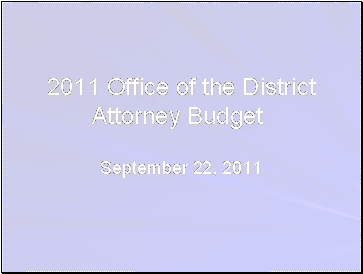 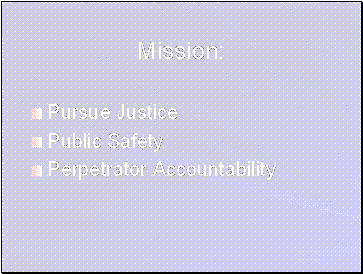
 
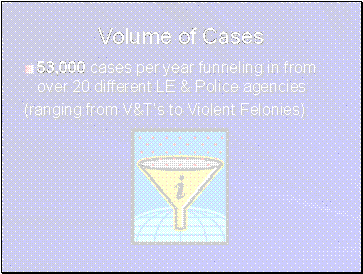 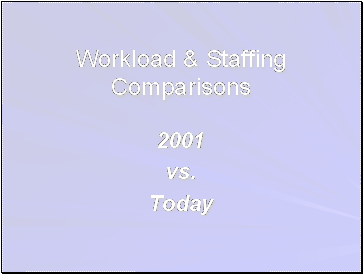
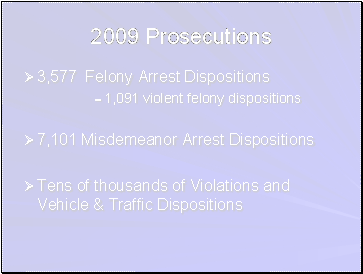 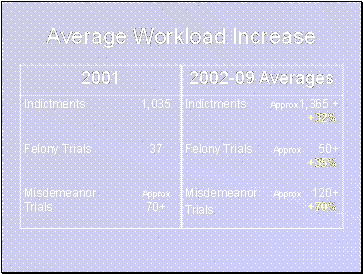
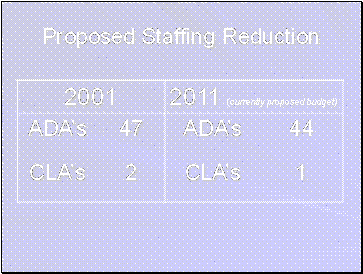 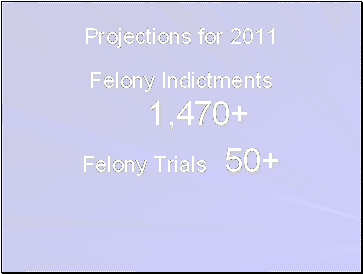
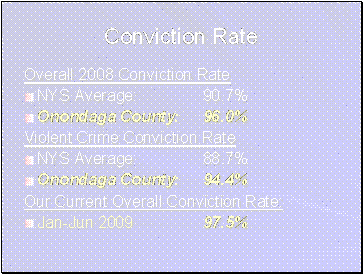 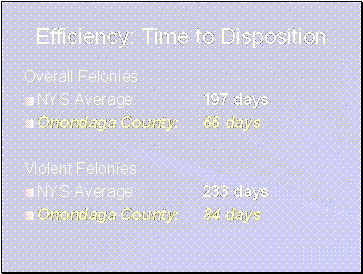
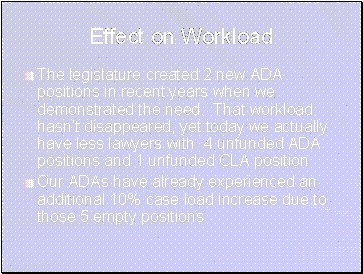 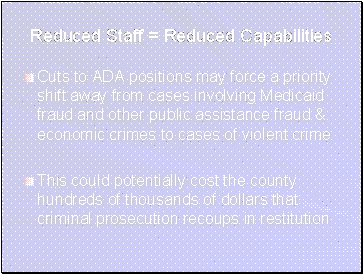
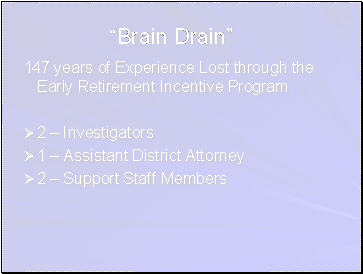 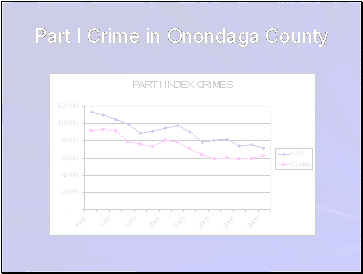
 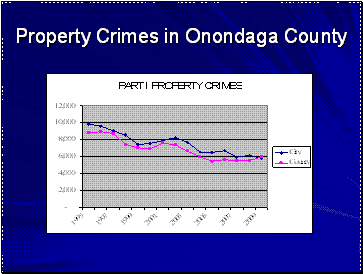
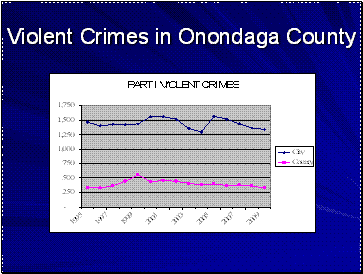 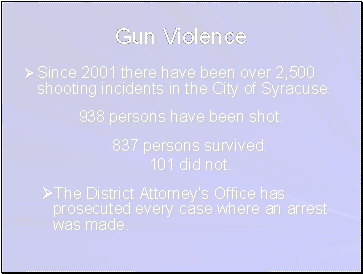
 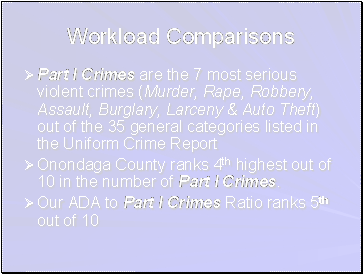
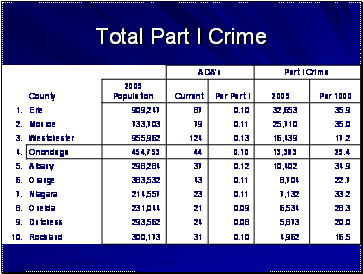 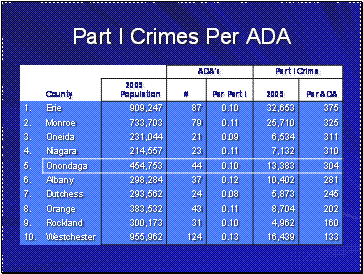
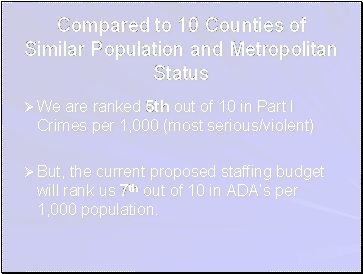 
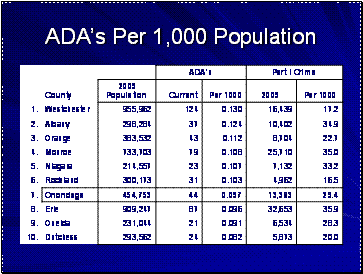 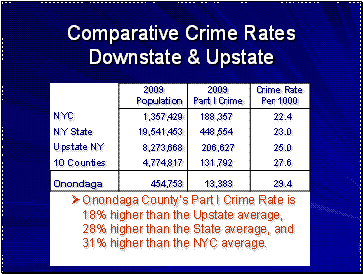
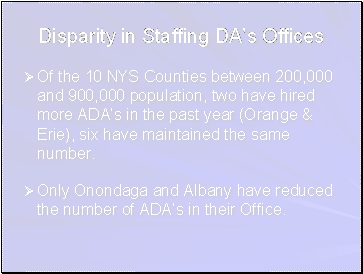 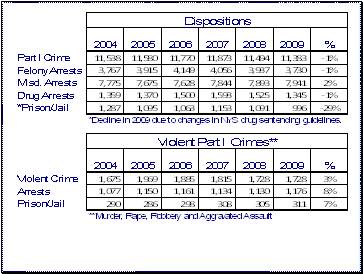
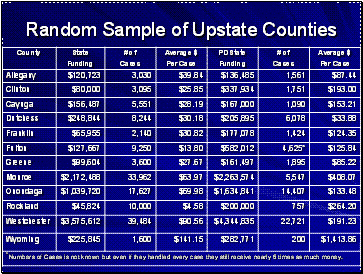 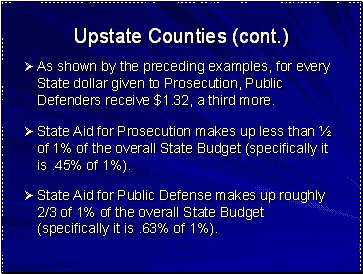
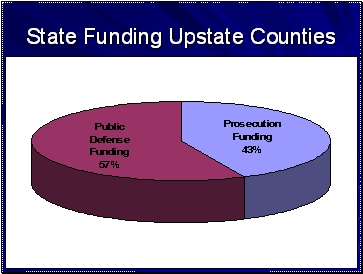 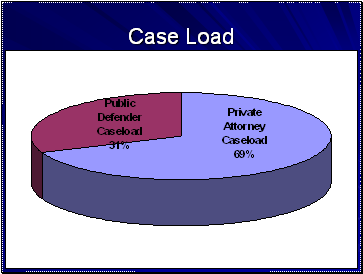
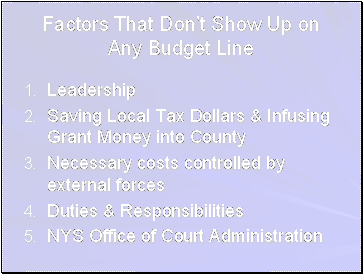 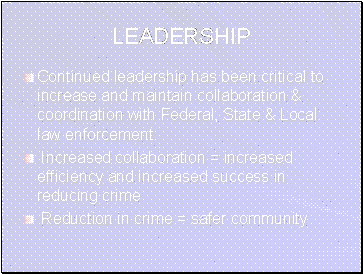
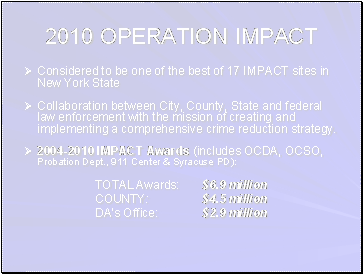 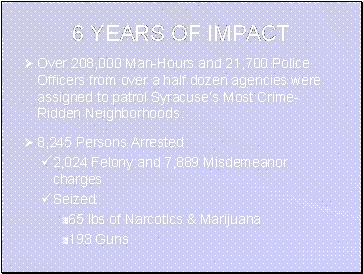
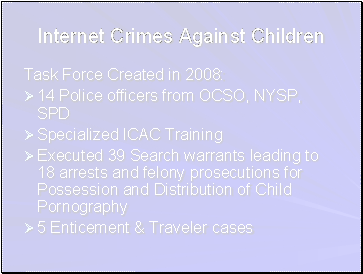 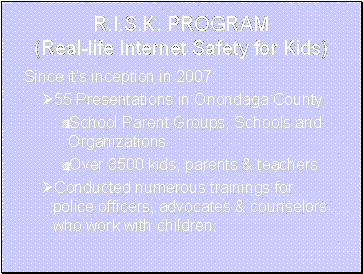
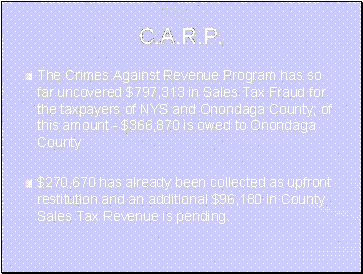 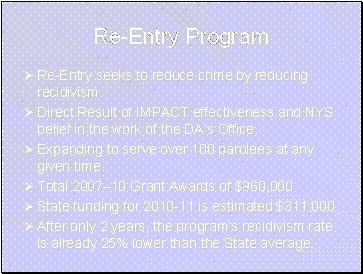
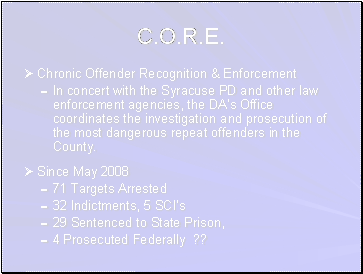 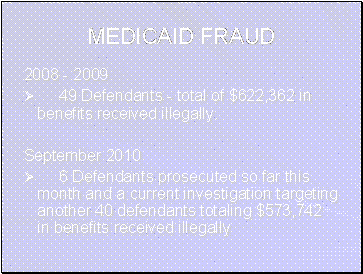
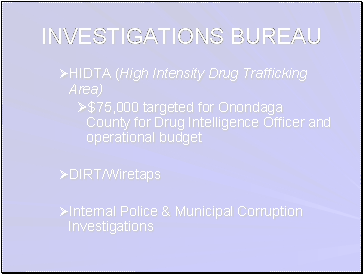 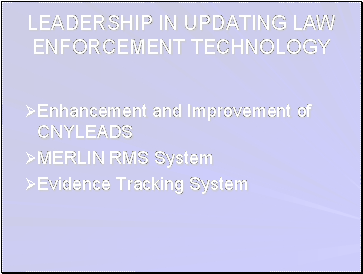
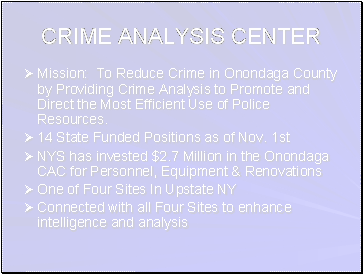 
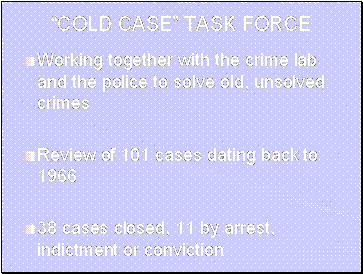 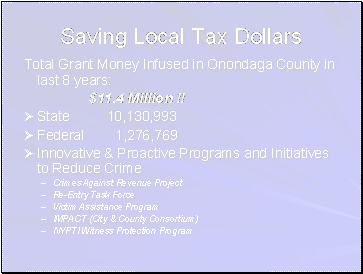
 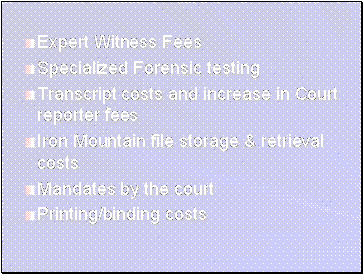
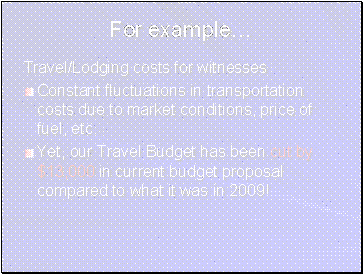 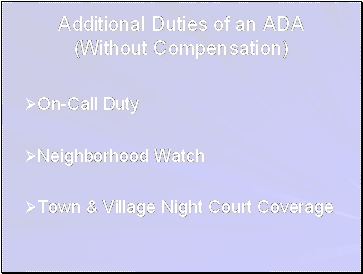
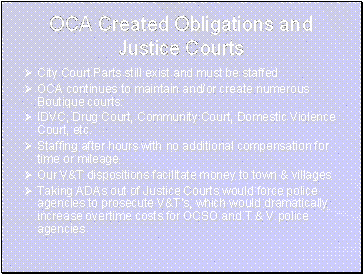 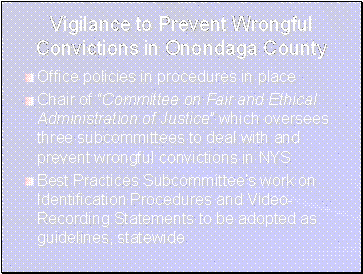
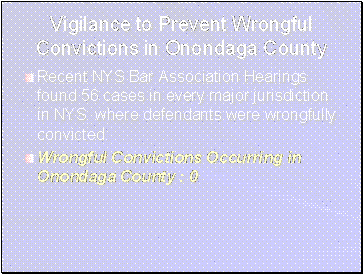
In answer to Chairman Jordan’s questions; Mr. Fitzpatrick noted:
- 5 employees took the ERI – 1 ADA, 2 support staff, 2 investigators; plan to replace them, but not until after the first of the year, resulting in savings to taxpayers
- Salary savings will be over $100,000
- 300 acct – publications include West Law, Nexus, data base charges
- Practice, Advantage software – case management systems – had for 15 years, updates, software, maintenance
In answer to Mr. Lesniak, Mr. Fitzpatrick and Mr. Trunfio answered:
- Not sure how the disparity in reimbursement numbers for assigned counsel/are calculated. The slide presentation shows the disparity on the State level. The result numbers come from DCJS; every DA’s office reports caseload and result to DCJS; it is a set dollar amount per county
- Grant funding 101 – significant drop from 2010; will get worse, State cut Impact budget; grants available are competitive; going to see less and less money through State grants; Onondaga County was the least reduced county for Impact funds
- Medicaid fraud – not duplicating service with DSS – DA’s office works closely with them
- Operation Impact – originally designed under Gov. Pataki and DCJS commissioner as way to reduce the explosion of crime in upstate counties outside of NYC. City of Syracuse was targeted as one of the cities that went through the roof. DCJS asked DA’s office to partner with the Syr. Police Chief. Co-coordination is not the Sheriff; it is the City of Syracuse, Police Chief. Sheriff patrols and Trooper patrols enhance the City patrols. Now barriers between different police agencies is gone; town and village police agencies are now involved
- Frustration with City Court – arraignments; promised for 2 years that there will be a felony arraignment part in City court which would save untold man/women hours and save the taxpayers. Now felonies and misdemeanor are all added together
Mr. Warner noted that the cost of assigned counsel is $74/hour; Mr. Fitzpatrick stated that the average DA makes about $60,000/year. In answer to Mr. Warner, the City has about 1/3 the population of Onondaga County; has about half of the Part I crimes.
Mr. Kilmartin asked for more detail on use and administration of Operation Impact funds:
- A few years ago DCJS made the DA’s office the funnel of Operation Impact money
- Money comes into DA; memorandums are signed with the City and other agencies. City is primary agency. Most of the money goes to equipment, overtime (most details require people working extra shifts)Troopers don’t get any Impact money because they are a State agencyMost money that goes to law enforcement is for overtimeAt some point the 911 commissioner came to the table because they have to coordinate whenever there are details if heavily saturated patrols – they have to put people onProbation – some of the most successful details is having Probation out with cops – a lot of the people they get illegal guns or drugs from are people on probationAll agencies are at the table every year and put in for what they think will be their expenses for that coming yearOperation Impact Executive Committee meets with the heads of the agencies; vote on the budgets before it is submitted to DCJS. A budget is sent to DCJS from the committee, but they do what they want with it. Mr. Kilmartin asked to be provided with a breakout of how the funds are utilized by the departments and agencies. Executive committee: DA, City Police Chief, Sheriff, 911 Commissioner, head of crime lab, NYS Police Major-Troop D, US Attorney’s Office, US Probation, County Probation Commissioner, President of Town and Village Police Chief’s Assoc., underlings of the crime analysis centerSheriff’s Department – most of funds used for overtime of existing deputies, don’t hire bodies to do Operation Impact
- Gross amount gone down for agencies
In answer to Mr. Masterpole, Mr. Fitzpatrick answered the following:
- Cold Case Onondaga County – no specific budget set aside for it; it is part of their duties. They meet on a monthly basis, select a case from an unsolved homicide in Onondaga County; pick one that has some appearance of success. An officer is assigned to present the case; then they brainstorm.
Mr. Masterpole noted that the legislature is facing some tough choices, possibly a lot of cuts and doesn’t know if cold cases are at the top of his priority list. Mr. Fitzpatrick explained that anything that is done to the budget, will not affect the existence and operation of the Cold Case Task Force. His priority is the shooting that occurred last night, not a homicide from 1970, but will not let someone get away from a homicide that occurred in 190 because he is busy today. Mr. Trunfio said that they have 11 indicted or convicted; have found that when they look back, often the person had committed a lot of other crimes in the meantime.
In answer to Mr. Masterpole, Mr. Fitzpatrick stated that by law drug seizure money cannot be included in the budget. The DA received between 15 – 20% of drug money forfeited. His primary use of it is for vehicles. The legislature has not oversight of it; it is audited by the Comptroller and by the Dept. of Justice.
STOP DWI: pg. 3-43, Barry Weiss
The Ignition Interlock took effect in August. DA’s Office and Stop DWI are the monitoring agencies for it. No one really knows what financial and other obligations there will be for this program. Around the state fines have dropped off, but Onondaga County’s has stayed the same, approximately $800,000. There is no anticipated drop off for next year. Last year there was a spike in arrests -- over 250.
Chairman Jordan asked if an increased number of arrests will have an impact on the budget. Mr. Weiss said that it probably will, but because there is a lag of 6-8 months, they probably won’t see it until next year. Mr. Weiss explained that the grant funding to police agencies is based on arrests; the total revenue is divided into one-third: a third to law enforcement, a third to DA, a third to Stop DWI, Probation and Mental Health.
In answer to Mr. Warner, Mr. Weiss said that the defendant pays for the interlocks. The state legislation calls for the interlock companies to pay for a certain percentage of those who cannot afford it. The question is who picks up the difference if they don’t have enough, and it hasn’t been decided. A committee will be reviewing these on a quarterly basis.
Mr. Lesniak referred to the state increasing their surcharges last year and an increased impact to the DWI budget was anticipated. There is not a large impact to this budget and asked if it was due to more arrests. Mr. Weiss indicated that it is and added that it is also because the DA’s office, sticking to the fine, and paying the surcharge. They have been proactive. The interlock cost $100/month--someone may say that they can’t afford both -- the reality is they don’t know if the fines will drop off significantly.
CONTINUED
* * *
WAYS & MEANS REVIEW OF PUBLIC SAFETY COMMITTEE DEPARTMENTS – CONTINUED (2 of 4)
September 22, 2010
ASSIGNED COUNSEL (pg. 4–3, lines 500 and 503) – Rene´ Captor, Executive Director; Fran Walter, President, Board of Directors
Chairman Jordan noted that in the interest of full disclosure, he was formally on the Assigned Counsel program. His partner, Bill Rose, is currently on the Board of Directors of the Assigned Counsel. The Assigned Counsel does a great job, Ms. Captor has a very difficult job. The program provides very good representation for the indigent in our Community. Mr. Walter noted that there is a very active board and they put in many hours on a monthly basis.
Mr. Lesniak asked if Assigned Counsel is lobbying the State to come up with a formula for caseload vs. “here’s is what the county gets.” Ms. Captor replied that it is based on gross dollars spent by each county and divided accordingly. Mr. Lesniak said that the State is assigning dollars on a gross dollar amount, not per case. Onondaga Co. had about 14,000 cases and received $59/case. Rockland Co. had only 750 cases. There is a disparity in numbers in what Onondaga Co. is getting per dollar/per case. Ms. Captor indicated that she is not aware of any lobbing effort to change how the dollars get assigned. Regarding defense funding, the amount allocated by the State government is pretty minimal. Indigent legal services fund was established to assist local governments when the assigned counsel rates increased in 2004. At that point it was jointly administered by the Comptroller’s Office and DCJS. They came up with the formula basically based on dollars spent, and it has remained unchanged. There is an incentive to spend more and a disincentive to economize. Mr. Walter noted that Tompkins County was going to be instrumental on a state wide basis to seek a change in the formula.
In answer to Mr. Lesniak as to how attorneys are assigned to city court, Ms. Captor said that there are attorneys present at arraignments. At the time of arraignment, counsel is assigned by the judge presiding. The attorney’s are actively participating in the arraignment process. Mr. Walter noted that when someone is arraigned at 2:00 a.m. in the morning in a town or village court, they can’t possibly have someone there. Chairman Jordan noted that often times the attorney who is participating is there, and then someone gets arraigned, and the judge asks the attorney to represent the individual. If there isn’t anyone there, the judge has a list of attorney’s accepting assignments and will assign someone off of the list. Mr. Walter said that it becomes a county charge when they are in the Justice Center, the more people they can get out on bail or pretrial release, the less charge it will be to the county.
In answer to Mr. Warner regarding rates for assigned counsel, Ms. Captor said that it is $75/hour for felony or family court, but includes all overhead – office, secretary, attorney benefits, staff benefits and retirement. Of the $75/hour, a fair amount of it goes out the door in overhead expense. The wage is substantially less. Mr. Warner asked if Assigned Counsel is a uniform system statewide, or if some counties set their own regulations. Ms. Captor stated that it is not uniform; each county is required to have a plan in certain specified types of manners. In this county Hiscock Legal Aid is the primary provider for family court.
HISCOCK LEGAL AID SOCIETY, pg. 4-3 (lines 501 and 502), Susan Horn, President/CEO, Anthony Malvenda, Board Chairman
Ms. Horn provided the following:
Addressing two lines in the budget:
501: Legal Aid for Civil Cases
502: Legal Aid for Family Court/Parole/Appeals.
- Line 502: Legal Aid for Family Court/Parole/Appeals
I would like to start out by sharing some good news with you. Yesterday, the Family Court Program of the Hiscock Legal Aid Society received the Light of Hope Award from the CASA Program. CASA is a program of community volunteers who work with children who are in foster care, advocating for them, attending Court with them and providing help and support to them. This was an especially meaningful honor because advocates for children often view attorneys for parents as their adversaries. This award recognized the important role that Hiscock’s attorneys play in making Family Court more effective and helping to keep families together and children safe. We are very proud of that accomplishment.
As most of you know, HLAS took over the work in Family Court and Parole cases in 2004. Since that time, we have developed a reputation for providing excellent services to our clients in those areas. We have put in place systems that allow us to operate efficiently and effectively and to move cases in an expeditious manner. We have also continued our Appeals Program, which has been in place since 1965, handling all criminal and Family Court appeals for the County.
This year, for the first time, we are requesting an additional attorney position for our Family Court Program due to the continuing drastic increases in caseload and the increases in the number of Court parts that must be covered. In 2008 and 2009, we opened just under 2,000 new Family Court cases. Based on the number of cases assigned so far, we are projecting a total of 2,400 cases this year. This constitutes a 70% increase over the estimated caseload of 1,400 per year when we first took over this work. We based our staffing on that estimated caseload. For six years, we have made every effort to handle this heavier caseload with the same number of attorneys. It is simply no longer possible to do that and maintain the quality of representation that our clients deserve, the law requires and the County contracts for. This increased caseload is also complicated by the fact that the Court system has increased the number of Court Attorney Referees and Judicial Hearing Officers assigned to Family Court to assist the Judges in handling this heavy caseload. This means that there are more Court parts operating simultaneously to be covered by the same number of attorneys, resulting in delay.
The budget increase that we have requested would allow us to add that one attorney position, cover projected increases in health insurance costs and provide a very modest COLA salary increase to staff. It is important to point out that because our 2010 allocation was held at the 2009 level while costs increased, we imposed a salary freeze this year. The result has been renewed turnover because our salaries have fallen farther behind both the private sector and the County Attorney’s and District Attorney’s offices. Just to give an example, we recently received the resignation of one of our attorneys who accepted a position with the County Attorney’s office at a salary $5,000 over what she is earning with us. Turnover impacts both the efficiency and effectiveness of the services we can provide.
We appreciate the support we have received from the County Executive and from the Legislature for our Family Court/Appeals/Parole work and we are very grateful for the increase recommended by the County Executive. However that recommended increase is not sufficient to address the issues I have discussed and we ask that you consider amending the County Executive’s budget proposal to provide the funds requested.
- Line 501 Legal Aid for Civil Cases:
The Hiscock Legal Aid Society’s Civil Program has been supported by the County since the 1950s. This is the program that provides critical representation to indigent residents of Onondaga County in housing matters, unemployment cases, domestic relations and other civil legal matters. We represent victims of domestic violence who need protection from that violence, cancer patients who need help with wills, guardianship of their kids and insurance problems, and people facing homelessness due to eviction and foreclosure. We handled over 1,500 such cases in 2008 and over 1,800 cases last year…a 20% increase. This is not surprising since we are what has been referred to as “counter-cyclical”…when the economy goes bad, the need for our services increases while at the same time, the resources to support those services decreases. We are seeing that now. As unemployment rises, more people seek our help to obtain unemployment benefits. As people lose their jobs, more families are in danger of eviction and foreclosure and seek our help to prevent homelessness. Domestic violence rises. Parents have trouble making child support payments.
We have had some success in obtaining grants to assist with some of these needs…for example, last year we received a grant to represent people with subprime mortgages in foreclosure proceedings and that grant was recently extended. Our Parent Success Initiative grant, which allows us to assist non-custodial parents with legal problems that prevent them from getting or keeping jobs and helps them to support their children (and has saved the County money), was renewed after a six-month lapse. Our Cancer Legal Advocacy & Services grant was also renewed and we were just informed that the federal grant for our International Victims Project was just renewed. However, the losses will far outpace those gains. United Way has decreased its funding. Our IOLA grant has decreased because its revenues come from interest on lawyers’ escrow accounts and we all know what has happened to interest rates in the past two years. Grants from NYS have been decreased by as much as 75% this year and a $50,000 member item from Sen Valesky that we received for this year will not continue next year. Last year I talked with you about the loss of a $45,000 grant from the state in 2009 that helped to support our domestic violence work and requested that you continue the funds in 2010 that you generously provided in 2009 to replace that grant. You were not able to do that. I must emphasize that a recent study shows that Civil legal assistance is the single most effective way to end domestic violence. The Hiscock Legal Aid Society continues to be the ONLY agency providing that civil legal representation to victims of domestic violence in Onondaga County.
This year, the County Executive’s proposed budget does provide an increase in our funding. These funds are critical to the safety, security and survival of hundreds of domestic violence victims, primarily women and children, in our community and will directly impact our ability to provide critically needed legal services to victims. However, they are not sufficient to replace the lost funds or to meet the growing need. I ask that you amend the County Executive’s budget to provide the funds requested so that we can continue to help the people in our community who are more in need now than ever.
We thank you for your long-standing support of the programs and services of the Hiscock Legal Aid Society and we want you to know that we do not just come here asking for more funds without actively working to increase our resources wherever we can.
Anthony Malavenda will address HLAS Board of Directors’ efforts to lessen the impact of the funding losses I have discussed.
Mr. Malavenda noted that the board is diverse; there are many attorneys, but also people from all sorts of professions. It is a very active, hard working board. Two years ago the board committed to fund development; hired a director of fund development; made a 3 year commitment, and are on a positive trajectory with it. Donations and membership have gone up dramatically. The funds they raised are almost double the rate that they were a few years ago. Recently a matching grant was obtained, $25,000, which they are working feverishly to match sure they capture all of those funds. Efforts have been successful and will keep going. The success of the organization, in its history, for being very well run, very efficient, helps them tremendously, but in these times it is not enough. The legislature has made solid decisions with respect to Hiscock Legal Aid in the past and hopes they will continue to do so now. The right to representation embedded in the constitution, falls on this body to make sure it happens. The cases are skyrocketing, needs are going up. They are fighting the battles, but need the extra funds that they are asking for.
Chairman Jordan asked about the contractual services for $140,895 – Family Court program. The assistant director answered that it is overhead costs, i.e. rent, insurance, things they have to pay outside of the agency. In answer to Mr. Jordan regarding fundraising, Ms. Horn noted that it all goes to the civil program; the family court program is a mandated program, supported solely by county dollars.
Mr. Lesniak referred to the 3 reasons for the requested increase – health insurance, COLA and new attorney and asked for a breakdown. Ms. Horn said that health insurance cost was estimated an 8% increase, which would be about $40,000 (divided in half for each program). An entry attorney’s salary is $41,000, with benefits it is approximately $50,000. The COLA was 3%. Ms. Horn will provide a detailed breakdown of the 3 categories.
EMERGENCY MANAGEMENT – PG 5 -71, Joe Rinefierd, Director
Mr. Rinefierd said that Mr. Alberti sends his regrets for not being present, as he had a family emergency.
Mr. Rinefierd read the following, which was prepared by Mr. Alberti:
The initiatives in this budget, and the focus of our domestic and disaster preparedness efforts, will be to provide for the safety of our citizens and the continuity of governmental operations at all times. We will also strive to meet the changing guidance and objectives of both the Federal and State grant programs that have allowed us to accomplish much of our planning and preparedness. The departments’ staff of full-time, part-time and volunteer personnel cooperated in strategizing program objectives to meet budget realities. They are all committed to continuing to provide a safe, prepared, disaster-ready and comfortable environment for this county’s residents.
Beginning with the 2010 budget, this department’s strategy of expanding the number of qualified part-time Fire Investigators to address the needs of the Fire Investigation Unit has proven to be very successful. Recognizing the unpredictable nature for the deployment of the FIU, the concept for the operation of the team evolved to provide for more “on-demand” coverage within a twenty four hour period. This has translated into a savings in personnel costs through the use of part time investigators in the field and current administrative/management staff. The 2011 budget will continue to reflect this personnel cost saving while maintaining the exceptional level of service to the county fire departments. Additional personnel costs in the 2011 budget decreased due in part to salary savings produced by keeping a vacant position open, as well the effects of the early retirement incentive.
With the implementation of the Onondaga County Interoperable Communications System and new radio equipment being supplied and on warranty, we are able to save nearly $6000.00 of annual costs in maintenance and usage and rental fees.
Through a series of multi-year grants awarded to us, we will be continuing training and exercise programs for responder forces, in addition to continuing the equipment procurement and planning process. A working group of representatives from local and regional agencies and jurisdictions has been established and works cooperatively to maximize our efforts. The various grant awards made by USDHS and the NYSOHS to Onondaga County and the Syracuse UASI that will result in approximately $2.4 million being available for expenditure during the three year grant period.
Much of the savings in this submittal are based on our continued ability to shift support for many of our programs from the operating budget into the grant program eligible expenses. It must be noted that upon termination of the grant period, this department would endeavor to maintain financial responsibility for those public safety programs and they would again appear in our operating budget. It appears that the Federal funding source for these programs will be renewed, but there is uncertainty of the amount that will be available and what the program will look like in the coming years.
In answer to Chairman Jordan, Mr. Rinefierd noted that one individual took advantage of the ERI, which was the Commissioner. It will be refilled. The $22,000 salary savings is a result of a new commissioner coming in at a lower step, and a receptionist being left vacant. Regarding the 103 line – 6 part time investigators; there is no charge back from the law enforcement or fire agencies. The investigators cover 57 fire departments and 21 police agencies; there is no fringe; they are paid as they work. The City has their own. Regarding training, most of it is handled through the grants budget. The number submitted is for backfilling positions for different agencies throughout the County and City of Syracuse -- travel expenditures are backfilled with overtime. The $13,200 in the regular budget is the training for in-service for employees. Fire investigators have to do a 40 hour in-service, code enforcement officer has to go to annual 40 hr. in-service. The 401 account in the grants covers all of the other grants that come through, police, fire, EMS. Grant funding is specific, if not tailored to weapons of mass destruction or homeland security, then they can’t use it for that. If it is allowable, they roll it in there.
Mr. Kilmartin referred to personnel and asked for any trends/changes in terms of staff over the past few years. Mr. Rinefierd said that in 2003 Fire Control and Emergency Management were combined into one department. At that time the fire coordinator retired, and reduced the staff by one. In 2006 the EMS department was combined with them (out of Health), which reduced EMS related staff by one. Currently have one full time codes officer. Last year they reduced the fulltime fire investigators job down to part time and redistributed that work load among the part time employees. There are 6 part time fire investigators, which are on call – paid when they work. He directs most of the fire department training among 57 agencies, along with being the project manager for the OCICS radio project. There is one administrator in the office that takes care of the budget, orders equipment, manages the office; also is an instructor and takes up the slack during the day for the part time fire investigators. Two positions fully funded by grants, including fringe are a full time planner and a 20-hr week. administrator, Dave Coburn, who takes care of hazardous materials and WMD response equipment. In answer to Mr. Kilmartin, Mr. Rinefierd noted that the 103 people are all fire investigators and have no benefits; they are just paid as they go by the hour up to $24k, then they do it for free. They respond to all major incidents or when requested by the fire chief. Any police department can ask them to respond also. They automatically go to any structure fire. The DA’s office has an assigned district attorney that they work with and work under the auspices of the Sheriff’s Dept.
Regarding grants, total revenue is $1.7 million, Mr. Rinefierd noted that it is the UASI project, which they are the fiduciary for the 3 counties and the City of Syracuse. The state’s grant formulation makes it go up and down. In answer to Mr. Kilmartin, regarding the prospect for grants to offset personnel expenses, which are not presently funded by grants, Mr. Rinefierd said that they hope it will be maintained as it is. It is unlikely that it will go up--more concerned about it going down. It is based on a percentage of the grant money of how much positions can be funded for, vs what the rest of the money can be used for, which is set by the state. The grants typically want the money put into projects, instead of personnel. In answer to Mr. Kilmartin, the grant funding for the planner covers salary and fringe, and the 20 hrs. per week for the administrator.
PROBATION DEPARTMENT, pg. 4-129, Al Giacchi, Commissioner, Patrick Bane, Accountant; Andrew Sicherman, Principal Probation Officer; Phil Galuppi, Principal Probation Officer; Edith Williams, Budget Analyst
Commissioner Giacchi provided the following:
The mission of the Onondaga County Probation Department is to create a safer community by a commitment to long-term public safety and prevention of victimization. Our goal is to change the conditions that brought the offender to the attention of the Criminal or Juvenile Justice System.
To accomplish this, the Probation Department has three core-mandated functions:
- Family Court Intake - which provides diversion from court services in matters regarding Juvenile Delinquents and Persons in Need of Supervision.
- Criminal and Social Investigations and
- Supervision
The supervision of Criminal and Juvenile Justice offenders is the hub of our work.
Our department provides community-based probation supervision with a caseload that is increasingly dangerous, violent and gang-related. We meet with probationers in a variety of settings that include our office, schools, homes, community agencies, and on the streets.
In 2001, we had 120 full-time positions in our department, which was reduced to 103 full-time positions in 2005. In 2010 we are down to 92 full-time positions, which will be even further reduced to 90 in 2011.
Through strenuous efforts to manage the supervision caseload, we have been able to keep the number of cases at the 3500 range over the last decade. However, periodic new state laws, especially for sex offenders and DWI’s, have made this a challenging task.
Throughout the years, we have had to endure continuous cuts in funding from New York State. In 2000, our reimbursement rate was 27.4%. In 2010, we will receive only 15 percent, a 45% reduction in State Aid dollars. It is the belief of probation professionals throughout New York State that State government is working towards not funding probation services at all, and making it a totally local responsibility. An example of this trend is the reduction in the status of the Division of Probation and Correctional Alternatives, our State oversight agency, to the Office of Probation and Correctional Alternatives. This reduction in status resulted in less standing in the power of probation within the Division of Criminal Justice Services.
I am proud to state that despite these various “hits” the staff of our department continues to provide exemplary services to our clients with a primary focus on community safety.
CASELOADS.
We do not have the luxury of setting a cap on caseloads. We are mandated to prepare investigations for all the courts in Onondaga County, to supervise all individuals sentenced to probation by those courts, and to divert as many juvenile cases as possible from Family Court. In addition, we must supervise any cases transferred to us by other counties and other states. Despite staff reductions, we are still required to provide these services.
To do that, we have needed to work more efficiently.
With efficiency as our target we have and will continue to institute changes in our work, including the following:
- We have dissolved our Investigation Unit and assigned those Probation Officers to a second City Team. Now all Probation Officers will do investigations and supervision, not specialize in one or the other. This provides us with several more Probation Officers in an effort to lower the individual supervision caseloads.
- COMPAS is an evidence-based risk assessment tool approved by New York State to determine the risk level of adult probationers. We will begin using that tool at the investigation stage and assign cases for supervision according to the scored level.
- Caseload Explorer is a case management tool that will assist in more efficient processing of the cases within our department and allow for data sharing between us and other NYS probation departments and DCJS.
There are three types of specialized supervision cases (DWI’s, sex offenders, and domestic violence) that for community safety, victim impact, and offender accountability we dedicate a lot of resources to monitor. We try to keep these caseloads at a somewhat reasonable level. The expansion of the investigation team to do supervision should assist us in achieving this goal.
On a cautionary note, we anticipate that the full implementation of the Ignition Interlock Device section of Leandra’s Law will increase the amount of time our Probation Officers will be required to spend on each DWI case to monitor this process. We will assign additional staff to supervise DWI’s.
EARLY RETIREMENT INCENTIVE.
We had ten (10) individuals opt to take the Early Retirement Incentive. They run the full gamut from support staff to administration. In order to meet our department’s retirement goal, we will not fill two (2) of the Probation Officer positions. Further savings will be generated by reducing one clerical position to a lower title and hiring our Information Technology Specialist back part-time instead of filling that position full-time. The difference between a starting PO’s salary and a veteran PO’s salary will add to our Early Retirement Incentive savings.
OUTSOURCING.
All of the services our department provides to the community, except one, are State-mandated. The one exception is Pre-Trial Release. In some other counties, Pre-Trial Release is contracted to a private agency to operate.
In an effort to lower long-term costs to the County, we will RFP this service to determine the interest of other community agencies to provide it to the courts. Our budget contemplates this will be done during the course of 2011 working with our union partners to attain this goal.
ACCOMPLISHMENTS – 2010.
The loss of thirteen (13) positions, including a Supervisor and Deputy Commissioner, in this year’s budget reduced our staffing to the bare bones from the clerical level to the administration level. Despite this loss, we have maintained our reputation of offering excellent service to the community and our clients.
During 2010 we have continued our active participation in numerous partnerships including:
- Operation Impact: The Probation/Parole/Police home visit details are considered one of the most productive efforts for this project. The home visits and subsequent searches have resulted in the confiscation of large quantities of drugs, money, and handguns.
- Community Details: Our department continued to provide services to various community groups during special events, such as Mary Nelson’s Back-to-School/ Stop the Violence Barbeque, the Valley Field Days, the Solvay Field Days, and Juneteenth.
- System of Care: We are a major partner in this federally funded grant with other County departments, community agencies, and citizens.
- GED: We are in the tenth year of our partnership with the Syracuse City School District to provide an in-house GED program. This has been an extremely powerful and productive program.
- Project RESPECT (Juveniles) and Project RESTORE (Young Adults): We continue our partnership with New Justice Services to provide pro-social programming for these targeted groups.
- In-House Employment Program: We have two (2) staff trained as Employment Specialists to provide an in-house employment program for our probationers. We have already offered three (3) sessions of this program to our probationers in 2010. Twenty-eight (28) individuals completed the program with ten (10) individuals being currently employed.
- Due to budget cuts within the Onondaga County Sheriff’s Department, we have taken on the added responsibility of arresting any probationers who report to our office with an active Violation Of Probation warrant. This includes handcuffing, searching, and transporting the individual to the Justice Center, as well as completing the required paperwork. Like our Active Shooter team, we have accomplished this using volunteers and without increasing our budget.
- Active Shooter Training: To enhance the security of the OnCenter Complex, thirteen (13) of our staff volunteered to be trained by the Onondaga County Sheriff’s Department to respond to an active shooter incident. There will be continuous training for this group.
GOALS – 2011.
While certainly being a challenging time, 2011 will also provide us with the opportunity to discover new and more efficient ways to provide probation services in Onondaga County.
To that end, the following issues will be addressed during the year:
- Continue to institute best practices for adult supervision, as we have done with juveniles, to rehabilitate offenders and to protect the community.
- To address issues resulting from Leandra’s Law.
- To explore the expanded use of technology in our every day work, including the possible electronic transfer of information to courts.
- Continue to partner with other agencies and departments through the System of Care Grant to provide more efficient and productive services to the community.
- To continue to work with the New York State Office of Probation and Correctional Alternatives to reduce various mandates on local probation departments. Principal Probation Officer Andrew Sicherman and I are members of a statewide work group reviewing the Probation Supervision Rule which governs how we supervise our probationers.
THANK YOU. We appreciate the continued support of the County Executive’s office and the County Legislature as we address difficult issues in difficult times.
I especially want to thank my dedicated staff for the excellent professional work they continue to provide to the citizens of Onondaga County.
In answer to Chairman Jordan, Mr. Giacchi and Mr. Sicherman noted the following:
- 10 employees participated in ERI – an administrator (Hillbrook), supervisor, 5 probation officers, Steno III, IT specialists, and one principal probation officer. Hope to refill 7 – going to reduce title from steno II to typist II; want to hire back IT specialists on part-time basis, and fill 4 probation officers
- Line 408 – Caseload Explorer – case management tool used to keep track of cases, contacts, essentially a large, web-based, data base. Purchased through NYS Division of Probation - Correctional Alternatives; all probation depts. in the state will be using the system to be able to communicate; will allow for sharing of data. It has been phased in over several years; started with smaller counties within the state. The $20,000 expense is for licensing – individual licenses for each probation officer; required to pay for it; in previous years it was paid out of a Byrne grant from the State. There is approximately $10K-$12K left in the grant; will need to purchase some hardware, possibly some software. Mr. Sicherman will provide a specific number - balance of the grant.
- Line 410 – bank management charges - $4,500– fee for accepting credit card payments – discount paid to banks. Accept credit cards for monthly probation fees and restitution from probationers.
- Line 413 – lease of 50 personal computers with 17” lcd monitors - $15,482 – a decision was made several years ago that it was cheaper to lease than to purchase. They do purchase laptops. The leases are annual.
- Laptops were added a couple of years ago – increased efficiency with probation staff working in the field. Laptops are equipped with an air card. Previously there was no way an employee working in the field could correctly enter data into histories, tracking content. It allows them to access CHAIRS to check for active warrants while probation officers are working in the field. It is also a safety issue – gives them access to all caseload information, email, everything that they could normally get at their desk. They have docking stations so they serve as their computer in the office and can unplug them and take in the field.
- Line 570 – contract services – Central New York Services - reimbursed by the State at 50%; prison program paid to the Salvation Army and reimbursed through DSS to Probation at 100%, DSS is reimbursed through the State at 63%.
- J-RSC Liberty Resources – money received from State and passed onto them – the program allows juvenile delinquent or youths in the county that have been identified as PINS to participate in a counseling service in the offenders or youth’s home. It engages all members of the family.
Ms. Rooney said that the contracts being discussed are all part of the juvenile justice reform, which has allowed significant reduction in the cost of juveniles in placement; 63% of it is reimbursed from the State to DSS.
Ms. Rooney explained that Jackie DeNero, retired, former Director of Hillbrook, is reflected in the Probation Dept. budget. There is a savings in the Hillbrook budget because they have eliminated the Assistant Director title.
HILLBROOK, pg. 4 – 140
James Czarniak, Director of Juvenile Justice Detention Center, Patrick Bain, Edith Williams
Thank you very much for the opportunity to present Hillbrook’s budget today. For those of you who I have not met, my name is James Czarniak the Director of Juvenile Justice for the County. I replaced Jackie DeNero who held this position for the past eight (8) years and am very excited to work with all of you in the coming years. My appearance before you today is representative of the restructuring and change you will see presented in our budget today.
Hillbrook’s mission is to provide immediate public safety to the community, detaining high-risk adolescents following an arrest. Our goal is to ensure that youth who are in detention, and their families, receive quality services to support a successful return home. We strive to do this in the most cost effective manner. Hillbrook’s budget includes our facility on Velasko Rd. and a contracted non-secure detention program run by Hillside Children’s Center. (SLIDE 1)
Last year, Hillbrook worked with the Legislature on some major restructuring of the Agency and we are proud that during such challenging times we were able to work closely with the staff at Hillbrook, the County Executive’s Office, the Public Safety Committee and the Legislature to meet our requirements for 2010 while projecting to meet our budget goal for the year as well. As I will discuss in detail, Hillbrook is presenting a budget this year that continues the spirit of maintaining a high level of service while being as cost effective and efficient as possible.
Hillbrook is presenting a total appropriation of $4.5 million for 2011. Revenue is projected to be $2.8 million, resulting in a local share of $1.7 million. New York State currently reimburses the County 49% of all costs associated with detention services. The major highlights of this budget consist of 4 major areas: The Restructuring of the Administration Team at Hillbrook; the Impact of the Early Retirement Incentive (ERI); the Elimination and Restructuring of the Child Care, Maintenance, Medical and Social Work Departments; and the Reduction of our Non-Secure Contract. (SLIDE 2)
First, with the retirement of the Director of Juvenile Justice in August, the County Executive’s Office worked closely with us in looking at possible efficiencies in overhead costs at the Detention Center. Having eliminated one of the FT Assistant Director positions in last year’s budget, much of the work had already begun transitioning and it was decided that a change could and should be made. In this vein, the Assistant Director position I previously held has been left vacant and scheduled for elimination in this budget. While eliminating the position, it was important, however, that there be sufficient administrative staffing to accommodate the 24 hour facility’s needs. The Administrative Assistant position was upgraded to an Administration Director position in order to handle some of the duties of the eliminated Assistant Director title. With this transition, the administration of the facility, which was at 4 FTE’s in 2009, will be at 2 FTE’s in 2011. (SLIDE 4)
Secondly, the Early Retirement Incentive program was offered to 11 Hillbrook staff, and six employees have since retired. This incentive also allowed us to look at several opportunities for restructuring. As you can see, in addition to the restructuring of the administration of Hillbrook, our ERI savings goal was accomplished through the downgrade of one title, and the restructuring of the Social Work Department. In addition, while we had to re-fill one other FT position for public safety reasons, the new employee starts at a lower rate of pay providing a small savings for 2011. (SLIDE 6 and SLIDE 7)
The other major areas of restructuring for the 2011 budget are in the maintenance, medical, and child care sections. Earlier this year, Hillbrook presented to the Public Safety Committee and the Legislature a proposal to un-fund the Agency’s Custodian I position and move those funds to hire a private company to perform the Agency’s cleaning needs. Having gone through the RFP process, it was determined that we would pilot the program the rest of this year to analyze the performance of the company. We are extremely impressed with the contractor and the work quality and have included them in our 2011 budget and request that the Custodian Position remains unfilled.
In addition to the change in Maintenance, Hillbrook is also a part of the Correctional Health RFP. The level of service will be maintained and additional supports including the oversight of a medical director will be included. This transition will allow for the elimination of our two full time nurse positions.
The culmination of this restructuring, along with the impact of the Early Retirement Incentive, will result in a 51 % reduction in full-time staff in 2011 as compared to 2008. This staffing reduction brings our costs more in line with the numbers of youth we serve annually, while allowing us to maintain a high level of service and a high level of dedication to the continued Juvenile Justice Reform efforts that make these continued savings possible. (SLIDE 9)
As part of your packet, I have enclosed a copy of a synopsis of the Juvenile Detention Reform efforts that have taken place in the County over the past decade. Through the hard work of Probation and its diversion emphasis, we continue to see trends that show decreasing numbers in Onondaga County for secure and non-secure detention. It is because of our continued commitment to this effort that we are able to present our final cost savings area for the 2011 budget, in our contracted services line. Due to continued success with detention reform, we will be reducing our 2011 non-secure contract by another bed at a savings of more than $118,000 for 2011. With other minor contracted adjustments this line, we have reduced our contracted services line buy more than $125,000. (SLIDE 11)
With all of this transition, it is important to note that Hillbrook’s budget does show increased cost in its 103 line, which is our Part-Time staffing at Hillbrook, and the 410 line which is where we pay for our cleaning contract as discussed previously. These increases are more than offset by the transition and restructuring savings listed above and will assist us in meeting our OT budget goal. (SLIDE 13)
Overall, I am proud to present this budget to you because I think it continues our commitment to think differently about how we do business. We look at restructuring and change as positives, while maintaining a very important public safety responsibility that keeps our community safe and at the same time supports parents and youth in their success. Thank you for the opportunity to present the 2011 Hillbrook budget. I look forward to working with all of you.
 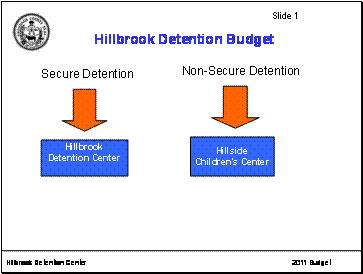
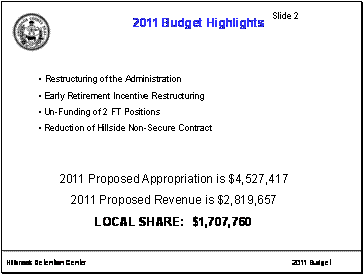 
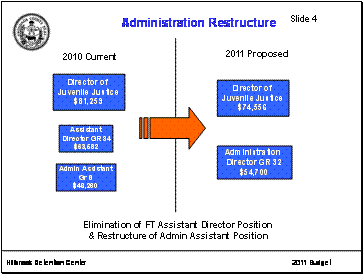 
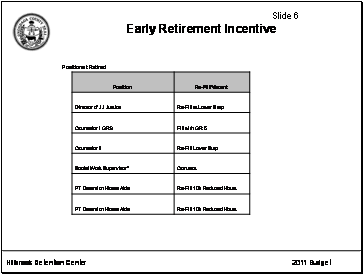 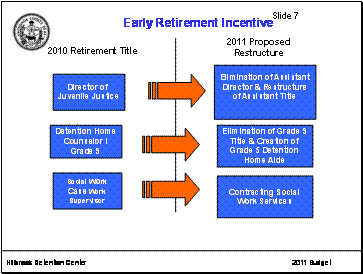
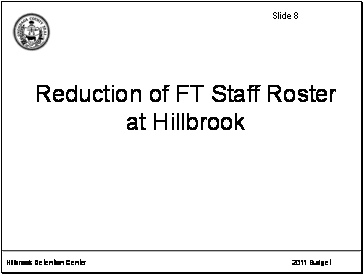 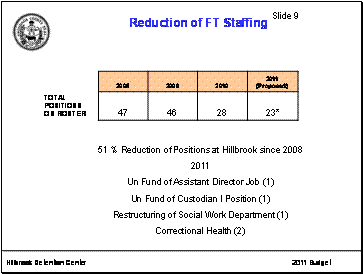
 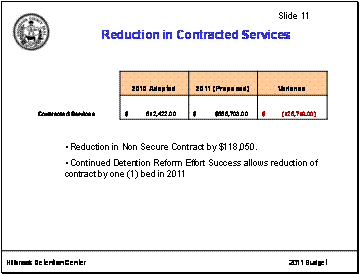
 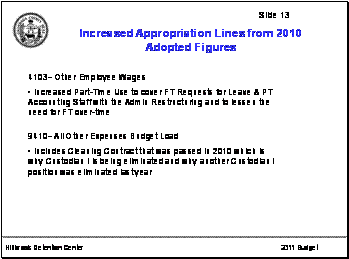
In answer to Chairman Jordan, Mr. Czarniak answered the following:
- 6 people retired; eliminating 1 administrative assistant, will be contracting a social worker, Counsel II position was refilled; 2 other part time positions that retired had hours cut in half
- Budget reflects 16 youths (11 in county; 5 out of county); get 49% reimbursement from in-county youth that go to the facility; 100% reimbursement from out of county (state 49% and county 51%)Average population is 14; revenue calculation is based on a percentage of who is in your building. Line 408 – doctors and psychiatric fees cut in half this year due the RFP for correctional healthIncipient Detection System – a pre-fire detection system located in residents’ rooms – provides an additional 10 – 15 seconds of determining if there is a fire for response time
- 408 – doctors fees & psychiatric fees increased; COLA adjustments for nurses and psychological evaluation svcs.
In answer to Mr. Warner, Ms. Williams stated that it costs $282,000 per youth. He questioned the cost of keeping the kids here vs. the cost of taking them to another close facility. Mr. Czarniak noted that they do about 210 admissions per year and they stay at varying lengths of time. The facilities that they could be sent to have the same per diem; they are dealing with the same issues. Erie County has 64-bed facility with tons of overhead, which is where they would have to be sent because the other facility do not have room to accommodate. The Sheriff’s transportation cost would be an increase of about $600,000 or more, going from a 16 mile trip to Hillbrook to a several hundred mile trip to Erie – have to send the kids there, get them to court, come back, if the judge says that they go back to detention, then they transport them back to Erie. It would be an expensive process. Also there is a bonding issue on the Hillbrook facility that currently gets reimbursed. If the facility were to close, the State might not reimburse the County 49%. Mr. Warner asked if Erie is the only facility available. Mr. Czarniak said that Albany is at capacity and sending their kids to us. Rochester is also at capacity. Rochester is starting their juvenile reform efforts now because they are sending far too many kids to placement. There would need to be a facility with guaranteed beds, so when the judge says “security detention”, it can be accommodated, which would have to be Erie County. The only other options are downstate and NYC.
In answer to Mr. Warner, Ms. Williams said it cost $651 per day, per kid. Mr. Bane pointed out that after the state aid is received, it is the $325 per kid, per day.
Mr. Lesniak asked what the cost per day would be to house at Erie. Mr. Czarniak said that it would be Erie’s per diem, which he does not have. Our per diem is $651; it could be the same as ours. The State reimburses back to Onondaga County 49%.
Mr. Lesniak asked for clarification on reduction of positions. Ms. Williams comments were inaudible. Mr. Czarniak said that they have unfunded a detention home counselor 1, grade 9 @ $47,000. It has been converted to a detention home aide, a grade 5 @ $34,000; provides a $16,000 savings. The unfunded positions are: casework supervisor (will be contractual); unfunding detention home counselor 1, custodian, and assistant director. Mr. Lesniak noted that the page in the budget is incorrect. Mr. Corbett asked that a new sheet be provided.
In answer to Chairman Jordan, Ms. Williams explained that the social worker retired, was going to come back on a part time basis on the 101, she was funded at $30,000. Subsequent to that, it was determined that they would take her off the payroll entirely by contracting out the service. In the 101 account there is $30,000 for social work services, previous to that, it was $56,000.
Mr. Lesniak noted that the overtime line should drop if the 103’s are used to cover the overtime, but it is not reflected in the overtime line in the budget. Mr. Czarniak said that the goal is to decrease the overtime by utilizing the part time 103s. Part of the 102 line includes an accounting person, who is helping with the administrative transition. With functioning going from 4 FTEs in administration down to 2, a little bit more clerical support is needed, approximately $22,000.
Mr. Corbett asked if when the renovations were done, did it lock us into the 49%. Mr. Czarniak said that it is a state law, OCFS reimbursement for all detention services across the state. Doing the bond on the building locked us into it, getting the 49% into the budget on an annual basis. Mr. Corbett asked if it were all outsourced, mothballed, or used for another purpose, would the portion from the State be lost. Mr. Czarniak said that it is something that would have to be discussed with the State. It would be at risk. Ms. Rooney said that the County would lose that reimbursement. In answer to Mr. Corbett, Mr. Czarniak said that they have 32 beds. They would be able to have the same number of staff; the current staff is based on reform. In answer to Mr. Corbett, Mr. Czarniak said that they do take kids in from other counties. Juvenile detention reform is a statewide initiative. Erie County is also doing it. Albany and Monroe are just starting it. Mr. Corbett noted that a selling point of bonding for the renovations was that those beds would be used. He understands the efforts of reform, but there will be certain populous that will have to be detained. Ms. Rooney said that there has been a concerted effort to market to other counties. If we were to get a tremendous demand for the other beds, they would open the other 16 units, but they are responding to last year’s budget with reductions to Hillbrook. Right now they are running about 30% of out of county kids – tremendous marketing is being done with the other counties to let them know that there are beds available.
Mr. Rowley clarified page 4-132: unfund assistant director, abolished admin. assistant, unfund 1 detention home counselor, unfund maintenance worker. Created admin officer; created an additional detention home aide. Net is down 2 funded positions.
Mr. Troiano noted that there are a number of initiatives presented by departments regarding outsourcing. It is important to know that they may require the discharge of bargaining obligation with the labor organizations that represent some of the employees. In doing that, some departments have asked to maintain the funding for half a year in order to proceed in that manner. If there are not agreements on some of these things, the Taylor Law requires us to engage in mediation and fact finding. If the dispute still exists, it is presented to the legislature for determination over the dispute. The time line may take enough time where it is necessary to fund it for half a year and then if the decision is to proceed with the outsourcing initiative then it goes forward.
The meeting was adjourned at 12:10 p.m.
Respectfully submitted,
DEBORAH L. MATURO, Clerk
Onondaga County Legislature
* * *
WAYS AND MEANS REVIEW OF PUBLIC SAFETY COMMITTEE continued (3 of 4)
SEPTEMBER 22, 2010
CHAIRMAN CASEY JORDAN
MEMBERS PRESENT: Mr. Corbett, Mr. Lesniak, Mr. Holmquist, Mr. Kilmartin, Mr. Warner, *Mr. Stanczyk
MEMBERS ABSENT: Mr. Kinne, Mr. Buckel
ALSO PRESENT: Mr. Meyer, Mrs. Tassone, Ms. Williams, Mrs. Ervin, Mr. Masterpole, Mr. DeMore,
Mrs. Rapp, Mr. Dougherty, Chairman Rhinehart, Mr. Laguzza, Mrs. Ervin
Chairman Jordan called the meeting to order at 1:30 p.m.
CORRECTION, pg. 4-109 – Timothy Cowin, Commissioner; Tina Dalfo; Accountant; Randy Blume; Assistant Commissioner; Chris Gully, Budget Analyst
Commissioner Cowin provided the following:
2011 will continue to be a very difficult year, as we maintain mandated levels of service with less human and capital resources. Since 1990 we have shown a 40% reduction in staff while our inmate population has increased by over 50%. Eliminating four additional positions as a result of the 2010 budget process, including not filling the position of Assistant Commissioner for Management and Administration has reduced our staffing level to its current level of 193. One additional Correction Officer position will be eliminated for 2011.
Personnel Level Trends

One of our biggest challenges for 2011 will be the unknown factor - our inmate population. During 2010, inmate population levels have remained above projections for nearly the entire year.
Inmate Daily Population Levels

As depicted in the graph above, inmate population continues upward. The department’s inmate average daily population (ADP), both sentenced and unsentenced in 2009 was 421 with a daily high of 479, resulting from 2,164 admissions to the facility during the year. For 2010, our daily average is 490 with a daily high of 529 and 1,688 admissions year-to-date. Our current population is at 500. We have no reason to believe that this will diminish as 2010 comes to a close and we begin 2011. These increases put additional stress on our budget and our staff.
While the issues of our budget are similar every year, two areas that are usually of the most concern are the 101 & 102 lines. As previously stated, we are eliminating a position for 2011 from our 101 line. In 2010, we had an unusual number of inmates in the hospital, or on one-on-ones, which has a direct effect on our overtime. We are anticipating that line to be about $75,000 over our budgeted amount. However, some of this is directly related to our Federal inmates and is reimbursed. We expect the US Marshall’s will reimburse us about $60,000, which goes to the General Fund, but really effects our overtime bottom-line and brings us close to our budgeted amount. In 2011, our 102 line is $776,534 which reflects a 3.25% increase equal to the contractual wage increase. Even with the yearly contractual wage increases we are substantially down from where our overtime was in 2007 and 2008, over a million dollars. This despite our increased population and reduced staffing levels.
Overtime (102)
Cost-Savings Exploration and Initiatives
After extensive consideration and planning, the Department of Correction revised control center operations by enhancing our mechanical control panels with computer touch screens. This has significantly reduced “down-time” due to consistently failing mechanical buttons, and has reduced the need to man our Rear Control Center during the midnight shift each day. These functions have been integrated into our Main Control Center panel on the midnight shift, allowing the staff member normally assigned to the Rear Control post to be eliminated. Additionally, we have installed card swipe readers at doors in and around this area to allow staff to travel between other points in the facility without interruption.
As another cost cutting move we have looked at our entire operation to see if areas could be outsourced to save money. The first area we looked at in conjunction with the Onondaga County Health Department and Sheriff’s Office, was the privatization of inmate health services. We expect the level of service to continue and actually improve as we will have medical staff available 24/7 onsite, potentially reducing unnecessary hospital trips during the overnight hours when, as is currently the case, there is no medical staff on duty.
We also reviewed the food service operations of this facility and the Justice Center. We put out a Request for Proposals, and a comprehensive review of responses is still underway. However, after initial review, we are estimating a significant annual savings. The savings will be seen in our 300 (Supplies) line and the 101 and 102 lines.
Also as a result of a Request For Proposals, the Department is reviewing inmate laundry, a duty that has been a part of this operation for over 100 years. While there will be a cost for a vendor to supply this service, we believe that will be easily offset by salary savings, a drop in our supply line, along with reductions in equipment and equipment repairs. There also could be a significant reduction in energy costs.
We now send out inmate work crews – road crews or park crews – road crews only when it does not incur overtime. During 2009, these crews performed 2,188 hours of work and retrieved 513 bags of garbage. For 2010, we have performed 3,096 hours of work and picked up 246 bags of garbage to date.
We have eliminated the on-site satellite library for inmate use, which up until summer of 2010 was funded by the Onondaga County Public Library and BOCES. Through an initiative of retrieving books from the library and OCRRA, we now provide moving carts of books for the inmate population. This has resulted in savings to the County budget by not filling a library clerk position to manage this operation, and reduces inmate movements, which is always good for security.
We have adjusted our programming schedule so that on the evening shift, we will only require security two nights a week instead of five.
Through extensive collaborative efforts with the Department of Emergency Management, the Department of Correction was able to move onto the Onondaga County Interoperable Communication System over 10 months ahead of our original scheduled date. We were also able to secure a total of thirty-seven new portable radios through a mix of a Federal grant program and by revamping and justifying our original allotment of new portable radios. This new communication system has, in the short time we’ve been a part of it, proven to be an incredibly useful and reliable tool.
Through an inter-municipal project with the Town of DeWitt, the Department deactivated our 80+ year old 150,000 gallon water tower in spring of 2010. The elevated water tower was in dire need of very costly rehabilitation for continued use. The department is now on DeWitt’s public water system and has also eliminated the need to keep a boiler operating at the base of the old water tower to keep the water from freezing in the tank during winter months.
Our inmate programs corridor continues to be a busy area. We provide a variety of programs to inmates with little local money. A few examples are:
BOCES - GED testing
GED tutoring
Transition
Computer program
PEACE Inc. - Early Head Start (works with parenting skills and issues)
CCA (Center for Substance Abuse
Community Alternatives) - Re-entry
HIV/AIDS counseling
AA & NA - Alcohol and drug rehabilitation
Law library
We continue to work closely with the U.S. Marshall and his staff to insure we keep our federal inmate daily population as high as possible. The good news in our budget is that we continue to house federal inmates. These numbers may decrease some in the next year but we have no way of assessing an exact number. In 2010, we budgeted for 50 inmates per day and have surpassed that with projected revenue of $2,656,287. For 2011, we project our revenue at $2,244,750 based on 60 federal inmates a day.
While this certainly does not cover every aspect of the Correction budget, it does cover the areas that may be of the most concern. With continued effective management processes and shifts in our programming and operations, the Department of Correction will continue to fulfill its mission of operating a safe and secure facility, in the most cost effective means possible.
In answer to Chairman Jordan, Commissioner Cowin noted the following:
- Four employees took advantage of ERI; 3 will be replaced. Regarding the corrections officers – only have classes twice per year so there is a savings, as the positions cannot be filled until the next class; additionally they will start at a lower salary. The correction officer positions are mandated by the state and tell them what the staff has to be. The Corrections counselor will be filled; there is no current list; will wait for the list and then hire full time. The counselor staff has already been cut significantly over the last couple of years – down to a bare bones counselor staff
- 102 line – $168,000 for security roll call: there is a 15 minute period between shifts where there is roll call and one shift relieves another – it is all overtime. There is a contractual obligation; there has to be some overlap where there is discussion of where they are going to work.
- Privatizing food service – put out to bid; have some bids back now and are reviewing them. Some vendors have looked at it. It looks like there could be significant savings, possibly $500,000. Staff has also come up with ideas that may save money.
- 413 line – majority of it is utilities – the number is supplied by Facilities Management. There are 12 buildings there. It also includes contracts: radio maintenance, door lock systems, camera systems, copier rental
In answer to Mr. Lesniak, Commissioner Cowin noted:
- $500,000 savings for privatizing food service is not showing in the budget at this point – if it goes through there will be additional savings in 2011
- Current food services employees – all would be removed from the roster except the food service managerOne on one – discussions with State to try to alleviate it by doing one on two for constant watch. The Commission allows them to do a one on two as long as there is sight to where the two inmates are locked. It is being done now. There is discussion to expand that, but it is almost impossible with any set up at Jamesville where there could be sight of four different inmates at any one cell. There has been discussion about building cells with Plexiglas. Federal prisoners – Correction has had them since mid 80s. Today is the highest population they have had in the years the commissioner has been there (11 years). The gym is open, and it is not listed as a housing unit. At the point a decision has to be made to do something - close the gym and throw the federal prisons out of there (loss of $750k - $1 million revenue). Sheriff’s has a couple federal inmates on a day to day basis. Population – every morning they are on the phone with downtown talking about how many beds they each have; today downtown shipped 15 probationers to Jamesville because they didn’t have room for them, which is why the gym was opened. Gym has been opened in the past a few times, but it was for the weekenders only.
- Population numbers have been high all year consistently, well over what was projected. Most trends have gone away.
Mr. Kilmartin asked if an internal analysis has done to try to project an apples to apples comparison for inmate health services and for food services vs. what is expected to be received back from RFPs. Mr. Cowin stated that they have done it with the food service; have the documentation and know exactly to the penny what is spent. They do 1.2 million meals per year. It is easy to compare what the savings are. The health services is a little different, and not under his budget. He looks more at what services they would get in the new contract. It looks like they will be getting more than in the current health system. He has spoken to other counties about the vendor that is being talked about, and the other counties rave about the vendor. Regarding laundry services, Lazy Bones was the low bidder; it will be approximately a $9,000 savings. It does not include the savings to cost of replacing laundry equipment, which is in the capital projects. The laundry could be implemented before the end of the year.
In answer to Mr. Warner, Mr. Cowin said that the federal government pays for all medical costs associated with their inmates. There is a small difference with the overtime – have a set rate, which is a little lower than ours.
Mr. Corbett noted that there are certain consolidations that still contractually have to go on. Some departments have built the savings into their budgets - he doesn’t know how that can be done when it is not sure what will happen. Mr. Cowin noted that the health services are built in, but that is not in his budget. He has the food service and laundry; there is no outside contract that does it; Correction’s employees do it. There is an issue with employees and CSEA. He is sure it will go to impasse and it may not get resolved for several months. Mr. Corbett said we try to buy local and use the people we have here. The employees are paying their taxes here, buying their groceries here, etc. Some of the vendors that now give service are all local vendors. Sometimes low bidder is not the best bidder – hopes that some thought has been put into what the total impact is. This is saving money on a local line, but questioned how it would impact the services and the people that live here. They will not be able to take advantage of a more robust Onondaga County, which they also pay taxes to. Mr. Cowin said that the food service is a good example of that; some of the local vendors have called and are concerned. Correction has a good food service program and it works well, the employees are good. If it were a close bid, they would be talking about staying just the way they are. When the bid came in where it did with several hundred thousand savings, it makes it difficult to have that argument. The food would be prepared in the same kitchens as it is now.
Mr. Rowley said that there are competitive sourcing in some departments’ budgets and they aren’t seen in others. The driver is part of the ERI. In order to make the bogey of 50% salary savings, some departments had to put it in. They tried to be judicious in how it was done – correctional health being a good example. They put it in on a cost neutral basis because of the requirement to solicit RFPs, get responses, etc. They didn’t want to taint that process as well as the labor negotiations that have to take place – tried to be careful in that regard. Mr. Corbett asked if there is a master plan for the 50% savings across the county – some departments are proudly stating that they can do it and others are saying that there isn’t any way that they can do it. Mr. Rowley said that they have made up competitive sourcing in other departments for those that couldn’t make their bogey. They are diligently working on a master report to share with the Legislature. Mr. Lesniak asked for list of all of the competitive sourcing – those included in the budget and those that aren’t.
Chairman Rhinehart said that at the time the new ovens were purchased, there was a conversation about outsourcing and he was told that it had been looked into and there was no savings. He does not agree with the process. If the County were to RFP this and determined that there is a savings, then the legislature would then abolish the current positions and go with a company and sign a contract. He is being told that there has to be discussions with the CSEA first and asked if that was correct. Mr. Troiano noted that there are Taylor Law obligations to negotiate with the union over decisions to outsource work that is exclusively provided by the unit employees themselves. It takes time to run through the process. If an agreement is reached, perhaps it can be done by the first of the year. If there is not an agreement, the process requires mediation and fact-finding before the legislature can resolve the dispute. It sometimes takes many months to finish. In answer to Chairman Rhinehart, the legislature is a in a position to abolish the positions, but the question is who does the work once that is done. Once the work transfers from County employees exclusively to someone else who does it, and as long as the County manages that work, then there is difficulty with the Taylor law. That is why some of the initiatives were put in with enough lead time to complete the obligations with the unions. If not, then bring the dispute to the Legislature to decide what to do with it. Chairman Jordan said that he would assume that in outsourcing and privatizing certain services, that part of the discussions with the various entities is hopefully to incorporate as many of the existing staff as possible. Mr. Cowin said that it is in the RFP.
In answer to Mr. Corbett, Mr. Cowin said that the inmates go out daily to parks – wherever they are needed is where they go. The State inmates could also be there.
** Mr. Stanczyk left the meeting.
EMERGENCY COMMUNICATIONS: pg. 5-60 Bill Bleyle, Commissioner; Carl Loerzel, Deputy Commissioner; Tom Fleming, Accountant

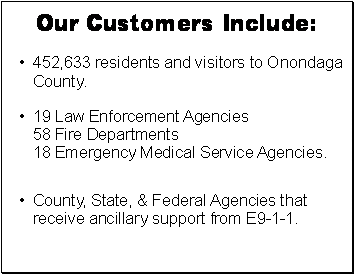 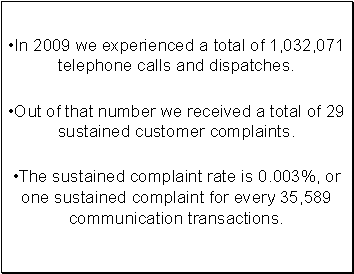
 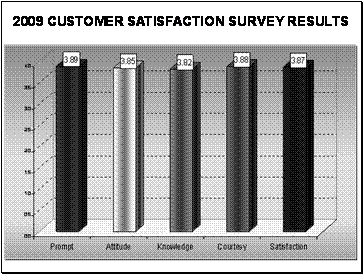
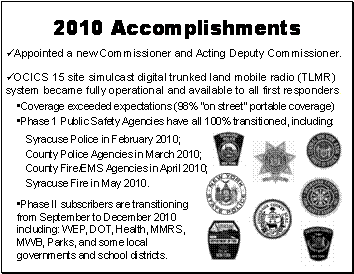 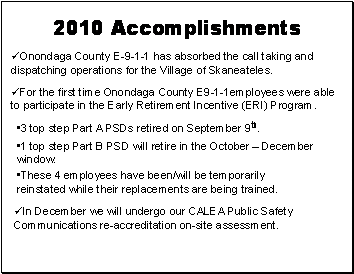
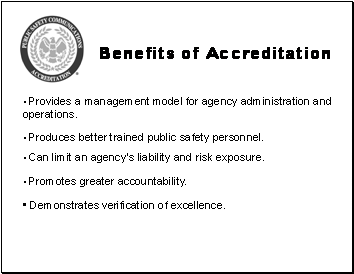 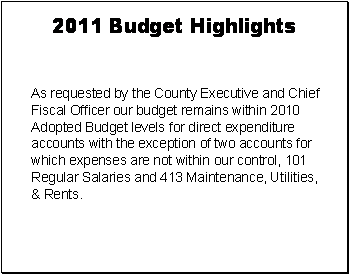
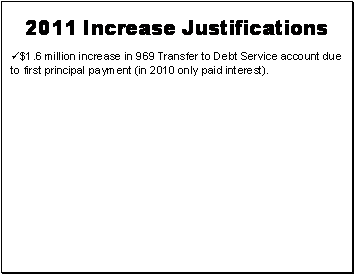 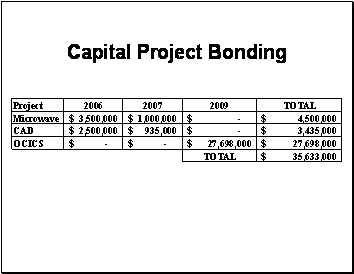
 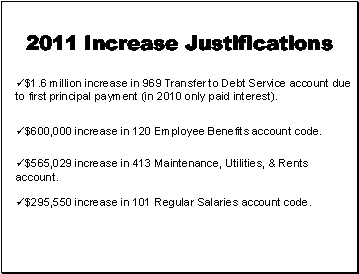
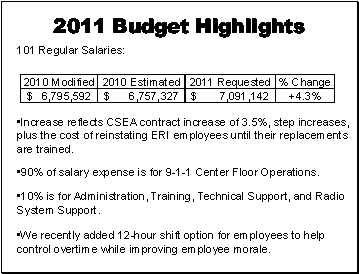 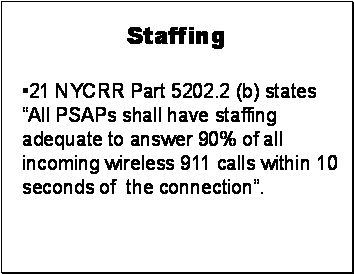
 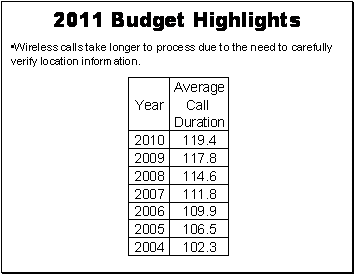
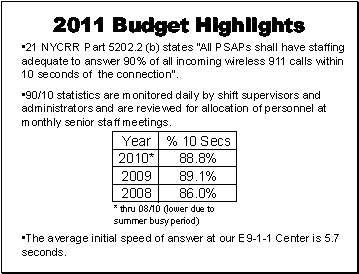 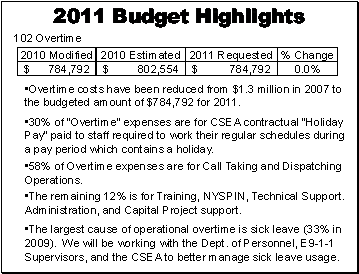
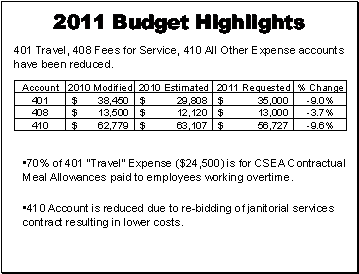 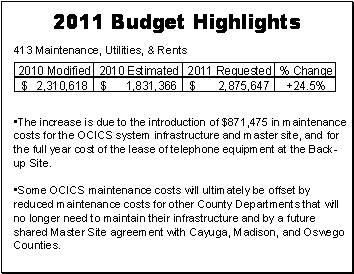
In answer to Chairman Jordan, Mr. Bleyle noted:
- 4 individuals took advantage of ERI; 3 of them have come back full time. The training for new employees takes 6 months, if these people were not brought back full time, the hours would have to be supplemented with overtime.
- Reducing overtime: a certain number of employees will be 12-hr shifts; they work closely with the supervisors to pick a number that will yield a benefit
- 12 hr shifts give them more work hours from the employee; they negotiated and a $1/hr stipend was assigned to the people that work the shift; the number of hours that they work far outweighs what they are paid. Per employee -- achieved an extra 133 hrs of work
- There is 22 hours of overtime savings with the 12 hr. shift; a cost savings of approx. $43,961
- At this point they are in the evaluations stage; looking to see the impact it has during the different seasons. Will then make a decision if they should add more or go in the other direction.
- Any other options being pursued to bring overtime down: Mr. Petrela indicated that overtime has dropped and it has worked very well.
- 33% of overtime due to people calling in sick – Mr. Jordan suggested that the 4 people working full time on short term basis (retired), that they are on call and possibly cover for people calling in sick, on the 103 line. Mr. Bleyle stated that there are limitations with the union agreement – have to offer the preference on overtime before we can bring in part time people
In answer to Mr. Warner; Mr. Bleyle noted the following:
- Employees get 10 sick days/year per CSEA agreement across the county
- Measure against other departments for sick leave used – 24 hour operations tend to experience a little bit higher sick leave, but are lower than some of the other 24-hr. operations.
- CSEA contract is up in 2012
Mr. Warner asked to be provided with a report of hours of sick time used in the department.
In answer to Mr. Lesniak, Mr. Bleyle noted:
- The yearly cost of the backup center is approximately $500,000; the largest expense is the phone system and maintenance for the radio equipment
- The law that mandates staffing also requires a backup center, or at least back up capability. If they were to go down, what would they do. It is also used during critical upgrades to some of the equipment. People are moved to the backup center, and they operate off the backup center in case one of the upgrades creates a disruption to the main center. To not have a backup center would be problematic.
Mr. Lesniak noted that this is one of the toughest departments to have to look at with the tax increases that are seen. There isn’t a lot of movement in this budget and personnel staff. He is looking to see where they can get some dollars, and nobody is going through unscathed.
- The main center has several levels of back up, but it is not just power, it is systems. Nothing is totally 100% guaranteed.
- Proud that they have the only public safety answering point, which is different from many counties across the state? They are the only game in town. In theory calls may make it to other center or might be answer by an AT&T operator, wherever he or she is with no knowledge of Onondaga Co. It would be very irresponsible.
In answer to Mr. Kilmartin, Mr. Bleyle noted:
- 401 line – most is traveling to various training programs that they have to attend; most in NYS.
- Cost on annual basis for training new employees – program line in budget, 2 people assigned, do a wide variety of training for existing employees and new hires; supervisory training, training for public safety call takers moving to public safety dispatchers; in-service training program; emergency medical dispatch directions. Figure includes ancillary training and supplies necessary for them
- Significant expenditures to be made for equipment for the interoperable radio system: Infrastructure is where they need it to be for the interoperable radio system; capacity to sustain users that are in it now and have capacity for other users, and more of county government to be a part of it. Uncomfortable that the entire system is located at the 911 Center; if there were a fire, the system would completely halt. Future expenditures – adding a dark prime sight and putting the system on a back up location – looking for grant funds to support it – estimated cost is $1 million
- If a DPW from a town wanted to come on line, the infrastructure is in place to support the communications. The Town would need to purchase the subscriber equipment. It would not add to maintenance cost; may possible offset the town cost or the costs to county agencies that are currently maintain county-wide radio system.
- Projections for replacement of equipment in the coming months/years: Currently the maintenance agreement covers replacement of certain types of equipment, but are in the process of building a life-cycle plan for all equipment. UASI grant requires it.
Chairman Jordan asked if it would be more cost effective to hire additional staff to help eliminate the overtime. Mr. Petrela said that is what they did 2 years ago…(inaudible); going in direction of training new people, bringing new people on and decreasing the overtime.
In answer to Chairman Rhinehart, Mr. Bleyle stated that the back-up center is used two times per year operationally; used three times last year for back up reasons.
- Phone system for backup center, $203k – for leasing the current phone system; lease was just renewed this past year; does not know if it is a yearly lease. When he first came on, they were in the process of replacing the phone system equipment.
- When backup center went down, a lot of systems were lost at the main center. Primary system for CAD are at the main center—back up site talks to it – lost that connectivity because of the power in the computer room; couldn’t talk to the main computers. To bring up the computer for the CAD system downtown, would have taking more time in recovery than it was to bring everything back up at the main 911 Center.
Chairman Rhinehart said that the legislature needs to decide how much they will charge the taxpayers for or say “enough is enough”. He referenced the major property taxes that are being proposed and feels we can go forward without the backup center--didn’t have one when he first came to the legislature. Mr. Bleyle said the PSB was used as a backup center prior to the current backup center. He doesn’t think the county has ever been without a backup center. It was up to where it really needed to be to ensure the needed degree of reliability. He would be very concerned if we didn’t have a back up site; it would be very irresponsible. Chairman Rhinehart asked if the surrounding counties have back up centers; Mr. Bleyle did not know. The surrounding counties have significantly smaller dispatch centers than ours. One advantage with the new interoperable radio system is that there would be increased degree of interoperability with those counties. Onondaga County serves as the ultimate back up to many of the surrounding centers.
In answer to Mr. Lesniak, Mr. Bleyle noted the $200,000 for the lease is part of the $500,000. Regarding grant monies, Mr. Petrela explained that they borrow up to $29.5 million, received $4.8 million in grants. The projected $2 million revenue is not showing because they don’t have it. In answer to Mr. Lesniak regarding debt service increasing $1.6 million and where the $2 million go, Mr. Seitz noted that the $2 million will go to debt service fund; used to reduce the debt in future years. When it is received it is deposited in a separate fund, which goes to reserve for bonded debt – restricted to reduce just this debt. Mr. Lesniak asked if we are projected $2 million, looking at $1.6 million increase in debt, can the $2 million be used in offsetting this budget in 911 for the $1.6 million. Mr. Seitz said that it has to go to debt service first -- would have to check with Comptroller to see if it can be applied for this year; have not been in a position to estimate future grants to reduce debt in the future. Mr. Antonacci said that it would have to be applied to debt first (generally have closeouts of long-term debt account). It goes into the overall account until the debt is paid. Mr. Seitz said that Mr. Antonacci is saying that the money is not really in there to apply; technically money has not been estimated in there to be used to offset debt in the future. Mr. Lesniak said that at some point, if there is $20 million debt out there, then there is a $2 million influx into the debt service account, how does it apply to the $29 million debt. Chairman Jordan said it reduces it from $29 million to $27 million. Mr. Antonacci said that there in not an excess in that account until the debt is actually paid at the end of the life of the bond. There cannot be an assumption that there is overage; take out the overage to the long-term debt account now and apply it to another area until it is fully paid. In the past monies have been taken out of the long-term debt funds, but they have been based on the way they debt is paid. The money is advanced, then the County is reimbursed for it. Over time there has been excess because of interest earnings or because more was paid out than needed to be. That money gets swept out of long-term debt, but the bonds have been paid. Mr. Petrela said that the money can be used for anything related to the project. Mr. Lesniak said that there is a $560k increase in maintenance cost of this year and asked if it can be applied for that increase. Mr. Petrela stated that it can be, if the county gets it.
Mr. Lesniak asked what Onondaga County is gaining as being the hub of the regional operational system. Mr. Bleyle said that Onondaga County is gaining the ability to be interoperable with the other counties. The potential exists that when our fire service or other agencies move into other counties, they will roam, just as a cell phone does – service would be seamless. Dollar wise, Onondaga County has a piece of equipment that will share with other counties. Onondaga County will be reimbursed a portion of the maintenance costs, as well as a portion of any human cost in providing for the care and maintenance of the master sites. The master site, that will be shared, is funded by grants. Mr. Lesniak asked if the only local dollars are in the maintenance of the system, and they should be shared with the other counties. Mr. Bleyle agreed that they are.
Respectfully submitted,
DEBORAH L. MATURO, Clerk
Onondaga County Legislature
* * *
WAYS & MEANS COMMITTEE 2011 BUDGET REVIEW OF PUBLIC SAFETY COMMITTEE (continued)
September 22, 2010
SHERIFF: Chief Richard Carberry, Custody; Chief Ted Bottsford, Police; Chief John Balloni, Civil and Administrative; Lt. John Dwyer; Dan Schuster, Dir. Admin. Services; Assistant Chief Roy Graiten, Police; Assist. Chief Vince Valewski, Custody
Chief Balloni provided the following presentation:
 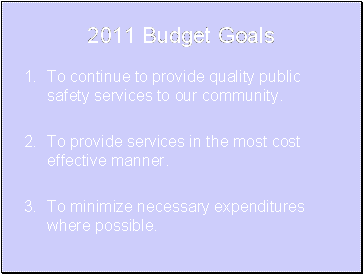
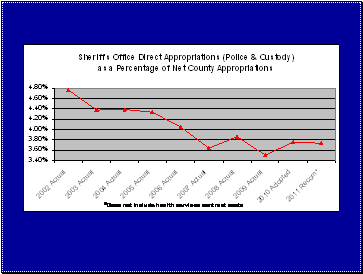 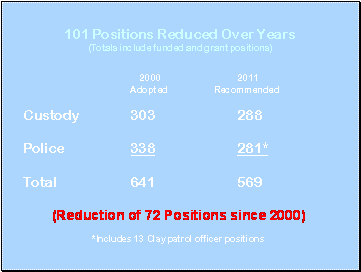
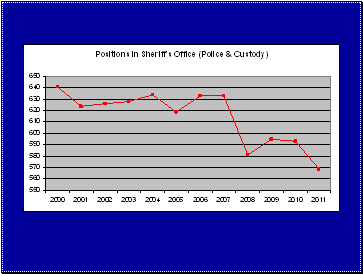 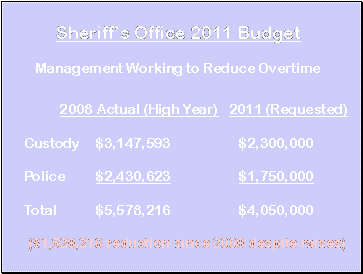
 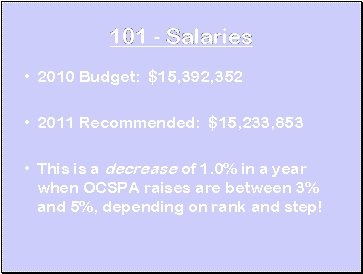
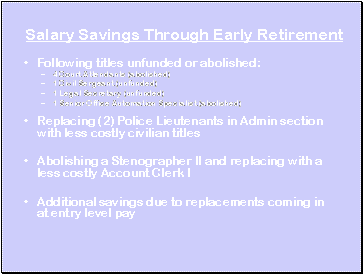 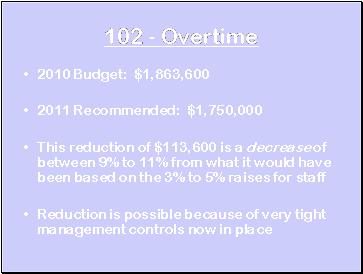
 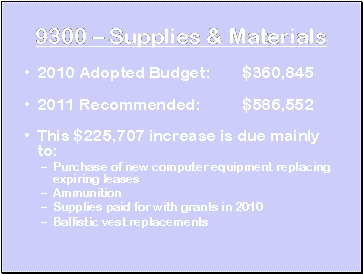
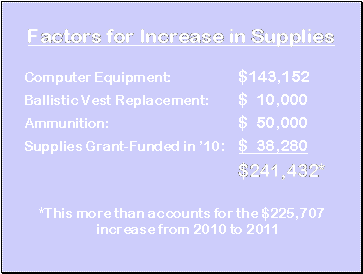 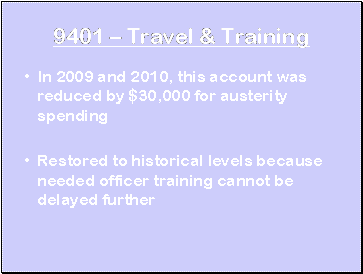
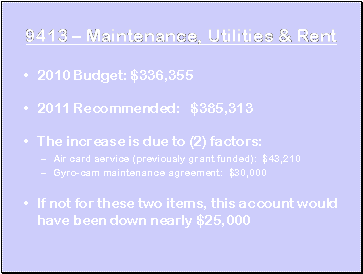 
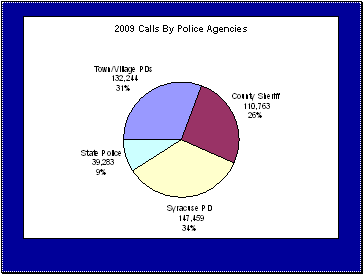 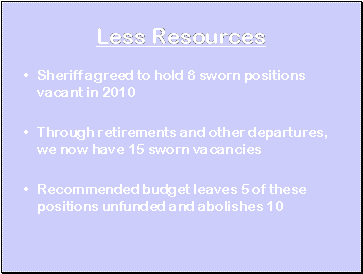
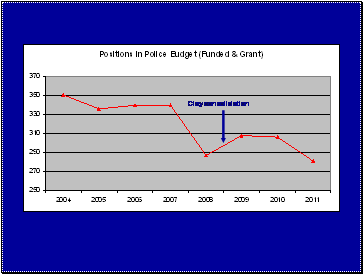 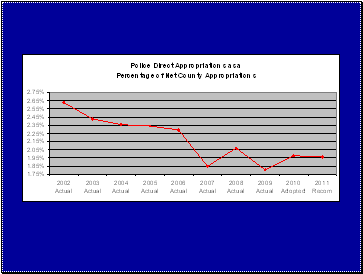
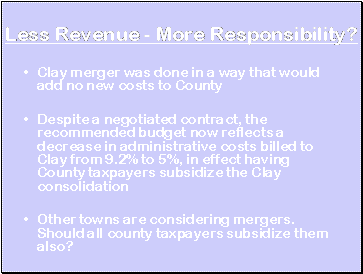 
 
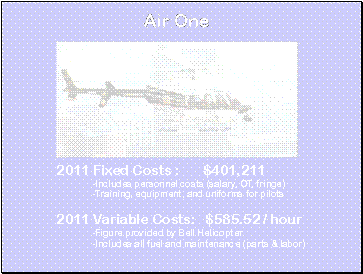 
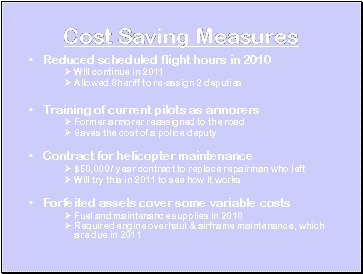 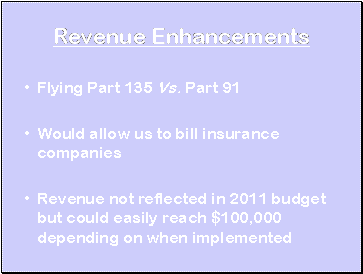
 
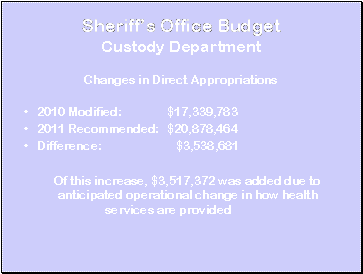 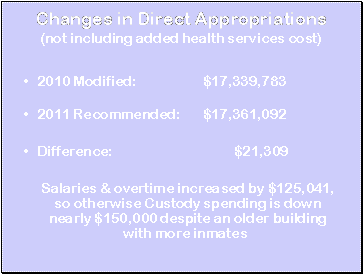
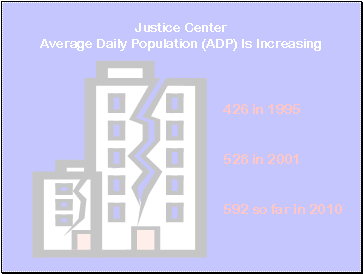 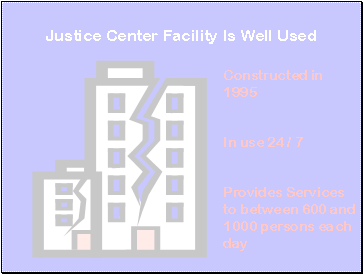
 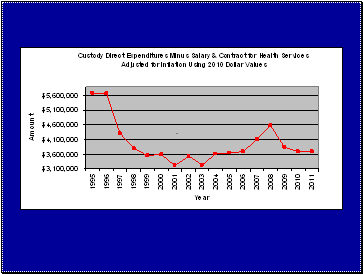
POLICE AND CIVIL BUDGET questions
In answer to Chairman Jordan; Chief Balloni noted:
- Janitorial is outsourced
- Purchasing computers – IT is not taking over purchase of all computers; replacing leased computers with purchased computers
- 408 line – professional services - $6,200 arbitration, $26k extradition, $18k maintenance agreements; $32k professional services non-employee; department physician, flight exam, legal services, medical exams, pre-employment psychiatric, substance tests, etc.
- 410 – budget load $31k – Does not know what the $31k is for budget load. Mr. Rowley noted that DMB did not provide that number; other 410 expenses include: bank charges, confidential funds, fire extinguishers, medical and hazardous waste removal, memberships, microfilming misc. non-itemized purchases, top 10 poster, towing, trash recycling, purchase cards, vehicle decontamination; shipping charges, etc.
In answer to Mr. Lesniak, Mr. Balloni noted:
- 4 court attendants abolished would have been reimbursed anyway – no local dollars; won’t have long term costs of paying health benefits, etc., as benefits are not reimbursed
- 25 vehicles, $193k above last year – last year received grant funds to pay for a large number of cars that they do not have access to this year
Mr. Lesniak said that the legislature is looking at double and triple digit tax increases in the suburban areas. The legislature is looking to decrease what is proposed. For many municipalities across the state, including the State of New York, they have received no vehicles for police forces because of economic conditions.
- Operation Impact funds: $30k in overtime funding; 2 police and 1 custody position funded; 9 positions in the budget are not grant funded but are dedicated to Operation Impact – are local dollars
- Special enforcement, includes the navigation unit – 2010 adopted $1,593,000, requested 2011 $1,520,000; Mr. Lesniak asked to be provided with a cost of the navigation unit.
In answer to Mr. Kilmartin, Mr. Balloni noted:
- Referred to charts regarding direct appropriations as a percent of net county appropriation – asked to be provided with a 10 year model for the actual budget items over the 10 year period – actual dollars within police and custody. Chief Balloni will provide the information.
- Average number of vehicles that the Sheriff’s Dept. has typically purchased historically over 5 -10 years - in the neighborhood of 25
- 23 vehicles were purchased through grants
- Grant vehicles assigned specifically to units to help them, but the vehicles have to be given to a person in that unit per the grant conditions--are not available for reassignment. A patrol vehicle can go out for 2 – 3 shifts per day.
- 21 employees took advantage of ERI (Police and Custody); 11 positions will be re-filled
- Asset seizure funds - $700k not accepted; can’t be sent until accepted by the legislature
- Asset seizure funds allocation : outlined in presentation, will be put towards Air-1 and custody
- Clay consolidation – recommended budget came back with a decrease in amount charged to Clay from 9.2 % administrative fees (a negotiated amount), down to 5%. It is approximately $40k less in revenue for the county
Mr. Rowley said that the administrative percentage is based on salary and fringe. Part of the thinking on reducing the percentage is that fringe is going up expeditiously. There is a built in increase already with the way the administrative fee is calculated. The administrative fee isn’t truly an administrative fee; if the marginal cost of administering that small consolidation is 9.2% of salary and fringe then consolidations in general are probably not going to happen if those kinds of costs are built into the model. He would characterize it as profit. Trying to encourage consolidation, not discourage it - from Budget’s perspective and the Co. Executive’s perspective. Chief Balloni said that the reality is that there is overhead and administrative costs in consolidations; consolidations are favored where they make economic sense and where the citizens believe that they should happen - can’t push consolidation past where it is economically feasible. In answer to Mr. Kilmartin, Mr. Balloni said that the contract was for 5 years between the County and Town of Clay. Mr. Kilmartin asked if what is in the budget is consistent with what is in the contract; Mr. Balloni said that it is inconsistent with what is in the contract. Mr. Kilmartin provided an example and noted that he is concerned that if there is not a direct reimbursement, then the people in towns where there is not a police department, are paying for other towns to have an enhanced service. The Sheriff agreed.
Mr. Kilmartin said that there is a line item change for administrative costs related to the police academy; rent payments in the past previously paid to OCC. Sheriff Walsh said that they have looked at the early MOU; studying it; have several comments; will make a revised MOU proposal back to the City and will go forward from there.
Mr. Kilmartin asked for the total cost of Impact within the Sheriff’s Dept., and the total dollars that the Sheriff’s Dept. received from the State through the DA’s office for Impact Services.
Mr. Warner is concerned that the merger with Clay is costing other taxpayers in the county more money. Mr. Walsh said that if we change the way it is being done now, then the cost would be spread across the county. When those numbers were vetted by the Co. Comptroller, they were found to be accurate numbers, which is how it was designed – no cost being absorbed across the county budget. Mr. Balloni said that if the current budget goes through with the decrease, then there will be subsidizing and the rest of the county will be paying.
Mr. Warner asked about overtime in custody; Mr. Balloni noted:
- One of the major drivers in custody overtime is one on ones – direct supervision of suicidal inmates – the number fluctuates wildly from day to day; it is mandatory
- Another mandate is that certain positions have to be filled on a given shift
- Sheriff Walsh noted that they can watch 2 inmates with 1 deputy – it is one deputy working an 8 hour shift, 3 deputies over 24 hours to sit and watch 2 inmates that may have alluded that they want to kill themselves – with the glass front cell can have 1 deputy watching 2; have changed some doors so there is more glass; some have to be watched through the meal slot.
- Police side – can make some predictions – might be able to leave a post vacant; with custody can’t leave any vacant by mandate
Mr. Corbett asked about vehicles; originally had a sheet with a request for 24 vehicles with a denial of 5 vehicles and 1 for custody. On the morning of the meeting DMB presented a budget with a recommendation for a total of 24 with one transport van for custody. It was explained that asset seizure monies were going to be used to offset the difference. Mr. Balloni said “no”, but there was an agreement to use asset seizure money to fund something that was in the budget that is no longer in the budget.
Chairman Jordan asked about computer leases - $21,122; Mr. Balloni noted that is for the balance of a current lease. When the lease ends, it will go away.
Chairman Jordan said that Sheriff’s Dept. is asking for less than proposed in the Co. Executive’s budget; and substantially less than what was originally requested. Chief Balloni agreed.
In answer to Mr. Kilmartin regarding the Clay contract issue, Mr. Balloni noted that the level of service for a town that does not have a police force – Sheriff allocates resources according to the number of calls. Sheriff Walsh said that personnel is not allocated based solely on population. The Town of Clay is large in population and in mileage; Sheriff looks at allocating personnel so they can be in any emergency situation in a reasonable period of time – try to keep it under 4 minutes for priority one issues. In the Town of Clay, the Sherriff had one car and when necessary would cross over to Salina, Lysander Cicero, wherever it was needed. In addition they had 2 other cars partially assigned to other parts of the Town of Clay – coming in from different angles. Basically had one full time post and 2 part time posts—on average 1 and 2/3s cars in Town of Clay. Clay had its own police – they averaged about 2 cars on the street on most shifts. Clay signed contract for Sheriff Dept. to have 2 cars in their town over and above what was allocated to the town already. As long as the contract stands, those 2 contracted sheriff’s cars won’t leave the Town of Clay other than when there are circumstances where the Town of Clay offices would have left the Town. If for some reason the Sheriff cannot provide those cars, which hasn’t happened, the county would not bill the town for that quarter for the full 2 cars. Regarding the 9.2% administrative cost, Comptroller looked at it thoroughly, as they were concerned about passing that cost onto other residents. During the course of the contract, salaries have gone up; there was a built in anticipation for salary increase, built in guarantee to be able to replace the vehicles. Mr. Rowley said at the time the proposed contract was 9.2% was based on 2008. That number was reasonable when the contract was discussed. Fringe has since gone up extensively, 9.2% theoretically has grown to 12% - 13%. There is a built in escalator now. He has never seen justification for what constitutes the overhead rate. Cars shouldn’t be part of the overhead rate; cars are billed separately in the contract. As the cost of cars go up, that line item in the contract would go up. If Clay cancelled the contract, the calls would have to be picked up by somebody. The Sheriff would theoretically pick up the calls as no additional cost to the taxpayers, they wouldn’t pay an enhanced cost. Sheriff Walsh said that the 3 minute gold response time could easily extend to 6 minutes; which is a long time to be bleeding waiting for a patrol to show up. Without increasing manpower, there is no way to do that. The 2 cars would no longer be guaranteed in the Town of Clay. Mr. Schuster said that regarding the fringe going up, Sheriff’s fringe is going up too, so in effect the County is eating all of the costs, because the 9.2% was related to salary and fringe of the administrative help. County costs are going up, but reimbursement is going down, thereof county taxpayers would be paying all of it.
Mr. Holmquist stated that the legislature is in a predicament, a crisis. The Co. Executive budget proposed a 51% property tax increase on the citizens of Manlius. Several towns have over 100% property tax increase. He appreciates the pressures on civil and custody and many other members of the county family. Despite the best efforts, there is still over $2 million increase in each budget. A 51% property tax increase is not possible. Chief Balloni questioned what the priorities are in this crisis; is public safety the number one priority or not. It is the Sheriff’s obligation to sit before the legislature and tell what is needed to do the job; they will not alter in that obligation.
Mr. Laguzza asked what the intent is when the Sheriff does its next consolidation effort; part of the reasoning that there is the situation with the towns is because of the sales tax formula and transparency in the town budgets. Everyone was surprised as to what those towns were dealt. Now possibly Solvay, Cicero, Camillus may come to the Sheriff for consolidation. He does not intend that the taxpayers pick up the administrative fees countywide. There should be way, via a formula, to be passed on to the towns that want enhanced services, and asked if that is doable. Chief Balloni said it is doable, but if not done correctly county taxpayers could be absorbing additional costs in this process. Sheriff Walsh said that in any consolidation, people have to be given the actual, factual numbers; can’t be absorbing numbers and hiding them in a budget – have to tell people what it will really cost them. Mr. Rowley said that regarding the stress out there to the cost to the towns that have their own police departments, the overriding objective in looking at the tax rate and adjusting it is that we should encourage consolidation and help the towns and villages. He has never seen a detailed calculation of what the 9.2% is; never seen numbers presented to the Town of Cicero – doesn’t know what is in that number. He is making his best judgment as to what would cover the marginal cost of administering an enhanced contract.
Mr. Laguzza referred to priority calls and asked if the Syracuse Police Dept. still has an officer at the 911 Center to ensure proper interpretation of the priority calls. Mr. Balloni said that the officer is no longer there; it was a budget consideration. He added that priorities outside of the City of Syracuse are all the same; the City of Syracuse sets their own priorities. In answer to Mr. Laguzza regarding priorities being shifted and the Sheriff’s Dept. answering more calls, Mr. Walsh said that the calls would still be the same priority, but it might take the Sheriff’s Department longer to get to it. A priority 3, as it is often the case in the City, may very well not be answered with an officer being able to show up. There is an impact on quality of life.
Mr. Laguzza asked to be provided with the number of arrests and type of crime as part of Operation Impact for the Sheriff’s Department and Probation data.
Chairman Rhinehart asked about Project Impact; and the following responses were given:
- Project Impact originally meant to be temporary program – when programs started 17 high crime areas were chosen through the State of NY just for city police depts.. They re-evaluated it when they realized the impact that it would have on surrounding communities – Sheriff has been involved ever since
- It remains partially funded through state funds
- Is participation based on number of positions – Sheriff Walsh said it is 9 positions; use different positions based on staffing at the time; try to do with min. of overtime
- Intend to continue with Project Impact
In answer to Chairman Rhinehart, Mr. Balloni noted:
- 281 total positions, 134 are road patrol – deputies and supervisors
- Other positions are Civil Division positions, detectives, administrative
- Have approx. 190 vehicles in department; all are repaired at WEP unless it is a special repair. There is a bunch sitting there that are being issued that came in late in the process. WEP does a good job, but doesn’t have staffing to get vehicles in and out quickly; every 3,000 miles PMs are done – pull brakes, etc.
- Have about 3 207C’s currently
- An air card is a way to have the computer in the car communicate with 911 Center and County computer with much broader band width than is built into the radio system.
Chairman Rhinehart noted that in 2000 the local budget $38 million; in 2005 it was $50 million, in 2008 it was $60 million; in 2009 and 2010 it was/is $61 million; in 2011 the local request is $66 million; it is gross 9% increase over last year. Chief Balloni said that a number of things are beyond their control: growth in salaries, benefits, retirements. Regarding the sections of the budget that they control -- have done an extremely good job. Have cut a number of positions; it helps control those costs that they can’t control. In this budget, in the Custody Dept., there is $3.5 million moved in their budget due to anticipated operation change in the way the health services are provided at the jail. These dollars have previously been in the Health Dept. budget. Sheriff Walsh noted that when the justice center was built, he argued that a 4th tower should be built. At one point they were bringing in $4 million/year in revenue for holding federal inmates. It was about 92/day that they were being reimbursed for at $102/day per inmate. As of today they are holding 3 federal inmates, the rest have gone to Cayuga Co, Broome Co, Jamesville and other places. Jamesville now shows it as a revenue line. Sheriff’s revenues have gone down because they don’t have capacity. This morning they had 638 inmates at the justice center.
Chairman Rhinehart said that the legislature is in a difficult position with this budget; the only place that money comes from is taxes, and that is not a decision where there is a whole lot of enthusiasm for in this legislature today. There is going to be an expectation that we will have to work together to get through it – will be looking at grant monies and asset seizure monies for vehicles, rather than tax dollars. The committee will take a very hard look at this budget and will be in touch with the departments to discuss ways to compromise so that they don’t have to tax for an additional 9% over last year.
Mr. DeMore said that last spring Mercy Flight took their name off of the clearing house. Chief Balloni said that it happened for a period of 5 months while they were suing the county and the state for providing services. During that time if someone wanted Mercy Flight, they would have had to be called directly. In this county, as in most counties, air services/health services are dispatched out of the clearing house. Mercy Flight did not prevail in the lawsuit. Mr. DeMore said that if Air One were not here, we could be at Mercy Flight’s mercy. Chief Balloni agreed.
Mr. Masterpole asked if overtime is driven by special events, i.e. Balloon Fest, Jazz Fest, Bass Masters, etc. Chief Balloni said that sometimes patrols are boosted when there is an event, but it is not a significant portion of the overtime.
Mr. Kilmartin said that prior to Impact the Sheriff’s office had some certain level of service with the City of Syracuse – when Impact monies became available, did the level of service increase from the Sheriff’s Dept. because of the Impact driven priorities. Sheriff Walsh said that priorities didn’t change -- have always had an effect in the city. They do sex crimes work, undercover work and warrants work in the city. The issue has always been that they never did marked patrol units in the city prior to Impact. Certainly they drove through the city, on average they took numbers for approximately 7,000-8,000 calls. There are some additional calls with Impact, but for the most part they are units backing up the city, so that they can answer other priority calls. Mr. Kilmartin asked if there are now marked patrols in the city regarding the 9 positions dedicated to Impact. Chief Balloni said that they do, when the details are running. Details used to run for a month or two and then take a break for a month; have been going a little longer with not as many breaks recently, but not a continuous detail. In answer to Mr. Kilmartin, it was stated that they are working five days a week, 30 weeks/year. Mr. Kilmartin said that via Impact the Sheriff’s Dept. if providing enhanced services to the City of Syracuse. He asked if it is analogous to the enhanced services provided in Clay, for which there is a contract for those services. Sheriff Walsh said that it is not even close. They have specifically replaced the Clay Police Dept. with the contracted officers. In the city the Sheriff’s Dept. is augmenting the City with specific types of details and all of those are aimed at reducing gun violence, which has an impact on the entire county. Mr. Kilmartin noted that the Sheriff’s Dept. is providing a service in Clay and charging a fee via contract for those services. Similarly the Sheriff’s Dept. is providing a higher level of service in the City, but there is no contract for it and asked if they are analogous in that respect. Sheriff Walsh said that in the Town of Clay they are answering calls as the primary unit. In the City of Syracuse they are backing up City officers, handling traffic issues, so that City police officers can handle other calls. It is not really analogous; it is a specified kind of detail.
Mr. Masterpole asked if a town dissolves their police department and doesn’t have an enhanced agreement, similar to Clay, how does the Sheriff’s Dept. react to it. Sheriff Walsh said that they prioritize and probably would have to increase their manpower; may have to pull manpower from someplace else. They would look at it whatever the priorities are at a given time and make a determination as to how they can allocate the scarce resources that they have and stretch them farther. It would have a negative impact. If the manpower is increased to the Sheriff’s Dept to equal the manpower of any agency that considers doing away with its own force – 31% of the calls are being answered by the town and village agencies; Sheriff’s Dept. cannot absorb another 142k calls on top of the 110k that they answer. The State Police have basically said the same thing. In answer to Mr. Masterpole, Mr. Rowley said that the Town of Geddes is not taxed at a different rate because they have a department in place. Mr. Masterpole said that the people in the Town of Onondaga are taxed at the same rate as the Town of Geddes, who are paying for their Geddes Police and Sheriff’s patrol. Sheriff Walsh and Mr. Rowley said “yes.” Mr. Masterpole said that the Town of Onondaga is getting a service that we are all paying for.
AIR ONE:
Chief Balloni said that he has provided the backup documentation of fixed costs vs. variable costs. Variable cost is $585.52/hr., which is latest information from Bell, the manufacturer of the helicopter – it covers fuel, maintenance, parts and labor, 2500 overhaul. In this year’s budget, the Sheriff has proposed to pay for the overhaul of the engine out of grant funding. It would reduce the variable cost to $485.52/hour. It is actually over that, because the $250,000 - $300,000 in maintenance is figured in the $585/hr. cost. The fixed cost does not include the building, because we would need the building anyway – would have to maintain heat, repair, etc. The personnel would stay the same unless it was proposed to abolish those positions too. The ship is paid for. There are ships out there from the 1970s which are still safe, reliable, and being flown. This ship doesn’t expire in 2015. The B-52 fleet is expected to be pushed another 40 years. It would be short sided to take a onetime revenue boost by selling this ship that the county already owns. It is a consolidated tool, it is used by police, fire, EMS. There were 72 missions in the city last year; last night was the most recent mission – looked for suspects and assisted City Police after suspects fired upon city police officers. It is not a toy, not a political pawn; it is a valuable tool supported widely by the police, fire and EMS communities. If an equal level of service were possible without the ship, they wouldn’t have the EMS support. They have taken steps to reduce the local share. In 2010 flight hours were reduced to 400; reached a high of almost 1000 hours in 2001. September 11th happened in 2001 and the value of this tool was recognized by patrolling critical infrastructure and protecting county residents. Two deputies that were assigned to the ship were reassigned back to the road. The current pilots were trained as armors; current pilot was reassigned back to road, which saved the cost of a police deputy. In the coming year, they are looking to contract for maintenance; which may reduce the local share of costs, about $50k to provide maintenance.
- Forfeited assets will be used to control variable costs; a small amount was used to cover maintenance and supplies in 2010; proposing to use over $300k to do the engine overhaul and frame maintenance due in 2011. It reduces the per hour cost by $100/hr.
Revenue Enhancements:
- Revenue enhancements: Maryland currently has a helicopter flying and are Part 135, which allows them to charge when on medical missions; and Part 91 when on other public safety missions. Hoping it will allow to billing insurance companies when they go on life-saving trips – help subsidize or at least pay for the cost of those trips.
- Revenue not reflected in 2011 budget, but could easily reach $100,000
- Not in NYS yet - Chautauqua Co in process of working through regs with FAA; have every reasons to believe it will be allowed here
- Not looking to expand medical mission – looking to go on medical missions when they are the closest available ship
- Don’t know when revenue will come through
Benefits of Air One:
- Homeland security patrols – patrolling critical infrastructures – gas lines, electric facilities, electric lines, rail yards, etc. - cost effective to patrol from air
- Pursuits--have night sun, video equip., just arrival of air craft on scene has forced drivers to pull over and give up
- Suspect location and apprehension; forward looking infrared – find warm bodies hiding in woods, fields. Dangerous to go out on foot and locate suspects
- Video downlink – video from air – in event of a disaster, video can be down linked to managers the disaster; it is an aerial overview
- Fire uses: forward looking infrared, bambi bucket – paid for by the police officers union – can move water to hard to reach locations, assist firefighters in putting out fires; search and rescue capabilities on land and lake; dropping firefighters into remote locations for recues to fight fires
- EMS – medevac – closest available; 4% of total calls –not a huge amount of air time, but extremely important
- Bring medical personnel out to location – bring a doctor from a hospital – i.e. to do a field amputation
Chief Balloni asked legislators to review the packet of information (on file with Clerk). Lieutenant Wicks did a comparison of the R44, which has been talked about as a replacement for the helicopter. Mission capabilities – criminal calls, homeland security checks, traffic enforcement, searches, vehicle pursuits – can all be done.
What it cannot do:
- does not have the payload capacity to do medical rescue insertions
- Victim extractions
- Ice and water rescues
- Medevac transports
- Medical assists
- Neonatal transports
- Bambi bucket – not capable of carrying the payload
- Fire insertion
- Dignitary protection – could do this to some degree, but usually the Secret Service is up with them, bringing their person and their equipment into town. With the R44, they would have to fly one pilot only, no crew – not sure how much payload it could take
Overhaul costs:
- Bell 407 – 2400 hr. mandatory maintenance, $250k; $100/hr. cost to operate; R44 – engine overhaul every 2200 hrs.; engine overhauls are cheaper. Total cost difference is $9/hr.
Bell 407 is affected by wind miles per hour at gusts of more than 35 mph; 29 days last year it couldn’t be flown due to wind conditions. The R44 is affected by wind gusts of 25 mph. No way comes close to performing the current missions of Air 1, with the R44. This is a critical, important safety tool.
In answer to Chairman Jordan, Chief Balloni noted:
- Fixed cost vs. variable cost depends on how many hours are looked at – if hours are cut far back, it only cuts the variable costs, the fixed costs would remain the same, so it would cost much more per hour to fly
- Currently fly 400 hrs/year; same proposed for 2011 – cost approx. $1,600/hr.
- Engine overhaul proposed to use $300,000 of the $700,000 balance in forfeited assets for engine overhaul
- Have been looking at Homeland Security grants to offset costs of the helicopter; the grants are very specific; have not found to date that any of the grants will help fund the helicopter.
Sheriff Walsh said that he met with the deputy director of Homeland Security in Albany and discussed at length about potential of using border county monies – allocations of monies to counties that border Canada. Onondaga Co. does not border Canada, but borders Oswego County, which is a border county. Onondaga County is the first back up should something happen at the nuclear plant. Arguments fell flat with federal government; they will continue to make arguments and search for funds. Mr. Corbett asked about the independent nation within our borders, Onondaga Nation, and asked if it could be used in any way. Chief Balloni said that he has not seen any grant funding for that. Sheriff Walsh indicated that he had discussed it the Homeland Security, but was denied.
Mr. Lesniak said that he has always supported the helicopter; it is a definite tool that is very useful to police agencies and fire departments. The issue this year is totally different than those in the past due to the tax rate increases. Mr. Lesniak referred to the different numbers relating to Air One - 2009: Sherriff’s cost figure= $401,000; Management & Budget = $696,698; in the budget there is a special enforcement number of $1.52 million and includes the navigation unit and asked for explanation of the different numbers. Mr. Schuster said included in the $1.52 million number are: interdepartmental costs $688k; navigation, variable costs. The $401k number includes fringe.
Mr. Lesniak said that there are various numbers for the Raven 44 – Sheriff shows a total package of $825,590; the booklet does not include a cost of the helicopter. Mr. Lesniak said he priced out the Raven at $442k plus adding on all of the items that the Sheriff added on, and came out with a price of $502,660, which is $330k less than the Sheriff’s Dept. price. Mr. Balloni said that there is a Raven R44 police package - $676k and the cost of options at $149k. It was explained that the number included in the packet were prepared by the pilots; the website is confusing. The numbers were developed by using interviews with different police departments as well as the website. Regarding the overhaul, the Raven website has it at around $132k; when speaking to specific agencies it ranges between $200k - $210k. The lower number was incorporated in the total figure. Mr. Lesniak said that if buying new, the overhaul maintenance wouldn’t be in 2011. Chief Balloni said that he will find out specifically why there are any discrepancies in the numbers.
In answer to Mr. Lesniak, Mr. Balloni reported:
- The Bell 407 is from 1999
- Has a good resale value, but may not be as good as people think it is because of the economy and downsizing
Mr. Lesniak pointed out that he did not know variables such as component times, total hours, equipment conditions, but determined a ball park resale value of $1.8 million. Chief Balloni said that it was a fair estimate. Mr. Lesniak said that it would be $650k for a new helicopter, doesn’t have to be overhauled (savings of $200k), asset seizure funds would be freed up to use somewhere else in the budget; get an influx of $1.1 million. Mr. Lesniak said that he is looking at it from the fire service and police service – lose Bambi bucket, lose rescue capabilities to an extent – with the pop out floatation devices it would be able to land on water or ice and do something. Sheriff Walsh said that you just don’t replace something you need with something you don’t need because it is cheaper. Mr. Lesniak said that it wouldn’t have all of the capabilities that they have now, some things would be lost. Mr. Lesniak said that we don’t lose a lot on police services. Sheriff Walsh said that we lose human lives. Ten years ago a citizens committee determined what was needed. Mr. Lesniak said that he is looking for options; there are triple digit tax increases; would like to ask that same citizens committee some of the questions now and wonders what kind of answers he would get with triple digit tax increases included. Chief Balloni said that the number one priority of government should be public safety. He stated that the total appropriation of $700-$800k in a population of 450,000, is a $1.50 cost.
Mr. Lesniak said that 24 medevacs are reported for 2009 by the aviation unit. Mr. Lesniak understands that 17 of them were out of county; the adopted number indicates provision for 50 and asked what the actual number is for 2010; questioned why it will go to 100 in 2011. Chief Balloni will report back.
Mr. Lesniak referred to the tax rates and said that the legislature has to make choices. Every department has come in and there have been substantial cuts made to their budgets. He wants to save the helicopter program, but if voted on as is, he believes it would be gone – does not think there is enough support to keep the program. That is why he is trying to look to keep the program in some fashion; if he can get $1.1 million influx into the budget plus keep a helicopter program, then they are getting it done. May not have all of the services from before but there would still be a program. With the tax rates going where they are, the Sheriff’s Dept. either has to work with the legislature to keep the helicopter program and make significant cuts out of the budget, or this legislature will probably vote the helicopter out.
Mr. Laguzza said it makes no sense to take a one shot and in return get a unit that might not be able to fly 200 days/year. He is encouraged that the Sheriff is looking at insurance revenues and asked if it is possible that the legislation might be approved this year. Sheriff Walsh said that it is possible; he spoke with Sheriff Gerace, Chautauqua County, who is in the process of trying to develop their program. He spoke to someone from the FAA, who was non-committal. Will spend the better part of 2011 getting FAA credentials so that they can get 135 – it could take 6 – 9 mos. They want to make sure that Chautauqua County is able to do it. Once it is up and running there, they will supply Onondaga County with everything that they have developed so that Onondaga County and put its package together. Hopefully the FAA will move quickly with the second unit to go on line. In answer to Mr. Laguzza, Sheriff Walsh said that there is not an agreement with contiguous counties to fly. About 4% of the calls were outside of the county. In answer to Mr. Laguzza, Sheriff Walsh said that special missions are unique and not on a regular basis. In answer to Mr. Laguzza regarding financial gifts for services, Sheriff Walsh said because they are not part of 135, they cannot accept financial gifts from the helicopter. Cayuga County gives $5,000 every year and it is put into the County’s general fund. Mr. Laguzza asked about Operation Lifesaver, GPS bracelets; Mr. Balloni noted that it is a program that finds people with Alzheimer’s, lost children, etc. -- use ship the helicopter to locate them. Mr. Laguzza said it was not highlighted in the presentation; feels that the program is not publicized enough – there is a small financial benefit if people are able to afford it. There is a huge benefit to the program.
Mr. Holmquist stated that every department is being cut because there is no choice; it is not because the committee wants to. Air One passed last year; in a vacuum it would get big majority support. None of the legislators want to cut this, or the Sheriff’s staff; there is no choice -- do not have the money. Tax increase are untenable and unacceptable. He asked for the whole Sheriff’s team, who is in really tough spot, just like the Legislature, to consider when the leadership meets with them, and provides a number that the Legislature needs to get, that the Sheriff’s Dept. work with them. Many other departments are working with the legislature already and realize that this is not rhetoric; it is real local dollars. It is dramatic, historic, double and triple digit property tax increases on top of the highest property taxes in the country and many citizens don’t have jobs and are under tremendous stress. They are dealing with budgetary problems of their own; the Legislature will do the best it can. Public Safety is a top priority without question. Math applies to all of us, including public safety; at the end of the day we are all driven by the rules of math. The leadership is going to come to the Sheriff’s Department, and he hopes that everyone on the team is collaborative, open minded and does everything possible. It is going to be a tough year, as is next year; hopefully there is light at the end of the tunnel after that. At the end of the day Air One does not operate in a vacuum within this budget, or within the county budget in total context. The leadership will come to the department with the best number possible. It is dependent on if Air One is on that priority list, but something has to go. It may be a conjunction of other cuts and keep Air One as is, which would be phenomenal. He implored everyone on the Sheriff’s great team to work with the leadership of the legislature. He cannot support a 51% property tax increase.
Chairman Rhinehart asked the following and responses followed:
- Air 1 down in 2007 for 6 mos. due to a blown motor -- how many people died in that 6 months. Sheriff Walsh said that they can’t provide that number based on a direct result of Air 1 being down, but the medical examiner could be asked if some lives could have been saved had there been a ship available to save their lives. Chairman Rhinehart noted that he asked Chief Peverly that question two years ago and he replied “zero”. Sheriff Walsh said that Chief Peverly said zero because he would not provide a number that he couldn’t substantiate. Chief Balloni said that they have been in touch with people at Upstate and have assured them if more people were medevaced in, then more lives in the area would be saved.
- Insurance in budget is $50k for the helicopter – Chief Balloni said that it has gone down from last year. Hull insurance is $3,500, which is the boat; last year it was $3,095 – 50% reimbursed. Mr. Schuster stated that the insurance cost for Air 1 is in the interdepartmental expense – out of Risk Management; the $50k is an estimate for helicopter insurance. Sheriff Walsh will speak to Mr. Stasco and get a more accurate number.
- Neonatal transfer – aren’t done any more -- haven’t been done for quite a number of years
- Thermoscanning success rate – Chief Balloni said that the there are limitations to infrared technology – it is not a limitation of unit. Infrared, like radio waves, etc., does not work well through heavy foliage; they have a harder time locating someone in heavy foliage – someone lost in the woods in the winter will stand out very quickly.
- Flying in winter and weather limitations – cannot fly in wind gusts above 35 mph are not safe; no helicopter can fly in all conditions – it is a limitation of the technology
- Maintenance man hours per flight hour on Bell 407 – roughly $100/flight hour per Bell’s estimates
- Any discussion in splitting costs of Air One with volunteer fire departments or other agencies – fire departments are nonprofit organizations usually, and the Sheriff’s Dept. has not approached them and asked for money for the helicopter. Surrounding counties – Cayuga provides an annual payment; specifically prohibited from charging as it is a public service helicopter. The FAA regulation of part 91 vs part 135 – may open up that possibility.
Chairman Rhinehart said that it has been talked about for several years – the Onondaga County taxpayers is paying for Air One program, yet surrounding counties benefit from it also and there is no reimbursement. It was brought up in the presentation, but yet we are still not able to do it. He noted for the record that for the past seven years, the same conversation has occurred every year, and we still have not been able to secure it. It is a key component when talking about the cost of the program overall.
- Mission statement – Chief Balloni said that the mission was determined by a committee of 60 which included legislators and the Chairman at the time.
- Helicopter for dignitaries – not absolutely necessary, but is a good tool for the protection of the dignitaries when visiting here
- During Sales Tax discussion, a village mayor showed the committee pictures of a treatment plant taken from Air One -- Chief Balloni said that those things are done in conjunction with whatever mission patrol training that they are going up on. Sheriff Walsh said that in this particular case, there was potential flooding in the Town of Manlius. The Mayor’s concern was to take photos that he could use to convince DEC to help him get permission to clear some streams before property damage occurred. It worked in conjunction with the Air One mission.
Chairman Rhinehart said that he questions that at the cost of several thousand dollars per hour to put it in the air. Sheriff Walsh said that they would be flying anyway and it made sense to do two things at once – prevent potential damage and hopefully get money from the State for the Town of Manlius. It was not a special flight just for the Mayor’s purpose.
- Projected costs for Air One includes major overhauls
- Total expenditures since 2005 for Air One - over $1 million every year; sometimes well over $1 million. The program was trimmed back last year; about $850k was budgeted for this year. In June a resolution came over, which was pulled, for a request for another $425K – engine overhaul of $180k, airframe maintenance of $125k, aviation fuel for $50k, and tech opts equipment of $22k. When adding in the $424k; the total is up over $1.2 million. Chief Balloni said the money in June was the asset forfeiture money, which they had intended to put on the table – it was intended to be used for air frame and engine overhaul for Air One – the same place it is intended to be used in the 2011 budget. It was pulled and put into the 2011 budget presentation.
Chairman Rhinehart asked if there had to be a choice between Air One maintenance or the 26 new patrol calls, which would be the choice for the use of asset seizure funds. Sheriff Walsh said that the federal government prohibits them from buying patrol cars with it and supplementing the county’s responsibility to put them in cars. They cannot use it to supplant funds that are supposed to come from other places. Because they have never budgeted for the repair, they are able to use asset forfeiture monies for those purposes. Chairman Rhinehart said that he is getting conflicting information on what the asset forfeiture monies can and can’t be used for.
Chairman Jordan said that it was indicated that the county is prohibited by law from charging counties or municipalities for medevac services, but questioned the ability to enter into intermunicipal agreements all of the time; they are entered into all of the time and part of those agreements have provisions for cost sharing. Sheriff Walsh said that they have asked the law department to research this for them over the years; each time that they have, they have come back with the same answer. That is why they are looking into section 135. Chairman Jordan asked for a definitive answer from the Law Department regarding entering into intermunicipal agreements
Mr. Lesniak asked about the 19 cars from last year and if any were out of asset seizure funds; Chief Balloni said that they were not – they were from JAG.
Mr. Dougherty pointed out that that man hours for maintenance for flying hour is about 5 man hours at $80/hr.
Mr. Dougherty asked about the comparison of the 407 to the R44 – and asked how often victim extractions, ice rescues, water rescues, are done. Chief Balloni said it varies dramatically from year to year. The high end on the water rescues is 17 people. 2009 activity (incidents): abductions – 2; accidents – 13; alarms / assaults - 25; boats lost, capsized, needing medical assistance – 13; burglaries – 30; fires – 23; other hazards – 12; medevacs – 24; missing persons – 30; rescues – 1 – will provide a copy of the report.
CUSTODY
In answer to Chairman Jordan, Chief Balloni said that the numbers he referred to for retirements did include the Custody side; and they are positions that they need to replace. The only savings is the fact that new deputies come in at a lower starting pay and on a different retirement tier – long term benefit.
In answer to Chairman Jordan regarding telephone expense; Chief Balloni said that they come from revenues from prisoners paying for phone calls – the revenues are reallocated to other parts of the budget. The expenses are reimbursed out of the telephone calls revenues. The calls are not public funds – they are either collect calls or families giving them the money to make calls.
Chairman Jordan questioned what SCAPP is and was answered that it is basically for housing criminal aliens from other countries. They submit the number of people that they have to the federal government; the federal government breaks up the fund and it differs from year to year. They will likely not get the whole $15k that they budget; will likely be $7,000 - $8,000.
In answer to Chairman Jordan regarding 9408 line - $14k for play space; it was stated that it is a place in the front lobby where people that are visiting inmates can leave their children; there are volunteers from Jail Ministry who man the area. There is a contract for about $14k/year and it comes from the telephone revenue The revenue from inmates’ phone calls supports religious services, Syracuse City School, librarian, vocational training, forensic housing inmates outside of the county, indigent packages (combs, shaving equipment, etc.)
In answer to Mr. Lesniak, Chief Balloni said that there is an increase of one funded position, it is a Clerk I (Custody), giving up a Steno II (police). It is not really an addition of a person, it is a matter of which budget the person comes from. No increase in the number of people. Mr. Lesniak said that it doesn’t show in the budget and asked for a corrected page; there is a minus position on pg 4-151; but no increase is shown. Mr. Lesniak asked if there are other funded vacant positions in the Custody side; Chief Balloni said just those that they intend to fill from the academy.
In answer to Mr. Lesniak regarding overtime; will there be an ability to cut down. Chief Carberry said that the overtime that they have, they can’t control – i.e. constant supervision of inmates and the hospital details. If those things go down, the overtime goes down. They do the best they can with the things that they can control, but with mandated staffing in health and mental health special details, they are unable to deal with them. In answer to Mr. Lesniak, Chief Balloni said that there are limited number of part time people in custody; clerk 1, account clerk 1, maintenance helper; one deputy sheriff per diem. The union prohibits them from using lot of part time people in the jail; it was an arbitrator decision.
Mr. Rowley noted that cost for the correctional health contract in the budget is cost neutral; there is revenue in the Sheriff’s budget to offset the cost of that contract that normally other departments would pay for; the cost of the contract would be 101 money that they would have paid anyway.
Mr. Kilmartin said that twice the Sheriff’s Department has mentioned “financial crisis”. He agrees that the county faces a financial crisis. When looking at the macro issues with budget, with the Sheriff’s Dept. being very different than other departments, as it has an 80% increase of about $4 million in the face of a financial crises. Chief Balloni said that $3.5 million of the $4 million was money put into the Sheriff’s budget, which was in another area of the budget before. Mr. Kilmartin said it is about $3.5 million on the custody side and then about $150k savings on the custody side other than that. On the police side there is another $2 million increase -- referred to page 4-146. Chief Balloni said that the local appropriations and revenues are down; the local share is up; much of it is interdepartmental charges, which they have no control over. Mr. Kilmartin asked if the difference between 2011 and 2010 is $1.94 million. Chief Balloni said that $2 million of it is interdepartmental charges; the part of the budget that they have control over is cost neutral. Mr. Kilmartin referred to Custody, pg. 4-160; Chief Balloni said that the $2 million increase is mostly interdepartmental charges, revenues going down, and health services funding. Mr. Kilmartin said that health services was shifted to the Sheriff’s Dept. this year. Sheriff Walsh said that the Health Department is researching it; have contracted with Health Department for years to provide that service, but it isn’t going to happen immediately; that is why the partial cost is projected in the budget – looking at June. The Health Dept. has provided health services for the jail and Jamesville for a number of years, a cost of approx. $8 million/year; it was done with Health Department employees. In answer to Mr. Kilmartin, Mr. Rowley said that it was put in the budget as cost neutral because they don’t know if it will be outsourced; don’t want to taint the RFP process, also there is a requirement under the Taylor Law to negotiate this with the union. Mr. Kilmartin asked if there is a decrease in personnel in the Health Dept. Mr. Rowley clarified that in the Sheriff’s Dept. the 570 line is up $3.5 million; it is offset in the 495 account and 060 account. All but $80k is offset by those two accounts; it is not clear when looking at requested to recommended because the interdepartmental charges are the same under requested and recommended and the requested column is in error. Mr. Kilmartin said a new cost is allocated to Sheriff’s Dept. starting midyear, and asked if there is a decreased line item for personnel to take into account that the Health Department may not be performing the services. Mr. Rowley said it is in Correctional Health.
Mr. Corbett asked for further clarification of their budget being cost neutral; Mr. Rowley referred to 2010 modified vs. 2011 recommended – lines, 570, 495, and $1.5 million in interdepartmental accounts.
The meeting was adjourned at 7:00 p.m.
Respectfully submitted,
DEBORAH L. MATURO, Clerk
Onondaga County Legislature
* * *
WAYS AND MEANS COMMITTEE REVIEW OF
ENVIRONMENTAL PROTECTION DEPARTMENTS - SEPTEMBER 23, 2010
CASEY E. JORDAN, CHAIRMAN
MEMBERS PRESENT: Mr. Warner, Mr. Corbett, Mr. Holmquist, Mr. Lesniak
MEMBERS ABSENT: Mr. Kinne, Mr. Buckel, Mr. Stanczyk, Mr. Kilmartin
ALSO PRESENT: Mr. Rhinehart and see attached list (Attachment 1)
Chairman Jordan called the meeting to order at 9:10 a.m.
SOIL & WATER CONSERVATION DISTRICT, pg. 5-3, Line 872: Mark Berger, Executive Director; F. Spencer Givens, Acting Chairman Board of Directors
Mr. Berger gave the following presentation:
 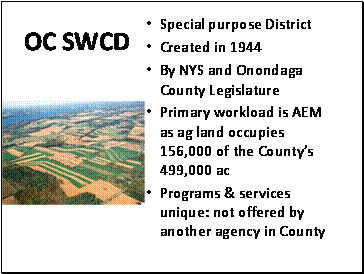
 
 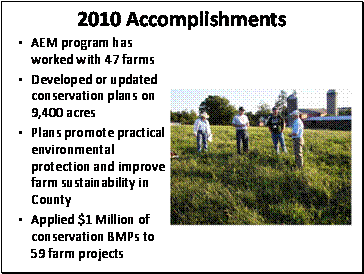
 
 
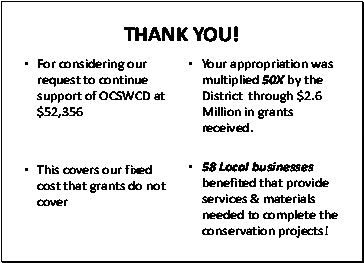 
In answer to Mr. Corbett, Mr. Berger confirmed that the funds received from the county assist in leverage for state and federal grant funds.
Mr. Corbett asked if reconstruction at Nine Mile, on the creek and the salt wells is acerbating the mudboils. Mr. Berger replied that they have been working closely with the hydro geologist from the United States Geological Survey. The mudboils cannot be stopped. They are one of two natural phenomenons in the world. They believe they need to mitigate the main source of the pollution load into Onondaga Creek. They have done this by depressurizing wells and through impoundment areas; helping to settle out the soil particles that have been suspended in the water coming out of the mudboils.
Mr. Warner asked how they were assisting landowners to prepare for gas production of Marcellus Shale. Mr. Berger replied that they guide landowners with water quality issues to accredited laboratories for water testing. They have held meetings in conjunction with Cooperative Extension and the City of Syracuse for those that are interested in pursuing a gas company lease. They advise them on the process and how to best protect their interest. They have been a sounding board for a number of rural landowners considering grouping together to get the most return in their efforts for a gas lease. Mr. Warner asked if there was any idea as to when hydrofracking would begin in NYS. Mr. Berger stated that he does not believe it will happen anytime soon, there are a number of road blocks to get through.
OFFICE OF ENVIRONMENT, pg. 5-7: David Coburn, Director; Rustan Petrela, Budget Analyst
Mr. Coburn gave the following presentation:
OFFICE OF ENVIRONMENT 2011 BUDGET PRESENTATION
2011 Budget: $180,788 (Interdepartmental charges comprise most of change from 2010 Budget)
100% of budget is charged against the Sanitary District and the Health Department Budget (65% and 35%, respectively).
The Office of Environment was created to help the County formulate environmental policy to reduce environmental liability, to act as a liaison with environmental regulatory agencies, to facilitate coordination between County departments, and to provide general assistance to departments that have environmental issues or questions. 2010 focus has also been on advancing the concepts of sustainability - reducing the County’s greenhouse gas emissions while reducing costs and fulfilling the County’s commitment as a Climate Smart Community.
Sustainability Initiatives:
- Joined ICLEI for access to its carbon footprint model; collaborated with ESF to collect and input data for GHG calculations.
- SOCPA working on a Sustainable Land Use Development Plan (update and replace the 2010 Plan).
- Green Infrastructure initiatives - part of the County’s CSO abatement plan will be an element of our Climate Action Plan.
- Purchasing Department has developed a green purchasing policy.
- Researching options in the development of policy on LEED (green buildings).
- Working with OCRRA on approaches to waste minimization.
- Implemented a reduced mowing initiative in 2010.
- Through the Energy Efficiency and Conservation Block Grant, pursuing energy auditing, installation and energy conservation measures and some retro-commissioning.
- Sustainable Fleet Subcommittee is investigating alternative fuel vehicles and exploring ways to “right-size” the County fleet, both in terms of the number and size of the vehicles in the fleet. Budget Department has developed a model to assist in examining optimum vehicle lifespan. Exploring moving toward standardizing the fleet re: makes and models for specified uses, which will allow standardization of our parts inventory. Also looking at fuel use and vehicle use.
- On Earth Day conducted Sustainability Fair to educate the County work force on how they can take steps to reduce their impact on greenhouse gas emissions, both at work and at home.
Office of Environment will continue to coordinate work on all of these initiatives in 2011.
Stormwater
2009 County Legislature passed a resolution authorizing the County Executive to enter into agreements with interested municipalities to perform stormwater permit compliance services associated with illicit discharges.
2010 regulated municipalities are complying with a new, revised Stormwater Permit that imposes even more rigorous compliance and reporting requirements on the County and other MS4s in the area, particularly those in the Onondaga Lake Watershed. To deal with this and other existing stormwater compliance challenges, the County has been partnering with the CNYRPDB to establish a coalition or association of municipalities in the Syracuse Urban Area to: foster communication, cooperation, explore cost-effective approaches to compliance and seek grant funding.
Onondaga Lake
Office of Environment represents the County’s interests on the Onondaga Lake Partnership (source of federal funding for ACJ projects). Last year secured $3 million in grant funds for sewer separation work required under the ACJ. This year secured $835,000 in grant funding for studies required by the ACJ in support of lake model development.
Also coordinate issues involving the Onondaga Lake Superfund Cleanup. In December will again ask Legislature to roll Honeywell Contingency Funds into the 2011 Budget. Current balance: $360,000. Current funds encumbered against the contract with outside Counsel: $45,000.
Focus of work this year: Waste Beds 1-8; Murphy’s Island, Lower Ley Creek; EPA and DEC cost recovery claim.
Air Quality
The County remains in compliance with carbon monoxide ambient air quality (annually submit CO traffic control plan)
Ground Level Ozone: Currently in compliance; standard likely to become more stringent.
Chairman Jordan asked Mr. Coburn’s view of rescinding county monitoring of the incinerator plant. Mr. Coburn responded that the monitoring effort is very localized and focused; not community wide. He believes the data collected demonstrates that there has not been a noticeable increase in any of the parameters they have been monitoring. It is a policy decision; should you duplicate the monitoring efforts required by the regulatory agency.
Mr. Corbett asked if artificial airflow under the I-81 Bridge would change the air quality testing. Mr. Coburn responded that the situation that placed us in none attainment for carbon monoxide required several unique circumstances to occur at once. The probe was underneath the I-81 overpass where we would have six lanes of idling traffic from cold weather start-ups, if there was an air inversion, a temperature inversion and winds out of the southeast in concert with these other factors the reading would spike during rush hour. They would also spike when we had incoming dome traffic at the same time as outgoing rush hour traffic. Since that time the probe has been moved back about 50 feet west. Newer cars and improved carbon monoxide conditions have resulted in a situation where we have not even come close violating the standard. It does not appear that we are in any danger of back sliding. Ozone is more the issue. We have the unfortunate circumstance of being in an ozone transport area. It is not that we are generating ozone here locally. It is more the air that comes into NYS and across Buffalo and Rochester is already so high in ozone that any small increments place us in a precarious predicament with respect to attainment.
Mr. Lesniak asked if there was a possibility of federal grant funding for the clean up of Ley Creek since GM has declared bankruptcy. Mr. Coburn responded that federal funding has declined over recent years. He understands that some of those funds are being made available for the main plant site. The lower Ley Creek portion is segregated from the main site. Initially, none of these funds were available for this portion. However, we are involved in dialogue with EPA, our federal delegation and Motors Liquidation to see if there is some way to deal with this.
WATER ENVIROMENT PROTECTION, pg. 5-31: Patty Pastella, Commissioner; Mike Lannon, Deputy Commissioner; Nick Capozza, Sewer Maintenance Engineer; Marty Voss, Personnel Admin.; Bonnie Karasinski, Fiscal Officer; Rustan Petrela, Budget Analyst; Tim Davis, Equipment Maintenance Supervisor
Ms. Pastella gave the following presentation:
 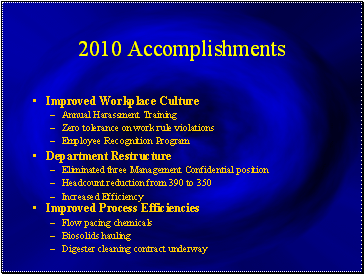
 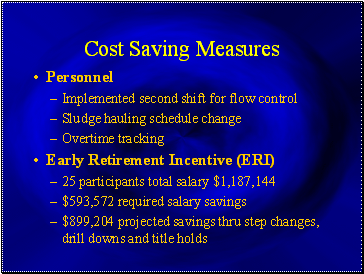
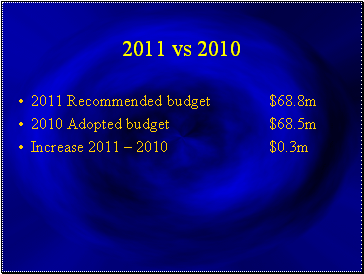 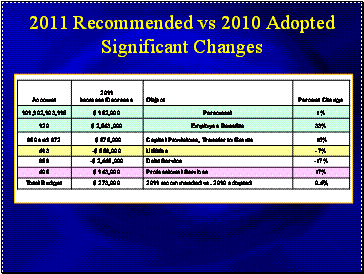
 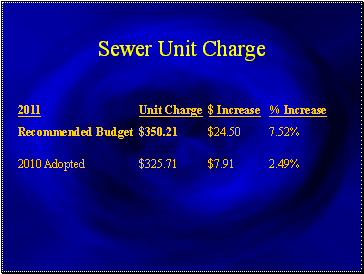
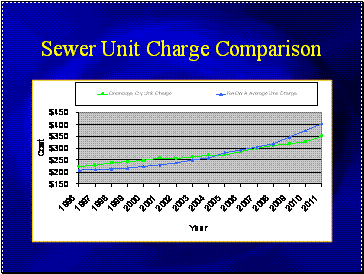 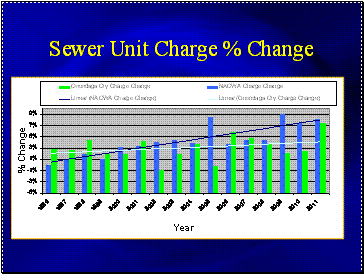
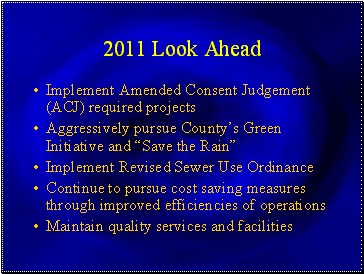 
Mr. Petrela provided the following handout on sewer unit charge projections:
Unit Charge Projections made in 2010 for 2011 and after |
|
|
|
|
|
|
|
|
|
|
Enter values in the cells highlighted in yellow |
|
|
|
|
Do not enter any value in the cells that are not highlighted ! |
|
|
|
|
|
|
|
|
|
|
|
|
|
20 Yrs PPU Projects |
30 Yrs PPU Projects |
Year |
Total to be borrowed with no Cash applied |
Cash (960) applied to offset debt |
Total to be borrowed if Cash is applied |
To be borrowed as EFC |
To be borrowed as GO |
To be borrowed as EFC |
To be borrowed as GO |
2010 |
$0 |
$2,500,000 |
$0 |
$0 |
$0 |
$0 |
$0 |
2011 |
$12,185,000 |
$2,200,000 |
$9,985,000 |
($200,000) |
$10,185,000 |
$17,100,000 |
$0 |
2012 |
$22,195,000 |
$3,800,000 |
$18,395,000 |
($1,000,000) |
$19,395,000 |
$0 |
$0 |
2013 |
$37,100,000 |
$3,900,000 |
$33,200,000 |
$0 |
$33,200,000 |
$11,500,000 |
$0 |
2014 |
$37,280,000 |
$4,000,000 |
$33,280,000 |
$0 |
$33,280,000 |
$10,000,000 |
$0 |
2015 |
$16,069,000 |
$4,100,000 |
$11,969,000 |
$0 |
$11,969,000 |
$8,000,000 |
$0 |
2016 |
$4,350,000 |
$3,350,000 |
$1,000,000 |
$0 |
$1,000,000 |
$6,700,000 |
$0 |
2017 |
$15,850,000 |
$2,500,000 |
$13,350,000 |
$4,500,000 |
$8,850,000 |
$5,000,000 |
$0 |
2018 |
$12,500,000 |
$2,500,000 |
$10,000,000 |
$4,500,000 |
$5,500,000 |
$2,200,000 |
$0 |
2019 |
$12,500,000 |
$2,500,000 |
$10,000,000 |
$4,500,000 |
$5,500,000 |
|
|
2020 |
$12,500,000 |
$2,500,000 |
$10,000,000 |
$4,500,000 |
$5,500,000 |
|
|
2021 |
$12,500,000 |
$2,500,000 |
$10,000,000 |
$4,500,000 |
$5,500,000 |
|
|
2022 |
$12,500,000 |
$2,500,000 |
$10,000,000 |
$4,500,000 |
$5,500,000 |
|
|
2023 |
$12,500,000 |
$2,500,000 |
$10,000,000 |
$4,500,000 |
$5,500,000 |
|
|
2024 |
$12,500,000 |
$2,500,000 |
$10,000,000 |
$4,500,000 |
$5,500,000 |
|
|
2025 |
$12,500,000 |
$2,500,000 |
$10,000,000 |
$4,500,000 |
$5,500,000 |
|
|
2026 |
$12,500,000 |
$2,500,000 |
$10,000,000 |
$4,500,000 |
$5,500,000 |
|
|
2027 |
$12,500,000 |
$2,500,000 |
$10,000,000 |
$4,500,000 |
$5,500,000 |
|
|
2028 |
$12,500,000 |
$2,500,000 |
$10,000,000 |
$4,500,000 |
$5,500,000 |
|
|
2029 |
$12,500,000 |
$2,500,000 |
$10,000,000 |
$4,500,000 |
$5,500,000 |
|
|
2030 |
$12,500,000 |
$2,500,000 |
$10,000,000 |
$4,500,000 |
$5,500,000 |
|
|
2031 |
$12,500,000 |
$2,500,000 |
$10,000,000 |
$4,500,000 |
$5,500,000 |
|
|
2032 |
$12,500,000 |
$2,500,000 |
$10,000,000 |
$4,500,000 |
$5,500,000 |
|
|
2033 |
$12,500,000 |
$2,500,000 |
$10,000,000 |
$4,500,000 |
$5,500,000 |
|
|
2034 |
$12,500,000 |
$2,500,000 |
$10,000,000 |
$4,500,000 |
$5,500,000 |
|
|
TOTAL |
$357,529,000 |
$68,850,000 |
$291,179,000 |
$79,800,000 |
$211,379,000 |
$60,500,000 |
$0 |
The projected budget for 2011 represents $24.5 or 7.52% increase in unit charge .
The available Fund Balance and RBD is $55,959,080 and the model recommends exhausting it by 2017 keeping a constant increase of sewer charge at 7.52%.
After 2018 the average sewer charge increase will be less than 3%.
|
|
|
Total Debt Service Due in 2011, No RBD Applied |
|
|
$15,579,752 |
|
|
|
RBD Applied, As recommended by the model |
|
|
$3,580,614 |
Inflation Rate |
3.00% |
|
Debt services to be entered in 2011 budget |
|
|
$11,999,138 |
Energy Inflation Rate |
5% |
|
|
|
|
|
% Revenue Change. |
2.00% |
|
|
|
|
|
% Increase of Unit Charge |
7.52% |
|
|
Fund Balance |
RBD |
Total |
Number of Units |
181,269 |
|
Applied |
$29,865,802 |
$26,079,655 |
$55,945,457 |
% Change in No. of Units |
0.00% |
|
Available |
$29,879,425 |
$26,079,655 |
$55,959,080 |
Discount Rate |
5.00% |
|
Difference |
$13,623 |
$0 |
$13,623 |
Year |
EXPENSES |
DEBT |
OTHER EXPENCES |
EXPENSES GRAND TOTAL |
Proposed Future Debt Svc (20 Yrs PPU) |
Proposed Future Debt Svc (30 Yrs PPU) |
TOTAL Proposed Future Debt Service |
Authorized and Unissued Debt Svc |
Scheduled Debt Svc |
TOTAL DEBT SERVICE |
Operating Budget without Debt and Energy cost |
Energy cost |
2010 |
|
|
|
|
|
$14,444,993 |
$47,766,567 |
$7,148,535 |
$69,360,095 |
2011 |
-$12,600 |
$794,800 |
$782,200 |
$15,011,107 |
$980,000 |
$11,999,138 |
$49,565,325 |
$7,194,440 |
$68,758,903 |
2012 |
$433,923 |
$792,162 |
$1,226,085 |
$4,176,000 |
$17,099,496 |
$22,501,581 |
$51,052,285 |
$7,931,870 |
$81,485,736 |
2013 |
$1,865,831 |
$1,327,290 |
$3,193,121 |
$10,553,284 |
$16,415,441 |
$30,161,845 |
$52,583,853 |
$8,328,464 |
$91,074,162 |
2014 |
$4,381,610 |
$1,803,536 |
$6,185,147 |
$10,359,052 |
$15,746,108 |
$32,290,307 |
$54,161,369 |
$8,744,887 |
$95,196,562 |
2015 |
$7,481,413 |
$2,178,979 |
$9,660,392 |
$10,164,820 |
$15,367,587 |
$35,192,799 |
$55,786,210 |
$9,182,131 |
$100,161,140 |
2016 |
$9,442,743 |
$2,502,537 |
$11,945,280 |
$9,970,588 |
$12,992,249 |
$34,908,117 |
$57,459,796 |
$9,641,238 |
$102,009,151 |
2017 |
$10,094,638 |
$2,741,217 |
$12,835,855 |
$9,776,356 |
$12,866,041 |
$35,478,252 |
$59,183,590 |
$10,123,300 |
$104,785,142 |
2018 |
$10,613,434 |
$2,857,237 |
$13,470,671 |
$9,582,124 |
$12,777,346 |
$35,830,141 |
$60,959,098 |
$10,629,465 |
$107,418,703 |
2019 |
$11,317,016 |
$2,866,983 |
$14,183,998 |
$9,387,892 |
$12,346,847 |
$35,918,737 |
$62,787,871 |
$11,160,938 |
$109,867,546 |
2020 |
$11,852,441 |
$2,879,435 |
$14,731,876 |
$9,193,660 |
$12,007,021 |
$35,932,557 |
$64,671,507 |
$11,718,985 |
$112,323,048 |
2021 |
$12,376,390 |
$2,887,294 |
$15,263,684 |
$8,999,428 |
$11,204,598 |
$35,467,711 |
$66,611,652 |
$12,304,934 |
$114,384,297 |
2022 |
$13,004,330 |
$2,891,165 |
$15,895,495 |
$10,399,517 |
$10,884,830 |
$37,179,842 |
$68,610,002 |
$12,920,181 |
$118,710,024 |
2023 |
$13,714,918 |
$2,897,764 |
$16,612,682 |
$10,156,727 |
$10,430,730 |
$37,200,139 |
$70,668,302 |
$13,566,190 |
$121,434,630 |
2024 |
$14,558,053 |
$2,901,058 |
$17,459,111 |
$9,913,937 |
$9,716,732 |
$37,089,780 |
$72,788,351 |
$14,244,499 |
$124,122,630 |
2025 |
$15,370,642 |
$2,902,267 |
$18,272,909 |
$9,671,147 |
$8,052,692 |
$35,996,748 |
$74,972,001 |
$14,956,724 |
$125,925,473 |
2026 |
$15,910,419 |
$2,903,304 |
$18,813,723 |
$9,428,357 |
$7,498,419 |
$35,740,499 |
$77,221,161 |
$15,704,560 |
$128,666,221 |
2027 |
$16,306,350 |
$2,887,921 |
$19,194,271 |
$9,185,567 |
$6,374,679 |
$34,754,517 |
$79,537,796 |
$16,489,788 |
$130,782,102 |
2028 |
$16,777,687 |
$2,884,667 |
$19,662,353 |
$8,942,777 |
$4,756,429 |
$33,361,559 |
$81,923,930 |
$17,314,278 |
$132,599,767 |
2029 |
$17,191,537 |
$2,873,029 |
$20,064,566 |
$8,699,987 |
$3,819,048 |
$32,583,601 |
$84,381,648 |
$18,179,992 |
$135,145,241 |
2030 |
$17,588,846 |
$2,857,199 |
$20,446,045 |
$8,457,197 |
$3,483,418 |
$32,386,660 |
$86,913,097 |
$19,088,991 |
$138,388,748 |
2031 |
$17,980,606 |
$2,844,700 |
$20,825,306 |
$8,214,801 |
$2,938,699 |
$31,978,807 |
$89,520,490 |
$20,043,441 |
$141,542,738 |
2032 |
$17,825,584 |
$2,832,261 |
$20,657,845 |
$2,911,394 |
$2,911,395 |
$26,480,634 |
$92,206,105 |
$21,045,613 |
$139,732,352 |
2033 |
$17,095,630 |
$2,819,526 |
$19,915,156 |
$2,878,247 |
$2,878,246 |
$25,671,649 |
$94,972,288 |
$22,097,893 |
$142,741,831 |
2034 |
$15,621,673 |
$2,809,917 |
$18,431,590 |
$2,839,254 |
$2,839,254 |
$24,110,097 |
$97,821,457 |
$23,202,788 |
$145,134,342 |
REVENUES |
Other revenue |
Sever Charge, No FB or RBD applied |
Sewer Charge, FB and RBD applied |
|
Sewer charge |
Unit Charge |
Increase in Unit Charge |
FB & RBD applied to offset Sewer Charge |
Sewer charge |
Unit Charge |
Increase in Unit Charge |
% increase of UCH |
Total FB & RBD Available |
$4,613,820 |
$62,940,837 |
$347.93 |
|
$3,900,000 |
$59,040,837 |
$325.71 |
|
|
$55,959,080 |
$3,943,090 |
$64,815,813 |
$357.57 |
$9.64 |
$1,333,924 |
$63,481,889 |
$350.21 |
$24.50 |
7.52% |
$54,625,156 |
$4,021,952 |
$77,463,784 |
$427.34 |
$69.77 |
$9,206,787 |
$68,256,996 |
$376.55 |
$26.34 |
7.52% |
$45,418,368 |
$4,102,391 |
$86,971,772 |
$479.79 |
$52.45 |
$13,580,484 |
$73,391,288 |
$404.88 |
$28.32 |
7.52% |
$31,837,885 |
$4,184,439 |
$91,012,124 |
$502.08 |
$22.29 |
$12,100,343 |
$78,911,780 |
$435.33 |
$30.45 |
7.52% |
$19,737,541 |
$4,268,127 |
$95,893,012 |
$529.01 |
$26.93 |
$11,045,488 |
$84,847,524 |
$468.08 |
$32.75 |
7.52% |
$8,692,053 |
$4,353,490 |
$97,655,661 |
$538.73 |
$9.72 |
$6,425,906 |
$91,229,755 |
$503.28 |
$35.21 |
7.52% |
$2,266,148 |
$4,440,560 |
$100,344,582 |
$553.57 |
$14.83 |
$2,252,525 |
$98,092,057 |
$541.14 |
$37.86 |
7.52% |
$13,623 |
$4,529,371 |
$102,889,332 |
$567.61 |
$14.04 |
$0 |
$102,889,332 |
$567.61 |
$26.46 |
4.89% |
$13,623 |
$4,619,958 |
$105,247,588 |
$580.62 |
$13.01 |
$0 |
$105,247,588 |
$580.62 |
$13.01 |
2.29% |
$13,623 |
$4,712,358 |
$107,610,691 |
$593.65 |
$13.04 |
$0 |
$107,610,691 |
$593.65 |
$13.04 |
2.25% |
$13,623 |
$4,806,605 |
$109,577,692 |
$604.50 |
$10.85 |
$0 |
$109,577,692 |
$604.50 |
$10.85 |
1.83% |
$13,623 |
$4,902,737 |
$113,807,287 |
$627.84 |
$23.33 |
$0 |
$113,807,287 |
$627.84 |
$23.33 |
3.86% |
$13,623 |
$5,000,792 |
$116,433,839 |
$642.33 |
$14.49 |
$0 |
$116,433,839 |
$642.33 |
$14.49 |
2.31% |
$13,623 |
$5,100,807 |
$119,021,822 |
$656.60 |
$14.28 |
$0 |
$119,021,822 |
$656.60 |
$14.28 |
2.22% |
$13,623 |
$5,202,824 |
$120,722,650 |
$665.99 |
$9.38 |
$0 |
$120,722,650 |
$665.99 |
$9.38 |
1.43% |
$13,623 |
$5,306,880 |
$123,359,341 |
$680.53 |
$14.55 |
$0 |
$123,359,341 |
$680.53 |
$14.55 |
2.18% |
$13,623 |
$5,413,018 |
$125,369,084 |
$691.62 |
$11.09 |
$0 |
$125,369,084 |
$691.62 |
$11.09 |
1.63% |
$13,623 |
$5,521,278 |
$127,078,489 |
$701.05 |
$9.43 |
$0 |
$127,078,489 |
$701.05 |
$9.43 |
1.36% |
$13,623 |
$5,631,703 |
$129,513,537 |
$714.48 |
$13.43 |
$0 |
$129,513,537 |
$714.48 |
$13.43 |
1.92% |
$13,623 |
$5,744,338 |
$132,644,411 |
$731.75 |
$17.27 |
$0 |
$132,644,411 |
$731.75 |
$17.27 |
2.42% |
$13,623 |
$5,859,224 |
$135,683,513 |
$748.52 |
$16.77 |
$0 |
$135,683,513 |
$748.52 |
$16.77 |
2.29% |
$13,623 |
$5,976,409 |
$133,755,943 |
$737.89 |
-$10.63 |
$0 |
$133,755,943 |
$737.89 |
-$10.63 |
-1.42% |
$13,623 |
$6,095,937 |
$136,645,894 |
$753.83 |
$15.94 |
$0 |
$136,645,894 |
$753.83 |
$15.94 |
2.16% |
$13,623 |
$6,217,856 |
$138,916,487 |
$766.36 |
$12.53 |
$0 |
$138,916,487 |
$766.36 |
$12.53 |
1.66% |
$13,623 |
In answer to questions Ms. Pastella and staff provided the following information:
●25 ERI participants
13 will be replaced full time
2 part time replacements
10 positions will be held until Sept. 2012
●$2,900 fishery overtime cost covers ACJ mandated fish sampling every spring and fall
Electro-shocking of fish done in the evening when they are feeding
●10 hours per week of overtime for plant maintenance inventory control
1 hour per day, for 2 employees
35 hour work week
●101 line covers seasonal aides and storm water support person
●215 clarification
LIPO - Lake Improvement Project Object
I/E - instrumentation and electrical
$79,400 equipment list includes a mower, forced main cleaning system, boat trailer, tractor, diesel trash pump and compressed natural gas fueling station
●Inventory control is broken down into 2 departments
Parts and equipment for all WEP, Parks and Sheriff’s Department vehicles
Parts and equipment for water treatment plants and pumping stations
Majority of the funding is in the steam and pump station equipment
●300 account includes:
$300,000 food household medical
Equipment and supplies used for water test sampling
$300,000 inventory control construction supplies
Maintenance for towns and villages
Purchase brinks, mortar, manhole covers, rings; everything a construction company would purchase
Back flow prevention on all County Facility buildings, plumbing supplies
These supplies are utilized to fill work orders as they are received
$1.3 million in fleet maintenance auto supplies
Maintain all departments within the county except Highway
No outside fleet maintenance, all in house
$47,000 for computer management
WEP operates its own IT Department due to the plant’s operating and monitoring system
System requires yearly upgrades
Computers are not purchased by the County IT Dept
$4.2 million listed for all other supplies includes over $4 million in chemical cost
●410 account includes 2.6 million for bio solids hauling
●Annual cost for all fleet maintenance including parts, salaries and fringe $1.2 million
●Tank replacement is part of the chemical bulk storage located behind METRO
●$15,000 cost for slow fill natural gas station; $7,500 reimbursed
●Sherriff’s Department is the only department purchasing fuel from WEP
Chairman Jordan asked why the hours could not be staggered for the two maintenance inventory personnel to avoid any overtime charges. Mr. Voss stated that the department has decreased staff from 5 to 2 in this area. They would like to eliminate this completely and have worked with their department to reduce overtime. In the next couple of years they would like to reduce it further. Mr. Jordan stated his question was not answered, they are not indicating why the overtime is necessary. Mr. Lannon responded that the overtime is needed due to the volume of work.
Mr. Warner asked if WEP was funding salaries for other departments. Mr. Voss answered they were. They cover 75% of 2 attorneys within the Law Department and 1/3 of an administration member. Mr. Warner asked what the cost was for the administration member. Ms. Pastella replied that it is $34,324; one third of the salary for the Physical Services Administrator. In answer to Mr. Warner, Ms. Pastella stated this amount is listed in the WEP 101 line. Mr. Warner asked if the amount was also shown in the County Executive’s operating budget. Mr. Seitz stated this amount would be reduced from the County Executive’s budget and charged to WEP.
Mr. Lesniak asked if the amount would be shown as revenue on the County Executive’s side. Mr. Seitz stated it would not. With a letter of distribution and each department is charged accordingly. In this case 2/3 of the salary is charged to the County Executive and 1/3 to WEP. Mr. Warner asked if this was a new practice. Mr. Rowley replied that it was consistent with the way it was budgeted last year. He does not know how it was handled in the former administration. Mr. Warner stated that the County Executive’s budget is actually $34,324 more than what is shown. Mr. Rowley confirmed this was correct. Mr. Warner asked what happened to transparency. This is an issue that has been consistently preached about by the County Executive and here we have $34,000 that appears to be hidden.
In answer to Mr. Warner, Mr. Britt stated that the last audit of WEP was performed in 2009. Mr. Warner stated it appears that WEP is covering for some of the cost going on in the county. The sewer use charge is being increased due to the WEP budget. Mr. Warner asked if the Comptroller’s office had an opinion on this practice. It appears that the true cost of running the County Executive’s Department is hidden. Mr. Rowley responded that they are charging out administrative cost in the County Executive’s office to be consistent with what was done last year. In some cases the salaries are reimbursable from state aide; this is the bases for allocating salaries to other departments. If they do this for one department that is aide reimbursable, they have to be consistent for all salaries within the Executive’s office.
In answer to Mr. Warner, Mr. Rowley stated that departments other than the County Executive have letters of distribution within the county system. Mr. Warner asked for a list of all departments with letters of distribution. Mr. Rowley stated that he would have the report completed by this afternoon.
Mr. Warner asked if a contribution was made to Jazzfest from WEP. Ms. Pastella replied that it was part of their Save the Rain Campaign. The $10,000 contribution was made for marketing and promoting green infrastructure. Mr. Warner stated that it seems inappropriate to be contributing this kind of money to Jazzfest in these times. Ms. Pastella added they do other functions and festivals as well. It is critical to the success of their program. Mr. Warner stated it seems as if the WEP is an easy department to tap into with a large budget.
In answer to Mr. Lesniak, Ms. Pastella stated that the $200,000 increase in the 972 account is for additional marketing and sponsorship of the Save the Rain and green infrastructure programs for 2011. Mr. Lesniak asked for a list detailing the transfer to grant programs starting figure, where the money has been spent to date, and what the intended use is for the extra $500,000 in 2011.
Mr. Lesniak asked what caused the 408 line to be modified and increased by $400,000 from the 2010 adopted budget. Ms. Karasinksi replied that the modified figure represents contract carryover funds for dollars that were not expensed. Mr. Lesniak asked for a list detailing which contracts caused the increase.
Mr. Lesniak asked why the 082 line was decreased going from $3.9 million in 2010 down to $1.3 million in 2011. Mr. Petrela responded that this amount is the fund balance determined by using the model for the sewer charge increases. Mr. Rowley added that the model determined the amount of fund balance to be used. The funds used to smooth out the model are both fund balance and reserve for bonded debt in the WEP Department. Ms. Pestella stated that their debt expense is low this year compared to last year. Last year they made a concuss effort to use more reserve for bonded debt and less fund balance. They intend to continue this practice into the future. Reserve for bonded debt is much more restricted in its use; fund balance is much more pliable. They will be draining the reserve for bonded debt over the next few years and retaining more fund balance to smooth out the model for the future.
Mr. Corbett stated that page 5-34 of the budget book explains the sewer unit charge. The unit charge will increase by $24.5 (7.52 %) to $350.21. This increase is consistent with the model calculations for 2011. An amount of $1,333,924 from fund balance and $3,580,614 from reserve for bonded debt was applied to keep the unit charge at a reasonable increase as discussed in previous years. He questioned the $2,200,000 cash amount to be applied in 2011 listed under the 20 year PPU Projects on the handout. Mr. Petrela stated that they have projects that they use 960 funds for. They are not borrowing this money therefore it is not figured into debt services. Costs are entered and the model is updated every year. Part of the future cost will be to pay as you go and part will be borrowed. Mr. Corbett stated that he is concerned that the fund balance and reserve for bonded debt will run out. He asked if there was a projection as to the amount of future reserve for bonded debt necessary to preserve the model. . Mr. Petrela replied that the amount of money being applied each year to offset the sewer use charge is listed through 2017. This is the year the model foresees that all fund balance and reserve for bonded debt will be exhausted. (See the REVENUE TABLE under the first column FB & RBD applied to offset sewer charge).
In answer to Mr. Lesniak, Ms. Karasinski stated the 060 account funds are derived from the Sheriff’s Department reimbursement for fuel and vehicle repairs. A small debt service reimbursement is received from Parks. Mr. Rowley stated that $1.2 million comes from fleet maintenance charges. Mr. Lesniak requested a breakdown of the interdepartmental revenue by department.
Mr. Lesniak asked for more information on the requested increase of $200,000 for green education and outreach. Ms. Pastella replied that this is their campaign to make sure that green infrastructure is a success. It is the public education and outreach program they will be instating in 2011. They need to get residents and businesses to participate in their green program. The plan includes marketing, advertising and showcasing their green building at fairs and in communities. It also includes a contract with EFC to promote rain gardens, green roofs, porous sidewalks and pavements for schools, libraries, playgrounds. Mr. Lesniak asked it these funds would be used toward paying personnel cost for manning the booth, etc. Ms. Pastella replied that the cost of personnel is included in their 101 line. It includes everything else that is required; such as seed packets given out, rain barrels, and planting trees.
Mr. Lesniak asked why the budget increase was low yet the sewer unit charge is being increased by $24.00. Mr. Petrela replied that this was because in the requested budget the amount of fund balance applied was a much as last year; which was 3.9 million. The model determined a need of $1.3 million. They decided to go with the figure determined by the model.
Mr. Warner stated that it appears as though $110,000 of the County Executive’s office is being subsidized through other departments such as Van Duyn, WEP, and Economic Development. The sewer unit charge is going up $24.00 and has doubled since 1996 based on WEP’s budget. Mr. Warner asked Mr. Britt for a letter from the comptroller regarding the authenticity of the letter of distribution process.
Mr. Millea stated that the rate increase is certainly not something that is taken lightly by WEP or the County Executive. They are under orders to do a significant amount of capital improvements in a short period of time. They are in a difficult situation. If they don’t smooth out the rate increases required to complete the improvements now, we will simply have to do it later. There are fixed costs due to the ACJ that will drive up these rates. The model demonstrates that if increased rates are not done on a slow and steady pace they will be savvier down the road. They are borrowing the money as cheaply as they can, saving millions of dollars worth of interest. Capital is necessary to move these projects forward.
Mr. Rhinehart asked if any of the 50 green infrastructure projects for 2011 were all located within the City of Syracuse. Ms. Pastella replied that they are in the CSO areas. Most likely all are in the city; she did not have the list with her. Mr. Rhinehart asked for a list of the green projects for 2011. In answer to Mr. Rhinehart, Ms. Pastella stated that they we would be bonding for the green projects. Mr. Millea stated they would also pursue grants for these projects. Mr. Rhinehart requested a list of the green projects, where they are located and their dollar amounts. Mr. Millea stated that he would be happy to do a special briefing on this as soon as he has a list. The County Executive has not been briefed. Mr. Rhinehart pointed out that the projects are in the budget. He would like to know what has to be done before he faces the taxpayers with increases. Mr. Millea responded that they would get together very quickly and brief the legislature on the plan. He added that Ms. Pastella and he would have to sit down and prioritize. They have a list much larger than 50 projects. Ms. Pastella stated that this was a preliminary projection based on the list generated by the consultants. Mr. Rhinehart stated that he would like to take a look at the list. The sewer users paying this tax encompass more than just city tax payers. There are taxpayers outside of the city that are in the sewer shed and would like to see money going towards improvements to their area as well.
In answer to Mr. Rhinehart, Mr. Petrela stated the reserve for bonded debt is $26.1 million and the designated fund balance is $29.8 million as of July 2010. At this point in time he does not expect much change in these figures through the end of 2010.
In answer to Mr. Rhinehart, Mr. Davis stated they are associated with close to 1200 pieces of equipment. This is everything from a weed whacker up to a bulldozer. Mr. Rhinehart asked the number of trucks and cars. Mr. Davis confirmed a light estimate of 600 cars and trucks are going through the shop. They process just under 5,000 work orders per year. Mr. Rhinehart questioned the turn around time. Mr. Davis stated that they do not have a large parking lot and 12 of the cars are for personnel. He stated that the Sheriff’s Department was not good about picking up there cars. Mr. Rhinehart stated that he goes by the lot twice a day and there are always a number of vehicles. He is not referring to the cars involved in accidents. If the county tax payers are buying vehicles they should be used. Mr. Davis stated they have a big turnover of vehicles arriving 24 hours per day.
In answer to Mr. Rhinehart, Mr. Voss stated that the plant and fleet inventory are located in different buildings. Fleet maintenance has just expanded their area to make it more efficient. In answer to Mr. Rhinehart, Mr. Davis stated that they have $168,000 in fleet inventory. Mr. Lannon replied that he did not have the exact figure for plant inventory; probably over $2 million. Mr. Rhinehart asked for the exact inventory figure.
Mr. Rhinehart stated that repair shops no longer keep inventory. Parts are ordered and delivered the same day. Mr. Davis replied that this just doesn’t happen in the real world. The parts dealers are not stocking the inventory they used to. At the moment he is having a problem getting 17” Goodyear tires for the patrol cars. He has 28 new cars coming in that need tires. He is working on this with Goodyear. It has happened before. In answer to Mr. Rhinehart, Mr. Davis stated he had communicated this information to the Sheriff. Mr. Rhinehart questioned why the Sheriff would purchase 28 cars requiring the same tires that are not available. Mr. Davis stated that this is not an every year occurrence, it is spotty. Mr. Rhinehart asked if the cars would be parked until the tires were located. Mr. Davis replied that they will find something. In the past they have had to use a different tire.
In answer to Mr. Rhinehart, Mr. Davis stated he has 12 mechanics, 2 supervisors, 1 laborer, 1 tow truck operator, and 1 clerical staff.
In answer to Mr. Rhinehart, Mr. Davis stated that they have a small flatbed wrecker. They tow for everyone in the county including the Highway Department. Mr. Rhinehart asked how he handled the towing of large tanker trucks. Mr. Davis stated that he calls the Highway Department. If they are not available he uses an outside vendor. Mr. Rhinehart asked about the cost. Mr. Davis responded that it is very costly. To have a ten wheeler towed from Great Northern Mall to the Metro plant cost $700.00 recently. Mr. Corbett added that in the DOT presentation they stated that if they had to call for a large wrecker such as Big Red, the fee is $1,500 per tow. Mr. Rhinehart stated he was aware of that. He was looking to see if the fee was the same for all departments. Mr. Davis stated they did not use Big Red, but the distance changes the cost.
Mr. Rhinehart asked if all 14 vehicles requested for replacement were pickup trucks. Mr. Davis replied, “No”. The first 4 vehicles are four-wheel drive plow trucks. They are requesting 5 vans; in some cases replacing pickup trucks. The vans are used for HVAC covered equipment and are more versatile.
Mr. Davis stated that they have requested an aquatic which is a revenue piece of equipment. In answer to Mr. Rhinehart, Mr. Davis confirmed this was a replacement not an addition. Mr. Capozza stated they have a total of 6 in their fleet. They are looking to replace a straight flusher. This will eliminate the need for personnel to actually go down into the sewer and perform confined space entry. It is a health and safety issue. This vehicle is also used to perform contracted maintenance work within towns and villages in the sanitary districts. Mr. Rhinehart asked if the aquatic could be leased instead of purchased. Mr. Capozza stated that they had investigated this several years ago with two local vendors. They have lease to purchase plans over five years. When they did the basic math it was more expensive. The vehicles have to be replaced more often and there was a substantial interest rate. The lease does not include maintenance. Mr. Rhinehart asked what the plan would be if the county decided to get out of the repair business. Mr. Capozza responded that they would have to arrange for service with a local vendor. Mr. Rhinehart stated the private sector has been doing this for years and has survived. Mr. Davis responded the private sector does not have this variety of equipment. Mr. Voss added everyday that the aquatic is out of service is lost revenue. They bill out $700.00 per day for this piece of equipment when it is in use. If it breaks down, it is a priority to have it repaired. In house the repair bills are close to $10,000 for this equipment. Sending it out for repair would more than double the cost.
Mr. Voss added that sludge hauling tankers are also very expensive to maintain. They must be operational. If sludge backs up and can’t be hauled that creates a real problem. Mr. Rhinehart asked if an outside vendor was hauling this. Ms. Pastella stated the bio solids are being hauled by an outside vendor. The county is hauling liquid sludge from the outlying treatment plants to the METRO processing. Dewatered bio solids are transported to Seneca Meadows. This is the next step.
Mr. Lesniak asked for a time table for maintenance; showing when the vehicle are received and completed. Mr. Davis replied that with the current software it would be hard to achieve. Each mechanic would have to be on live time; having a computer on the floor that would enter in and out time. They have one clerical person to process the work orders. He could provide a rough idea. Mr. Lesniak stated that they have to get more efficient or find another way of doing this. Mr. Davis replied that he believes his department is very competitive with the outside world. Mr. Lesniak stated that if a vehicle is dropped off for an oil change, he would hope that the vehicle was back in the fleet mode the next day. Mr. Davis replied that depending on work load and staff it is out of there within a day. The District Attorney’s office makes appointments. They drop off at 8:00 a.m. and the work is completed by 10:00 a.m. The normal oil change is only 15 minutes. However, they do a 21 point preventative maintenance check and rotate all the tires. Nothing goes out the door unsafe.
METROPOLITAN WATER BOARD, pg. 5-80: Holly Rosenthal, Administrative Director; Fred Picardi, Chairman; Rustan Petrela, Budget Analyst
Ms. Rosenthal gave the following presentation:
MWB generates its operating revenues and some capital project funding through their rates. They have been doing less with less for a long time. It has been a tight budget for many years. The staff has been resourceful and creative in keeping the expenses down but to some extent to a detriment to our system. It has been a long term practice at MWB to cut our own budget before it ever comes here. There hasn’t been fat in out budget for many, many years. If you know the history of the Metropolitan Water Board you know it was a great vision for our community in the early to mid 1960’s. It was a premier example for regional water utilities at that time but now we are at the trailing end in comparison to other water utilities. We are faced with immanent failure, unnecessary energy expenses, expensive or unavailable parts for our aged equipment and productivity inefficiencies with our staff because of lack of automation and technology. I am not here to sound an alarm. I am just here to make you aware of what are needs are going forward. Also to make sure that you know we have a knowledgeable and dedicated staff that is ready to advance the ambitious program that we are proposing today.
 
From the Lake Ontario Intake and our Raw Water pumping station in to the Terminal reservoir at our Clay Administration Center heading east and west to new tanks replacing our open reservoirs
 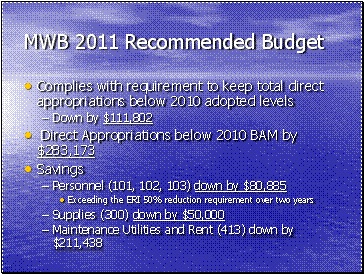
Personnel: Early Retirement Savings combined with a more efficient staffing plan; Supplies down through collaboration with other water utilities and County departments; Utilities down from reduction in energy use for pumping due to a reduction
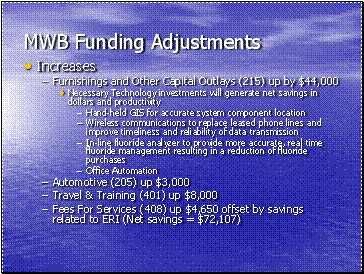
Restoring safety training previously cut. Training for skills required in promoted positions. On-line or on-site training
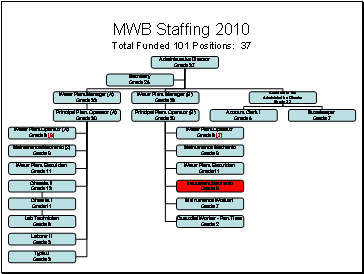 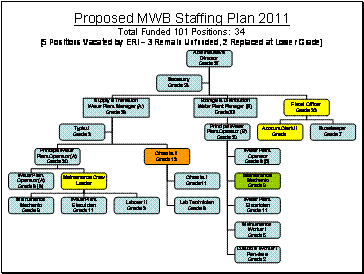
 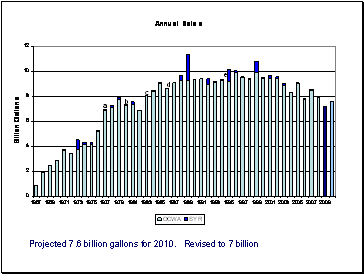
 
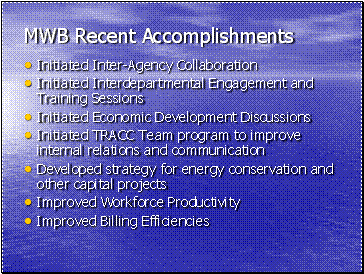
In the 10 weeks that I’ve been on board, in addition to the Budget process and ERI, we’ve accomplished the following:
 
 
 
 
 
Ms. Rosenthal provided the following handout:
Recommended Budget |
|
|
|
Projected Sales (Gallons/Year) |
7,000,000,000 |
|
|
Total Metered Water Sales (2140 Acc) Needed to Balance the Budget* |
$ 7,564,099 |
Proj. Rev. from Town of Hanibal |
$ 22,000 |
Water Sales to OCWA |
$ 7,542,099 |
|
|
Peak Day Demand (Gallons/Day) |
28,767,123 |
Charge per 1000 gallons |
$ 3.85 |
Annual Charge Related to Peak Day |
$ 1,329,041 |
|
|
Water Sales to OCWA Net of Peak Day Charges |
**$ 6,213,058 |
Commodity Charge
(per 1000 gallons per month) |
|
|
|
|
|
Current Rate |
Rate Increment |
New Rate |
|
First |
Gallons/Month |
$/1000 Gallons |
$/1000 Gallons |
$/1000 Gallons |
Annual Charge |
Next |
30,000,000 |
$ 0.83 |
$ 0.0802 |
$ 0.910 |
$ 327,675 |
Next |
80,000,000 |
$ 0.82 |
$ 0.0802 |
$ 0.900 |
$ 864,200 |
Over 290,000,000 |
180,000,000 |
$ 0.81 |
$ 0.0802 |
$ 0.890 |
$ 1,922,850 |
Total |
293,333,333 |
$ 0.80 |
$ 0.0802 |
$ 0.880 |
$ 3,098,333 |
|
583,333,333 |
|
|
|
$ 6,213,058 |
|
|
|
The Rate increase is rounded up to |
$ 0.09 |
|
|
|
|
*This Calculation reflects the use of $200,000 from Fund Balance |
|
|
**This is what we need to make out of our projected sales
In answer to questions Ms. Rosenthal provided the following information:
●5 ERI participants
2 ERI positions will be replaced
3 personnel will be moving from one title to another within the organization
Vacant positions will be unfunded
$80,000 net in ERI savings the first year
●$.09 increase will generate approximately $620,000 in revenue
In answer to the Chairman, Ms. Rosenthal replied that there is a high risk situation particularly in raw water. At the same time it is a high energy expense but the risk is certainly the driving factor. The primary concern is motor failure. There are 7 motors all with the same vintage and 800 horse power. We are fortunate that we have not been using the full capacity of our system. We have been able to shift some of the motors around from one facility to another. However, at this point we are concerned about transporting them, not sure the motors can with stand the transporting. The Chairman asked for explanation as to the difference in repairing verses replacing the motors. Mr. Rosenthal replied that the only responsible course of action is to reevaluate and design the primary pump stations. One is associated with the terminal tank projects so it is something that we would be advancing anyway. The other is the raw water station and perhaps Clearwater. They are the front end of our system; bringing water into the county. All have significant potential for energy savings by updating these projects, while at the same time securing the reliability.
The Chairman stated the critical question remains what is the cost of repair verses cost for replacement and potential energy saving if replaced. Ms. Rosenthal replied that done correctly, a substantial portion of these projects would result in no net impact to the tax or rate payers. We would be using the energy savings to pay the debt service on the capital projects. This is finite because there is only so much energy that they would be able to save but they anticipate it to be pretty substantial. They currently have a $2 million utility bill. In answer to the Chairman, Ms. Rosenthal stated that they are not far enough along in the process to project the amount of energy saving they can expect. Through the competitive design process they would be looking for adequate innovation to drive a 25% energy savings. Mr. Petrela stated that the capital book estimates to save over 1 million kilowatt hours per year for just one pump.
Mr. Lesniak asked if there was any thought to outsourcing the personnel in Oswego. Ms. Rosenthal replied that they have and have spoken with AQUA in this regard. She believes it is more efficient to have the lab than to outsource it. There are times when they are trying to make critical decisions about water quality. They are able to get immediate results through their own personnel. One of the things that they have talked about in terms of trying to optimize the lab is to be a source for other smaller utility testing. They have talked to AQUA about regionalizing so that both of the labs could be used to do testing for other utilities and agencies generating some revenues. Testing could be performed for each other optimize the geography of the laboratories. Samples would be taken to the lab located within the closest proximity. Mr. Lesniak asked for a listing of what the outsource cost would be verses having their own personnel by 5:00 p.m.
Mr. Lesniak stated that there are 2 upgraded positions listed in the budget book. Ms. Rosenthal responded that they have eliminated the Assistant to the Administrative Director and replaced that position with a Fiscal Officer. Mrs. Rosenthal confirmed that this was the same grade starting at a lower step. They believe the duties being performed are more aliened to the fiscal officer. The current Account Clerk 1 would be advanced to an Account Clerk 2 and is currently performing the work of an Account Clerk 2. In answer to Mr. Lesniak, Ms. Rosenthal stated they would be unfunding the Account Clerk 1 position.
Mr. Lesniak questioned the Water Plant Manager B position going from a grade 32 to a grade 33 and the Principal Water Plant Operator B going from a grade 29 to a grade 30. Ms. Rosenthal stated that the way the system is set up between supply/transmission and distribution/storage there is a water plant manager for each side of their business (A & B). A number of years ago there was a reevaluation and it was recommended that the positions on the B side (distribution/storage) be changed. We think that this was inappropriate and that those positions should be restored to be on par with the A side (supply/transmission). They have done a lot of leg work to justify these positions. In addition, the principal water plant operator is now managing staff that is making more than the manager. Mr. Lesniak asked what step they are in now and what step is proposed for the upgrade. Mrs. Rosenthal answered they are proposing to advance them one complete grade from step to step. Mr. Lesniak stated they would then get a six step addition on top of this. Ms. Rosenthal stated their peers would receive the six step increase as well. Even with the increased compensation there employees are on par or below the national average for water utilities. Mr. Lesniak stated these are pieces of concern with the economic environment and the proposed tax rate increases. Even though your increase does not come from the actual tax rate, we have others in this budget book proposing the same thing. If the position is taken to not allow these increases it will apply to all. Ms. Rosenthal replied that this would be really problematic for them because they have made some staff changes and promotions based on being able to put personnel on par with people of their industry. Mr. Lesniak stated that they should have waited. Ms. Rosenthal added that their wages are substantially lower than AQUA. They have people that are managing others making more money than they are because they have been held in Management Confidential positions. Mr. Lesniak responded that the 6 step increase was used to try and address some of this. They knew it would not fix everything. Ms. Rosenthal stated this was something separate and apart from that. This was something that was fine and got broken and we are trying to fix it again. She has had conversations with legislators that the preference would be to pay fewer people more money than to pay a lot of people less money. This was the strategy they used as well. It is very important to them that they be able to make the grade increases, particularly in these 2 positions.
In answer to Mr. Lesniak, Mr. Petrela stated that there is no increase to debt service for 2011 for any of the infrastructure projects discussed today. They are in the capital improvement stage. Nothing has been authorized as of this point. Once the capital improvement plan has been approved the debt service increases will be in the following year.
In answer to Mr. Lesniak, Ms. Rosenthal stated that the $600,000 in the 960 line was focused on automation and SCADA upgrades primarily for the water treatment plant in Oswego. Because of the water sales shortfall for 2010 they have not been able to spend those dollars for improvements this year.
Mr. Lesniak asked if there was any discussion with AQUA as to what the commercial water rate would be. Ms. Rosenthal replied that their decisions have been very general. Industrial rates are different and the economic impact of those rates is considered before making any change. It is not an across the board increase to both industry and residential. There is a balance between the two. At this point they have not talked about it in enough detail.
The Chairman asked if there was a position that MWB could forgo in order to offset the step increases if they were allowed. Ms. Rosenthal replied that she looked at the ERI savings plan as an overall savings plan for the MWB. Even with the step increases they substantially exceeded the 50% salary savings required over the two year period. They feel justified in each of the changes they are making. They are going to be down 2 operators, this is pretty substantial in itself. Mr. Petrela added the 101 line is down 6% from 2010 and the number of funded positions decreased from 37 to 34.
In answer to Mr. Corbett, Mr. Petrela stated the $200,000 listed under the 082 line is money used to keep the water rates at the reasonable $.09 increase. Mr. Corbett stated that this was the same as with WEP. We are supplementing to maintain a minimal increase.
Mr. Corbett stated that bio fuels are now up and running in Fulton and additional business are projected to be coming in 2011. He asked how this would affect the 2011 projected sales. Ms. Rosenthal replied that both MWA and AQUA have taken this into consideration. Once again it depends on the weather as to exactly where we will fall but we do expect to be in the $7 to $7.2 billion range.
In answer to Mrs. Rapp, Ms, Rosenthal stated they sell water to the town of Hannibal. Mrs. Rapp asked if this was something that could be more vigorously pursued. Ms. Rosenthal stated that within the past 10 weeks they have had some preliminary conversations in this regard. She thinks there is an opportunity to do more of this. Mrs. Rapp added this might be a way to increase the revenue side.
Mrs. Rapp asked what the total debt is for the MWB. Mr. Seitz responded page 6-13 of the budget book shows the bonded debt. There are 3 outstanding issues listed totaling $514,357.
Mrs. Rapp added that she is convinced that the pump needs to be fixed and doesn’t see anything in the budget for 2011. Ms. Rosenthal confirmed that it is in the capital plan. However, they are considering a performance contract if the upgrades could be completed sooner. Mrs. Rapp added that she is concerned for the county should this pump fall. Ms. Rosenthal stated they share her concern. This pump station is the primary source of water intake for the Onondaga County Water District.
Mr. Picardi stated the free fall in water usage should reach the bottom at some point. The antidote to this is to sell more water. He believes that selling to municipalities outside of the county is the answer. Inquires are becoming more numerous all the time. Some of these sales purportedly run into other policies of the county. They are reluctant to do anything in this regard because of the problems presented. In fairness to the rate payers and to avoid future dilemmas as experienced today this is something that should be looked at very carefully. Mr. Picardi will provide a list of the inquiries.
The meeting was adjourned at 12:22 p.m.
Respectfully submitted,
Katherine M. French
Assistant Clerk
* * *
WAYS & MEANS COMMITTEE – 2011 BUDGET REVIEW OF WAYS & MEANS DEPARTMENTS
September 24, 2010
CHAIRMAN CASEY JORDAN
MEMBERS PRESENT: ***Mr. Corbett, Mr. Lesniak, Mr. Holmquist, Mr. Buckel, *Mr. Warner, **Mr. Stanczyk
MEMBERS ABSENT: Mr. Kinne, Mr. Kilmartin
ALSO PRESENT: Chairman Rhinehart, Mrs. Tassone, Mr. DeMore, Mrs. Ervin, Mr. Masterpole, Mrs. Rapp, see also attached list
Chairman Jordan called the meeting to order at 9:02 a.m.
COMPTROLLER, Pg. 3-17 – Robert Antonacci II, Comptroller; Phil Britt, Deputy Comptroller–Auditing; James Maturo, Deputy Comptroller-Accounting
Mr. Antonacci provided the following presentation:
Last year, during one of the most difficult budgets our county ever witnessed, my budget presentation was very short.
The briefness of the presentation was of no disrespect to this committee but rather a reflection of our commitment to share the pain as other departments would be asked. As our departmental budget is almost entirely personnel, we informed the committee of this recognizing our department was already lean and efficient with no fat to trim away unless and only if personnel cost. We respectfully note our data indicates the Comptroller’s Office has the lowest budget growth since 2000 of all elected officials and most other departments. Since my election we have reduced positions from 37 to 32 and reduced our overall appropriation by 7.7 percent.
This year I beg the committee’s indulgence, as your independently elected Comptroller, I must take the time to explain our budget request and its importance to our taxpayers. My request flows from the responsibilities accorded the office by our county charter and administrative code.
While my office has eliminated four positions from the 2009 adopted budget, accepted without question our 2010 allocation, and to meet the goals of 2010 we have held positions, revisited priorities and searched for grant funds, we feel our office must be funded as requested. (SLIDE 2- reference new deputy, but held position to meet 2010 goals)
Some may argue you must spend money to make money. As a CPA I have always viewed this as spending money strategically to grow a business. After all resources are usually limited no matter the business
In government, there are opportunities to make strategic investments, but in the case of the Comptroller’s office, it is spending tax dollars to save and protect tax dollars. It is making those needed investments to save even more money in the future.
Our community needs an accounting and auditing team to sort out the complexity of government spending and lead in the modernization of all governments. (SLIDE 3)
Some may say this budget season will be a watershed budget, wherein critical choices are made as to which services county government should or must offer.
Our county continues to develop cutting edge ideas. For example my office supported initiatives recommended by the Executive involving green infrastructure by naming a Green Auditor. We recognize these new ideas come with risk and ultimately we must answer to the community for these choices. A real-time Green Auditor will provide the county with assurance every effort will be documented and appropriate. While it may not insure success, together we can report efforts were maximized.
Another initiative of assigning auditors to specific, technical subjects included construction claims. The county continues to invest heavily in construction projects. Auditing these contracts and claims, especially those in litigation takes time and expertise. The risk associated with these items is great due the large dollar amounts generally associated with these projects; accordingly there is great benefit of continued oversight.
We have recognized the importance of our economic development engines but they need oversight, guidance and some times a partner. Hotel/Motel operators continue to compliment our ROT auditors even as our work protects the integrity of the tax process and finds additional revenue. The Oncenter will be a productive partner as we all work to maximize economic impact of our strategic investments.
We have recognized the need to invest in new computer systems but implementation takes people and time. We support the county’s initiative to invest in new computer systems. However the implementation stage will be time consuming and require the best and the brightest accountants we have to run our accounting parallel for some time. We cannot reduce accounting personnel while doubling the workload.
Another positive of our new software will be the potential to offer this technology to other local municipalities. With all local governments being on the same accounting software, speaking the same language, using a uniform system of accounts, information can be compared easily, cost saving measures will be identified much sooner saving our community from increased property taxes.
My office has heard the Executive’s message of doing “less with less” and we understand and support her efforts. However we respectfully suggest in the accounting world some things must be done.
For example, accounting entries and claims continue at normal or above normal volume. While we have re-directed audit efforts, the county must continue with its internal control structure and yearly audit or risk loss of state and federal funding and jeopardize our treasured bond rating.
Our payroll department continues to audit payroll and assist with payroll issues involving contractual payments and retirement verifications. Our payroll department will be in high service as KRONOS continues to be implemented and we convert to People Soft. (SLIDE 4, 5, 6, 7, 8 and 9)
While we are submitting a requested budget with another work force reduction we respectfully suggest committing to any new initiatives will require we maintain our staffing with the requested level of fully funded positions.
The sales tax sharing agreement highlighted the need for consolidation, shared services and other money saving ideas- but how do we get there? (SLIDE 10 & 11)
We are willing to specifically designate an auditor whose sole function will be to identify and analyze cost savings ideas to include consolidation, shared services and other integration ideas. Our audit team with appropriate funding would be known as CSI- Onondaga. The play on the successful crime-fighting drama would stand for Consolidation, Sharing Services, Integration and Information for Onondaga County’s governments and quasi-governmental entities. (SLIDE 12 & 13)
The County Executive has rightly proclaimed it does not matter where our taxpayers pay their already overburdened property taxes. If we do not collectively reduce the overall property tax burden it will not matter if one government cuts cost only to see another raise taxes.
As a community we pay over $815 million in property tax. How can we keep all governments accountable to our citizens with our current myriad of taxing authorities?
“One Bill” is the answer. Every “tax force” needs a report card and with the concept of “One Bill” it will be done for CSI-Onondaga. Any taxpayer in our county will be able to determine the cost of local government, the cost from year to year for city, county, town, village, school property taxes, sales tax, water charges and other fees local governments assess.
In the end it will be simple to compare the results from year to year and be held accountable for one goal- did we reduce the cost of government?
Some of the ideas CSI-Onondaga will get right to work on involve purchasing, accounting and personnel centralization, sharing of municipal legal services, real property tax collection and assessment, public safety and judicial services, and delivery of water.
Our budget reflects a part time audit/modernization person. With the retirement of an Auditor 3, we will generate savings as requested by the early retirement incentive and convert this position to the part-time position. Our hope is to find a qualified person to assist us with this important task. When this engagement no longer requires the individual we will search for another individual with skills needed in another area like construction or Medicaid fraud.
In a recent committee meeting involving consolidation, a concern was raised as to which issues the county should take the lead. Our concern is the allocation of resources so those stakeholders desiring our help and input will have the option. There is a void in our community for a one-stop shop for verifiable, audited financial data when it comes to these important modernization decisions.
Too often we see the debate on these consolidation and modernization issues mired in misinformation or “spin” of data. Our goal and desire is fill that void so decision makers can confidently make the difficult decisions.
Our Chief Governmental Accountant is retiring and we have committed to hold the position at part-time. But Anthony Calogero has served our county well and he is needed to insure the county issues its financial statements as timely as we do.
We respectfully advise the risk to the county in further reduction of Comptroller staff far outweighs the benefit. (SLIDE 14 & 15)
We again thank County Executive Mahoney for submitting our budget as proposed by our department, we hope for this Legislature’s leadership and support.
My office will continue to deliver the services expected by the taxpayer but with your support, together we can advance many sophisticated matters now required by our continued economic conditions.
Thank you for your time in reviewing our request.
 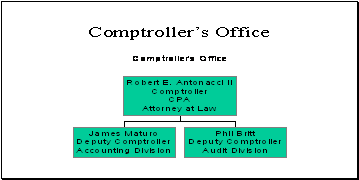
 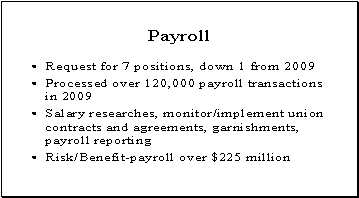
 
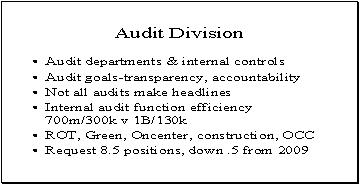 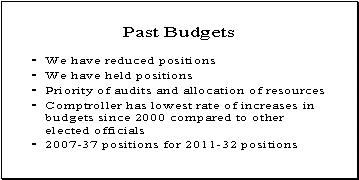
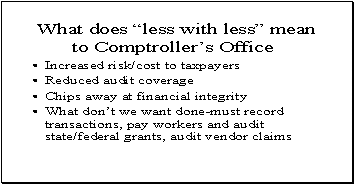 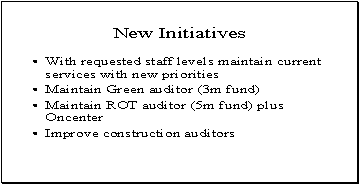
 
 
 
In answer to Chairman Jordan, Mr. Maturo noted:
- 3 individuals took the ERI; plan is to have the Chief Governmental Accountant come back and work part time, the auditor III position will be reduced to part time (put on special audits), hoping that the third position will not be needed
- $15,000 - every two years the county has to revalue the post employment liability; have to have a full review of the county population and services provided
Mr. Lesniak asked Mr. Antonacci about consolidation efforts for Purchasing and Economic Development and asked for an analysis; Mr. Antonacci responded:
- Comptroller’s office wants to be involved in consolidation efforts
- Applauds efforts to streamline costs, hopes in long run they save money
- Without a full blown audit of the analysis of Management and Budget and the other intricacies involved; they would not be able to deliver a formal opinion by tonight
Mr. Lesniak said that he sees increases in the departments in personnel and is having a hard time justifying how they benefit Onondaga County or City when just moving staff to one location – is looking for some type of analysis. Mr. Antonacci said that he would be happy to sit with Mr. Rowley. He understands the concept to be that by combining all the purchasing power, the County would receive on its purchases an increased percentage of savings that would make up for the additional head count. He referred to a community wide joint balance sheet, and if the City and County can save, and in total the increased costs come down, then it is heading in the right direction. Mr. Lesniak said he is looking for a second opinion – how savings are anticipated in bulk purchase vs. increasing county staff and rental location for economic development. He asked Mr. Antonacci to provide an opinion of the Purchasing Dept. and the Economic Development Office consolidation plans concerning the numbers that the County has worked up.
Mr. Lesniak asked about payroll staff; Mr. Maturo said that they have 8 staff in payroll and are losing one position. Mr. Lesniak said that there were 25 positions funded last year and 25 proposed to be funded this year. Mr. Maturo said that the way Management and Budget depicts the funded positions is that if there are individual working part time, they show up as funded positions. The Comptroller’s office presented more of a full time equivalent position. Even though there is a part time chief governmental accountant and a reduction in payroll, there is only have enough money to fund about half of the two combined.
Chairman Jordan referred to line 410 for accounting – independent auditing services, $47,510; on audit side there is $45,000 for a year end single audit. Mr. Maturo explained that the financial statement audit is the county’s CAFR, which is audited every year. Under federal guidelines, they are required to do a single audit of all departments that receive federal aid. That has to be done every year; it is a separate audit.
Mr. Buckel referred to Mr. Antonacci’s comment about the total amount of real estate taxes paid and asked what year the numbers were through. Mr. Antonacci said that he borrowed the numbers from the sales tax presentations that were done--believes they were through 2008. The figure hasn’t been audited; it would be part of the One Bill Tax Force. Mr. Buckel asked what auditing standards are applied in the County. Mr. Maturo said that Onondaga County follows generally accepted accounting principles; it is different from private business. Most generally accepted accounting principles for the private sector are put out by FASB; the county follows GASB.
*Mr. Warner arrived.
INSURANCE: pg. 3-150, Mark Stasko, Denise Downing, Robert Bratek, Erin Esgro
Mr. Stasko provided the following:
Ladies and Gentlemen of the Onondaga County Legislature, I look forward to reviewing with you the 2011 Insurance Division Budget. Here with me today is Denise Downing, our Employee Benefits Manager, Robert Bratek, our Director of Loss Control and Erin Esgro, our Budget Analyst. Our division works under the leadership of Jim Rowley, our Chief Fiscal Officer and Peter Seitz, our Deputy Director of Budget Administration.
Clearly the last two years have changed our paradigm on County Government. Our department recognizes the need to continuously look at our Insurance Division as a strategic cost center that requires us to scrutinize each line of expenditure to determine if by benchmarking the best in class, both in the public and private sector, we can create opportunities to reduce costs to the residents of Onondaga County while providing competitive benefits consistent with employee agreements.
I would like to share with you some of the accomplishments of the Insurance Division in 2010 and some of the challenges we face going forward. One of our most significant accomplishments in 2010 was our decision to change to a world class pharmacy benefit manager. By partnering with ProAct, an Upstate New York Employer, with many local jobs we have created a win-win situation for Onondaga County and ProAct. By working together we have been able to successfully reduce projected increases in pharmacy costs while providing an improved level of service. It is also important to mention that the county has a strategic initiative with ProAct which encourages plan participants to examine the use of generic substitutes with the advantage of saving money for the employees and the county without diminished care. In our first eight months we have successfully moved 2% of our pharmacy costs from utilizing brand name drugs to generic alternatives with projected savings to the plan of over $300,000 annually. For employees and legislators in the room, another improved benefit is the availability of the flu shots at Kinney Drugs with the presentation of your ProAct card beginning this fall.
Another accomplishment for 2010 relates to our dental coverage. After careful consideration a decision was made to move our dental plan from an insured to a self insured plan. With the selection of POMCO, another local CNY employer, we believe based on second quarter projections we will realize a $500,000 plan savings in 2010. These savings should continue going forward.
In the area of Workers Compensation a significant deadline loomed which was carefully monitored. New York WCB Second Injury Fund laws includes a provision which entitles the county to monetary reimbursement of expenses if certain conditions are met. Over the years the county has been successful in recovering significant funds due to proper investigation and classification of claims. In 2010 the game changed and required employers to submit all relevant proof in establishing these claims by 7/1/10. A complete review of all Onondaga County claims was completed and 315 were identified requiring further discovery. Each claim was evaluated for viability and those requiring complete proof of pre-existing conditions pursued. Proper proof was submitted on each file prior to 7/1/10. Successful outcomes have reduced county liabilities over $800,000 to date.
Other accomplishments include Federal Medicare RDS subsidy recoveries of 1,400,000, Second Injury Fund recoveries of $800,000 reduction in injury rates, and the achievement of Platinum Award by AHA for employee wellness to mention a few.
As for the challenges, many changes have and will occur in healthcare over the next four years due to the passage of the Patient Protection and Affordable Care Act (PPACA) that if not repealed, will forever change the landscape in which our health plan operates. A summary of changes is attached to your presentation. While there are many components of the changes we will see over the next four years, I would like to focus on changes for 2011.
- Dependent coverage to age 26 (est. 2400 additional members)
- No lifetime limits for essential healthcare services
- Limitations on modification of benefit structures to retain Grandfathered status and qualify for ERRP (Early retirement reimbursement program)
- Mental Health Parity
In addition to Federal legislation, we have seen increases in assessments for Workers Compensation and proposed medical fee schedule increases.
While not directly administering the pension plan, we also acknowledge the significant impact of state pension contribution requirements.
I realize that you have been through many budget reviews over the past two weeks, so I will spare you further remarks and get to the heart of the budget presentation that you have before you.
The first page of the presentation provides you with a snapshot of what makes up the overall Insurance Fund Budget. The rest of the presentation will provide details to the summary information. As you can see, the benefits line which consists of Health, HMO, Dental, Workers’ Compensation, Unemployment and Long Term Disability make up the lion’s share of the costs.
Turning to Page 2, you will see a breakdown of how those costs are allocated. The 2011 recommended budget shows an increase of 4.94% over our 2010 BAM numbers. We will review the details of each on the following pages.
On page 3, you will see the detail of the various health benefits. The increase in the medical benefit is based on a three-year trend analysis of our claims experience, which is trending at 7.74% v industry average 9%. In addition to our trending analysis, we have made provisions for the increases related to the Patient Protection and Affordable Care Act (PPACA) which are effective January 1, 2011 and the continuing effects of the 15% increase in state assessments enacted in 2010. The HMO’s are projected to increase by 7.5%; however we have a very limited utilization of this plan. With the vision projected to increase 10.7%, we are exploring an ASO alternative for 2011. We are pleased to report that the dental program expense is projected to decrease by 12.9%.
On page 4, you can see that cost per subscriber is $9228.00
On page 5, we have reduced unemployment costs due to the early retirement program and we do not expect significant layoffs in 2011.
On page 6, the increase in long-term disability is 3.25% based on increased employee wages in 2011.
On page 7, reflects a projected decrease of 5.75% in our insurance premiums. By working hard to negotiate the best prices on renewal we believe we will be able to achieve this aggressive goal.
Page 8, reflects fees paid for professional services. There are several line items that require further explanation. The most significant item is the addition of professional services related to Care Management. A careful analysis of the healthcare plan has revealed what we believe to be a gap in a comprehensive long term healthcare strategy. I would like to share with you some information which demonstrates our plan demographics and performance. In comparing the average age of our plan participates we have identified that the Onondaga County OnPoint plan has an average age of 45.5 year of age. This compares to an average of 34.6 years of age for the Excellus book of business. Another astounding statistic revealed that in 2009 66 plan members accounted for 42% of the overall healthcare expense. Further analysis revealed that the top diagnoses include heart disease, hypertension, high cholesterol, diabetes, and asthma. With an aging population it is critical that we take steps to manage these conditions now before they become chronic high dollar members. Therefore, we propose a comprehensive strategy to control costs by assisting members to adhere to treatment protocols to prevent at risk conditions from becoming chronic. This program would be a voluntary patient advocate program. We would data mine our healthcare and pharmacy management plans to identify at risk members and monitor adherence to accepted treatment protocols. Professional nurse case managers would make contact with the non adherent members and encourage appropriate follow up. Additionally, services would encourage wellness and nutritional lifestyles and support in newly diagnosed conditions and complex illnesses. We believe that this is an investment our future and an important step forward since most employees are plan participants for life.
Another line added to Professional Services is the administrative fees paid to POMCO for administering the self insured dental plan. These expenses did not exist under the prior fully insured plan. Clearly, the plan savings far outweigh this administrative fee.
The increase in Workers’ Compensation administration fees are based on current market pricing.
Page 9, is a breakdown of the administrative fees paid for the administration of the healthcare and flex plans.
Page 10, gives you a breakdown of our recommended Workers’ Compensation budget for 2011. This shows an increase of 2.31%. This increase is based on an increase in the state’s average wage to $739.00 per week. These increases drive increased permanency awards and state assessments. We also forecast increased medical costs due to proposed increase in medical fee schedule amounts.
The last page of the presentation is our forecast to judgment and claims; which remains consistent with our 2010 budget recommendation.
Mr. Rowley said that they anticipate funding the disease management piece, $500K, out of fund balance; anticipated a return on that – put in as a cost neutral item; do not know what the return will be. Chairman Jordan said that the cost is being reflected in the budget but the there is no reflection of anticipated savings as a result of it. Mr. Rowley agreed, as it is a new program. Chairman Jordan said that presumably an analysis was done as to why the county is taking on these new programs. Mr. Stasko said that the cost savings that the vendors are proposing are a 3 – 1 return on investment but because it is the first year of the program, there is uncertainty of what the return will be in the first year. Chairman Jordan said based on historical results, if investing $600K, we would be looking at $1.8 million. Mr. Rowley said it will be funded with insurance fund balance, not general fund balance.
Mr. Buckel said that the benefits line has doubled in 10 years with/without increases in coverage, and asked if projections have been done 5 -10 years out. He noted that the county census has decreased with reductions last year and retirements this year. Mr. Stasko noted that the retirees stay on the county health plan until age 65 when Medicare becomes primary. In answer to Mr. Buckel, Mr. Stasko said that our plan requires enrollment in into Medicare Part B. A five year projection has not been done of health care costs. Obama Care – a lot of regulations haven’t been finalized and they fully understand what will be happening in 2011, but going forward the grandfathered status should be allowed until 2014. At that time, it goes away.
In answer to Mr. Warner, Mr. Rowley said that the fund balances can be found on page 2-7; the insurance fund balance is $1.8 million. Mr. Stasko said that last year $5.9 million was used. Mr. Stasko said that they did have some high dollar claims in the first half of the year.
Mr. Lesniak referred to lifting the $2 million cap of health insurance in a life time, and asked if the county is insuring for above that cap or still self insuring. Mr. Stasko said that they have not bought gap insurance for above the $2 million. No members have hit $2 million or come close to it, and because there are 13,000 members and considered fully credible, it is pretty costly, may want to keep the risk.
Mr. Lesniak referred to page 8 of 11, $197K to $297K for Eagle. Mr. Stasko explained that is the claim administration fee for workers compensation and since Eagle took it over in 2007, it has been priced well below market. Mr. Lesniak asked if it is RFP'd out; Mr. Stasko said that a decision hasn’t been made on that yet.
Mr. Lesniak asked about carrying insurance for claims against the county. Mr. Stasko said that the county self insures the first $2 million and carry excess for claims above that, referred to page 7, excess liability claims. Mr. Lesniak asked about the blanket that was carried in 2007 on county bonds. Mr. Stasko said that it may be an error; didn’t have that coverage. Mr. Rowley said that he was unsure.
Mr. Corbett said that he was concerned about the $2 million cap. Mr. Stasko said that he can provide the pricing for Mr. Corbett to look at. Mr. Corbett asked why the insurance department pays for the independent inspections of all of the elevators. Mr. Stasko said that historically it has been a loss control function; making sure the inspections are being completed, to be sure that the contracted vendor is doing what it needs to be doing. It is more of an oversight function to make sure the county is safe. The county elevators are being done by its elevator inspectors--does not believe that the City is doing any inspections of county facilities.
In answer to Mr. Warner, Mr. Stasko noted the following
- If insurance fund balance gets depleted, general fund picks it up
- Currently have 4 people out of 207-Cs
- 207-Cs stay with County Health insurance forever; every attempt is made to get them to retire so that they go into the state retirement system rather than stay on full wages
**Mr. Stanczyk arrived.
- 2009 judgment and claims $4.650 million actual; $525K for 2010 and 2011 – probably a large settlement of a case in 2009.
- 207-c comes out of Sheriff’s wages; medical cost related to the 207-C is paid out of workmen’s comp.
Mr. Maturo explained that every year they need to book up all of the outstanding cases against Onondaga County; at the same time they book up an unfunded receivable. At the end of every year large dollars are booked up for judgments and claims or if the case reserves go down, there is a credit.
In answer to Chairman Jordan, Mr. Stasko noted:
- Marine insurance reimbursed by Skaneateles
- 060 line interdepartmental – Mr. Seitz said it is a combination of all benefit accounts – some of it is premiums, some are percentage of payroll
- Long term disability cost – all County money; employees can buy down and pay the premium
Mr. Buckel asked for an assessment of what the county should be doing – looking at policy of when and how many years of service are required before certain benefits kick in. Mr. Stasko said that most private employers have done away with defined benefit retirement plans. In the public sector much is driven by labor union agreements. Five years eligibility at age 55 is very generous; it is not industry standard. Mr. Stasko said that the difficulty with changing benefit levels is that part of it is specifically tied to ability to keep a grandfathered plan between now and 2014 and collect reimbursement under ERRP until the funds run out. If benefits are modified; it may disqualify them from those advantages.
Mr. Lesniak referred to 060 line – charge backs to departments. Mr. Seitz said not only is it different for each department, it is different for each employee based on if single of family. Each union’s coverage is different. Departments are billed based on the mix of employees that they have. Everybody is charged a slightly different number. Unemployment and workers comp – departments are charged a percentage of payroll. Ms. Esgrow said that for the medical insurance, departments pay approximately 85% of premium/ For the other coverage, it is allocated out in a different method. Mr. Lesniak asked for the average percentage number of all what all of the benefits are vs. salary. Mr. Seitz said that it is about 57% of payroll, which includes FICA and retirement.
Mr. Masterpole referred to page 7 of 11 (handout) and asked what happened on the property line that it is down 9.73%. Mr. Stasko said that the renewal for 2010 was very competitive, and the rate this year reflects the premium price they received last; same carrier, same agent, same deductibles. Mr. Masterpole asked about aviation being down from $86,560 to $56,735; Mr. Stasko said that is for Air One and a result of switching carriers.
In answer to Mr. Rhinehart, Mr. Stasko noted:
- $86,500 is an estimate for Air one; could be the same as what was paid last year
- Aviation liability- limits are for the ship itself and liability associated with the ship going down; policy covers for the first $2 million, after that the excess to $20 million would come into play
- Over $20 million; he assumes it would have to be bonded for
- If not in helicopter business, would excess premium go down – probably would, but would have to get an estimate
- Page 8 of 11 – EAP, elevator inspections -- what would happen if we didn’t do them. Mr. Troiano said that EAP is not collectively bargained, it is something that has been in place for a number of years as a labor management initiative; provides benefits to employees under different stressors--family, substance abuse, financial, etc. – preemptive effort before they bring those issues to the work place. He believes that it is past practice, but will take a look at it. Mr. Stasko said it is an important benefit. Not mandated: benefit consult, health and safety training to employees; believes elevator inspections are, but will confirm.
- Health insurance – 13,000 members on health insurance plan; 3,104 retiree members on health – (1,998 are actual retirees)
- OCSBA and one other union have health insurance as part of their contract. Other than that the health benefits are a past practice set by the legislature. Mr. Troiano said that the legislature has made adjustments to the level of retiree health benefits in the past. It was looked at last year, and because of the length of time between when the last change was made and the interest in making the change was made, that it would be a binding past practice and would have to be negotiated. New employees of the bargaining unit would also be covered by what the bargaining unit has.
- 2012 outlook for health insurance – Mr. Stasko said that the increases are forecasted to stabilize at around 5.5% for 2012.
- Health insurance is fully self insured; administered by Excellus. Part of the RFP for health care did not appear to have a significant savings. Have gone into a full forensic claim reimbursement for specific claims from each of the carriers to see if whether or not reimbursement rates that perhaps Pomco, Excellus or United has are more competitive. That is where any saving should be seen. The audit is being finalized.
- When retirees turn 65, they are required to have Medicare as their primary; County would be secondary
Mr. Fisher noted that the disease management is a strategic investment. To really get the cost down, a lot of the demographics of the people we cover have to do with expenses that are chronic disease related, end of life related – really need to change the behavior; help manage diseases -- only hope to get trends to move in the right direction.
Mr. Stanczyk’s comments were inaudible.
FINANCE (Finance, Management & Budget, County Wide), pg. 3-134 – James Rowley, CFO, William Fisher, Deputy Co. Exec., Peter Seitz, Deputy Budget Director, Karen Carney, Director of Real Property Tax.
Mr. Rowley provided the following:
Finance Administration (page 3-131)
The Finance Department has a number of unique responsibilities.
It collects delinquent taxes and other revenues owed to the County, and then manages those funds until they are needed to pay bills.
As part of our tax collection responsibilities, we work with delinquent taxpayers to establish installment plans for the payment of back taxes and, as the last step in the enforcement process, we auction tax delinquent properties. Our last auction resulted in $2.3 million of tax paid, $405K financed through the installment program, and $190K in net auction proceeds.
Earlier this year, we completed the sale of $13.3 million of taxable certificates of participation at an interest cost of 3.5% in order to address the 2009 budget gap. This sale of tax sale certificates was a new type of transaction for the County of Onondaga, drawing interest from other counties relative to how it was structured.
The Finance Department is also charged with issuing and managing all debt financing authorized by the Legislature. We have issued $204 million in new debt over the last five years. In June, we had a successful offering of $53.6 million in General Obligation bonds, including $4.9 million in Recovery Zone Bonds and Build America Bonds, for which the Federal government offered an interest subsidy. As this Committee knows, the County of Onondaga has worked diligently for decades to achieve one of the best bond ratings of any county in the state of New York. We have earned AAA with Fitch, AA+ S&P, and Aa1 Moody’s. Of the 50 counties rated by Moody’s, only two have better ratings than Onondaga. Our success with the bond rating agencies this year allowed us to borrow at exceptionally low rates, saving taxpayers significantly. Our fiscal policies and budget practices play a key role in the rating process.
Above all else, the bond rating agencies look for evidence that the County is following fiscal policies that will ensure that we will not default on our debt. Given the enormous budget problems that New York State government has brought upon itself, coupled with their often demonstrated ability to shift the costs of State spending to counties, the bond rating agencies told us this year that they see enormous challenges ahead for counties in New York State.
One of the most significant factors that ratings agencies look at is our level of fund balance. During our meetings on Wall Street this spring, the rating agencies responded very positively when we informed them that this legislature passed a resolution following the adoption of last year’s budget to affirm our policy goal of maintaining 10% of net revenues in our fund balance. Due to the new sales tax sharing agreement, under which the County retains more of our sales tax revenues, our net revenues will increase in 2011. This committee and the Legislature should be aware that as our fund balance policy goal is currently defined, the County Executive’s proposed 2011 budget would not be in compliance with this policy. To return to a situation of compliance with the policy, the County budget would have to generate a healthy surplus in 2011.
As I have consistently done since becoming Chief Fiscal Officer of this county, I will again state clearly for the record that additional use of fund balance will be extremely detrimental to our efforts to maintain a strong credit rating. And this is not the case only because it puts us out of compliance with our own fund balance policy. As you know, whenever the Legislature cashes in additional fund balance to next year’s budget, this creates a structural deficit in the follow year’s budget. This legislature’s decision to use $7.9 million in fund balance in the 2010 budget meant we had a $7.9 million hole to fill in the 2011 budget before calendar year 2010 even got started.
In late 2009, we took advantage of a very favorable interest rate environment to reduce our debt service costs when we refunded approximately $33.3 million in GO bonds at an average interest rate of 2.4%. This resulted in reduced interest costs that will amount to $3.3 million from 2010-2023. As interest rates remained low and as our bond rating stayed strong, we were able to finance this year’s debt offering at an average interest cost of 3.524%, which is very low by historical standards.
The proposed budget for the Finance Department to support these functions is slightly more than $1.9 million, with slightly less than half of this amount, $950 thousand, representing direct expenditures. Personnel costs – salary and fringe benefits – account for approximately 69% of the department’s budget. Two people in the Finance Department elected early retirement under Part A and one under Part B. Our plan is for each of them to return on a part-time basis for varying time frames to assist with tax bill preparation. Following this transition, our plan is to then replace two positions -- an acct. clerk II and a delinquent tax clerk -- with one position, an acct. clerk III. We also plan to replace a full-time Accountant II with a part-time Accountant II. ERI and salary savings from these reductions are $66 thousand.
The 103 line is up slightly to accommodate PT returns resulting from the ERI for three months in 2011 to assist with tax bill preparation.
The 300, 401 and 408 lines are slightly reduced or flat.
The 410 line is increased $56 thousand to reinstate title searches needed for tax auctions. This expense was eliminated in 2010 in anticipation of the tax sale certificate transaction.
Going through revenues quickly:
The 005 “non-real property tax” line is the Finance Department’s charge to the ROT for collection and enforcement of the Room Tax.
The 030 Account is primarily made up of fees charged for current year delinquencies for the administrative costs associated with tax sales and required advertising.
The 040 Account is revenue received from towns, village and school districts to maintain their tax rolls and print their tax bills. We charge them $2 per parcel.
The 050 Account is essentially a portfolio management charge by Finance for investing and managing the County’s excess funds. The money comes from interest earned on those funds and is used to offset the cost of the Treasury function.
The 056 Account reflects the fact that tax auctions resumed in 2011 after the successful tax certificate sale transaction.
Finally, the 057 Account contains fees for administering tax installment accounts, plus wire transfer fees and unclaimed accounts. It also includes a charge to the Tobacco Securitization Corporation for costs we incur to administer the on-going administrative tasks of the securitization.
Our large interdepartmental revenue account is our charge to WEP and the Water Board for preparing their tax bills.
Management & Budget (page 3-144)
The budget for the Division of Management and Budget supports both the Budget Office and the Office of Risk Management. Both areas have seen considerable turnover in staff in the past two years and I am proud of the ability of these two offices to adjust to this turnover in the face of extremely complex and difficult budget issues. I can say with confidence that the administrative intern program has proven to be very beneficial, as the quality of our new budget analysts has been exceptional. We are realizing tremendous value for County taxpayers by being able to hire these ambitious and very smart young people fresh out of grad school at a very reasonable cost.
Mark Stasko, our Director of Risk Management, already briefed you on our $80M insurance fund.
The DMB budget is very simple. Personnel and intra-government costs represent 98% of our total budget. The remaining 2% goes for supplies, travel and training, and a copier lease.
The budget supports 16 funded positions – 10 in the budget office and 6 in Risk Management (there is 1 grant position). Two staff have taken the ERI and both positions will be filled on a PT basis in 2011.
Countywide
For the Countywide funds I will go in the same order as the budget.
The County General Other Items budget is shown on page 3-51. This budget includes the County’s memberships and dues, and our contribution to Village Infrastructure projects as approved by this legislature.
The first item on the page, the $70,000 “all other” line is for countywide memberships and dues for NYSAC and the National Association of Counties.
The next item is new in the 2011 budget, but I’m sure you’ll recognize it immediately. We’ve budgeted $1.35 million for the cost of the Village Infrastructure fund. The 15 villages in Onondaga County will receive funding under this program, in two equal payments to be made on January 15 and July 15 of the coming year.
In the revenue portion of the budget, $5,000 is budgeted from vendors who provide 401B plans to County employees to cover the cost of their plan audits.
The interest and earnings item of $13,400 is anticipated interest payments on past loans authorized to OCIDA for various projects.
Miscellaneous revenue of $15,000 is included for the write off of stale dated checks.
The County General Undistributed Personnel Expense begins on page 3-54. Line 118 is amount is set aside as a budgetary estimate of the potential settlement amount for DSBA.
Line 120 is the general fund portion of the costs for Part A and Part B of the Early Retirement Incentive program, while line 057 depicts the anticipated revenue from state and federal aid on our ERI payment.
Since we are talking about personnel costs, this is a good opportunity to speak to our retirement expenses – a cost that is not on any single page, but extended throughout the budget. We are budgeting $34.1 million for pension contributions in 2011, the equivalent of 16.9% of our payroll. Ask any employer how long they would stay in business if they were forced to pay 16.9% of their payroll costs to pensions, and watch their reaction.
In 2010 our rate was 12.1% of our payroll, which was bad enough but a long way from 16.9%. As a result of this dramatic increase, which is the result of a defined benefits plan in which no employee hired before 2010 has to make any contribution to the pension fund after 10 years of service combined with irrational exuberance by those managing pension fund assets, our countywide pension bill has grown by $9.4 million between 2010 and 2011. And as this committee considers its response to the County Executive’s proposed 2011 budget, please keep in mind that the New York State Dept. of Budget indicated in their 2010 first quarter report that absent any changes to the retirement system to allow amortization of costs, pension expense could reach has high as 24.1% of payroll by 2012.
The County Promotions Grant Budget on page 3-57 has been incorporated into the Authorized Agency budget and is supported by ROT allocations.
County Wide Taxes are shown on page 3-60. This page depicts our estimates of property tax and sale tax incorporated into the 2011 budget.
Line item 001 includes our proposed property tax levy, adjusted by estimates of unpaid current year taxes and payments of delinquent taxes.
The property tax levy is $180.88 million, down $3.1 million from the 2010 levy of $183.99 million. That’s a decrease of 1.7% from the 2010 budget. Of the total County property tax levy of $180.9 million, $160.8 million will be used to pay for State mandated costs. That’s 8 out of every 9 property tax dollars going to pay for State mandates. The other $20 million goes toward County government services.
Deferred and uncollected revenue, which is a direct offset to the tax levy, is expected to grow by $6 million in the general fund over 2010 BAM and $3.4 million from 2009 actual. In determining the deferred and uncollected estimate for 2011, DMB took into account the amount of property tax to be billed, as well as the decrease in the collection rate as a result of the recession. Collection rates under the old system of tax credits allocated based on population was between 97.67% and 97.84% for the years 2004-2007. In 2008 the collection rate dropped to 96.88%. In 2009 the collection rate was skewed by the tax certificate sales, however if the effects of the sale were stripped out, the collection rate in 2009 would have been 96.59%. The 2010 data due not indicate an improvement in the collection rate. Most importantly these collections rates counted the sales tax credits in their calculation, which had the effect of skewing the rate upward. To use Salina as an example, in 2010 their apportioned tax levy was approximately $13 million. Of this amount approximately $7 million was covered with their sales tax allocation essentially making this portion of their levy 100% collectible. The remaining portion of their levy, approximately $6 million, was subject to an uncollectible percentage. Had the new sales tax agreement been in place in 2010 the portion of their levy that would have been 100% collectible from sales tax would drop to approximately $2.3 million. The balance of their levy approximately $10.7 million would be subject to an uncollectible percentage. Since a larger portion of the levy is now subject to normal collection rates, the dollar amount of deferred and uncollected taxes must rise commensurably.
Prior year tax collections are down approximately 2.3 million from 2011 BAM partially as a result of the 2009 tax certificate sales and partially as a result of the recession.
Line 005 labeled “Non real Property Tax Items” is our $192.5 million estimate of sales tax revenue. We estimate 2010 sales tax collections will finish 3% higher than 2009 actual collections, still short of the 2008 collections amount by approximately $8.8 million. As you know the percentage of sales tax being retained by the County from both the 3% portion and the 1% portion is increased from 45.4% in 2010 including the hold harmless amount of approximately $7.1 million to 68.6% in 2011.
Interfund Transfers are on page 3-63. These are simply the transfer of general fund dollars into OCC, the Road Fund, Library and so forth. It is the local dollar portion of those budgets. You reviewed these items when you reviewed the budgets for Transportation, OCC, Library, and Aging.
Debt Service costs are on page 3-66 and reflect countywide debt service including WEP, Water and the General Fund. The 2010 budget includes debt service payments of $41.1 million, up $5.1 million from 2010. Increases in debt service payments for interoperable radios, OCC projects and DOT authorized borrowing contribute to the majority of the increase.
Transfers from the General fund into the debt service fund were mitigated by using $2.3 million of RBD, allocating $1.4 million from our college chargeback collections to partially offset OCC debt, and recognizing an additional $1.5 million in additional surcharge revenue from legislation passed last year allowing our land line surcharge to increase $.65 to help mitigate the debt service cost associated with the radio project.
Countywide Allocations on page 3-69 depicts a number of budgetary items.
The “All Other Expenses” line is the estimated $2.1 million cost of college chargeback for County residents attending a community college outside Onondaga County. As you know the amount we pay to each county is based on how much the county subsidizes its community college. We basically hold that county harmless from the local cost of one of our residents attending their college.
The next expense is the expected cost of tax certiorari settlements budgeted at $200,000. This is the estimated payment back to residents who successfully challenge their assessment and are due a refund of improperly assessed County tax.
The final expense item is the $95.9 million sales tax revenue we share with the City, towns, villages and schools. There is corresponding revenue down below that also includes a small amount of ROT interest earnings from ROT investable balances.
In the revenue section, the $7.6 million in “Other Real Property Tax Items” consists of two items:
- PILOTS of $2.5 Million, which are down from $2.9 million in 2010.
- $5.1 million of interest and penalties on delinquent taxes.
The 050 Interest and Earnings account is our investment income which, because of substantially low interest rates (we are estimating an average return of .4%), is down significantly from 2010 by $242 thousand.
***Mr. Corbett left the meeting.
Mr. Stanczyk referred to ERI - $8.169 million net cost; revenues of $1.585 million against it. Mr. Seitz clarified that is general fund costs; the entire county wide cost is $10.6 million. The local share is approximately $6.6 million. In answer to Mr. Stanczyk, Mr. Rowley said that the payment can be made over a 5 year period; have elected to pay it lump sum because of the interest costs involved in paying it over time, which is about 8%. Mr. Stanczyk asked to be provided with the payment amount if stretched over 5 years. Mr. Rowley said that the law says that if opting into the payment plan, then we have to stick with it for 5 years – will provide the cost every year compared to the lump sum payment. The county cannot float its own bonds to pay for it; it has to be done through NYS retirement system. Mr. Lesniak asked if it could be paid through fund balance and finance something else. Mr. Fisher said that the State has made it impossible to bond for this, unlike what was done in 2002, but fund balance can be appropriated for this. Mr. Lesniak questioned if the fund balance could be bonded. Mr. Rowley said that costs in the budget can be replaced with the legislature’s authority to bond.
Mr. Stanczyk said that the justification to try to pay for it this year is that it would cost interest money to take it forward, and it would cost interest money that we are not receiving on fund balance. If we want to pay for it this year, rather than tax for it, we should take the money from fund balance that is earning half a percent and replenish this money every year for the next 5 years, as if we were paying for it in installments. It gives justification to take $6 million from fund balance. Mr. Fisher said then it would be $6 million short of the policy goal. Mr. Stanczyk said he would like to use the money this is earning a half a percent on to pay this so that we don’t have to pay the 7.5%. Mr. Fisher said that there will be savings by doing the retirement year after year; there will be some replenishment of the fund balance. Mr. Stanczyk said that the distinction is whether or not we are going to tax our constituents for this year, or use the advantage of prudent planning. Over the years fund balance has been built up, and this is the perfect thing that fund balance can be used for. There could be a commitment to replenish this amount over 5 years so that the rating agencies aren’t scared. Mr. Fisher agreed and said that this is a one shot. If a one shot source is used, like fund balance, against something that only happens one time, then it is legitimate. It is a lot more legitimate then paying for something that recurs and creating a structural deficit. Chairman Rhinehart said that the largest one shot done in Onondaga County history was the tax lien sale done last year.
Mr. Stanczyk objected to (pg. 5) state mandated services – picking components from a budget on the books of over $1 billion and saying that people’s property taxes are paying for this. It is not accurate, and it is shading it. Mr. Fisher said that the local dollar budget is $360 million. Of that, the state mandated costs are $160 million. If the state had no mandated costs on the county, the property tax would immediately be dropped by $160 million. Mr. Stanczyk disagreed – if the state didn’t mandate that the county do some things in terms of health and welfare, we would still do them. Mr. Fisher disagreed; the state would be do them, and should be doing them. Mr. Stanczyk said that these are policy decisions. Mr. Rowley said that the larger issue is that the State can mandate all it wants as long as it pays for it.
Chairman Jordan said that Mr. Rowley indicated that the property tax levy is $180.88 million, but the budget book indicates $170,149,445. Mr. Rowley explained that is a net number offset by deferred and uncollected, prior year tax collections - $13.9 million (deferred) $1.5 (uncollected); add back in estimated collection of prior year delinquent taxes $4.7 million).
Mr. Stanczyk referred to sales tax receipts up approximately 6% for first 6 months. Mr. Rowley said that they were up less than 6% for the first 3 months. Mr. Stanczyk said that they are rebounding; stronger in second quarter than in the first quarter, but DMB is estimating sales tax receipts to be flat for the rest of the year – it is not realistic. A more realistic estimate would be to have sales tax receipts up 3% for 3rd and 4th quarter. Mr. Fisher said that they were not confident in saying that the 3rd quarter was going to be up because in looking at the last 20 years, there were very few years when there are actually four up quarters. Often one quarter is down. This year there was a lot of incentives to buy refrigerators, cars and various things; there was clear evidence that there was accelerated growth in first half of the year and now that growth is decelerating. They don’t want to assume that because two quarters are up that it is going to keep going up. If there is a down quarter in the 4th quarter, in particular, and the estimates are overshot, then the estimates will be overshot for next year. The last time the County overshot its sales tax estimates; they didn’t have money to pay for the budget and had to sell sales tax certificates. The best indicator they could find was CPI – inflation is the only thing that changes sales tax around here. As a result, next year’s forecast is based on the congressional budget office, saying it is 1.1%. DMB is forecasting a 1.1% increase for next year over the 3% increase in 2010 compared to 2009. In answer to Mr. Stanczyk, Mr. Rowley said that sales tax is trending down from June – down between 3 – 6 basis points. Mr. Rowley did not know how much they were up from 3rd quarter of last year. Mr. Fisher said that reconciled data from the state is received at the end of October. Mr. Stanczyk said that we still get some results. He doesn’t believe that in going back 40 years, we have ever had a year like last year where we were down as far as we were in sales tax receipts. Instead of having one quarter down, we had a whole year that was down. It is unrealistic to expect a down quarter when comparing this year to what happened last year.
Mr. Lesniak referred to pg. 3-145 – asked about eliminating an administrative analyst and creating a budget analyst. Mr. Rowley said that the administrative analyst hasn’t been used in a number of years – no one in the spot now – need a budget analyst because of the administrative interns on staff – their internship will eventually run out and they have to be placed in a Civil Service position. In answer to Mr. Lesniak, Mr. Rowley indicated that they would be hired at the bottom of the grade.
Mr. Lesniak referred to page 3-137 – creating an account clerk III, is anything being taken away. Mr. Rowley explained that the account clerk II and tax delinquent clerk are being combined into this position. The account clerk II and tax delinquent clerk are still showing as funded positions, because they are coming back part time. The money associated with them has been taken out of the 101. Mr. Lesniak asked when the legislature will be provided with the ERI numbers. Mr. Rowley said that the ERI program has been very fluid, still not settled, do not have absolute confirmation from the state on everyone that wanted to go into the program. The plans that people came back with are complicated – took the opportunity in some instances to reorganize their departments. That combined with a very new staff, has been very difficult to get a final product. Mr. Lesniak asked to have it by 5:00 today.
Mr. Lesniak referred to sales tax and asked what a .9% increase in sales tax projections gets the county in terms of revenue (average sales tax through all of the years was 2%, DMB is estimated 1.1%). Mr. Fisher said about $2 million.
Mr. Lesniak referred to the 57% that was used to calculate total salary, benefits, retirement, etc. – asked to be provided with a percentage breakdown for each of the numbers.
Chairman Jordan referred to pg. 3-56 - relative to provision for salary and wage adjustments, it includes a salary and wage adjustment for DSBA for 2009, 2010, 2011. Mr. Fisher said that there is ongoing negotiations going on with DSBA and prefers to be in executive session. Some money is set aside; they are the one bargaining unit that doesn’t have a contract. Previous years are included, as there would be a retroactive settlement.
Chairman Jordan referred to pg. 3-70 and 3-71 - payment for distribution of sales tax – Mr. Rowley said that they are the pass through amounts paid to town, city, villages, school districts; expense amounts on pg. 7-40. The revenue line is 005 – slight difference between them as there is some ROT revenue in 005. Mr. Seitz explained that they are required by State law to show the pass-through dollars from the County to other municipalities. Had budgeted $149 million this year – drops to $95.9 million next year. The additional sales tax revenues that the county will be receiving are reflected in county-wide taxes.
In answer to Chairman Jordan, Mr. Rowley said that there are funded vacant positions in Management and Budget, but because there has to be money to pay for administrative interns, charged through letter of distribution from Personnel Dept. – administrative interns are on Personnel’s roster – has to be a charge back. There is also half a typist position that is funded vacant.
Chairman Jordan noted that there are a lot of people coming back on a part time basis, but there is no creation of part time positions – wages are being reflected on 101 line instead 103 line and questioned why. Mr. Rowley said that they can’t hire back in the 103, under the advice of Personnel Dept., unless there is established practice in a department of using 103 to do the particular work that these people are coming back to do. In Finance Dept., there is one person coming back on a 103; the others are coming back on the 101 because they haven’t established in prior practices that the work could be done on the 103. Mr. Troiano said that it turns on the exclusivity of that work; if there has always been a bargaining person on the 101 before doing that work and haven’t had a part timer or on the 103, or a contractor do it, then the work has to be performed by a member of that unit on the regular payroll. They have tried to maximize cases where they have used non unit people on the 103, but in some cases they don’t have that flexibility. Chairman Jordan asked how the County establishes the history/practice of performing those services on a part-time basis. Mr. Fisher stated that he would prefer to talk about this in executive session.
Mr. Stanczyk said that he has asked for terminal leave payments and the estimated savings in 2010 for the employees that took the ERI. Mr. Rowley said that there is a gross estimate and a net estimate. The gross estimate is roughly $2.2 million in 2010, but netted against that number is terminal leave payments that they are in the process of accumulating as people leave. The payments will be tracked; it will be a few more weeks before they have a real number. In answer to Mr. Stanczyk, some of those payments have been made, but they anticipate more.
Mr. Stanczyk’s comments were inaudible. Mr. Fisher answered that the county gets 46% of this year’s money (sales tax receipts), if it were up 3% -- it would be a little less than $2 million. Mr. Stanczyk said that it is unrealistic to say that we think the last 2 quarters will be up 6%, like the first two quarters for 2010, but it would be more reasonable to say that they would be up 6% rather than being flat. Cutting it in half would be an increased estimate of 3%.
Mr. Stanczyk referred to increased estimates for collections – asked what the 2010 data is so far. Mr. Stevens said that they only know the first two quarters of 2010 – tax report that the Comptroller issues. Right now there is 6.78% unpaid as of the end of the second quarter; in 2009 at the same time there was 6.43% unpaid; in 2008 it was 5.82%; in 2007 it was 5.13%. The percent unpaid has increased dramatically by about 1.6% -- it can only be due to economic effects because sales tax isn’t even factored into it yet. In answer to Mr. Stanczyk, the estimate for out of city for last year was above 97%. This year 95.7% is being estimated. Last year’s collection rate, once the effects of the tax lien sale are stripped out, was 3.14% unpaid. The tax lien sale changes the collection rates – the actual collection rate from 2009 was .69% uncollected; 2008 unpaid was 3.12%. The percent unpaid for 2010 is being forecasted at 3.27%, which is a slight improvement from last year. To get to 95.7%, the effects of the sales tax credits have to be backed out. In answer to Mr. Stanczyk, Mr. Rowley indicated that increased delinquency is not a part of this calculation – historical delinquency rates were taken, the sales tax effect was stripped out and applied. Mr. Stanczyk asked if an estimate has been done regarding the cost to Onondaga County by making the towns whole for county taxes, what the benefit to the towns is, and what the disadvantages to the County is, and if the policy should be changed. Mr. Fisher said an audit has not been done; the main affect is time value of money. Mr. Stanczyk said that there is a $15 million pit that are not going to be received in the taxes that are levied, and over time the county will get in excess of 99.8% of those taxes. The county is the beggar in the situation, because it ends up being short and having to put a higher tax rate on our constituents because the county is protecting other communities and making their taxes whole. He questioned that if in these difficult times that the legislature should take a good hard look at it. In other counties, the towns make the county taxes whole – they collect the taxes and first pay the county 100% of its taxes. There is a huge reduction in the amount of money that we are budgeting to receive because of delinquencies. Most delinquencies are caused by the towns and school districts being made whole. The county has a tremendous cash balance, tremendous credibility in terms of borrowing, etc., but a lot of the county’s problem is because it makes the delinquencies whole and the county doesn’t need to do that. Mr. Rowley said that the provisions to keep towns, villages and school districts whole is part of our tax act, which is tied to state law. Only one county doesn’t do it and has a special provision. Mrs. Tarolli said that it is pursuant to NYS Real Property Tax Law; the County also has a special sales tax that provides that we do not make the City whole, but in turn the City keeps the 1% from their collections.
Responding to Mr. Stanczyk, Mr. Warner said that he would like to proceed with caution, because there is a 133% property tax increase in one of his towns and 120% tax increase in another and is quite sure that there will be a lot of delinquencies. Therefore he feels the process of making them whole should continue for a while.
ROT
Mr. Fisher noted:
- 5% tax on all hotel/motel room nights
- Revenues forecasted for 2010 are up a little bit from BAM; hotels and motels doing little better – revenues up over 10% if first quarter - $5.265 million forecasted 2010 revenues
- Forested $5.45 million in 2011; up almost $200K from this year
- Lady Bowlers Congress – 88 days of bowling from 7:00 a.m. – 11:30 p.m. – will spend about $1,000 ea.
In answer to Chairman Rhinehart, Mr. Fisher noted that ROT is spread across a number of budgets and it is not on one page in the budget book. Chairman Rhinehart said that there may be some reallocation of ROT money. Mr. Fisher said that the biggest use of ROT will be the Oncenter. It is split between 2 budgets – authorized agencies $1,479,742; of that $250K was for capital reserve.
Mr. Lesniak said that he wants an entire list of where ROT would be used. Mr. Fisher referred to page 5-3, which will show Oncenter/War Memorial budgets - $2.34 million, pg. 3-5 shows authorized agencies. The seconded biggest user of ROT is CVB. Mr. Rhinehart asked for a detailed breakdown of ROT.
Mr. Fisher noted that in the Parks Dept. Budget, they proposed allocation $500K from ROT for concerts; there was a revenue item for $500K for those concerts. In 2009 the Syracuse Chiefs hired a promoter to do their concerts; it made good money for the Chiefs and the community was happy. This year the Chiefs chose not to do it. The idea for next year was to use ROT to have a promoter, chosen by an RFP. When a concert is done, half of the guarantee has to be prepaid. If the concert makes money, there would be more money in ROT surplus than what was started with. If money was lost, there would be less ROT than started with. While it is in the Parks budget, it is not a 2011 ROT allocation; proposing to use ROT surplus.
Chairman Rhinehart said that members are interested in where specifically ROT money is going. Mr. Fisher said that all of the detail for arts and cultural agencies is on page 3-5 of the budget book.
Mr. Lesniak asked if a contract is in place for a promoter. Mr. Fisher indicated that there is. In answer to Chairman Lesniak, Mr. Rowley said that there is a project account for matching funds – had excess funds available to pay it. Mr. Fisher said that when the Chiefs said that they weren’t going to do any concerts, an RFP was sent out and a firm selected to try to get a concert this fall. There was an attempt to get a concert in September; the promoter continues to be retained to work on next season; $2,000/month is being paid to the promoter. Mr. Lesniak asked if the project account shows up in this 2011 budget; Mr. Rowley said “no”, project accounts do not show up in the budget. They are appropriated money, past or present, which the Comptroller maintains. Last year there was a budget initiative to take $1 million out of excess funds for these accounts. There was a little left over in another account. Mr. Lesniak asked to be provided with a list of the project accounts and balances.
Mr. Stanczyk said that it is disheartening at times to find out that some of the money that was to be spent wasn’t, and because there is left over money that nobody knows about it, it gets spent. He was very clear last year when the Legislature found out that there was an attorney being retained by WEP for $5K per month who was supposedly lobbying on the county’s behalf to state government. We pay the Co. Executive in excess of $100K; pay most everyone in Co. Executive’s department in excess of $100K; have state senators and assembly members to represent us, and for some reason we hired an attorney out of WEP, out of an account that no one knew about, to lobby on our behalf. He thought that was over, but then found out there was another contract with someone associated to the attorney from his office; the contract is still going on now. Now there is a firm hired; they were hired, not because the legislature approved it, but because there was excess money somewhere that the legislature didn’t know about and the executive branch decided to spend. The legislature should be aware of it before it happens, as they control the purse strings of the county. Mr. Rowley said that no money gets into project accounts without being appropriated in the county budget for a purpose. Any money spent out of project accounts, gets spent based on the purpose that it was established for. The Comptroller sees all of these contracts and they get spent accordingly.
Mr. Warner asked to be provided for a one page explanation as to what ROT can be spent on. Mr. Maturo stated that it is the Comptroller’s opinion that it is general fund revenue, any restraints put on ROT is put on by Onondaga County itself. It is their opinion that the only thing that limits ROT to economic development and tourism is the Onondaga County Legislature. Mr. Fisher said that the County Legislature has put limits on it and there is a local law in place. Mrs. Tarolli said that the local law adopted by the County Legislature provides that ROT revenues are to go for things that promote conventions and tourism. The local law set limitations on ROT. When the legislature approves the expenditure or ROT funds; the legislature puts its stamp of approval on it that it is consistent with the purpose of the local law. It is not state law that limits the expenditure of those revenues, it is the local law.
Mr. Fisher referred to the stadium issue and noted for the record that a number of county legislators have come to the County Executive’s office and asked what is being done about concerts.
Chairman Rhinehart said that last year the Executive branch came to the legislature and asked to create the CRT, which was done. One of the missions of the CRT is to fund arts and cultural organizations. The challenge in this year’s budget is not to increase taxes in the suburbs. The thought is that much of the ROT money, which has traditionally gone to the arts and cultural organizations, would be able to go into the Parks Department; the CRT could supplant arts and cultural organizations, and county property taxes could be reduced. Mr. Fisher noted that in the 2010 budget the County Executive provided a 20% cut by and large to all the arts and cultural agencies. There was an exception with the Syracuse Symphony, which continues to face an existential crisis. The Symphony received a recommended appropriation from $404,000 to $425,000; Syracuse Opera is in a similar situation and has a slight increase this year. Red House did not get their paperwork in on time last year and have gone back to what they would have gotten as an allocation last year. Syracuse International Film and Video Festival received more than a 20% cut last year; and were restored to what the 20% would have been. All of the arts and cultural agencies are set at the 2010 levels. These are vital institutions in the county. People come to a city to live or travel to and find that there is symphony here. Most cities our size don’t have a symphony; there are museums, OHA, and a number of performing arts organizations here. This is a small part of their total funded. CRT has raised money; the CRT budget is $700,000; $300,000 of that has been spent. It is $1.2 million for these agencies; the legislature is talking about replacing $1.2 million with something that has a total of $400,000 and it would deplete CRT’s account entirely. It would possibly take the Symphony out of business, and impact a number of other arts and cultural agencies. To cut taxes by $10 million; you get $4 on the tax bill; to take the money away from all of these people – can tell the taxpayer that it is $4. Chairman Rhinehart said that the legislature does not take the money away from all of them; it is determined in the legislature how much the county will fund them for. The main problem with Symphony and Opera is that interest, response and memberships are way down. Just because those are the situations there, it doesn’t mean that we raise property taxes to give them more money.
Mr. Buckel said that these agencies are instrumental to the overall quality of life and economic development of the community – there is valid reason to support them as a government. He asked what the current revenue situation is, and what is foreseen over the next year that will generate fees for the CRT. Mr. Fisher explained that SU needed to refinance some securities and had the Green Data Center – it generated $720K. The CRT allocated $75K to Symphony; put $20K into the Ideas Collaborative, put money into a variety of other projects. They are talking to different people; there are issues with the CRT -- if an entity hasn’t been in existence for 5 years, then it can’t go to CRT. Mr. Buckel encouraged a more expansive view of both the OCDC and CRT funds.
Chairman Jordan referred to page 3-6 of the budget book and noted that they don’t add up. Mr. Fisher said that those numbers are in error; the notes in the budget itself are correct – requested a budget of $1,597,500 in line 570. Mr. Fisher said that he will provide a replacement page 3-6.
Mr. Lesniak asked if Syracuse Symphony is paying the county rent; Mr. Fisher said that they are current on their rent to the Oncenter. Most of their money comes from donors or patrons. Mr. Lesniak asked if the Symphony already received money from CRT; Mr. Fisher said that they receive $75,000, which brought them current with the Oncenter for past due rent. Mr. Lesniak said that our CRT funded the Symphony to pay our Oncenter. Mr. Fisher said it was not using tax dollars; it was using fees that come for the SU deal. Mr. Lesniak said that one problem he has heard is that the Symphony restricts the availability for shows and acts to come into the Civic Center. This is funding a group that is causing the County to lose money at the Oncenter. Mr. Fisher said that the County owns the theater and does not pay a lot of money to maintain it so it does not lose a lot of money on the Symphony. More money could be made if we could have Broadway shows, but the Landmark Theater will be expanded and it may be a tricky proposition to keep that business coming to our theater. He feels it still makes sense for the Symphony to be the anchor tenant there.
Chairman Jordan referred to CVB destination marketing plan and questioned the amount. Mr. Fisher said that CVB is not asking for a specific number to be allocated the plan; it is part of their overall budget.
Mr. Warner asked if all of the agencies (20) listed on pg. 3-5 get their funding from ROT. Mr. Fisher said that they do; but also get revenues from selling tickets, annual funds, galas and other fundraisers, endowments, etc. They submit to Management and Budget all of their budget details. Mr. Warner noted that the amount listed in the budget on page 3-5 is the amount coming from the County. Mr. Rowley agreed and noted that it is all ROT money.
**Mr. Stanczyk left.
COUNTY CLERK – pg. 10-19: Ann Ciarpelli, Co. Clerk; Jackie Norfolk, Deputy Clerk
Mrs. Ciarpelli provided the following presentation:
Thank you for allowing me to come before you today to speak to the County Clerk budget for 2011 and to take this opportunity to apprise you of the changes and improvements to the clerk’s operation.
The mission of the County Clerk's Office is to record, maintain, protect, and make available for public inspection documents filed in the County Clerk's Office. We ensure the fulfillment of Federal, State and County laws; it is our responsibility to timely process transactions, safeguard and provide responsible records management in a customer friendly atmosphere with fiscal responsibility and quality services.
The County Clerk’s Office is mandated and directed by New York State Constitution along with Federal, State and Local Law The County Clerk is the Registrar of Judicial and Real Property Records, and performs the duties of the Clerk of the State Supreme Court and the Combined Court system.
Over 260 thousand records were filed in 2009 and affect each and every citizen of Onondaga County.
The County Clerk's Office is responsible for the collection of taxes and fees and distributing these funds to Federal, State and County government subdivisions.
We collected and distributed almost $30 million dollars in 2009 sending over $16 million to various subdivisions with in Onondaga County including returning approximately $1 ¼ million to Onondaga County General Fund.
Our County IT Department has loaded the tables and is fine tuning applications and queries for the finalization to the changeover of our computerized indexing records system with staff training and public directions. We have been and currently are working with IT department to finalize over half of our system upgrade to improve the county clerk indexing and imaging system. We anticipate this portion of the new system will be live to the public within the next two weeks. It is designed to improve our paper flow and automate many of our filing procedures. Once we are live to the pubic I need to move forward with this project to achieve a complete computerized system that will allow my office to function to the best of its ability. The new program we will be now utilizing still has 2 systems and areas remain somewhat cumbersome and repetitive. Although a vast improvement we are not yet complete. Keeping on track with the addition of the remaining department upgrades is vital to our office operation.
I submitted for 2011 reflects For 2010-11 we received a Local Government Records G rant for $69,000 that assisted with creating Web access for our County Clerk indexes for Land Records and can be found on the ONGOV.NET county clerk website. It is with the upgrading of our land record system that we were able to take advantage of the grants funds to give free public web access for our land record indexes. In the past we have received over $225,000 in grant funds used specifically for the upgrades to clerk system.
With the realization of the new computerized indexing system from IT I am now at a point that will give new direction to this office. There are many department functions that can be improved and changed, working with other agencies Local, State and Federal many filings can be e-filed, taking many steps out of the daily department operation.
It has been many years since the clerk’s office has been reviewed for recommendations for the betterment of the office and I am requesting this legislature assist me in forming an organizational study to assure we meet all required need of this office, a need to review the procedures and policies for records within the office and recommend record removal or store for archival records. A Service feasibility Study and Implementation Plan will identify and review the services provided by the County Clerk and identify any duplication with a focus on shared services and, where feasible, potential for consolidation of programs. From this information an informative analysis can be completed that identifies areas where combining either space, service, departments, or employees would result in positive outcomes including a cost savings and/or an increase in the quality and amount of service delivery.
For example we also now have the ability for county clerk records to be placed on an additional host website. I have a proposal from an outside agency to assist with the hosting and implementation of web access for clerk images and indexes. I would like to ask the assistance and cooperation of the county legislature in making this happen. The proposal I have just received is a Partnership Program at no cost to County. If implemented it will include for the first time in many years electronic access to the 1970 –77 records. It is anticipated that not only will the program be free it will generate the offsite access to indexes with images and is keyed to the revenues generated for Onondaga County I have spoke of in the past.
A bill has just been passed to allow electronic -filing of land records in NYS. To implement land record e-filing in Onondaga County my system required the updates we have in place and we now need to investigate the possibility for Onondaga County.
With the change to a new storage facility we have the opportunity to review the storage of the Offsite County Clerk records and address the ability to correctly identify and label our records stored off site.
As part of my budget for 2011 I am requesting a Local Law before you addressing the fees that are charged in the county clerk’s office for services that are not covered by any of the many Legislated fees we charge. This Resolution is straight forward, I will be happy to address any questions you may have and I would appreciate the opportunity to address any concerns you have. A substantial amount of revenue is generated with these fees and I ask the funds be directed to the needs of this office for improving the storage of records, for scanning our court records to electronic storage and providing the needed services to accomplish this. Once electronically stored the records would be available for public view and many would be eligible for destruction making much need room in our office. A Tentative Budget for Clerk Upgrade would be appropriate here but without a real analysis of our operations it would be only approximate costs and needs to be based on the information gathered from evaluations done on the office by contractors and County personnel.
The budget the normal needs of this office to give the required mandated services and provide limited storage of vital records. The one proposed here today adds to the direction of the office and with your help and cooperation will create a plan for the betterment of the office.
The 101 funded positions have been reduced by 1 position and the modest $55,480 increase to this line is for salary and wage adjustments. .CSEA approved increase for Staff and a Local Law to increase the County Clerk wage.
The 103-part time is reduced from 7 to 4 positions, all 3 seasonal aide positions utilized to complete the backlog of work that we are normally unable to address have been completely eliminated. On the 103 line we have cut hours The normal backlog of work that is created during our work year will be drastically increased with this proposed budget change.
This budget as submitted is more than lean; I do not see where any of the needed improvements or changes can be accomplished without setting aside funds to do this. We always work to improve our methods of operation and continue to find ways to do more with less. This budget does not give the support to the many needed improved operations of my office Attorneys, law firms, State and County Agencies, abstract and title companies depend on for our services on a daily basis are affected.
I will try to maintain some level of quality service within the budget you approve for this office but know that the reality is many changes will have to be made to accommodate needed improvements to computerize. We have managed to achieve many goals, however, please note we have been doing more with less for many years. We have reach a plateau where with so much more to achieve and I hope I have provided the needed information to address my requests, and I will be happy to give any additional information you need to realize the benefits for this office. Our government challenge will be to work together to improve services and eliminate duplication of work efforts that while giving quality service will over all provide cost savings to our taxpayers.
As always I ask for your approval of what we are doing and request your help in achieving goals for this office. As an elected official in Onondaga County for the past 15 years I have maintained a strong dedication and high standard for work ethics. I enjoy being a public service. I believe we must retain principles worth retaining, yet always be receptive to new ideas. Thank you for allowing me to come before you today in a very difficult time for Onondaga County I ask that consideration to the needs of the Clerk’s office be given.
In answer to Chairman Jordan, Mrs. Ciarpelli said that she had one employee participate in the ERI, recording clerk; $34,474 was put into salary savings. The position will be unfunded for 2011; will look at it again in 2012.
Chairman Jordan referred to the local that was submitted regarding Clerk’s fees and asked how much revenue will be generated if approved. Mrs. Ciarpelli said that it would be approximately $250,000. It is not additional revenue. The local law came about because it was brought to her attention that she charges fees in her office, and there is no current local law in place for the fees. Only one fee has increased – copies. Chairman Jordan asked for the amount of increased revenue as a result of the increased fee for copies ($.25 to $.50); Mrs. Ciarpelli said it would be approximately $70,000.
Chairman Jordan referred to the feasibility study and implementation plan and asked about e-filings. Mrs. Ciarpelli said that the state files a tremendous amount of transcripts of judgments with her office and they have a mechanism in place for e-filing. Other items such as corporations and federal tax liens could be e-filed. It would be a huge savings for her department. E-filing land records is new and is being put in place downstate; Westchester County is a lead agency on this. She does not know if there is a cost involved, but there would be a change in procedures. Chairman Jordan asked if Mrs. Ciarpelli has looked at any cost savings realized to any other County Clerk’s office that has this process in place. Mrs. Ciarpelli said that she hasn’t looked into it. It appears to be a cost savings--saving filing and printing on the different forms.
Chairman Jordan asked if all of the records would be accessible on-line. Mrs. Ciarpelli said that she has a proposal from IQS for that – they have done it in 6 other counties. IQS would take records, host them and put out the public, they charge public for access, do all billing, maintenance and upkeep. They return a portion of the funds raised to Onondaga County.
Mr. Lesniak referred to the local law for fees and asked how they compare to other counties. Mrs. Ciarpelli said that there is a law that allows charging $.65/copy, and many other counties charge that. All of the fees, except those included in the local law, are set by other legislation-- state or federal. The county has no control over those fees. The fees in the local law are services that her staff provides to people. Raising the cost of copies to $.50 is not a huge burden – would like the monies generated from fees to be set aside to do some of the things needed in her office. Mr. Lesniak asked if the office has enough staff to collect, wants to make sure we are not losing anything. Mrs. Ciarpelli noted that her calculations, which she reviewed, indicate that she would lose approximately $4,000 - $5,000 if she were to hire enough staff to make the copies and charge people the fees.
Mr. Warner referred to page 3-26 and questioned why the grants went from $269,000 in 2010 to $58,000 in 2011. Mrs. Ciarpelli said that the $58,000 is the money she gets from records management – funding for IT person. Mrs. Williams noted that the additional $211,000 from last year was monies that the Co. Clerk had in grants that had accumulated to upgrade their IT system. It was put into her operating budget in 2010 to finish projects. It will not happen in 2011.
Mrs. Rapp asked who would do the reorganization study. Mrs. Ciarpelli said that it should be put together from several different areas – budget, legislators, Bar Association. Mrs. Rapp asked if Lean Manufacturing ever went through her office. Mrs. Ciarpelli said that they did not. She would like to see everything looked at in her office – applications, procedures, upgrades for policy.
LAW DEPT, pg 3–158, Gordon Cuff, County Attorney, Joanna Gozzi, Lori Tarolli, Tara Venditti, Budget Analyst
Good morning, unfortunately we continue to face an economic crisis this year. As a result the Law Department, like every County Department must find ways to decrease the burden on the taxpayers. However, the need for fiscal restraint must be balanced against the County’s need for legal guidance and protection. A lack of staffing and resources in litigation, contracts, environmental or family court could result in disastrous consequences for the people of Onondaga County.
Nevertheless, we have and will continue to make the necessary adjustments to keep our costs down. Through the ERI we have decreased our staff by three employees. We had two part-time attorneys handling our in-house workers compensation cases. One of those attorneys resigned to accept a position as a Family Court referee, we have not filled that vacancy. All of our vacancies are unfounded. We have dealt with personnel losses by consolidating staff functions. I have asked both my support staff and my attorneys to compensate by doing more. The staff has responded by taking on additional responsibilities and working together to ensure that the work that they do, which is vital to this County, continues to be done at a high level of quality. We have also taken advantage of opportunities to enhance our support staff with volunteer services from Syracuse University Law school and BOCES.
Moreover, we have implemented additional cost savings measures. Where possible, we use our own personnel or the Sheriff’s Office for personal service of orders. We have expanded the use of electronic filing and record keeping in the Law Department. We have again delayed upgrades in our computer systems. This means we will have no scheduled costs for our computers in 2011.
We are working hard, but we are successfully representing the interests of the County. We have been keeping the costs of litigation to a reasonable level through settlements and trial. Contracts are proceeding efficiently. The environmental attorneys are doing an excellent job. In this past year, they have assisted WEP in the implementation of the ACJ and worked to resolve oversight claims by the State and EPA related to CERCLA litigation related to Onondaga Lake. In addition, the environmental attorneys successfully brokered the deal between the Town of Salina, Destiny and the DEC to allow the Town to implement an approved remedy on land Destiny controlled. We entered bankruptcy proceedings regarding the Crucible landfill and successfully resolved our claims regarding the post-closure care for the landfill, by getting the State and Enpro (a co-permittee) to take legal responsibility.
The Family Court Unit of our office represents the Department of Social Services in child abuse and neglect cases, custody cases, terminations of parental rights, surrender proceedings and all other related matters before the five Family Court Judges, the Court Attorney Referees, and the Judicial Hearing Officers. You have heard how the boutique courts created by the Office of Court Administration has strained the resources of the District Attorney. Likewise, our much smaller office is also negatively impacted by these mandates. The role of the Family Court Unit is crucial to protecting children from physical, sexual and psychological abuse and neglect as well as promoting stable, productive futures for otherwise fragile lives. Additionally, these matters are time and fact-sensitive, requiring adherence to federal and state mandates to ensure financial reimbursement for the County. If we fail in these duties the financial consequences to the County would be significant.
Our attorneys also prosecute juvenile delinquency (JD) cases and persons in need of supervision (PINS) cases in Family Court. By doing so, the unit ensures the safety of the community and addresses the needs of juveniles through working, not just with the children, but with families, schools, police and other governmental agencies. The dedication demonstrated by the men and women of the Family Court Unit is a testament to their commitment to the well-being of the families of Onondaga County.
The budget submitted to you today balances the long term legal needs of the County with the financial challenges facing us all.
In answer to Chairman Jordan, Mr. Cuffy said that 3 people took advantage of the ERI – a legal secretary, first chief county attorney, and office administrator. The first chief county attorney will remain vacant and is unfunded; the legal secretary will remain vacant and unfunded; an administrative assistant has been promoted the office administrator. Chairman Jordan noted that a legal secretary is abolished and a family court liaison has been created. Mr. Cuffy said that a family court liaison is more than a paralegal. The person in the position would deal with courts, writing records, etc. A person has been doing double duty and they have now created the correct title for that person. That person’s positions (paralegal) will be vacated after civil service requirements are completed. The paralegal positions will be remaining vacant/unfunded.
Mr. Lesniak referred to interdepartmental revenues and asked which departments have chargeback. Mr. Cuffy said that the legislature has chargebacks; they did a lot for OCC last year; Sheriff, Executive, do work for every department. Mr. Lesniak asked to be provided with a breakdown of chargebacks for each department.
COUNTY EXECUTIVE, pg. 3 -345 - William Fisher, Deputy County Executive
Mr. Fisher noted that their total budget is $1,296,933. Recommended regular employees salaries is $767,035. One employee retired under part A, ERI - deputy county executive, physical services. The position is required to be filled under County Code. The senior executive assistant position has been kept vacant since May of 2009 and will continue to be vacant. The County Executive had an assistant when she took office in January 2008, but has not since May 2009. The County Executive has chosen to not take her salary increase in 2011; it has remained the same since when she took office in January 2008.
Executive department positions are billed to other departments and it happens across county government on a fairly widespread basis – a person performs work for another department. These are done through letters of distribution, which explains the understanding between one department and another. The most common use of this is in IT – quite a few positions are on IT’s roster, but are assigned to a department and paid for by that department. In the proposed 2011 Co. Executive’s department, there are 5 positions that are funded in part by the County Executive’s department budget and in part by other department’s budgets:
- Deputy Co. Executive, Human Services - $80,999 in Co. Executive’s Department budget; $13,130 in Van Duyn budget; $13,130 in Mental Health budget; $13,130 in Medicaid budget. Those departments take up a lot of the Deputy Co. Executive, Human Services time and are therefore funded in those departments.
- Deputy Co. Executive, Physical Services - $39,390 is charged to WEP (about a third of the salary). A very significant amount of time is spent on WEP by this position.
- Executive Communications Director - $64,978 in Co. Executive’s Dept. budget and $4,908 each to Health, Parks and Aging and Youth. These departments communicate with public on a regular basis and use a lot of public relations/communications services.
- Research and Communications Officer - next year approximately 60% of this salary will be paid for by Economic Development, as about 3 days/week will be spent working for Economic Development, and 2 days per week working for the Co. Executive’s office.
- Confidential Information Aide – will also cover the front desk for DMB and will be shared in terms of time and salary between Co. Executive Department budget and DMB.
Mr. Warner stated the County Executive’s office has been preaching transparency a lot over the past few years, and he had no idea that the County Executive’s office was actually costing taxpayers $147,000 more than what appears in the budget on page 3-37. Mr. Fisher said that the County Executive’s office is not using that time and the other departments are. Mr. Warner said it would have been better to add the $147,000 to the bottom line. Mr. Fisher said that could be done for all of the departments that do letters of distribution; it has never been the practice to do that. The number in the budget is right; it is the actual allocation of money. The money that comes from these departments is transparently put into their budgets. Showing it on the Co. Executive’s department page is less transparent or misleading. Mr. Warner said it would be very transparent.
Mr. Warner referred to the history of the budgeted positions – in 2008 there were 11 and there is now 13 authorized positions and asked what the two additional positions are. Mr. Fisher said that the Director of Intergovernmental Relations and the Senior Executive Assistant were created in 2008. Mr. Warner referred to the potential property tax increases across the county; and he has the two top increases in his district – 133% and 120%, and as times change some of the budgeted positions may have to change. Mr. Fisher said that the Co. Executive’s Department is aware and made cuts prior to any other department, and that is why the County Executive has not filled her own assistant’s positions. Mr. Warner said just as this legislature creates positions, sometimes it has to take positions away.
Mr. Lesniak referred to the salary issue – understands that some of the salaries may be reimbursable, i.e. Medicaid services, and does not have a particular problem with this as long as the accounting is done appropriately. He asked if the $767,000 for employees’ salaries includes all employees’ salaries of the 12 positions. Mr. Fisher said that the $147,000 paid for by other departments in not reflected in the $767,000. Mr. Lesniak questioned why there isn’t an interdepartmental line charged back from those departments. Mr. Fisher said that if someone is on the IT budget and does work for a department, then that goes through an interdepartmental charge. However, if the person is on IT’s roster and being paid by OCPL, there is no interdepartmental charge. Mr. Rowley said that there are a number of people that get paid through letters of distribution, i.e. Probation Dept. allocates Commissioner and accountant positions to Hillbrook, and they allocated the cost of probation officers to DSS, because that is where they do their work--the positions are on the roster for the Probation Department.
Mr. Buckel referred to the way information is reported to the State Comptroller and noted that there is a category, administration contractual, MS17104, and asked what it is. Mr. Maturo said that it is a NYS accounting code for the County Executive’s Office. When the county reports to NYS each year, it reports all departmental expenses and categorizes them that way. Mr. Buckel said that it drills down further and he can’t find it on the website.
COUNTY LEGISLATURE, pg. 3-76 – Deborah Maturo, Clerk; Katherine French, Assistant Clerk
The department’s recommended total budget is approximately $2.16 million; approximately $60,000 below the 2010 budget as modified. 99% of the budget relates to personnel expenses and interdepartmental costs, leaving approximately 1% to other appropriations. Three employees qualified and took advantage of the ERI. In order to accommodate the 50% salary savings required for the ERI, there are several staff changes in the budget.
In answer to Chairman Jordan, Mrs. Maturo said that in 2011 the salary savings is approximately $33,000. In answer to Chairman Jordan, Mrs. Maturo said that currently there are three legislative aide positions unfunded, the legislative analyst is unfunded vacant, and the legislative counsel position is funded vacant.
The meeting was adjourned at 1:32 p.m.
Respectfully submitted,
DEBORAH L. MATURO, Clerk
Onondaga County Legislature
* * *
WAYS AND MEANS COMMITTEE MINUTES – September 30, 2010
2011 BUDGET FINAL REVIEW – WAYS & MEANS REPORT
CASEY JORDAN, CHAIRMAN
MEMBERS PRESENT: Mr. Corbett, Mr. Lesniak, Mr. Warner, Mr. Stanczyk, Mr. Buckel, Mr. Holmquist,
MEMBERS ABSENT: Mr. Kinne, Mr. Kilmartin
ALSO PRESENT: Chairman Rhinehart, Mr. Laguzza, Mrs. Ervin
Chairman Jordan called the meeting to order at 8:10 a.m. and read the following:
Welcome to Ways and Means. On Sept 15th the County Executive presented her budget to this Legislature,
Today we’re here to compile the ways and means report…which amends the proposed budget, and is presented to the full Legislature on Oct. 12th
IN THE EARLY SPRING OF THIS YEAR THE COUNTY EXECUTIVE ADVISED THIS LEGISLATURE OF THE COUNTY’S FORECAST OF A BUDGET DEFICIT FOR 2011 OF MORE THAN $50 MILLION DOLLARS AND EXPRESSED HER BELIEF THAT IT WAS IMPERATIVE THAT THE COUNTY RETAIN MORE SALES TAX REVENUES IN ORDER TO OFF-SET THAT PROJECTED DEFICIT. AFTER EXTENSIVE DELIBERATION AND DEBATE THIS LEGISLATURE SUBSEQUENTLY VOTED TO HAVE ONONDAGA COUNTY RETAIN MORE OF THE SALES TAX REVENUES AND SHARE LESS. AT THE TIME OF THAT VOTE THERE WAS MUCH CONCERN OVER HOW THE ADDITIONAL SALES TAX REVENUE THAT THE COUNTY WOULD RETAIN WOULD BE USED AND MOST, IF NOT ALL, OF THE MEMBERS OF THIS LEGISLATURE EXPRESSED THERE POSITION THAT THOSE REVENUES BE APPLIED TO THE REDUCTION OF REAL PROPERTY TAX LEVY SO AS TO AVOID AN INCREASE IN THE REAL PROPERTY TAXES BEING PAID BY THE CITIZENS OF ONONDAGA COUNTY.
THIS HAS BEEN THE TONE THAT WE HAVE TAKEN SINCE OUR VOTE ON THE USE OF SALES TAX REVENUES AND DURING THIS YEAR’S BUDGET REVIEW PROCESS.
AS WAYS AND MEANS CHAIRMAN, I THEN MET WITH ALL COUNTY DEPARTMENT HEADS IN THE SPRING AND DISCUSSED OPENLY WITH THEM THIS YEAR’S BUDGET CHALLENGES AND REITERATED THE INTENTIONS OF THIS LEGISLATURE. WE EMPHASIZED THE PRESSURE THAT THE LEGISLATURE WAS UNDER TO REDUCE SPENDING, RESTRICT HIRING, AND FOLLOW THE COUNTY EXECUTIVES DIRECTIVE, TO “DO LESS WITH LESS” AND TO REINFORCE THE NECESSITY TO FIND WAYS TO REDUCE COSTS AND INCREASE EFFICIENCIES
SEVERAL WEEKS AGO, I ALSO MET WITH DEPUTY COUNTY EXEC BILL FISHER, AND OMB DIRECTOR JIM ROWLEY, ALONG WITH CHAIRMAN RHINEHART AND MAJORITY LEADER LESNIAK TO REINFORCE OUR COMMITMENT TO AVOID AN INCREASE IN REAL PROPERTY TAXES. TODAY, WE ARE HERE TO FOLLOW THROUGH WITH THAT INTENTION AND TO HOPEFULLY PASS A BUDGET THAT WOULD AVOID AN INCREASE IN REAL PROPERTY TAXES.
Chairman Jordan noted that throughout the pages there is an overall reduction in the 300 supplies line and the 401 travel line, reducing them back to 2009 levels. Also, early retirement savings are spread throughout the budget on the 120 line (120 ERI).
1) FAMIS ORG. 10-01
AUTHORIZED AGENCIES – FINANCIAL
APPROPRIATIONS:
Decrease 650 Contingency -102,897
Decrease 839 Redhouse -15,000
Decrease 841 Cultural Resources Council -60,087
Decrease 842 YMCA of Greater Syracuse -2,256
Decrease 843 Syracuse Stage -25,580
Decrease 847 Syracuse Opera Co. -61,467
Decrease 848 Salt City Cntr for Performing Arts -11,246
Decrease 852 Syracuse Symphony Orchestra -220,535
Increase 650 Contingent +200,000
Decrease 855 Museum of Science & Technology -13,836
Decrease 856 Onondaga Historical Association -11,221
Decrease 857 Erie Canal Museum -5,487
Decrease 881 CNY Jazz Arts Foundation -8,000
Decrease 887 Leadership Greater Syracuse -9,400
Decrease 888 FOCUS -9,400
Decrease 891 Syracuse Int Film & Video Fest -22,000
Decrease 896 Syracuse City Ballet -3,200
Decrease 897 Skaneateles Festival -5,640
Decrease Appropriations -$387,252
REVENUES:
Decrease 005 Non Real Prop Tax Items -387,252
Decrease Revenues -$387,252
Net Local Share -$0
A motion was made by Mr. Corbett, seconded by Mr. Lesniak to approve this item. AYES: 5 (Jordan, Corbett, Lesniak, Warner, Holmquist); NOES: 0; ABSTENTIONS: 2 (Stanczyk, Buckel). MOTION CARRIED.
2) FAMIS ORG. 10-13-20
COMPTROLLERS – ACCOUNTING
APPROPRIATIONS:
Decrease 101 Regular Employee Salaries -20,000
Decrease 120 Employee Benefits - Interdept -4,930
Delete Line 1 Comptroller, FL (107,160-107,160)
Create Line 2 Comptroller FL (87,160 – 87,160)
Decrease 120 Employee Benefits – ERI -8,281
Decrease 300 Supplies & Materials -3,828
Decrease 401 Travel/Training -1,373
Decrease Rec. Appropriations -$38,412
Net Local Share -$38,412
A motion was made by Mr. Corbett, seconded by Mr. Lesniak to approve this item. Passed unanimously; MOTION CARRIED.
3) FAMIS ORG. 10-13-30
COMPTROLLERS – AUDIT
APPROPRIATIONS:
Decrease 120 Employee Benefits – ERI -5,100
Decrease 300 Supplies & Materials -62
Decrease 401 Travel & Training -1,639
Decrease Rec. Appropriations -$6,801
Net Local Share -$6,801
A motion was made by Mr. Corbett, seconded by Mr. Lesniak to approve this item. Passed unanimously; MOTION CARRIED.
4) FAMIS ORG. 10-19
COUNTY CLERK
APPROPRIATIONS:
Decrease 101 Regular Employee Salaries -10,898
Decrease 120 Employee Benefits -2,686
Delete Line 1 County Clerk FL (83,552 – 83,552)
Create Line 2 County Clerk FL (72,654 -72,654)
Decrease 401 Travel/Training -1,444
Decrease Rec. Appropriations -$15,028
Net Local Share -$15,028
A motion was made by Mr. Corbett, seconded by Mr. Lesniak to approve this item. Passed unanimously; MOTION CARRIED.
5) FAMIS ORG. 10-21
COUNTY EXECUTIVE
APPROPRIATIONS:
Decrease 101 Regular Employee Salaries -3,497
Decrease 120 Employee Benefits -862
Decrease 300 Supplies & Materials -1,654
Decrease 401 Travel/Training -2,868
Decrease Rec. Appropriations -$8,881
Net Local Share -$8,881
A motion was made by Mr. Corbett, seconded by Mr. Lesniak to approve this item. Passed unanimously; MOTION CARRIED.
6) FAMIS ORG. 10-23-65-20
COUNTY GENERAL
UNDISTRIBUTED PERSONNEL EXPENSE
APPROPRIATIONS:
Decrease 118 Provision for Salary & Wage -1,000,000
Decrease 120 Employee Benefits – Interdept -6,120,008
Decrease Rec. Appropriations -$7,120,008
REVENUES:
Decrease 057 Other Misc. Revenues -1,200,220
Increase 082 Fund Balance +$1,663,739
Decrease Rec. Revenues +$463,519
Net Local Share -$7,583,527
Mr. Stanczyk made a motion to amend the decrease in line 118 to $1.6 million, seconded by Mr. Buckel. AYES: 2 (Buckel, Stanczyk); NOES: 5 (Jordan, Corbett, Lesniak, Warner, Holmquist). MOTION DEFEATED.
A motion was made by Mr. Corbett, seconded by Mr. Lesniak to approve this item as originally presented. Passed unanimously; MOTION CARRIED.
7) HELD TO THE END
8) FAMIS ORG. 10‑23‑85
COUNTY GENERAL INTERFUND TRANSFERS
APPROPRIATIONS:
Decrease 969 Transfer to Debt Svc Fund -1,270,198
Decrease 970 Tran to Co. Rd Fund -2,238,701
Decrease 978 Tran to Library Fund -392,263
Decrease 972 Transfer to Grant -50,000
Increase Rec. Appropriations -$3,951,162
REVENUES:
Increase 070 Project Funds +$1,000,000
Increase Rec. Revenues +$1,000,000
Net Local Share -$4,951,162
A motion was made by Mr. Corbett, seconded by Mr. Lesniak to approve this item. AYES: 5 (Jordan, Corbett, Lesniak, Warner, Holmquist); NOES: 0; ABSTENTIONS: 2 (Buckel, Stanczyk). MOTION CARRIED.
Mr. Stanczyk presented the following:
Motion Made By Mr. Stanczyk
Amendment A
FAMIS ORG. 10-25
COUNTY LEGISLATURE
APPROPRIATIONS:
Decrease 101 Regular Employee Salaries -3,205
Decrease 120 Employee Benefits -1,817
Delete Line 10 Exec Secretary, Gr. 26 (36,951 – 50,735)
Create Line 11 Secretary, Gr. 24 (33,746 – 46,309)
Decrease Rec. Appropriations -$5,022
Net Local Share -$5,022
A motion by Mr. Stanczyk, seconded by Mr. Buckel to approve this item. AYES: 2 (Buckel, Stanczyk); NOES: 5 (Jordan, Corbett, Lesniak, Warner, Holmquist). MOTION DEFEATED
9) FAMIS ORG. 10-25
COUNTY LEGISLATURE
APPROPRIATIONS:
Decrease 101 Reg. Employee Salaries -50,388
Decrease 120 Employee Benefits -25,241
Delete Line 1 Chairperson FL (47,547 – 47,547)
Create Line 2 Chairperson FL (46,615- 46,615)
Delete Line 3 16 County Legislator FL (26,103 – 26,103)
Create Line 4 16 County Legislator FL (25,591- 25,591)
Delete Line 5 2 Floor Ldr- Co Legis FL (32,240 – 32,240)
Create Line 6 2 Floor Ldr – Co Legis FL (31,608 – 31,608)
Decrease 300 Supplies & Materials -1,503
Decrease 401 Travel/Training -1,500
Decrease Rec. Appropriations -$78,632
REVENUES:
Increase 070-3799 Project Fund +100,859
Increase Rec. Revenues +$100,859
Net Local Share -$179,491
A motion was made by Mr. Corbett, seconded by Mr. Lesniak to approve this item. AYES: 5 (Jordan, Corbett, Lesniak, Warner, Holmquist); NOES: 2 (Buckel, Stanczyk). MOTION CARRIED.
10) FAMIS ORG. 10‑27
INFORMATION TECHNOLOGY
APPROPRIATIONS:
Decrease 300 Supplies & Materials -229,901
Decrease 413 Maintenance, Util & Rents -125,000
Decrease 401 Travel/Training -15,753
Decrease 120 Employee Benefits-ERI -13,515
Delete Line 26, 3 Business Analyst, Gr. 33 (58,312 – 80,235)
Delete Line 40, Help Desk Supervisor, Gr. 40 (46,225 – 51,147)
Delete Line 45, 2 Help Desk Operator, Gr. 08 (39,599 – 43,784)
Decrease Rec. Appropriations -$384,169
REVENUES:
Decrease 060 Interdeptl Revenue -99,884
Increase 070-3799 Project Fund +152,080
Increase Rec. Revenue +$52,196
Net Local Share -$436,365
A motion was made by Mr. Corbett, seconded by Mr. Lesniak to approve this item. AYES: 5 (Jordan, Corbett, Lesniak, Warner, Holmquist); NOES: 2 (Buckel, Stanczyk). MOTION CARRIED.
11) FAMIS ORG. 10-30
DEBT SERVICE FUND
REVENUES:
Decrease 071 Tr Gen Fund to Debt Svc Fund -2,589,173
Decrease 071 Tr from DOT -410,827
Increase 071 Tr from Bonded Debt Reserve +3,000,000
Decrease Rec. Revenues -$0
Net Local Share -$0
A motion was made by Mr. Corbett, seconded by Mr. Lesniak to approve this item. AYES: 5 (Jordan, Corbett, Lesniak, Warner, Holmquist); NOES: 2 (Buckel, Stanczyk). MOTION CARRIED.
12) FAMIS ORG. 10-35-10
ECONOMIC DEVELOPMENT
APPROPRIATIONS:
Decrease 300 Supplies & Materials -3,507
Decrease 401 Travel/training -3,495
Decrease 972 Transfer to Grant -19,209
Decrease 101 Regular Employee Salaries -43,530
Decrease 120 Employee Benefit -24,682
Decrease Rec. Appropriations -$94,423
REVENUES:
Decrease 036 Co Svc Rev – Oth Econ Asst -61,459
Increase 070 Project Grant +68,062
Increase Rec. Revenues +$6,603
Net Local Share -$101,026
A motion was made by Mr. Corbett, seconded by Mr. Lesniak to approve this item. AYES: 5 (Jordan, Corbett, Lesniak, Warner, Holmquist); NOES: 0; ABSTENTIONS: 2 (Buckel, Stanczyk). MOTION CARRIED.
13) FAMIS ORG. 10-35-20
COMMUNITY DEVELOPMENT
APPROPRIATIONS:
Decrease 120 Employee Benefits – ERI -5,100
Decrease 120 ERI Amortization -82,762
Decrease Rec. Appropriations -$87,862
REVENUES:
Decrease 018 Fed Aid – Home & Comm Svc -87,862
Decrease Rec. Revenues -$87,862
Net Local Share -$0-
A motion was made by Mr. Corbett, seconded by Mr. Lesniak to approve this item. Passed unanimously. MOTION CARRIED.
14) FAMIS ORG. 10-36
OFFICE OF ENVIRONMENT
APPROPRIATIONS:
Decrease 300 Supplies & Materials -390
Decrease 401 Travel/Training -507
Decrease Rec. Appropriations -$897
REVENUES:
Decrease 060 Interdepartmental Revenue -583
Decrease Rec. Revenues -$583
Net Local Share -$314
A motion was made by Mr. Corbett, seconded by Mr. Lesniak to approve this item. Passed unanimously. MOTION CARRIED.
15) FAMIS ORG. 10-37
BOARD OF ELECTIONS
APPROPRIATIONS:
Decrease 102 Overtime -25,000
Decrease 401 Travel/training -4,626
Decrease 101 Regular Employee Salary -62,440
Decrease 120 Employee Benefits -14,343
Delete Line 8, 2 Elections Clerk 2, Gr. 05 (31,220 -34,474)
Decrease Rec. Appropriations -$106,409
Net Local Share $106,409
A motion was made by Mr. Corbett, seconded by Mr. Lesniak to approve this item. AYES: 5 (Jordan, Corbett, Lesniak, Warner, Holmquist); NOES: 2 (Buckel, Stanczyk). MOTION CARRIED.
16) FAMIS ORG. 10-39-10
FINANCE DEPARTMENT
APPROPRIATIONS:
Decrease 120 Employee Benefits – ERI -5,263
Decrease 401 Travel/training -1,511
Decrease Rec. Appropriations -$6,774
Net Local Share -$6,774
A motion was made by Mr. Corbett, seconded by Mr. Lesniak to approve this item. Passed unanimously. MOTION CARRIED.
17) FAMIS ORG. 10-39-15
MANAGEMENT AND BUDGET
APPROPRIATIONS:
Decrease 120 Employee Benefits – ERI -4,250
Decrease 401 Travel/training -3,316
Decrease Rec. Appropriations -$7,566
Net Local Share -$7,566
A motion was made by Mr. Corbett, seconded by Mr. Lesniak to approve this item. Passed unanimously. MOTION CARRIED.
18) FAMIS ORG. 10-39-75
FINANCE – COUNTY WIDE ALLOCATIONS
APPROPRIATIONS:
Decrease 410 All Other Expenses -200,000
Decrease Rec. Appropriations -$200,000
REVENUES:
Increase 003 Other Real Prop Tax Items +200,000
Increase Rec. Revenues +$200,000
Net Local Share -$400,000
A motion was made by Mr. Corbett, seconded by Mr. Lesniak to approve this item. AYES: 5 (Jordan, Corbett, Lesniak, Warner, Holmquist); NOES: 1 (Stanczyk); ABSTENTIONS: 1 (Buckel). MOTION CARRIED.
19) FAMIS ORG. 10-47
LAW DEPARTMENT
APPROPRIATIONS:
Decrease 401 Travel/training -2,603
Decrease Rec. Appropriations -$2,603
REVENUES:
Decrease 060 Interdepartmental Revenue -1,275
Decrease Rec. Revenues -$1,275
Net Local Share -$1,328
A motion was made by Mr. Corbett, seconded by Mr. Lesniak to approve this item. Passed unanimously. MOTION CARRIED.
20) FAMIS ORG. 10-58
INSURANCE DIVISION
APPROPRIATIONS:
Decrease 401 Travel/training -2,641
Decrease Rec. Appropriations -$2,641
REVENUE:
Decrease 030 Co Svc Rev – Genl Govt -225,000
Decrease 060 Interdepartmental Rev -511,585
Increase 082 Fund Balance +1,500,000
Increase Rec. Revenue +$763,415
Net Local Share -$766,056
A motion was made by Mr. Corbett, seconded by Mr. Lesniak to approve this item. AYES: 5 (Jordan, Corbett, Lesniak, Warner, Holmquist); NOES: 2 (Buckel, Stanczyk). MOTION CARRIED.
21) FAMIS ORG. 10-71-10
PERSONNEL DEPARTMENT
APPROPRIATIONS:
Decrease 120 Employee Benefits – ERI -8,354
Decrease 300 Supplies & Materials -8,755
Decrease 401 Travel/training -10,458
Decrease Rec. Appropriations -$27,567
Net Local Share -$27,567
A motion was made by Mr. Corbett, seconded by Mr. Lesniak to approve this item. Passed unanimously. MOTION CARRIED.
22) FAMIS ORG. 10-75
PURCHASING
APPROPRIATIONS:
Decrease 101 Regular Employees Salaries -84,937
Decrease 120 Employee Benefits – Interdept -48,159
Delete Line 5, 1 Specification Writer, Gr. 12 (52,621 – 58,254)
Delete Line 11, 1 Clerk 2, Gr. 05 (31,220 – 34,474)
Decrease 120 Employee Benefits – ERI -5,100
Decrease 215 Furn & Other Capital Outlay -10,000
Decrease 300 Supplies & Materials -3,038
Decrease 401 Travel/training -3,612
Decrease Rec. Appropriations -$154,846
REVENUES:
Decrease 060 Interdepartmental Revenue -$2,295
Increase Rec. Revenues -$2,295
Net Local Share -$152,551
A motion was made by Mr. Corbett, seconded by Mr. Lesniak to approve this item. Passed unanimously. MOTION CARRIED.
23) FAMIS ORG. 10-87
SYRACUSE/ONONDAGA COUNTY PLANNING AGENCY
APPROPRIATIONS:
Decrease 120 Employee Benefits – Interdept -1,918
Decrease 401 Travel/Training -573
Decrease Rec. Appropriations -$2,491
Net Local Share -$2,491
A motion was made by Mr. Corbett, seconded by Mr. Lesniak to approve this item. Passed unanimously. MOTION CARRIED.
24) FAMIS ORG. 40-02
AUTHORIZED AGENCIES
HUMAN SERVICES
APPROPRIATIONS:
Decrease 500 Legal Def of Indigent -100,000
Decrease 502 Contrib – Leg Aid Bur Fam -50,000
Decrease 875 Americanization League -45,722
Decrease Rec. Appropriations -$195,722
Net Local Share -$195,722
A motion was made by Mr. Corbett, seconded by Mr. Lesniak to approve this item. Passed unanimously. MOTION CARRIED.
25) FAMIS ORG. 40-15
CORRECTIONS DEPARTMENT
APPROPRIATIONS:
Decrease 101 Regular Employees Salaries -548,574
Decrease 120 Employees Benefits – Interdept -311,041
Decrease 102 Overtime -28,910
Decrease 300 Supplies & Materials -1,481,647
Decrease 408 Fees for Services -3,500
Increase 570 Contracted Services +590,240
Decrease 969 Transfer to Debt Svc Fund -99,000
Decrease Rec. Appropriations -$1,882,432
Delete Line 25, 2 Asst Food Svc Mgr, Gr. 08 (39,599 – 43,784)
Delete Line 26, 10 Cook 2, Gr. 07 (36,411 – 40,241)
Delete Line 27, 2 Food Svc Helper 1, Gr. 02 (26,561 – 29,298)
REVENUES:
Decrease 060 Interdepartmental Revenue - 72,500
Decrease Rec. Revenues -$72,500
Net Local Share -$1,809,932
A motion was made by Mr. Corbett, seconded by Mr. Lesniak to approve this item. AYES: 5 (Jordan, Corbett, Lesniak, Warner, Holmquist); NOES: 2 (Buckel, Stanczyk). MOTION CARRIED.
26) FAMIS ORG. 40‑31
DISTRICT ATTORNEY
APPROPRIATIONS:
Decrease 101 Regular Employees Salaries -32,500
Decrease 120 Employee Benefits – Interdept -9,059
Decrease 103 Other Employees Wages -4,250
Decrease 401 Travel/training -3,760
Decrease 408 Fees For Services -55,035
Decrease 410 All Other Expenses -3,765
Decrease 413 Maintenance, Utilities, Rents -3,765
Decrease 570 Contracted Client Svcs -20,750
Decrease Rec. Appropriations -$132,884
Net Local Share -$132,884
A motion was made by Mr. Corbett, seconded by Mr. Lesniak to approve this item. Passed unanimously. MOTION CARRIED.
27) FAMIS ORG. 40-34
EMERGENCY COMMUNICATIONS
APPROPRIATIONS:
Decrease 120 Employee Benefits – ERI -16,178
Decrease 300 Supplies & Materials -5,591
Decrease 401 Travel/Training -4,013
Decrease 969 Transfer to Debt Svc Fund -623,348
Decrease Rec. Appropriations -$649,130
Net Local Share -$649,130
A motion was made by Mr. Corbett, seconded by Mr. Lesniak to approve this item. Passed unanimously. MOTION CARRIED.
28) FAMIS ORG. 40-38
EMERGENCY MANAGEMENT
APPROPRIATIONS:
Decrease 401 Travel/Training -2,603
Decrease 300 Supplies & Materials -8,846
Delete Line 9, Information Aide, Gr. 02 (26,561 – 29,298)
Decrease Rec. Appropriations -$11,449
REVENUES:
Decrease 012 Fed Aid – Public Safety -5,725
Decrease Rec. Revenues -$5,725
Net Local Share -$5,724
A motion was made by Mr. Corbett, seconded by Mr. Lesniak to approve this item. Passed unanimously. MOTION CARRIED.
29) FAMIS ORG. 40‑43
HEALTH DEPARTMENT
APPROPRIATIONS:
Decrease 102 Overtime -7,160
Decrease 120 Employee Benefits – ERI -4,947
Decrease 300 Supplies & Materials -16,233
Decrease 401 Travel/Training -4,575
Decrease 413 Maintenance, Utilities, Rents -20,000
Decrease 101 Regular Employees Salaries -93,806
Decrease 120 Employee Benefits – Interdept -43,193
Delete Line 56, 1 Sanitarian 1, Gr. 10 (46,225 – 51,147)
Delete Line 146, 1 PH Social Work Ast, Gr. 09 (43,016 – 47,581)
Decrease Rec. Appropriations -$189,838
REVENUES:
Decrease 023 St Aid – Health -68,342
Decrease Rec. Revenue -$68,342
Net Local Share -$121,496
A motion was made by Mr. Corbett, seconded by Mr. Lesniak to approve this item. AYES: 5 (Jordan, Corbett, Lesniak, Warner, Holmquist); NOES: 2 (Stanczyk, Buckel). MOTION CARRIED.
30) FAMIS ORG. 40-43-50
SPECIAL CHILDRENS SERVICE
APPROPRIATIONS:
Decrease 645 Services to the Handicapped -307,590
Decrease Rec. Appropriations -$307,590
REVENUES:
Decrease 023 St Aid Health -199,934
Decrease Rec. Revenues -$199,934
Net Local Share -$107,656
A motion was made by Mr. Corbett, seconded by Mr. Lesniak to approve this item. AYES: 6 (Jordan, Corbett, Lesniak, Warner, Holmquist, Stanczyk); NOES: 0; ABSTENTIONS: 1 (Buckel). MOTION CARRIED.
31) FAMIS ORG. 40-43-54
CENTER FOR FORENSIC SCIENCES
APPROPRIATIONS:
Decrease 101 Regular Employee Salaries -20,000
Decrease 102 Overtime -5000
Decrease 120 Employee Benefits – Interdept -6,163
Decrease 300 Supplies & Materials -1,732
Decrease Rec. Appropriations -$32,895
REVENUES:
Decrease 023 St. Aid Hlth -9,868
Decrease Rec. Revenues -$9,868
Net Local Share -$23,027
A motion was made by Mr. Corbett, seconded by Mr. Lesniak to approve this item. Passed unanimously; MOTION CARRIED.
32) FAMIS ORG. 40-43-55
CORRECTIONAL HEALTH
APPROPRIATIONS:
Decrease 101 Regular Employee Salaries -939,981
Decrease 120 Employee Benefit – Interdept -513,541
Delete Line 1, 2 Ast Nur Sup Jail/Cor, Gr. 3J (45,578 – 55,837)
Delete Line 2, 1 Admin Hlth Beh Serv, Gr. 35 (70,053 – 96,450)
Delete Line 3, 1 Nursing Dir Jail/Cor, Gr. 35 (70,053 – 96,450)
Delete Line 4, 1 Med Records Admin, Gr. 10 (46,225 – 51,147)
Delete Line 5, 1 Med Records Tech, Gr. 09 (43,016 – 47,581)
Delete Line 6, 2 Nurse Prac (PR Care), Gr. 06 (62,765 – 69,750)
Delete Line 7, 1 Nursing Sup Jail/Cor, Gr. 05 (49,967 – 61,534)
Delete Line 8, 1 Typist 2, Gr. 05 (31,220 – 34,474)
Delete Line 9, 3 Typist 1, Gr. 03 (27,653 – 30,511)
Delete Line 10, 1 Clerk 1, Gr. 02 (26,561 – 29,298)
Delete Line 11, 15 Reg Nurse (Jail/Cor), Gr. 02 (42,734 – 52,567)
Delete Line 12, 6 Licensed Prac Nurse, Gr. 01 (30,844 – 37,234)
Delete Line 13, 1 Nursing Sup Jail/Cor, Gr. 05 (49,967 – 61,534)
Delete Line 14, 1 Typist 1, Gr. 03 (27,653 – 30,511)
Delete Line 15, 7 Reg Nurse (Jail/Cor), Gr. 02 (42,734 – 52,567)
Delete Line 16, 2 Licensed Prac Nurse, Gr. 01 (30,844 – 37,234)
Decrease 102 Overtime -60,636
Decrease 103 Other Employees Wages -3,750
Decrease 300 Supplies & Materials -35,750
Decrease 401 Travel/training -5,038
Decrease 408 Fees for Services -1,364,335
Decrease 410 All Other Expenses -4,538
Decrease 413 Maintenance, Util & Rents -3,998
Decrease Rec. Appropriations -$2,931,567
REVENUES:
Decrease 013 Fed Aid -75,000
Decrease 023 State Aid -101,978
Decrease 057 Other Misc Rev -500
Decrease 060 -2,979,860
Decrease Rec. Revenues -$3,157,338
Net Local Share +$225,771
A motion was made by Mr. Corbett, seconded by Mr. Lesniak to approve this item. AYES: 5 (Jordan, Corbett, Lesniak, Warner, Holmquist); NOES: 2 (Stanczyk, Buckel). MOTION CARRIED.
33) FAMIS ORG. 40-49-20
LONG TERM CARE – VAN DUYN
APPROPRIATIONS:
Decrease 101 Regular Employees Salaries -53,064
Decrease 120 Employee Benefits – Interdept -30,087
Decrease 120 Employee Benefits – ERI -850,296
Delete Line 7, 6 Custodial Worker 1, Gr. 02 (26,561 – 29,298)
Decrease 101 Regular Employees Salaries -405,552
Decrease 120 Employee Benefits – Interdept -229,948
Delete Line 29, 1 Dir of Fiscal Mgmt, Gr. 35 (70,053 – 96,450)
Create Line 30, 1 Dir Fiscal Mgmt, Gr. 33 (58,312 – 80,235)
Delete Line 32, 1 Admiss Coord, Gr. 11 (49,415 – 54,691)
Delete Line 33, 2 Accountant 1, Gr. 09 (43,016 – 47,581)
Delete Line 37, 1 Account Clerk 1, Gr. 04 (29,090 – 32,108)
Delete Line 46, 1 Dir Nurs Svcs, Gr. 36 (76,793 – 105,757)
Create Line 47, 1 Dir Nursing Svc, Gr. 35 (70,053 – 96,450)
Delete Line 48, 7 Asst Dir of Nursing, Gr. 34 (63,911 – 87,966)
Create Line 49, 7 Ast Dir Nursing Svc, Gr. 33 (58,312 – 80,235)
Delete Line 67, 4 Caseworker, Gr. 09 (43,016 – 47,581)
Decrease 120 Employee Benefits - Interdept -24,123
(Note: ERI Rehires)
Decrease 205 Automotive -25,000
Decrease 300 Supplies & Materials -407,206
Decrease 401 Travel/Training -3,946
Decrease Rec. Appropriations -$2,054,222
REVENUE:
Decrease 082 Other Sources -$2,054,222
Decrease Rec. Revenues -$2,054,222
Net Local Share -$0-
A motion was made by Mr. Corbett, seconded by Mr. Lesniak to approve this item. AYES: 5 (Jordan, Corbett, Lesniak, Warner, Holmquist); NOES: 2 (Stanczyk, Buckel). MOTION CARRIED.
34) FAMIS ORG. 40-53
MENTAL HEALTH DEPARTMENT
APPROPRIATIONS:
Decrease 120 Employee Benefits – ERI -1,681
Decrease 101 Regular Employee Salaries -451,237
Decrease 120 Employee Benefits – Interdept -255,851
Delete Line 18, 1 Prog Dir Forensic, Gr. 35 (70,053 – 96,450)
Delete Line 19, 1 Psy Social Worker 2, Gr. 13 (58,286 – 64,548)
Delete Line 20, 10 Psy Social Worker 1, Gr. 11 (49,415 – 54,691)
Delete Line 21, 1 Psy Social Wrk Ast, Gr. 09 (43,016 – 47,581)
Delete Line 22, 1 Typist 1, Gr. 03 (27,653 – 30,511)
Decrease 102 Overtime -14,350
Decrease 103 Other Emp Wages `-24,990
Decrease 300 Supplies & Materials -1,380
Decrease 401 Travel/Training -1,107
Decrease 408 Fees for Services -133,072
Decrease 410 All Other Expenses -720
Decrease 413 Maintenance, Util & Rents -950
Decrease 534 Hospitalization -400,000
Increase 495 Interdepartmental Exp +$400,000
Decrease Rec. Appropriations -$885,338
REVENUES:
Decrease 023 St Aid – Health -1,276
Decrease 033 Co Svc Rev – Health -184,290
Decrease 060 Interdepartmental Revenue -790,539
Decrease Rec. Revenues -$976,107
Net Local Share +$90,769
A motion was made by Mr. Corbett, seconded by Mr. Lesniak to approve this item. AYES: 5 (Jordan, Corbett, Lesniak, Warner, Holmquist); NOES: 2 (Stanczyk, Buckel). MOTION CARRIED.
35) FAMIS ORG 40-65
ONONDAGA COUNTY PUBLIC LIBRARY
APPROPRIATIONS:
Decrease 101 Regular Employee Salaries -2,357
Decrease 120 Employee Benefits -1336
Delete Line 5, 1 Pers Admin (OCPL), Gr. 32 (53,211 – 73,189)
Create Line 6, 1 Personnel Admin, Gr. 31 (48,560 – 66,768)
Decrease 120 Employee Benefits- ERI -48,483
Decrease 120 Employee Benefits – ERI -2,194
Decrease 323 Library Books & Materials -217,893
Decrease Rec. Appropriations -$272,263
REVENUES:
Decrease 070 Inter Trans - Non Debt Svc. -392,263
Increase 082 Other Sources +120,000
Decrease Rec. Revenues -$272,263
Net Local Share -$0-
A motion was made by Mr. Corbett, seconded by Mr. Lesniak to approve this item. AYES: 5 (Jordan, Corbett, Lesniak, Warner, Holmquist); NOES: 2 (Stanczyk, Buckel). MOTION CARRIED.
36) FAMIS ORG. 40-65-30
ONONDAGA COUNTY PUBLIC LIBRARY
SYRACUSE BRANCH
APPROPRIATIONS:
Decrease 120 Employee Benefits – ERI -105,479
Decrease Rec. Appropriations -$105,479
REVENUES:
Decrease 047 Svc Oth Govt – Cultural & Rec -105,479
Decrease Rec. Revenues -$105,479
Net Local Share -$0-
A motion was made by Mr. Corbett, seconded by Mr. Lesniak to approve this item. Passed unanimously; MOTION CARRIED.
37) FAMIS ORG. 40‑73‑20
PROBATION DEPARTMENT
APPROPRIATIONS:
Decrease 102 Overtime -50,000
Decrease 120 Employee Benefits – Interdept -4,952
Decrease Rec. Appropriations -$54,952
REVENUES:
Decrease 022 St Aid – Public Safety -8,243
Decrease Rec. Revenues -$8,243
Net Local Share -$46,709
A motion was made by Mr. Corbett, seconded by Mr. Lesniak to approve this item. Passed unanimously; MOTION CARRIED.
38) FAMIS ORG. 40-73-90
HILLBROOK DETENTION CENTER
APPROPRIATIONS:
Decrease 120 Employee Benefits - ERI -11,166
Decrease 300 Supplies -23,128
Decrease 401 Travel/Training -300
Decrease 101 Regular Employee Salaries -52,717
Decrease 120 Employee Benefits – Interdept -28,017
Delete Line 11, 2 Reg Nurse, Gr. 02 (42,734 – 52,567)
Decrease 102 Overtime -2,281
Decrease 408 Fees for Services -92,123
Increase 495 Interdepartmental Exp +185,138
Decrease Rec. Appropriations -$24,594
REVENUES:
Decrease 025 St Aid – Social Svcs -12,051
Decrease Rec. Revenues -$12,051
Net Local Share -$12,543
A motion was made by Mr. Corbett, seconded by Mr. Lesniak to approve this item. Passed unanimously; MOTION CARRIED.
39) FAMIS ORG. 40‑79‑20
SHERIFF
SHERIFF POLICE/CIVIL
APPROPRIATIONS:
Decrease 102 Overtime -250,000
Decrease 205 Automotive Equipment -544,500
Decrease 300 Supplies & Materials -177,843
Decrease 300 Supplies & Materials -66,000
(Note: ballistic vests, ammunition)
Decrease 300 Supplies & Materials -36,663
Increase 650 Contingency +342,123
(Note: Air One)
Decrease 413 Maintenance, Util & Rents -40,000
Decrease 401 Travel/training -28,000
Decrease 406 Insurance -28,468
Decrease 101 Regular Employee Salaries -133,134
Decrease 120 Employee Benefits – Interdept -78,549
Delete Line 55 Helicopter Repr Wrkr, Gr. 13 (58,286 – 64,548) effective July 1, 2011
Delete Line 57 DS Sgt (Police), Gr. 05 (62,011 – 65,275) effective July 1, 2011
Delete Line 58, 3 DS (Police), Gr. 04 (42,221 – 60,100) effective July 1, 2011
Decrease 101 Regular Employee Salaries -380,000
Decrease 120 Employee Benefits – Interdept -215,460
Delete Line 25 9 DS (Police), Gr. 04 (42,221 – 60,100)
Decrease 101 Regular Employee Salaries -124,095
Delete Line 9, 1 DS Lieut (Police), Gr. 06 (70,946 – 74,680)
Delete Line 39, 1 Accountant 2, Gr. 11 (49,415 – 54,691)
Decrease Rec. Appropriations -$1,760,589
REVENUES:
Increase 056 Sale of Prop & Comp for +1,800,000
Increase Rec. Revenues +$1,800,000
Net Local Share -$3,560,589
A motion was made by Mr. Corbett, seconded by Mr. Lesniak to approve this item. AYES: 6 (Jordan, Corbett, Lesniak, Warner, Holmquist, Stanczyk); NOES: 0; ABSTENTIONS: 1 (Buckel). MOTION CARRIED.
40) considered later in meeting
41) FAMIS ORG. 40‑81‑10
SOCIAL SERV. DEPT.
DSS ADMINISTRATION
APPROPRIATIONS:
Decrease 120 Employee Benefits – ERI -25,500
Decrease 300 Supplies & Materials -19,660
Decrease Rec. Appropriations -$45,160
REVENUES:
Decrease 015 Fed Aid ‑ Soc Services -15,806
Decrease 025 St Aid ‑ Soc Services -15,806
Decrease Rec. Revenues -$31,612
Net Local Share -$13,548
A motion was made by Mr. Corbett, seconded by Mr. Lesniak to approve this item. Passed unanimously; MOTION CARRIED.
42) FAMIS ORG. 40-81-30
SOCIAL SERV DEPT
DSS PROGRAMS
APPROPRIATIONS:
Decrease 601 Safety Net -200,000
Decrease 610 Foster Care -100,000
Decrease 618 Med Assist Payments by St -630,000
Decrease Rec. Appropriations -$930,000
REVENUES:
Decrease 025 St Aid – Soc Svcs -$188,000
Decrease Rec. Revenue -$188,000
Net Local Share -$742,000
A motion was made by Mr. Corbett, seconded by Mr. Lesniak to approve this item. Passed unanimously; MOTION CARRIED.
43) FAMIS ORG. 40-95
VETERANS SERVICE AGENCY
APPROPRIATIONS:
Decrease 101 Regular Employee Salaries -9,258
Decrease 120 Employee Benefits – Interdept -2,282
Delete Line 1, Vet Serv Dir, Gr. 35 (70,093-96,450)
Create Line 2, Vet Serv Dir, Gr. 33 (58,312 – 80,235)
Decrease 120 Employee Benefit – ERI -4,737
Decrease 300 Supplies & Materials -68
Decrease 401 Travel/Training -357
Decrease Rec. Appropriations -$16,702
REVENUES:
Decrease 025 St Aid – Social Services -12,026
Decrease Rec. Revenues -$12,026
Net Local Share -$4,676
A motion was made by Mr. Corbett, seconded by Mr. Lesniak to approve this item. Passed unanimously; MOTION CARRIED.
44) FAMIS ORG. 80-03
AUTHORIZED AGENCIES
PHYSICAL SERVICES
APPROPRIATIONS:
Decrease 869 Centers for Nature -12,500
Decrease 871 Cooperative Extension Assn -33,958
Decrease 872 Onondaga Soil & Water Conserv -26,178
Decrease Rec. Appropriations -$72,636
REVENUES:
Decrease 005 Non Real Prop Taxes -12,500
Decrease Rec. Revenues -$12,500
Net Local Share -$60,136
A motion was made by Mr. Corbett, seconded by Mr. Lesniak to approve this item. Passed unanimously; MOTION CARRIED.
45) FAMIS ORG. 80‑05-10
FACILITIES MANAGEMENT
APPROPRIATIONS:
Decrease 102 Overtime -78,000
Decrease 205 Automotive Equipment -88,200
Decrease 300 Supplies & Materials -43,107
Decrease 401 Travel/Training -8,000
Decrease 413 Maintenance, Utilities, Rents -1,000,000
Decrease 969 Transfer to Debt Svc Fund -122,330
Decrease 101 Regular Employee Salaries -32,108
Decrease 120 Employee Benefits – Interdept -7,675
Delete Line 14 Construction Admin, Gr. 32 (53,211 – 73,189)
Delete Line 21 Mech Sys Mtce Supv, Gr. 31 (48,560 – 66,768)
Delete Line 48 Driver Messenger, Gr. 04 (29,090 – 32,108)
Decrease Rec. Appropriations -$1,379,420
REVENUES:
Decrease 060 Interdepartmental Revenue -541,463
Decrease Rec. Revenue -$541,463
Net Local Share -$837,957
A motion was made by Mr. Corbett, seconded by Mr. Lesniak to approve this item. Passed unanimously; MOTION CARRIED.
46) FAMIS ORG. 80‑33
WATER ENVIRONMENT PROTECTION
APPROPRIATIONS:
Decrease 102 Overtime -150,000
Decrease 120 Employee Benefits – ERI -552,253
Decrease 205 Automotive Equipment -564,500
Decrease 215 Furn & Other Capital Outlay -15,000
Decrease 300 Supplies & Materials -602,177
Decrease 408 Fees for Services -146,000
Increase 410 All Other Expenses +100,000
(Note: Funding for Cornell Cooperative Extension)
Increase 410 All Other Expenses +26,178
(Note: Funding for Soil & Water)
Decrease 972 Transfer to Grants -250,000
Decrease 101 Regular Employee Salaries -190,768
Decrease 120 Employee Benefits – Interdept -108,165
Delete Line 5, Dir. Of Green Infrast, Gr. 34 (63,911 – 87,966)
Delete Line 8 Sanitary Engineer 1, Gr. 11 (49,415 – 54,691)
Delete Line 27 Clerk 2, Gr. 05 (31,220 – 34,474)
Decrease 101 Regular Employee Salaries -66,490
Decrease 120 Employee Benefits – Interdept -16,640
Delete Line 90 Storekeeper, Gr. 07 (36,411 – 40,241)
Delete Line 91 Stock Clerk, Gr. 04 (29,090 – 32,108)
(Note: Vendor Management Program)
Decrease Rec. Appropriations -$2,535,815
REVENUES:
Decrease 013 Fed Aid – Health -28,600
Increase 082 Other Sources +$1,000,000
Decrease 039 Co Svc Rev – WEP -3,607,215
Increase 056 Sales of Prop & Comp for +100,000
Decrease Rec. Revenues -$2,535,815
Net Local Share -$0-
A motion was made by Mr. Corbett, seconded by Mr. Lesniak to approve this item. AYES: 6 (Jordan, Corbett, Lesniak, Warner, Holmquist, Stanczyk); NOES: 0; ABSTENTIONS: 1 (Buckel). MOTION CARRIED.
47) FAMIS ORG. 80-33-20
WATER ENVIRONMENT PROTECTION
FLOOD CONTROL
APPROPRIATIONS:
Decrease 120 Employee Benefits – ERI -17,258
Decrease 401 Travel/Training -3,955
Decrease 300 Supplies & Materials -2,472
Decrease Rec. Appropriations -$23,685
REVENUES:
Decrease 060 Interdept Revenue -$23,685
Decrease Rec. Revenues -$23,685
Net Local Share -$0-
A motion was made by Mr. Corbett, seconded by Mr. Lesniak to approve this item. Passed unanimously; MOTION CARRIED.
48) FAMIS ORG. 80-33-40
BEAR TRAP – LEY CREEK DRAINAGE DISTRICT
APPROPRIATIONS:
Decrease 495 Interdepartmental Exp -9,947
Decrease Rec. Appropriations -$9,947
REVENUES:
Decrease 002 Real Prop Tax – Spl Dist -$9,947
Decrease Rec. Revenues -$9,947
Net Local Share -$0-
A motion was made by Mr. Corbett, seconded by Mr. Lesniak to approve this item. Passed unanimously; MOTION CARRIED.
49) FAMIS ORG. 80-33-50
BLOODY BROOK DRAINAGE DISTRICT
APPROPRIATIONS:
Decrease 495 Interdepartmental Exp -3,079
Decrease Rec. Appropriations -$3,079
REVENUES:
Decrease 002 Real Prop Tax – Spl Dist -$3,079
Decrease Rec. Revenues -$3,079
Net Local Share -$0-
A motion was made by Mr. Corbett, seconded by Mr. Lesniak to approve this item. Passed unanimously; MOTION CARRIED.
50) FAMIS ORG. 80-33-60
MEADOWBROOK DRAINAGE DISTRICT
APPROPRIATIONS:
Decrease 495 Interdepartmental Exp -4,737
Decrease Rec. Appropriations -$4,737
REVENUES:
Decrease 002 Real Prop Tax – Spl Dist -$4,737
Decrease Rec. Revenues -$4,737
Net Local Share -$0-
A motion was made by Mr. Corbett, seconded by Mr. Lesniak to approve this item. Passed unanimously; MOTION CARRIED.
51) FAMIS ORG. 80-33-70
HARBOR BROOK DRAINAGE DISTRICT
APPROPRIATIONS:
Decrease 495 Interdepartmental Exp -5,922
Decrease Rec. Appropriations -$5,922
REVENUES:
Decrease 002 Real Prop Tax – Spl Dist -$5,922
Decrease Rec. Revenues -$5,922
Net Local Share -$0-
A motion was made by Mr. Corbett, seconded by Mr. Lesniak to approve this item. Passed unanimously; MOTION CARRIED.
52) FAMIS ORG. 80-57
METROPOLITAN WATER BOARD
APPROPRIATIONS:
Decrease 120 Employee Benefit – ERI -131,876
Decrease 205 Automotive Equipment -30,000
Decrease 300 Supplies & Materials -55,513
Decrease 401 Travel/Training -9,051
Decrease 101 Regular Employees Salaries -142,582
Decrease 120 Employee Benefits – Interdept -80,844
Delete Line 5 Account Clerk 2, Gr. 07 (36,411 – 40,241)
Delete Line 13 Main Crew Leader, Gr. 10 (46,225 – 51,147)
Delete Line 20 Water Plt Mgr (B), Gr. 33 (58,312 – 80,235)
Create Line 21 Water Plt Mgr (B), Gr. 32 (53,211 – 73,189)
Decrease Rec. Appropriations -$449,866
REVENUES:
Decrease 038 Co Svc Rev – Home & Comm -$449,866
Decrease Rec. Revenues -$449,866
Net Local Share $-0-
A motion was made by Mr. Corbett, seconded by Mr. Lesniak to approve this item. AYES: 5 (Jordan, Corbett, Lesniak, Warner, Holmquist); NOES: 1 (Buckel); ABSTENTIONS: 1 (Stanczyk). MOTION CARRIED.
53) FAMIS ORG. 80‑69
PARKS AND RECREATION DEPT.
APPROPRIATIONS:
Decrease 120 Employee Benefits – ERI -9,301
Decrease 205 Automotive Equipment -106,600
Decrease 215 Furn & Other Capital Outlay -15,000
Decrease 300 Supplies & Materials -200,000
Decrease 401 Travel/Training -13,390
Decrease 969 Transfer to Debt Svc Fund -211,292
Decrease 101 Regular Employee Salaries -277,666
Decrease 120 Employee Benefits – Interdept -157,437
Delete Line 2, Dep Comm Parks & Rec, Gr. 35 (70,053 – 96,450)
Delete Line 3, Dir of Oper (Parks), Gr. 35 (70,053 - 96,450)
Create Line 6, Admin Director (Pks & Re), Gr. 33 (58,312 – 80,235)
Delete Line 52 Park Supt II, Gr. 33 (58,312 – 80,235)
Delete Line 61 Park Supt II, Gr. 33 (58,312 – 80,235)
Delete Line 64, 2 Park Supervisor, Gr. 09 (43,016 – 47,581)
Create Line 65, 2 Park Laborer Crw Ldr, Gr. 08 (39,599 – 43,784)
Create Line 72 Park Supt III, Gr. 34 (63,911 – 87,966)
Delete Line 75 Park Supervisor, Gr. 09 (43,016 – 47,581)
Create Line 76 Park Laborer Crw Ldr, Gr. 08 (39,599 – 43,784)
Delete Line 89 Park Supervisor, Gr. 09 (43,016 – 47,581)
Create Line 90 Park Laborer Crw Ldr, Gr. 08 (39,599 – 43,784)
Decrease 101 Regular Employee Salaries -136,552
Decrease 120 Employee Benefits – Interdept -77,425
Delete Line 18 Park Mtce Crew Ldr, Gr. 10 (46,225 – 51,147)
Delete Line 19 Park Supervisor, Gr. 09 (43,016 – 47,581)
Delete Line 21 Mtce Wrkr 1, Gr. 05 (31,220 – 34,474)
Delete Line 22, 2 Park Laborer, Gr. 03 (27,653 – 30,511)
Note: Pratts Falls
Decrease Rec. Appropriations -$1,204,663
REVENUES:
Decrease 013 Fed Aid – Health -43,500
Increase 005 Non Real Prop Tax Items +$1,000,000
(Increased ROT for funding of the Zoo)
Increase Rec. Revenues +$956,500
Net Local Share -$2,161,163
A motion was made by Mr. Corbett, seconded by Mr. Lesniak to approve this item. AYES: 6 (Jordan, Corbett, Lesniak, Warner, Holmquist, Stanczyk); NOES: 0); ABSTENTIONS: 1 (Buckel). MOTION CARRIED.
54) FAMIS ORG. 80‑69-30
PARKS AND RECREATION DEPT.
GRANTS
APPROPRIATIONS:
Decrease 410 All Other Expenses -500,000
Decrease Rec. Appropriation -$500,000
REVENUES:
Decrease 005 Non Real Prop Tax Items -500,000
Decreased Rec. Revenues -$500,000
Net Local Share -$0
A motion was made by Mr. Corbett, seconded by Mr. Lesniak to approve this item. AYES: 6 (Jordan, Corbett, Lesniak, Warner, Holmquist, Stanczyk); NOES: 0; ABSTENTIONS: 1 (Buckel). MOTION CARRIED.
55) FAMIS ORG. 80‑93‑10
TRANSPORTATION DEPARTMENT
HIGHWAYS DIVISION
APPROPRIATIONS:
Decrease 101 Regular Employees Salaries -205,000
Decrease 102 Overtime -100,000
Decrease 120 Employee Benefits – Interdept -75,183
Decrease 969 Transfer to Debt Svc Fund -410,827
Decrease 120 Employee Benefit - ERI -4,045
Decrease 300 Supplies & Materials -383,758
Decrease 401 Travel/Training -20,710
Decrease 960 Prov for Cap Projects -500,000
Decrease 101 Regular Employee Salaries -40,956
Decrease 120 Employee Benefit – Interdept -23,222
Delete Line 10, 1 Heavy Equip Mech 1, Gr.08 (39,599 – 43,784)
Increase 408 Fees for Services +$25,000
Decrease Rec. Appropriations -$1,738,701
REVENUES:
Increase 030 Co Svc Rev – Genl Govt +500,000
Decrease 070 Inter Trans – Non Debt Svc -2,238,701
Decrease Rec. Revenues -$1,738,701
Net Local Share -$0-
A motion was made by Mr. Corbett, seconded by Mr. Lesniak to approve this item. Passed unanimously; MOTION CARRIED.
56) FAMIS ORG. 80-93-20
TRANSPORTATION DEPARTMENT
ROAD MACHINERY FUND
APPROPRIATIONS:
Decrease 205 Automotive Equipment -518,000
Decrease 215 Furn & Other Capital Outlay -15,000
Decrease 300 Supplies & Materials -430,758
Decrease 401 Travel/Training -400
Decrease Rec. Appropriations -$964,158
REVENUES:
Decrease 070 Inter Trans Non Debt Svc -964,158
Decrease Rec. Revenues -$964,158
Net Local Share -$0-
A motion was made by Mr. Corbett, seconded by Mr. Lesniak to approve this item. Passed unanimously; MOTION CARRIED.
Mr. Stanczyk introduced the following:
AMENDMENT B
Motion Made By Mr. Stanczyk
FAMIS ORG. 10-25
COUNTY LEGISLATURE
APPROPRIATIONS:
Increase 101 Regular Employee Salaries +9,752
Increase 120 Employee Benefits +5,529
Increase Rec. Appropriations +$15,281
Net Local Share +$15,281
A motion was made by Mr. Stanczyk, seconded by Mr. Buckel to approve this item. AYES: 2 (Stanczyk, Buckel); NOES: 3 (Jordan, Corbett, Holmquist); ABSTENTIONS: 2 (Lesniak, Warner). MOTION DEFEATED.
Mr. Stanczyk introduced the following:
Motion Made By Mr. Stanczyk
AMENDMENT C
DECREASE INCREASE
FAMIS ORG. 40-43
HEALTH DEPARTMENT
APPROPRIATIONS:
Increase 408 Fees for Services +30,000
Increase Rec. Appropriations +30,000
Net Local Share +$30,000
A motion was made by Mr. Stanczyk, seconded by Mr. Buckel to approve this item. AYES: 3 (Corbett, Stanczyk, Buckel); NOES: 2 (Jordan, Holmquist); ABSTENTIONS: 2 (Lesniak, Warner). MOTION CARRIED.
Mr. Buckel introduced the following:
AMENDMENT D
Motion Made By Mr. Buckel
FAMIS ORG. 10-25
COUNTY LEGISLATURE
APPROPRIATIONS:
Decrease 408 Fees for Services -12,000
Decrease Rec. Appropriations -$12,000
Net Local Share -$12,000
Mr. Buckel withdrew his motion.
Amendment E was pulled by sponsor.
Mr. Warner introduced the following:
AMENDMENT F
Motion Made By Mr. Warner
DECREASE INCREASE
FAMIS ORG. 10-23-75
COUNTY GENERAL
COUNTYWIDE TAXES
REVENUES:
Increase 005 Non Real Prop Tax Items +5,000,000
Increase Rec. Revenues +$5,000,000
Net Local Share -$5,000,000
A motion was made by Mr. Warner, seconded by Mr. Lesniak to approve this item. Passed unanimously; MOTION CARRIED.
40) FAMIS ORG. 40-79-30
SHERIFF
SHERIFF CUSTODY DIVISION
APPROPRIATIONS:
Decrease 300 Supplies & Materials -70,070
Decrease 401 Travel/Training -16,215
Decrease 969 Transfer to Debt Svc Fund -263,005
Increase 101 Reg Employee Salaries +34,313
Increase 570 Contracted Client Svcs +5,021,164
Decrease 495 Interdepartmental Exp -4,025,417
Decrease 101 Regular Employee Salaries -29,090
Delete Line 34, 1 Account Clerk 1, Gr. 04 (29,090 – 32,108)
Increase Rec. Appropriations +681,220
REVENUES:
Increase 060-3011 +1,635,134
Increase Rec. Revenues +$1,635,134
Net Local Share -$953,914
A motion was made by Mr. Corbett, seconded by Mr. Lesniak to approve this item. AYES: 5 (Jordan, Corbett, Lesniak, Warner, Holmquist); NOES: 1 (Stanczyk); ABSTENTIONS: 1 (Buckel). MOTION CARRIED.
A motion was made by Mr. Corbett, seconded by Mr. Lesniak to amend item no. 25 to reflect the numbers included in item no. 40. There was no objection.
REPLACEMENT:
25) FAMIS ORG. 40-15
CORRECTIONS DEPARTMENT
APPROPRIATIONS:
Decrease 101 Regular Employees Salaries -548,574
Decrease 120 Employees Benefits – Interdept -311,041
Decrease 102 Overtime -28,910
Decrease 300 Supplies & Materials -1,481,647
Decrease 408 Fees for Services -3,500
Increase 570 Contracted Services +590,240
Decrease 969 Transfer to Debt Svc Fund -99,000
Decrease Rec. Appropriations -$1,882,432
Delete Line 25, 2 Asst Food Svc Mgr, Gr. 08 (39,599 – 43,784)
Delete Line 26, 10 Cook 2, Gr. 07 (36,411 – 40,241)
Delete Line 27, 2 Food Svc Helper 1, Gr. 02 (26,561 – 29,298)
REVENUES:
Decrease 060 Interdepartmental Revenue -1,377,515
Decrease Rec. Revenues -$1,377,515
Net Local Share -$504,917
A motion was made by Mr. Corbett, seconded by Mr. Lesniak to approve replacement no. 25. AYES: 6 (Jordan, Corbett, Lesniak, Warner, Holmquist, Stanczyk); NOES: 0; ABSTENTIONS: 1 (Buckel). MOTION CARRIED.
7) FAMIS ORG. 10-23-75
COUNTY GENERAL
COUNTYWIDE TAXES
REVENUES:
Increase 001 Real Prop Tax – Co Wide +3,000,000
Increase 082 Fund Balance +12,000,000
Increase Rec. Revenues +$15,000,000
Net Local Share -$15,000,000
A motion was made by Mr. Corbett, seconded by Mr. Lesniak to approve this item. Passed unanimously; MOTION CARRIED.
Mr. Corbett made a motion to approve the Ways and Means Committee Report, seconded by Mr. Lesniak.
In answer to Mr. Stanczyk, Mr. Seitz noted that the local dollar reduction is $45.5 million.
A vote was taken on the report. AYES: 6 (Jordan, Corbett, Lesniak, Buckel, Stanczyk, Holmquist, Kilmartin, Warner, Kinne); NOES: 0; ABSTENTIONS: 1 (BUCKEL). CARRIED.
Chairman Jordan referred to the Ways and Means agenda and noted that all items have been considered, with the exception of item numbers 8 and 9, which were pulled by the sponsor:
A. RESOLUTIONS:
1. Adopting the Annual Budget for the County of Onondaga for the Fiscal Year Beginning January 1, 2011 and Ending December 31, 2011, Authorizing the County Executive to Enter into Contracts with Other Governmental Units in which Appropriations and Revenues are Approved by Adoption of the 2011 Budget (Sponsored by Mr. Rhinehart)
2. Personnel Resolution:
Finance Administration Unit 10-39-10 – Create R.P. 01 103910 1280 Account Clerk III, Grade 8 @ $38,352 - $42,406 effective October 12, 2010
Mental Health Unit 40-53-10 - Create R.P. 01 405300 1296, Nurse Practitioner (Psychiatric), Grade 6 NYSNA @ $60,790 - $67,555 effective October 12, 2010. (Sponsored by Mr. Rhinehart)
3. Authorizing an Amendment to the Lease Agreement with the City of Syracuse for the Lease of Space in the New Courthouse Facilities Located at 505 South State Street in the City of Syracuse, and Amending Resolution No. 162 – 2003(Sponsored by Mr. Rhinehart)
4. Memorializing the Governor and the Legislature of the State of New York to Take Steps to Reform the Program for Preschool Children with Handicapping Conditions to cap the Local Costs for Counties (Sponsored by Mr. Rhinehart)
5. Bond Resolution - A Resolution Authorizing the Purchase of Heavy Equipment for the County of Onondaga, New York, at a Maximum Estimated Cost of $1,530,000, and Authorizing the Issuance of $1,530,000 Bonds of Said County to Pay the Cost Thereof (Sponsored by Mr. Rhinehart)
6. Authorizing the County Executive to Enter into Agreements with the Political Subdivisions Located within Onondaga County to Provide Certain Purchasing Services, and Amending Resolution No. 155 - 1999 and Resolution No. 213 – 2009 (Sponsored by Mr. Rhinehart)
7. Providing for a Monetary Cap on the Total Amount of Medical Plan Co-Payments Paid Annually by Onondaga County Officers and Employees Not Represented by a Bargaining Unit, and Amending Resolution No. 217 – 2009 (Sponsored by Mr. Rhinehart)
8. PULLED
9. PULLED
B. LOCAL LAWS:
1. A Local law Amending the Onondaga County Administrative Code to Raise the Competitive Bid Threshold Limits for Purchase Contracts and Public Work Contracts
2. A Local Law Amending the Onondaga County Administrative Code in Relation to the Onondaga County Table of Organization Within the Executive Branch
3. A Local Law Amending the Onondaga County Administrative Code in Relation to the Onondaga County Division of Community Development within the Office of the County Executive
4. A Local Law Amending the Fees Collected by the Onondaga County Department of Parks and Recreation, and Amending Local Laws No. 22 - 2002, No. 23 - 2002, No. 15 - 2004, No. 1 - 2005, No. 4 - 2005, No. 20 - 2007, No. 7 - 2008, No. 12 - 2008, No. 18 - 2008, No. 20 - 2008, No. 26 - 2008, No. 21 - 2009, No. 4 - 2010, No. 16 - 2010
5. A Local Law Amending the Fees Collected by the Onondaga County Clerk
The meeting was adjourned at 11:22 p.m.
Respectfully submitted,
DEBORAH L. MATURO, Clerk
Onondaga County Legislature |


























































































































































































































































































































































































































































